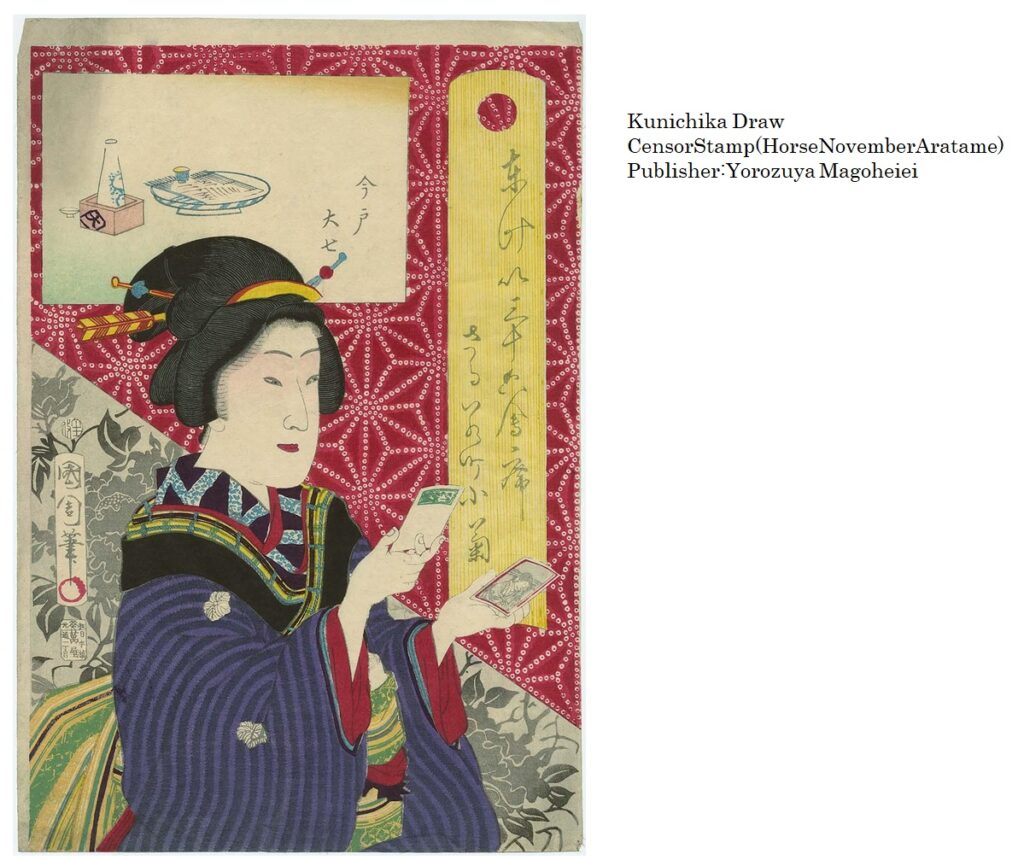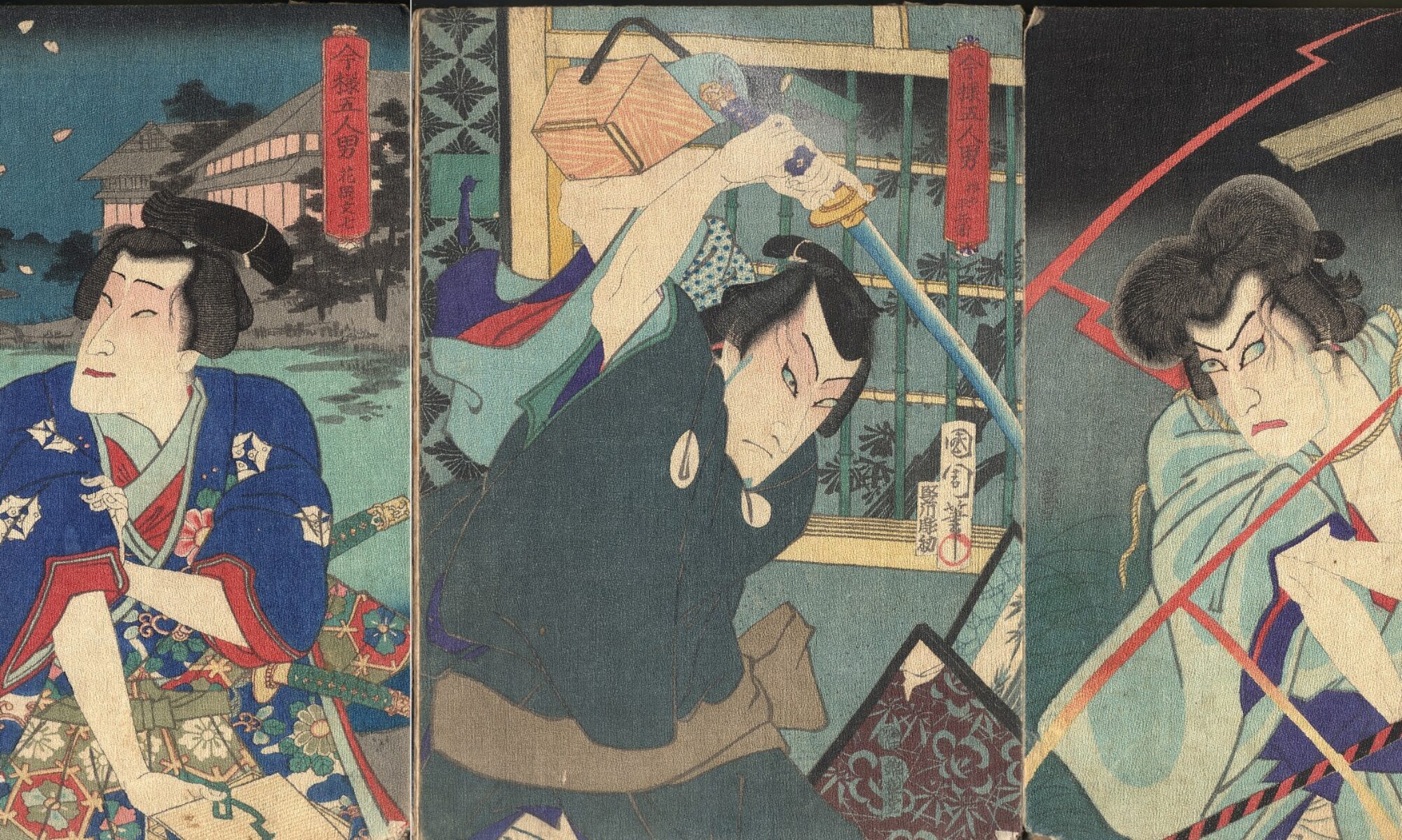Regarding the period from 1852 to 1870, the following was discussed: Changes in the artist’s surname before taking the name Kunichika Toyohara, Seal other than ToshidamaStamp, Ohkubi-e, Ohkao-e, compositions such as medium shots, emotional expressions, manga with exaggerations and omissions, storytellers, etc. The works are introduced here in chronological order.
.
Chapter 2 Survey of works from 1852 to 1870
Kaei 5th Ox 1852 嘉永5年
Inoue Kazuo (2) wrote about Toyohara Kunichika on page 51 of his Ukiyo-e Shiden (Biography of Ukiyo-e Artists), published in 1931. In it, he wrote about Kunichika’s first work, “In the picture of actors painted by Toyokuni III in 1852, there is a frame picture in which Kunichika painted people. The signature says that it was painted by his disciple Yasohachi. It is thought that Kunichika did not have an artistic name at that time.” “Yasohachi” is Kunichika’s real name. Kunichika’s real name was born as Oshima Yasohachi. According to Mori Senzo’s (17) “Meiji Jinbutsu Yawa,” he later changed his name to Arakawa Yasohachi. Hiroshige and many other disciples participated in the background of Toyokuni III’s painting in 1852. There are two styles of painting the background. First style: Famous artists such as Hiroshige painted landscapes and other things in the background of the actor picture in a frame (koma-e). In this case, the artist’s name is written on the painting, giving the impression of a collaborative work, and the impression that the painting is displayed within a painting. Second style: This style was drawn by the disciples, and is a style in which supporting characters are drawn in small, full-body figures carefully written in the background of Toyokuni III’s painting. The basis is Toyokuni III’s painting, but the participating artists are also evaluated as supporting characters. For example, Kunimaro writes his name as “Disciple Kunimaro.” In this case, the painting is added in a way that complements the narrative nature of the painting. Kunichika wrote his real name “Yasohachi” because he did not yet have an artistic name. All of Toyokuni III’s preserved and publicly exhibited ukiyo-e prints, especially those from 1852, were carefully examined, including the possibility that they were patterns of the second style. As a result, Toyokuni III, the master, drew many kabuki actors in 1852 and 1853 for the “Kunitsukusi Yamato Meiyo” series. There was a list of 68 actors and their roles in a table. This series is numbered consecutively. Waseda University Theatre Museum does not have No. 16, No. 17, and No. 32, but the other 65 works are stored. The 65 works were painted with the names of the cast of the play, and all of them had background paintings by his disciples. These disciples were Sadahide, Kunisada, Kunitsuna, Kunihisa, Kunimori, etc., and Kunichika painted a frame picture under the name of “disciple Yasohachi” among them. The title of the painting was “Masakado’s daughter Takiyasha” and the censor stamp was two Nanushi stamps (Murata and Kinugasa) and EtoMonth stamp (rat December). This is the painting that Inoue Kazuo was referring to. Kunichika’s first painting was a soldier bowing down to Takiyasha played by Segawa Kikunojo. Although it was his real name, not his artistic name, it is thought to be his debut work that still exists.
Examples of works with the names of participating artists written in them.
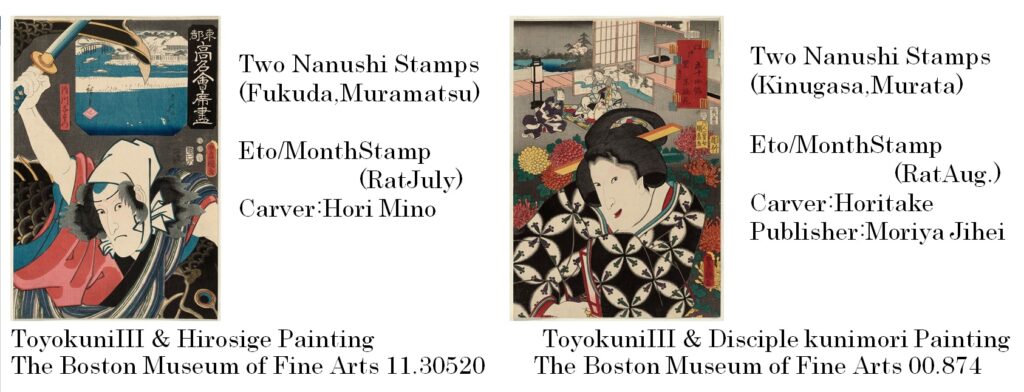

Kaei 6th Ox 1853 嘉永6年
Toyokuni III painted kabuki actors in the “Kunitsukusi Yamato Meiyo” set. This set was published in 1852 and 1853. Toyokuni III’s “Empress Jingu” has an oval EtoMonth Stamp (Boar September) and two Nanushi Stamps, so it was painted in 1853. As it was a year when the country was still under the influence of the Tenpo Reforms, the ukiyo-e only lists the cast’s name, “Empress Jingu,” but the actor is Bando Shiuka. Since the year was still under the influence of the Tenpo Reforms, the ukiyo-e only lists the role as “Empress Jingu,” but another work which lists the roles and actor names identifies the actress as Bandō Shiuka. Empress Jingu is a strong woman who, after the Emperor was killed in battle, disguised herself as a man and led the army to conquer the Shiragi who were supporting the Kumaso. Balls are depicted on a tripod in the upper left corner of the painting, and the disciple Yasuhochi is written. The tripod was painted by Kunichika. What’s interesting is that in this set, while all his students painted figures, only Kunichika painted an illustration called Balls on a tripod. No other works by Yasohachi that participated in Toyokuni III’s work have been found that year. Of course, there were no other works in 1853 bearing the name Yasohachi or Kunichika aside from this work.
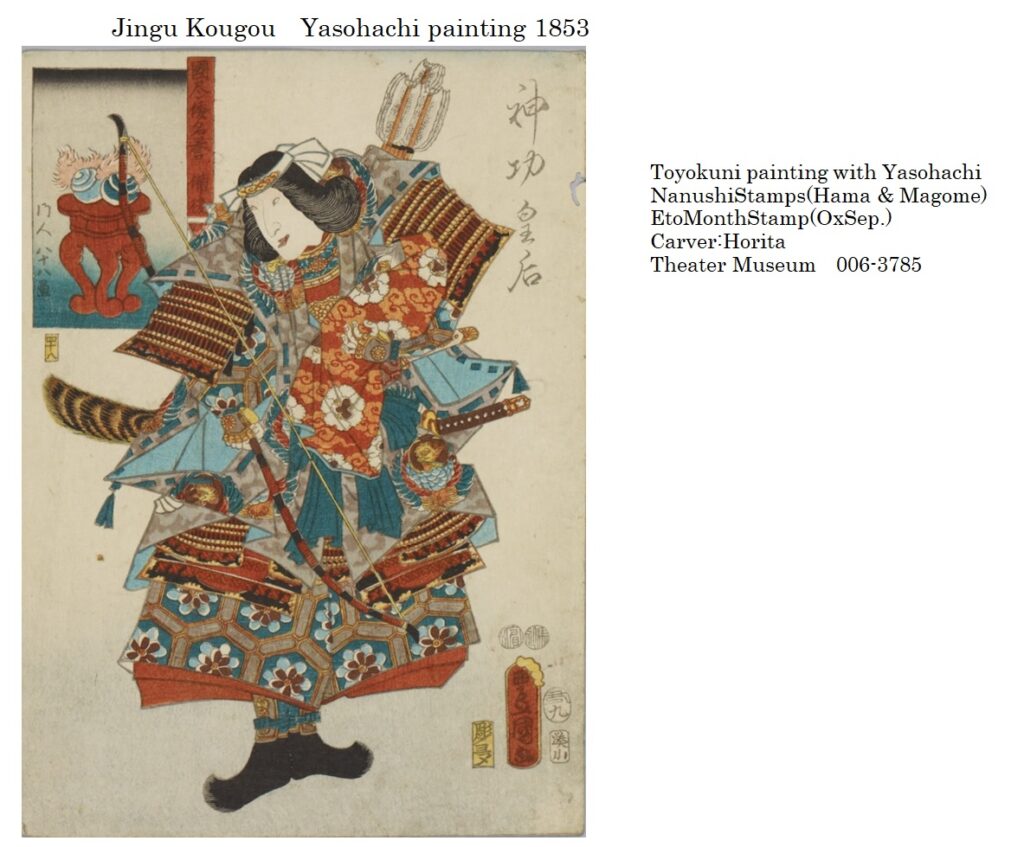
嘉永6年から安政元年 1853年10月から1854年10月
The following six works are believed to be works by Kunichika from this period, but there is only information that two of them exist, and nothing more is known. Here, the four works that have been made public will be discussed.
- Utagawa Kachoro – Oguchiya Hanayu – No censorship mark – No publisher’s mark
- Utagawa Kachoro – Boys’ Festival – No censorship mark – No publisher’s mark
- Utagawa Kachoro – Tanabata Festival – No censorship mark – No publisher’s mark – New Year’s stamp included
- Utagawa Kachoro – Choyo Festival – No censorship mark – No publisher’s mark – New Year’s stamp included
- Jinjitsu Festival – Information on existence, details unknown
- Joshi Festival – Information on existence, details unknown
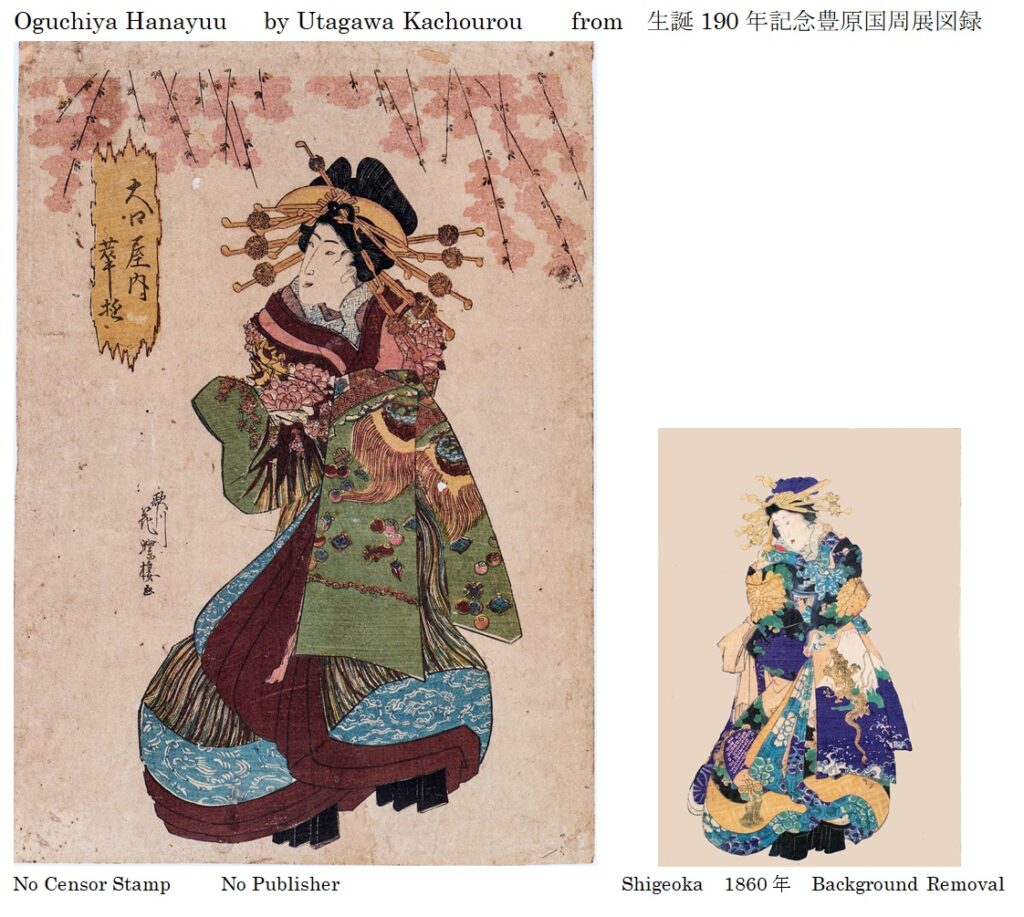
The model courtesan’s name is written on the painting as “Hanayuu華遊”, but in Yoshiwara Saiken(90) and other works, there is a character that is written as “Hanayuu花遊”. Hana華 and Hana花 have the same meaning and pronunciation, so it was determined that they are the same person. Kunichika gave the artist’s name for this work as “Kachoro花蝶楼”, but the artist’s name for Kunichika’s other works from this period that I will introduce below is “Kachoro華蝶楼”.
In this painting, both sleeves of the pink kimono seem to have been cut off, and it is unclear what the sleeves are like. Since the sleeves are not visible, it gives the impression that the arms are tied. The obi is green, and both ends of the obi hang down at the front right of the painting. This appears to be the same way that modern obi are tied, known as double-layered obi. It is the same way that the obi is tied as in the 1860 paintings of the courtesans “Shigeoka” and “Hanayuu”. For reference, the painting by Shigeoka with the background removed is shown in the upper right corner. There is a green part on the right side of Hanayuu (left side of the painting) that seems to be a sleeve. Since it resembles the fabric of the obi, it is thought to be an obi rather than a sleeve, but this way of drawing means that it is in front of the body. The obi on the back is not drawn as if it is visible. Shigeoka’s obi is also a double-layered obi, and is drawn as if a part of it is sticking out on the left side. Based on Shigeoka’s painting, the green part that seems to be Hanayuu’s sleeve is assumed to be an obi.If that is the case, the waist is drawn extremely thin. Looking at it this way, the figure in the pink kimono with a floral pattern appears to have no arms above the waist.In that case, the drawing from the chest up looks similar to the drawing on a hagoita.The impression is as if the part below the chest has been added to that drawing.Furthermore, judging from the direction of the geta, the body appears to be twisted quite a bit, making it seem as if the drawing is of someone suddenly turning around. However, given the slenderness of the upper body and waist, the axis of the body looks unnatural. Considering the drawing of the body, the direction of the feet and the balance between the upper and lower body seem completely off.
To determine when this painting was created, the names of courtesans and prostitutes of Oguchiya listed in Yoshiwara Saiken, Yoshiwara Hanakagami, etc. were examined. In these records, her name was written as “Hanayuu 花遊”. She appeared as the second courtesan in 1846 and held the rank of courtesan until 1853. She was ranked lower to prostitute (second row of the table) from 1854 and listed until 1855. If she was the model for the painting, she would have been a well-known beauty. However, since she had been ranked lower, it is unlikely that he would have painted her after she had been ranked lower, or out of nostalgia several years later, so it is believed that Kunichika painted her as a model between 1846 and July 1854. Since Kunichika was listed as Yasohachi in September 1853, it is estimated that this painting was created between October 1853 and June 1854.
| Author | Title | Year of publication | Hanayuu of Oguchiya Rankings |
| 星野屋源治郎 | 吉原細見 | 1844年 | No description |
| 商山人もと有 | 新吉原細見記 | 1845年 | No description |
| 星野屋源治郎 | 吉原細見 | 1846年 | First Class: debut, 2nd most popular |
| 小泉屋善兵衛 | 新吉原細見 | 1847年 | First Class |
| 星野屋源治郎 | 新吉原細見記 | 1848年 | First Class |
| 玉屋山三郎出版 | 新吉原細見記 | 1849年 | First Class |
| 玉屋山三郎編 | 新吉原細見記 | 1850年 | No description |
| 玉屋山三郎編 | 新吉原細見 | 1851年 | First Class |
| 笠亭仙果 | 新吉原細見記 | 1852年 | First Class |
| 玉屋山三郎編 | 新吉原細見 | 1853年 | First Class |
| 玉屋山三郎編 | 新吉原細見記 | 1854年 | 2nd Class |
| 玉屋山三郎編 | 新吉原細見記 | 1855年 | 2nd Class |
| 玉屋山三郎編 | 吉原花鏡 | 1856年 | No description |

.
Tango no Sekku, Utagawa Kacho-ro Painting, Collection Oikawa Shigeru
In her book (53), Amy Newland states that this is Kunichika’s debut work, but since there is no publisher or censorship stamp, it is unlikely to be his official debut work. Inoue Kazuo (72) introduces this painting as work 11, stating, “Although it shows a young woman returning from a iris bath, Kunichika’s distinctive features are not yet apparent. This is because it was painted at the end of the Kaei period, when he was 18 years old. In his early years, Kunichika used the seal Kacho-ro花蝶楼 and Kacho-ro華蝶楼. This is one example.” Inoue states “at the end of the Kaei period” without providing any evidence. The way the painting is painted, as explained below, suggests that it was painted around that time, around 1853 (Kaei 6) or 1854 (Kaei 7, Ansei 1).
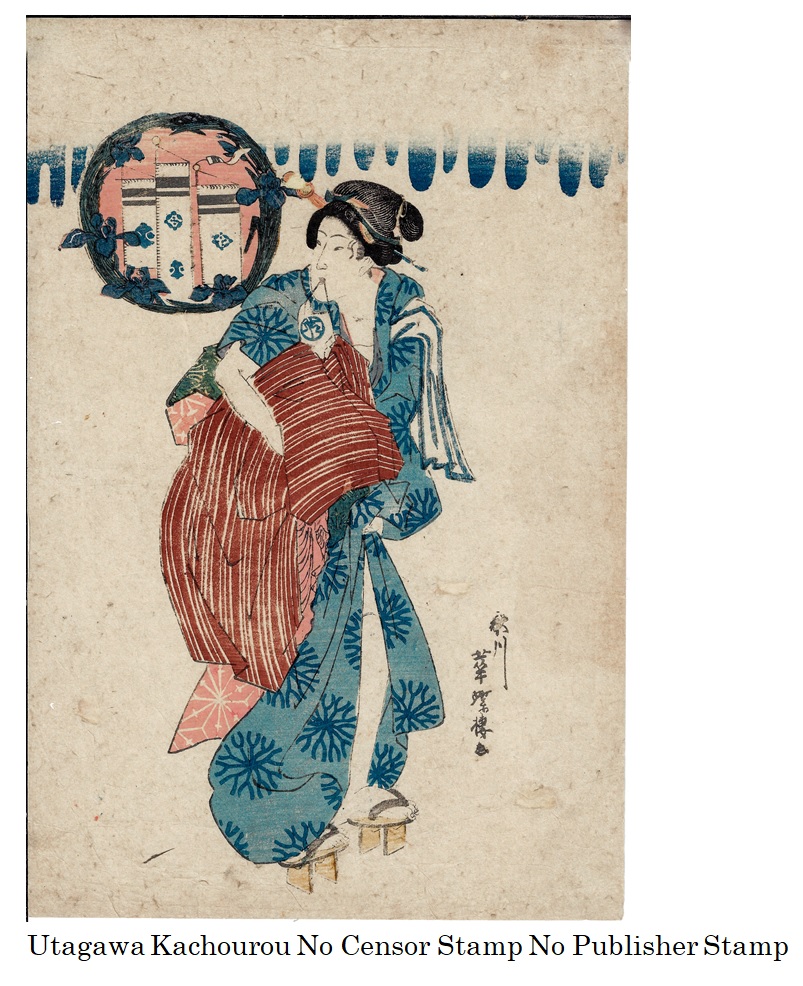
In the upper left corner of this painting, there is a circle surrounded by irises. As there is a flag in the picture, it is presumed to depict the Boys’ Festival. For the Boys’ Festival, three iris branches are hung on the eaves and an iris bath is set up. Flags are raised and helmets and dolls are displayed. Carp streamers and streamers are also displayed (73). Based on this custom, as Inoue Kazuo has stated, this painting is thought to depict a woman enjoying an iris bath at a public bath on the Boys’ Festival.
The object she is holding in her mouth in the picture is a bran bag with a string attached. Many people brought bran bags with them when they went to the public bath (yuto). Women of all ranks, young and old, used bran bags every time they bathed. Hanasaki Kazuo(74) states that rice bran, which is used when refining brown rice, is known to have the effect of removing grease, and that this was put into cloth bags (called bran bags) and used for washing the face and in the bath. He also writes that some bran bags had the family crests of Kabuki actors dyed on them, which stimulated the desire to buy them. It is not clear what letters or patterns Kunichika drew on the bran bag. In a drawing introduced in Hanasaki’s paper, a woman is similarly holding a bran bag in her mouth (75).
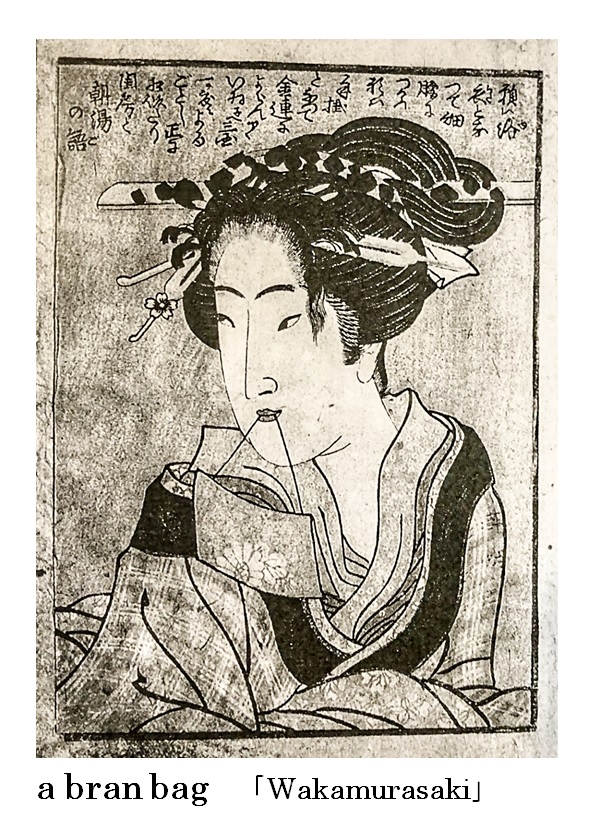
In this Kunichika painting, the woman is well-balanced, but her wooden clogs are drawn with her legs turned extremely inwards. This is possible if she is just turning around, but it feels a little strange. As with the painting “Oguchiyain Hanayuu,” the direction of her feet is unnatural.
As for the content of the painting, the kimono being held seems to be wrapping something. If it was just the kimono folded in half and held, the sleeves would be crushed. It looks like the kimono is wrapped around the clothes and being held. The green thing seen at the side seems to be a green obi belt with a pink lining. The lining of the obi belt (pink) and the lining of the kimono being held (pink) are the same color, but the flatness and wrinkled appearance make them different objects. The obi belt does not appear to be fastened. Judging from the position of the obi belt, it may have been depicted as if the kimono and obi belt are being held together. The hem of the kimono is also drawn in a bloated and unrefined way. It is not a clear representation of movement, and it is not the hem of a kimono when standing still. The white part in front of the kimono seam seems to be an unfinished work, but it may have been intended to express the messiness of the hem at the moment of turning around. The axis of the body and the overall balance are in order, but I feel that it is unclear whether the image is moving or still, and the depiction of the hem of the kimono, etc. are also unclear. Looking at it this way, the impression is that after enjoying a bath in the iris bath, she is on her way home, wearing a yukata and holding her kimono under her arm, when someone calls out to her. There is no censorship stamp, publisher’s stamp, or TosidamaStamp, so perhaps it is just a study.
Choyo no Sekku (Chōyō Festival) Utagawa Kachōrō Collection Oikawa Shigeru

Looking at this painting, a pillow, brush and inkstone are depicted in a circle surrounded by chrysanthemum flowers, and a woman is depicted holding a sake bottle. From this, it is believed to be a scene from the Chōyō no Sekku festival. Arima Tosirou (76) writes about the Chōyō no Sekku chrysanthemum sake, “According to the auspicious tradition of prolonging life, chrysanthemum petals are added to the celebratory cup and drunk…” He also reports on the relationship between the Chōyō no Sekku festival and chrysanthemums, such as chrysanthemum cotton. The sake bottle for enjoying chrysanthemum sake and the pillow are thought to be chrysanthemum pillows. Yano Kenichi (77) writes about the chrysanthemum pillow, “In China, chrysanthemums were believed to have the magical power to ward off illness and evil spirits, so chrysanthemum flowers were placed in pillows. The Keisosaijiki states that on the Double Ninth Festival on September 9, chrysanthemum wine and chrysanthemum flowers were collected and used to stuff pillows. However, no matter how many chrysanthemums were collected, the pillow would not inflate, so pillows with pictures of chrysanthemums on them were also called auspicious chrysanthemum pillows.” Even today, the chrysanthemum pillow remains a seasonal word for late autumn.
There are two problems with this painting. The first is the woman’s left leg. Considering her body, it is unnaturally spread out. Looking at it that way, the overall picture is unbalanced. The second is that the sleeve and length of her left hand are not well balanced; it may look short due to the angle, but when painted, it should be depicted with a good balance, or the picture should depict a clear moment of movement.
Although it was not present in the previous two works from this period, this is the first time that the TosidamaStamp has been used. There is much we do not know and it is impossible to say for sure, but perhaps Toyokuni III recognized it as a work that was mostly acceptable.
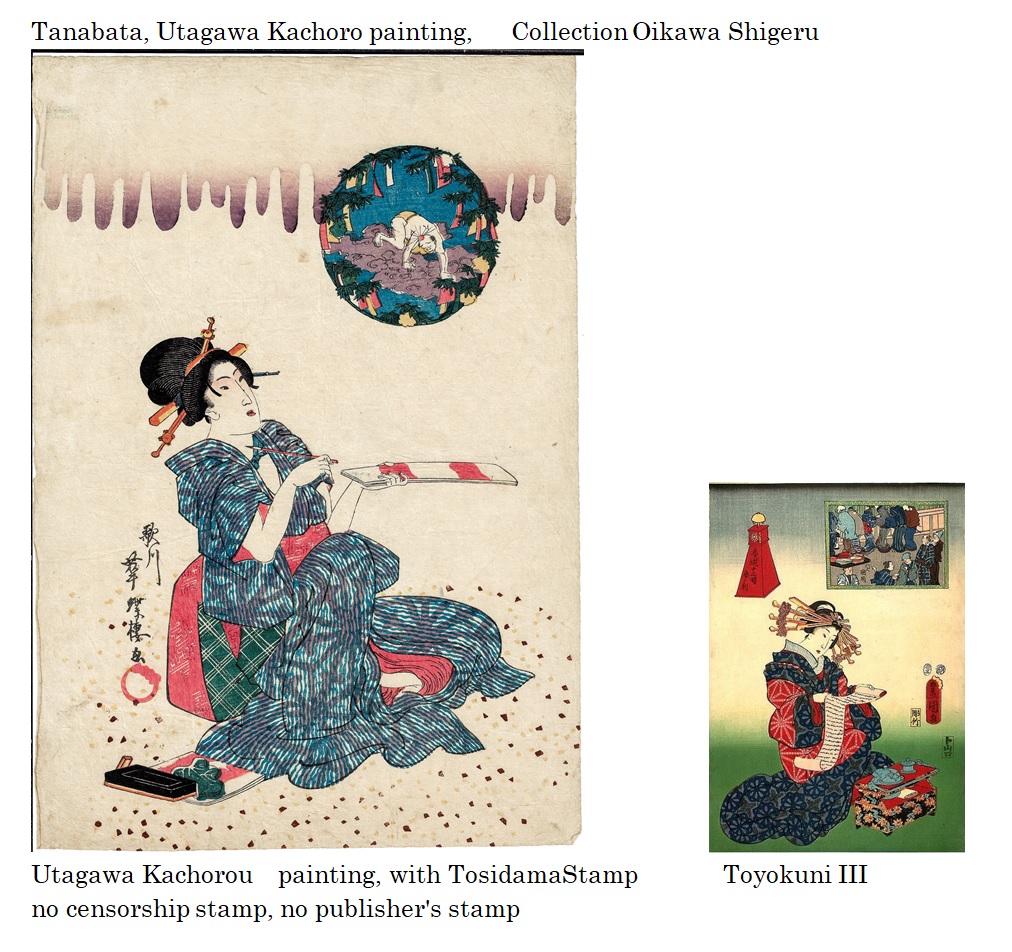
It is puzzling why this painting depicts a man in a loincloth crawling around inside a circle surrounded by bamboo. The bamboo surrounding the circle tells us that the theme of this painting is Tanabata, and that the man depicted is Hikoboshi. The top of his head is shining, and he is peering down from above the clouds. The woman below appears to be about to write her wish on a Tanabata strip of paper. In this way, the depiction of Hikoboshi in a loincloth, which does not suit him, peering down at the world below, alongside a painting of an emotionally rich woman, is thought to be a commoner character of Kunichika himself. It can be seen that he was not trying to depict the artistic works of previous ukiyo-e artists. The gap between the upper half of the woman’s body and the seated lower half of her body gives the impression that she is about to fall over backwards. Also, the lower half of her body is drawn large and exaggerated. The balance of this painting can be understood by comparing it with the painting of a woman by Toyokuni III in Toyokuni III’s Shunsen Juniji, shown on the right, where Kunichika painted a piece of komane, but it can be seen that Kunichika’s lower half of her body is drawn abnormally long and large. Even if it is drawn exaggeratedly, the way her left leg is seen through the kimono makes it even more unnatural, and makes you wonder what kind of knee it is. This work is marked with a ToshidamaStamp.
Summary
The paintings introduced here are signed Utagawa Kachoro and Utagawa Kachoro. The painting of the 12-month-old Kanbutsu-e in 1857 is signed Kachorou kunichika, and the painting of the Heike Ichirui Kenzu in 1858 is signed Kachorou Kunichika. Furthermore, since there are only a limited number of artists who call themselves Utagawa, it is believed that Utagawa Kachoro and Utagawa Kachoro are definitely Kunichika. However, throughout his life, Kunichika rarely painted ukiyo-e under the name Utagawa, especially in the field of ukiyo-e. It is very interesting that he seems to have called himself Utagawa just before his debut. Now, the time when these paintings were created cannot be determined because there is no censorship stamp. However, based on the presence of the courtesan who was the model for the paintings and the description by Inoue Kazuo (72), it is estimated that these paintings were created between October 1853 and June 1854. The TosidamaStamp was not used for “Oguchiya Hanayuu” and “Tango no Sekku” during this period, but it was used for the “Choyo no Sekku” and “Tanabata” pictures. There are many unknowns and it is impossible to be definitive, but it seems that these are works that Toyokuni III recognized as almost acceptable but judged to be unworthy of publishing and distribution. It is possible that Toyokuni III did not introduce them to the publisher, or that he did introduce them but the publisher rejected them. They may simply be studies, but they have been made into prints. Future research will likely shed more light on the training of ukiyo-e artists and how they made their debut.
Ansei 1st Tiger 1854 安政元年
There was one ukiyo-e print from 1854. It was signed Kunichika and surrounded by the ToshidamaStamp, and it also had the censorship stamp and publisher’s seal, so it is believed that in 1854, he was recognized in the market as an artist.
Harunokei Hanaasobi zu Kunichika Kyoto University of the arts, Geijutsu-Kan
Cherry blossom viewing was a spring pastime for the citizens of Edo. A drinking party is about to begin behind the cherry blossom viewing curtain (56). The woman in the center is thought to be the main character. She has no eyebrows and her teeth are blackened. She is likely the wife of a high-ranking samurai or a wealthy merchant. Her hair is in a Katsuyama hairstyle. Her obi is tied in a single knot, and her shigokihimo indicates that she is concerned about getting her kimono dirty while outdoors. The woman on the left has her hair in the marumage style, which suggests she is a servant. She is concerned about the dirt on the hem of her kimono. She is holding up the hem of her kimono with her shigokihimo. The two are probably discussing the upcoming party. On the right, a girl in a furisode is holding a tiered box and talking to a small child. The scene depicts a cherry blossom viewing party, but behind the cherry blossom viewing curtain, a group of men who look like laborers are already drinking and saying things like, “I thought it was a rolled omelet, but it’s yellow pickled radish.” Kunichika also painted supporting characters in his 1858 Souma Yosikado Furudera no zu, which tells the story from multiple angles.
“Ukiyo-e Search” was used to search for works published in 1854. The results showed that there are few works depicting daily life like this, such as kabuki plays, Hiroshige’s landscape paintings, and Azuma Genji. In “Tama River, Chofu” (owned by the Boston Museum of Fine Arts), Toyokuni III painted a scene of women crossing the river, and in “Plum Viewing” and “Flower Party” in “Within the Twelve Months,” he painted scenes of the daily life of geisha and courtesans. Hiroshige’s paintings are mainly landscapes, but there are some pictures of daily life with people appearing. The fact that Kunichika’s painting depicts the daily life of ordinary people and not courtesans suggests the world he would paint later. He is also an artist who paints information rather than emotion. A comparison of this with Toyokuni III’s “Juunikagetsu no uchi Umemi” from the same year reveals Kunichika’s distinctive features. In both Kunichika and Toyokuni III, the protagonist appears to be the wife of a high-ranking samurai or a wealthy merchant, and both are depicted without eyebrows and with blackened teeth. Toyokuni’s painting depicts the atmosphere of a plum blossom viewing party, but Kunichika also depicts men drinking behind the cherry blossom viewing curtain to tell a story. By including the men in the painting, it depicts a cherry blossom viewing scene for the common people.
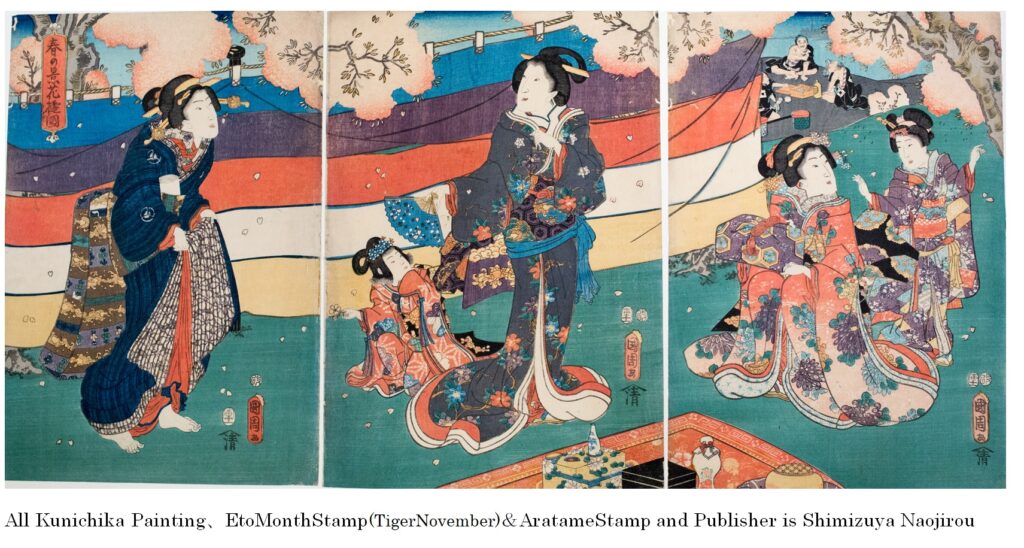
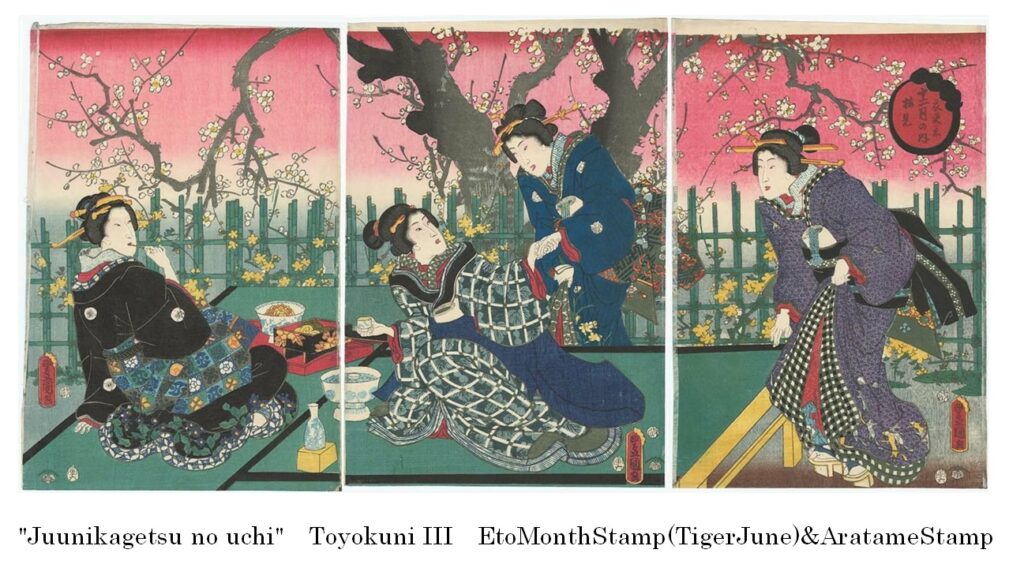
Ansei 2nd Rabbit 1855 安政2年
In the field of illustrations, Kunichika made his debut with Ichiousai, one year after his debut with ukiyo-e. Kunichika drew his first illustrations on the inside cover of “Omisoka Akebono Soushi,” a work in which Santokyozan wrote the story and Yoshitsuna illustrated every page. Kunichika quietly wrote Ichiousai’s name so that it would not stand out. In this way, in the field of illustrations, Kunichika had begun to draw illustrations in places that were not part of the story. Although he produced wonderful ukiyo-e paintings that year, in the field of illustrations, he was only active at the level of drawing illustrations, similar to his painting of Empress Jingu in 1853. The ukiyo-e that year was the large-scale triptych “Sumidagawa Yowatashi no zu” was published.
Field of illustration
Oomisoka Akebono Zoushi volum 22nd 大晦日曙草子, by Santou Kyouzan, Yoshitsuna painting, Ichiousai painting, Waseda University Library
Regarding the issue date, the text and the last page describe Ansei 2 (1855). Due to the style of EtoMonthStamp (RabbitJune) and the AratameStamp, Kunichika painted the illustrations in this book in 1855. The publisher is Koeidou. In the right corner of the figure below left, Kunichika drew the name of Ichiousai(一鶯齋)and the illustration on this page. After this, Kunichika drew many works with an artistis name called Ichiousai Kunichika. The right side of the figure below has an illustration on the back page. Kunichika refrained from writing a picture of a basket and ornaments that collected the seven spring herbs of the New Year, and a place that would be overlooked if it was the pattern of the New Year’s ornament. On the page on the left, he drew the figure of “Okame” and a tradesman celebrating the New Year, and wrote Ichiousai in the right corner. Since Yoshitsuna is a student of Kuniyoshi, Kunichika participates in the illustrations of Kuniyoshi’s students, not Master Toyokuni III. The cover of Volume 22 was drawn by Kunisada II. This work is considered to be Kunichika’s debut work in the field of illustration.
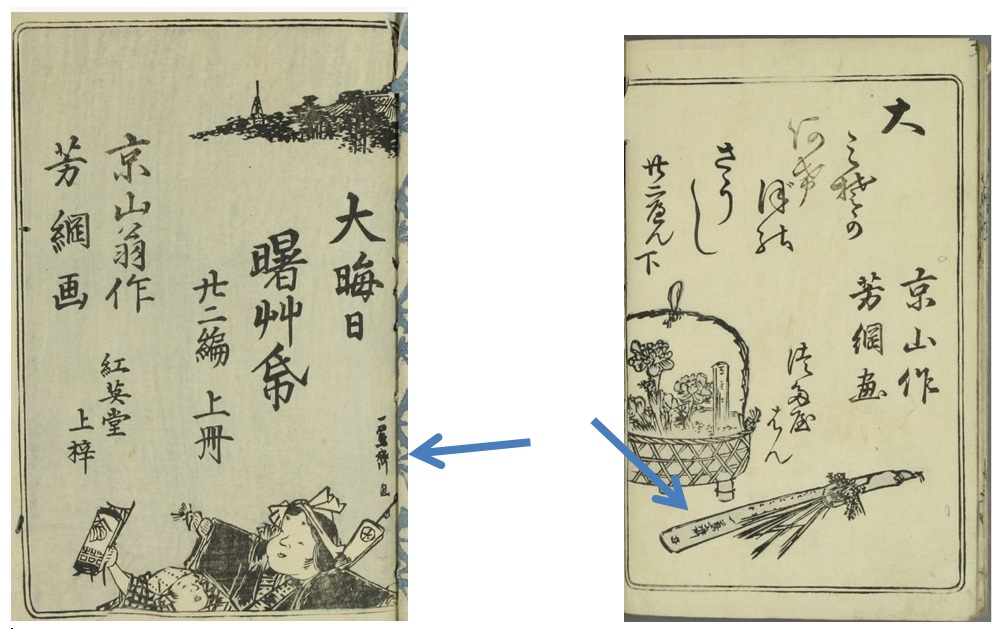
https://archive.wul.waseda.ac.jp/kosho/he13/he13_03049/he13_03049_0006/he13_03049_0006.pdf
Ukiyo-e field
“Sumidagawa Yowatashi no Zu” Kunichika, a disciple of Toyokuni III Kunichika & Kunichika painting the National Diet Library寄別7-4-2-7
His masterpiece, triptich “Sumidagawa Yowatashi no Zu” was published. There was EtoMonthStamp (RabbitJune) and AratameStamp, and there were two paintings of “Kunichika Painting” surrounded by Tosidama Stamp. On the remaining one, “Kunichika, a disciple of Toyokuni” was similarly enclosed with a Tosidama Stamp. This ukiyo-e work is similar in composition to the “Wakamurasaki Nenchugyouji no uchi Minazuki ” released by his teacher, Utagawa Toyokuni III, in 1847-1852. The big difference is that Toyokuni III has an elegant female on board and a well-dressed young lord holding a oar. Toyokuni III depicts a princess and a fashionable young lord or genji as a classic play, while Kunichika depicts a common woman and the Edo common people with a dashing captain. The so-called “Yatsushi-e” seems to have been the starting point for Kunichika’s style of ukiyo-e, in which the common people are the main characters. Kunichika’s painting is a lively painting in which the movement of the body is supple and the movement is felt, and it is depicted crossing the river on a quiet moonlit night while talking about small talk, and is a lively painting that conveys the sounds of conversation and laughter. The moon is reflected on the surface of the river in the middle ground, swaying in the waves. A wide field is painted on the right bank, and a sailing ship and mountains are painted in the distance. The river is painted with an expansiveness that gives the impression of connecting to the sea in the distance. The publisher of this work is Moriya Jihei, who is known as a publisher that deals with Hokusai, Utamaro, and Hiroshige. On the other hand, the publisher of Toyokuni III is Ebisuya, which is known as a publisher that handles a lot of Toyokuni III (Kunisada). The relationship between Kunichika and Moriya Jihei will continue for some time after this.

.
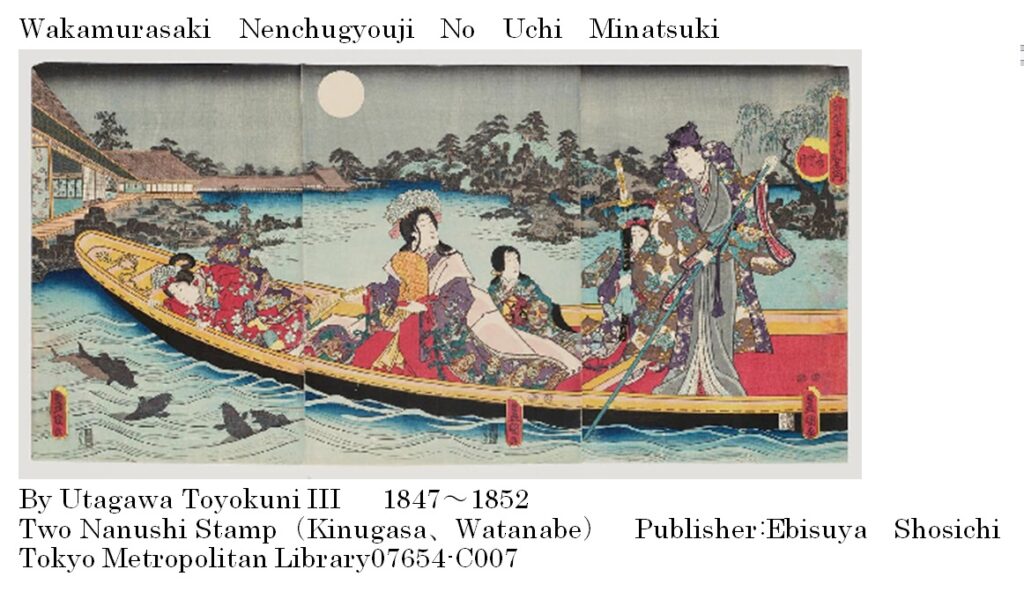
Genpei Yashima Daigassen Kachourou painting Catalogue of the Toyohara Kunichika Exhibition Commemorating the 190th Anniversary of His Birth
Until this year, no illustrations of Kunichika’s war stories have been found, but Kunichika had already depicted the intense movements of the Genpei Daigassen in ukiyo-e prints before his illustrations. On the right, Genkuro Yoshitsune is vividly depicted jumping up and swinging his sword down, and he is drawing this with the eight-saddle jump in mind. An arrow flies past Yoshitsune’s head. To the lower left of Yoshitsune, Noto no Kami Noritsune is depicted as if someone is blocking his way from behind. A flag of bamboo gentian is drawn in the center, giving the impression of him fleeing backwards. Each warrior is also depicted standing with his feet planted. There is power, but little movement.

Ansei 3rd Dragon 1856 安政3年
There are eight works related to illustrations. In Hachikenden, he has not yet drawn pictures for the main story, as in the previous year, and his name is “Chika知可”. In Sansesou en no oguruma, he wrote “Assistant Kunichika” and started to draw the story. In Ansei Kenbunshi, he finally began to insert detailed pictures. In Yotsuya Kaidan, he drew illustrations on every page and signed his name “Ichi Ousai”. Unlike ukiyo-e, he drew pictures that express large movements as the story unfolds, but compared to ukiyo-e’s “Sumidagawa Yowatashi no zu”, he draws pictures with more movement. Wakan Musha Kagami was published under Kunichika’s name, and the pictures have a sense of movement. In Yoshinaka Yusenroku, he first called himself “Utagawa Kunichika”. In this field of illustration, artists of the Utagawa school were very active, and Kunichika was a disciple of Toyokuni III, so it was natural for him to call himself “Utagawa Kunichika”. However, in the field of ukiyo-e, he rarely called himself “Utagawa Kunichika.” For this reason, in modern times, he is known as “Utagawa Kunichika” in the world of Japanese literature, and “Toyohara Kunichika” in the field of ukiyo-e. Furthermore, it was still some time before the name Toyohara Kunichika appeared in the world of ukiyo-e, and around this time he mostly used the name “Ichiousai Kunichika.” Thus, there is an impression that this year Kunichika also firmly established his foothold in the field of illustrations. In the field of ukiyo-e, he drew a frame in “Toyokuni III’s Shunsen 12ji” under the name of his disciple Kunichika.
Field of Illustration
Yoshinaka yuusenroku “義仲勇戦録4巻” by Santei Haruma Utagawa Kunichika & Kunichika Painting ( the National Diet Library Digital)
As Utagawa Kunichika, the whole story is carefully drawn with thin line drawings of armored warriors, fighting pictures, and landscapes seen from the mountains. This picture was painted in 1856, because both volumes 1 and 2 were in the style of EtoMonthStamp (DragonJan.) and AratameStamp. Tsutaya Kichizou published it in 1857 (Ansei 4). Utagawa Kunichika is signed on the back cover of Volume 1, “Utagawa Kunichika” is signed on the cover of Volume 2, and “Kunichika e kaku (Kunichika Drawing)” is signed on the back cover. Although the back of the cover was sometimes drawn by another artist, Kunichika drew it himself. The author is Santei Haruma, and only the cover is colored woodblock printing. Like an ukiyo-e, the scene of a fierce battle is drawn in a way that looks like the moment when a pose is decided in Kabuki. In the field of illustration, Kunichika was the first to call himself ‘Utagawa Kunichika’ because he belonged to the Utagawa school.
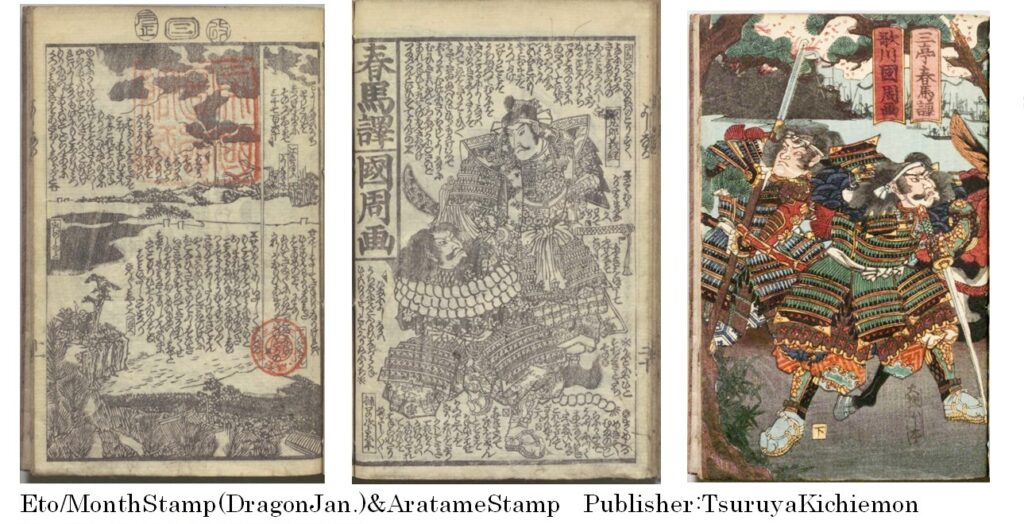
https://dl.ndl.go.jp/info:ndljp/pid/10301693
.
Hakkenden Inu no Sousi,Vol 39th, 八犬伝 犬の草紙 By Ryutei Senka, Baichourou Kunisada painting, In the back of the cover “Chika painting”
The preface says Ansei 5 (1858), but since it is the style of EtoMonthStamp (DragonApril) and AratameStamp, the illustration was drawn in 1856. Kunichika drew an illustration of a bamboo basket and a uchiwa in the figure on the right, and the signature was “知哥画 Chika painting”. It is based on the theory that “知哥Chika” is Kunichika(18). The color picture on the cover and the picture in the text were drawn by Baichourou Kunisada (Kunisada II). Kunichika made his debut in the field of illustrations two years ago, and for this book he signed as “Chika painting” and drew illustrations. Kunisada II is a painter who later became Toyokuni IV, a Disciple of Toyokuni III, and a senior of Kunichika.
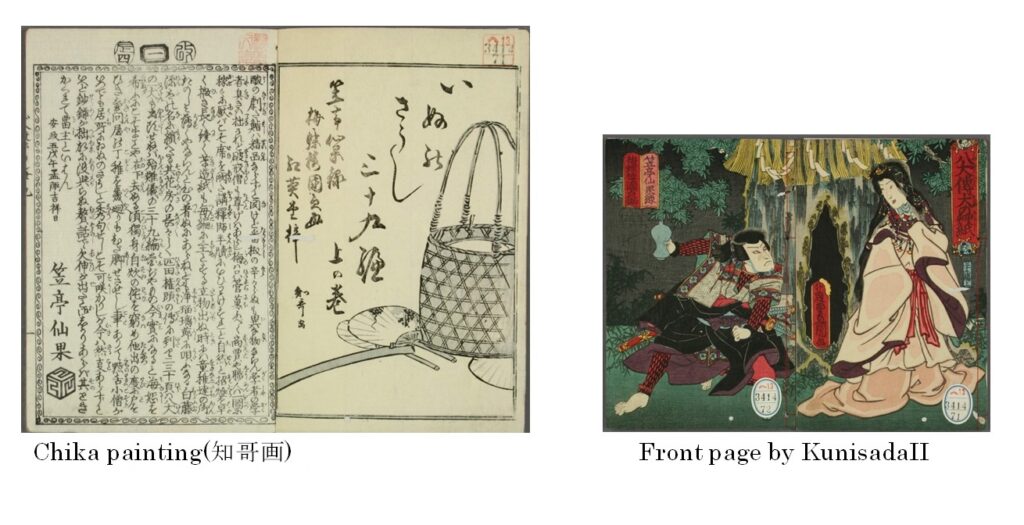
he13_03414_0071.pdf (waseda.ac.jp)
.
Nani Ohiso Toranomakifude(題大磯虎之巻筆) Vol3 By Ryusuitei Tanekiyo Baichourou Kunisada painting Chika painting, Chika Painting Senshu University
Written by Ryusuitei Tanekiyo and illustrated by Kunisada. Koeidou Publishing.
Volumes 1 to 3 were published in 1857 (Ansei 4). The censorship of the first volume is stamped with the EtoMonthStamp(DragonApril) and the AratameStamp, so the illustration was drawn in 1856. The censor stamp for the third volume was (Dragon April). There is ” 知可画Chika painting” in the cover of the first part of the third volume, The inside cover of the second part of Volume 3 says “周画Chika’s painting”, and each page has a detailed illustration.

.
Yotsuya Kaidan 四家怪談上下 By Dontei Robun Ichiousai painting ARC Classics Portal Databasre
The preface written by Robun states that it was written in 1856, as it says “3 years after the start of Ansei.” Furthermore, censor stamp is 1856, as there are EtoManthStamp (Dragon, April) and AratameStamp. Kunichika’s name does not appear on the cover, etc., so it is difficult to tell who drew the illustrations. The artistic name “Ichiousai” is written on the folding screen in the picture below, and on the fusuma picture on the other pages. He did not use the name “Kunichika” in this book. Also, it is common to see a composition in which the text of the story is filled around the illustration, but in this kusazoshi (one type of book), the text page and the picture page were clearly separated. Perhaps for that reason, he freely drew the background on the page of the picture. This story is based on the Yotsuya kaidan, which is still famous today, and in the corner of the picture, a ghost peering into the room is depicted, as is typical of today’s ghost stories. At this time, such performances had already been made. Published by Itoya Shobei.
Based on Tsuruya Nanboku’s Toukaidou Yotsuyakaidan, it was staged in 1825 at the Nakamura-za Theater as Yotsuya kaidan. The synopsis is as follows. Oiwa, the only daughter of the Tamiya family, had problems with her appearance and personality, and her marriage was delayed. Iemon was an unemployed samurai. He was adopted by the Tamiya family and married Oiwa. Iemon wants the property of the Tamiya family. However, Iemon falls in love with Kihei’s concubine. In order for Kihei to force his pregnant mistress onto Iemon, the two men kick out Oiwa. Oiwa, who went mad and disappeared, attacks the Tamiya family. In Tsuruya Nanboku’s story, Oiwa’s face becomes swollen and disfigured after being poisoned. Here too, the ghost of Oiwa, who has become disfigured, is drawn.
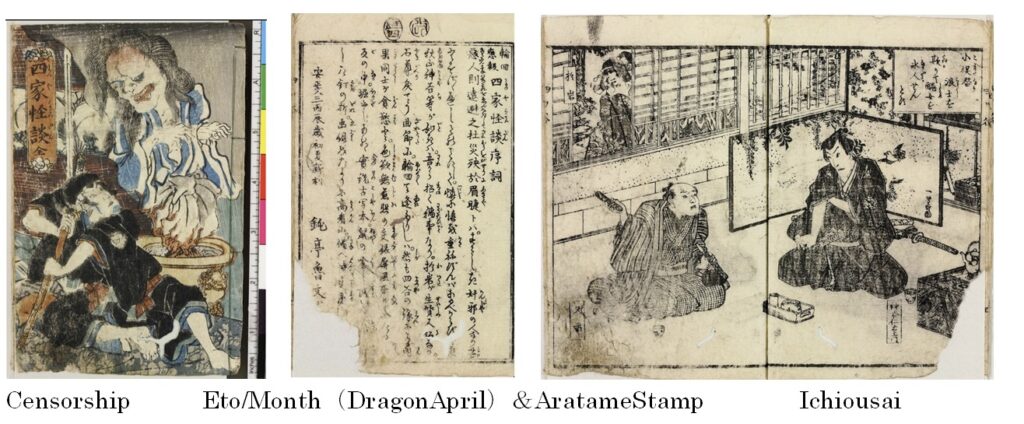
.
Sanzesou Enishino Oguruma “三世相縁の緒車” by Ryusutei Tanekiyo、 Kunichika Painting ( Digital Archive Fukui)
This book was released in 1858 in three volumes. Kunichika illustrated parts of two volumes. On page 43 of the relevant document stored in the Digital Archives Fukui, it says “Kunichika Assistance.” Regarding what “assistance” means, Higuchi Futaba (78) writes, “A master who has many disciples will only sketch the figures in a collection of scrolls, and will have his disciples come up with ideas for the background scenery or the construction of tools, unless they require special features. He will only entrust the work to those who have made a name for themselves as artists, left the nest, and are still without work, and are skilled enough to live off the master’s help.” From this, it is possible that Kunichika also drew the three people on the left in this picture.
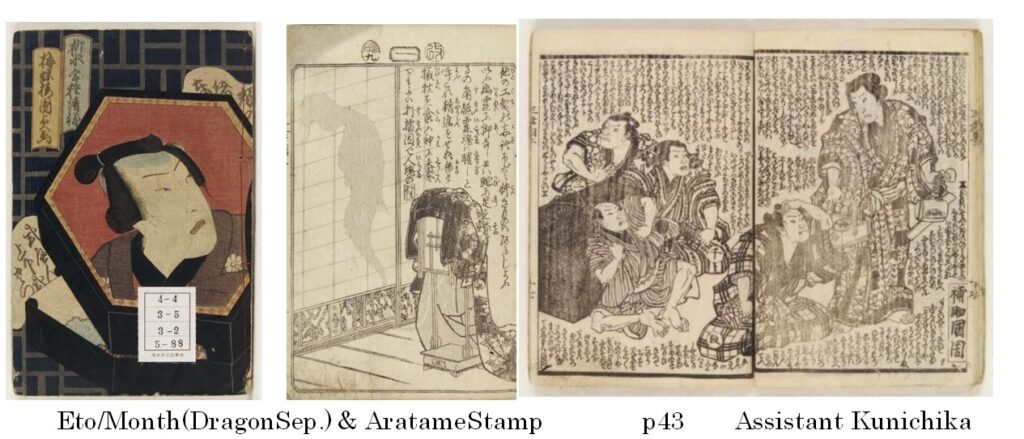
https://www.library-archives.pref.fukui.lg.jp/archive/da/detail?data_id=012-2024781
.
Wakan Mushakagami 和漢武者鏡 By Dontei Robun Kunichika Painting Union Catalogue Database of Japanese Texts
The stamps are EtoMonthStamp (October, the Year of the Dragon) and AratameStamp, so the picture was painted in 1856. It is quite damaged. It is not clear what the picture on the cover looks like, but inside the text there is a vivid picture of a warrior, with their armour drawn closely and with fine lines, without any gaps. The rest of the picture is drawn only with lines, so the movements of the characters are wonderful, but the twists in the clothing are also skillfully drawn to express movement. The muscles in the calves and other parts of the legs are also drawn realistically. In the following picture, only the face is coloured, but it is not clear whether this was added by a later artist or if it was there from the first edition. The colour printing is slightly off, so it looks like someone later added colour with a brush.

.
Yoritomo Ichidaiki, Volume 1, Painting by Kunichika, from the catalogue of the Toyohara Kunichika Exhibition celebrating the 190th anniversary of his birth
According to the catalogue (79, p185), “… . . . 1856, as there is a revised seal of “Dragon Aug.”. The catalogue also does not state what artist name Kunichika used, but the owner Makuuchi Tatsuji contacted me to say that at the end of the volume it says “Painting by Kunichika.” Sanada Yoichi, who was ordered by Yoritomo to lead the vanguard, fought on a cliff with Matano Goro of the Heike clan. Here, the moment when Yoichi, riding on Matano Goro and receiving a bow from the Heike clan, is depicted as he fires his bow is depicted. Many stories are depicted in the painting, such as movements and the state of the battle.

Ansei Kenmonshi安政見聞誌 Painter Kuniyoshi,Yoshitsuna,Ichiousai Kunichika ( Waseda University Library )
The Great Ansei Earthquake occurred on October 2, 1855 (November 11, 1855 on the solar calendar), causing extensive damage. Utagawa Kuniyoshi, Yoshitsuna, and Kunichika depicted the disaster in Ansei Kenmonshi. There are theories that some of the contents of this book were inappropriate, or that permission was not obtained. As a result, the magistrate’s office criticized the publication. This is described in Yuriko Iwakiri’s “Kuniyoshi” (11,p168). A similar Ansei Kenbunroku was published in June 1856, and the introduction article states that Ansei Kenmonshi was announced before Ansei Kenbunroku. Therefore, it is presumed that Kuniyoshi’s Ansei Observatory was released between late 1855 and early 1856. Kunichika drew a map of Kameido Tenjinbashi-dori and Jukkengawa-suji Yanagishima in the first volume. It is drawn carefully, and the thick river in the center is the Yokojukken River, which currently flows between Sumida and Koto wards in Tokyo. Tenmangu Shrine is on the right, so the broken bridge must have been in the same location as the current Tenjinbashi Bridge. In the upper left corner along the Yokojikken River, a magnificent house surrounded by a wall is depicted, with the name of the master, “Utagawa Toyokuni,” written in a lively manner. At first glance, this mansion appears to be in good condition, but on closer inspection, it appears to be slightly tilted, perhaps due to damage to the pillars. It carefully depicts how the surrounding houses were crushed by the weight of the roof tiles. In addition, there are detailed descriptions of vegetable shops, fish shops, etc., which reminds us of the bustle of the past, the fragility of the wooden structure that collapsed in the earthquake, and the hardships of the people. Toyokuni III’s mansion was called Fucho-an, and his fame as an artist is described in Yamaguchi Keizaburou’s “History of Ukiyo-e”(19, p136).

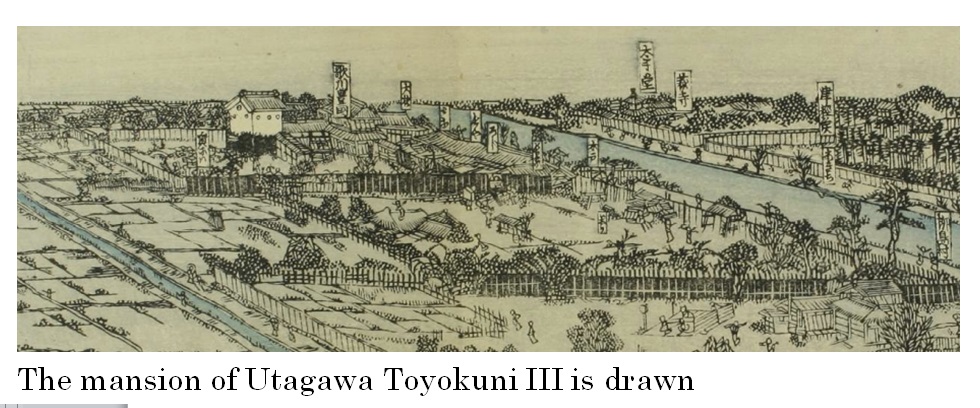
https://archive.wul.waseda.ac.jp/kosho/wo01/wo01_03754/wo01_03754_0001/wo01_03754_0001.pdf
.
Ukiyo-e field
Kunichika was already recognized as an ukiyo-e artist, having already released wonderful paintings under the name Kunichika in 1854 and 1855 and using the TosidamaStamp, but in 1856 there was a work in which he was named Disciple Kunichika. This gives the impression that he was still subordinate to his master, and the public does not think of him as an independent artist like Hiroshige and others. If he had become independent and been recognized for his skills, it is thought that he would have simply written “Kunichika” and drawn the frame art like Hiroshige and others. For this reason, since there are no paintings after 1856 that bear the name “Disciple Kunichika,” it is thought that he became independent around this time. The “Disciple Ichiousai Kunichika” in the memorial painting of Toyokuni III from 1864 is a tribute to Toyokuni III, so the meaning is different.
Shunsen 12 ji 春撰12時 ToyokuniIII Disciple Kunichika fromThe Utagawa Kunisada Project
As a frame of Toyokuni III’s painting, Kunichika has depicted a townsfolk peering at Harimise (56) through a lattice and has signed it “Disciple Kunichika.” Toyokuni III depicted a courtesan reading a letter she had received; it was a long letter. In the street, townsfolk are peering through the lattice, some of the men wearing headscarves. A woman also seems to be peering. In the street, a woman is talking to a timid man. A man working at a soba restaurant passes by with a tray on his head. Through his frames, Kunichika conveys the scene of a courtesan quietly reading a letter in the inner room, while many people are passing by in the street, looking at her.

Ansei 4th Snake 1857 安政4年
In the field of illustrations, works such as Revenge of Iga, Yoritomo Yoshitsune Ichidaiki, Yorimitsu Oeyamairi, and Shiraishi Monogatari were published under the name of Kunichika. He began painting on a wide range of subjects, including samurai, townspeople, and stories featuring monsters. Among the works, Shiraishi Monogatari had the impression that the paintings were rough, and I felt that the quality of the paintings was uneven. There were four works in the field of ukiyo-e. Asakusa Sanchu Hanakurabe is a painting by Toyokuni III, but it seems that he painted the background not as a disciple, but as an artist who has already been evaluated from the words of “background Kunichika”, but the content is also wonderful. Works such as Imayou Genji no uchi Tsuki depict the lives of ordinary people that Kunichika aimed for. The drawings are meticulous and the kimono is gorgeous. It is thought that Kunichika was aiming for secular paintings, not the elegant world. Regarding this painting, the Boston Museum of Fine Arts is a set of two, and the one in Waseda University Theater Museum is triptych with the addition of one with a different publication. There is no end to topics such as footwear, kimono patterns, composition, and screen composition.
Field of Illustration
Nezumikomon Harunosingata 鼠小紋東君新形 By Ryusuitei Tanekiyo KunisadaII painting Supplementary painting by Kunichika Waseda Univertsity Japanese & Chinese Classics
There are from the first volume to the third volume. Censor Stamp style is divided into EtoMonthStamp and AratameStamp. The first volume was (SnakeJan.) and AratameStamp, the second and third volumes were (SnakeFeb.) and AratameStamp. Therefore, the picture was painted in 1857. On the cover of Volume 3, Ichiousai is described. In the text, there is a character of “assistant Kunichika”. The first volume and second volume were drawn by Kunisada II, but the third volume was drawn by Kunitsuna and assisted by Kunichika.
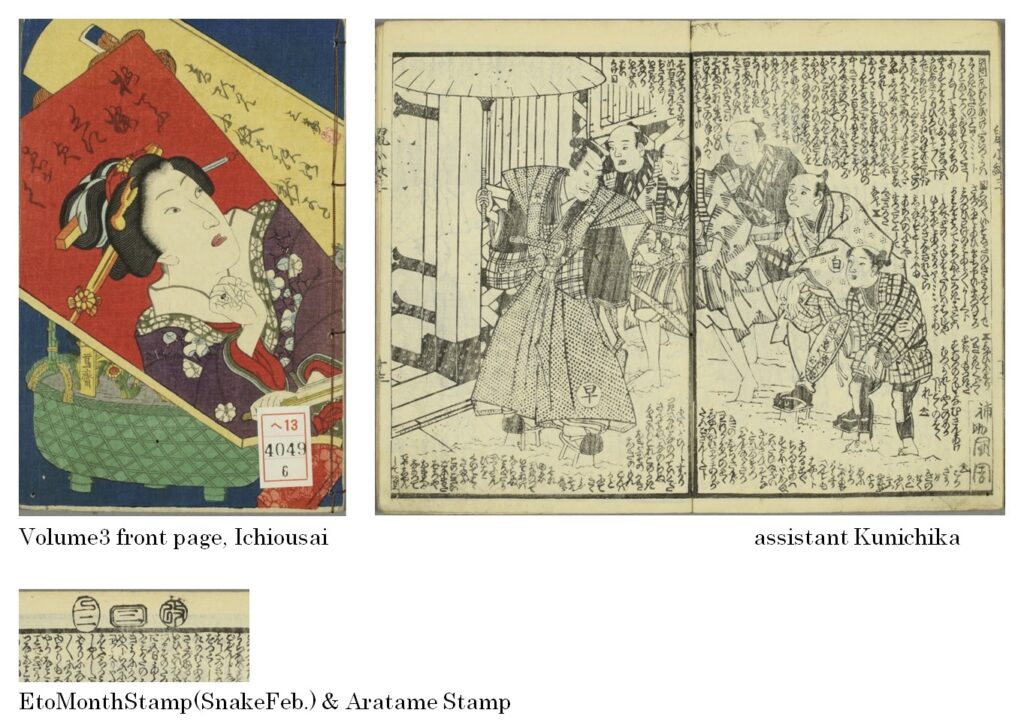
.
Tokiniminnanobu Goriyaku 当南見延御利益 by Ryuusuitei Tanekiyo Baichourou Kunisada Painting Ichiousai Kunichika painting the National Diet Library
EtoMonthStamp (SnakeSeptember) and AratameStamp are stamped, so it is a work of 1857. “Ichiousai Kunichika Painting” is written on the spread page at the beginning of Volume 2. This frame picture was drawn by Kunichika. The faces drawn on the left and right pages are very similar, but the one on the left is Kunisada’s. Volumes 1 and 3 were drawn by Kunisada.
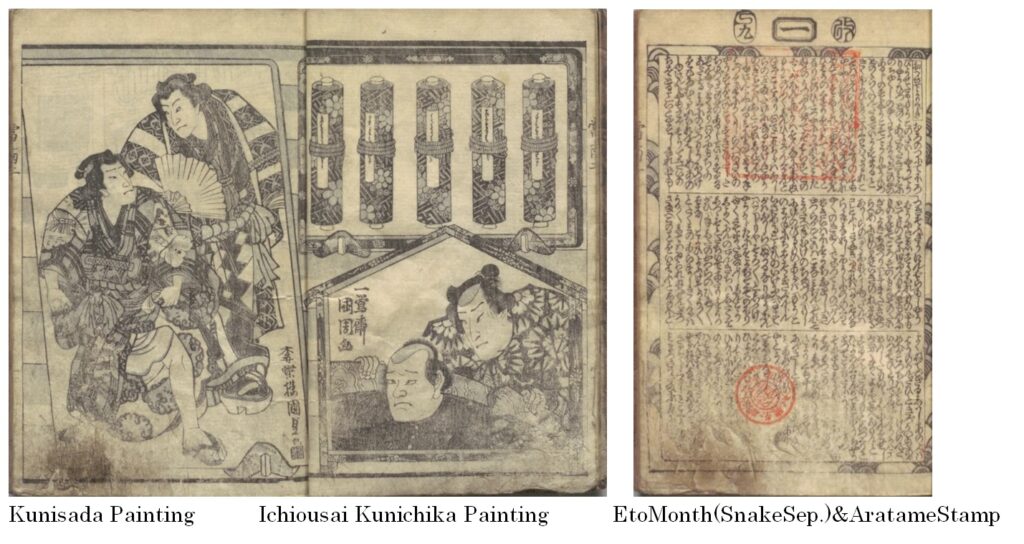
https://dl.ndl.go.jp/info:ndljp/pid/10303979?tocOpened=1
.
Iga’s Adauchi, by Kanagaki Robun Kunichika painting Japanese classic register comprehensive catalog database
The first part and the second part are combined to form the first volume, and the third and fourth parts are combined to form the second volume. The cover is decorated with nishiki-e, and “Kunichika Painting” is written on the first volume cover. The preface says “Kinotohitsuji New Spring” (1860), but the painting was drawn in 1857 because the upper and lower volumes are stamped with EtoMonthStamp (SnakeMay) and AratameStamp. Beginning with a picture of a villain rampaging, samurai and tradesmen are drawn to express the development of the story. The facial expressions of the characters are drawn richly, and the backgrounds of the rooms are also carefully drawn. Although not shown here, the paintings give a clear picture of the story, such as a samurai pleading with his lord, the samurai on either side of him with confused expressions, and a page boy listening in on what is going on. At the end of the 4th volume, it was written as Kunichika painting and Toshidama Stamp was stamped, and in the picture it was also written as painter Utagawa Kunichika. The illustrations are drawn using only lines, so the patterns on the kimonos the characters are wearing are carefully drawn to give them a sense of three-dimensionality. The careful depiction of the patterns on the twisted parts of the kimono to create a sense of three-dimensionality is common in illustrations, but this is a masterful work.
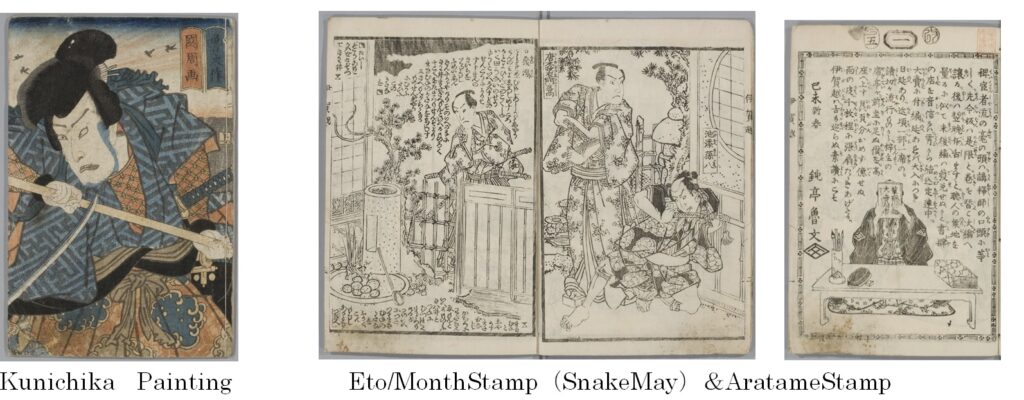
.
YoritomoYoshitsune Ichidaiki 頼朝義経一代記 By Santei Haruma Kunichika Painting(ARC古典籍ポータルデーターベース)
This material consists of 3 volumes, the first volume consists of 1 to 4 parts, and Kunichika was in charge of the illustrations for the first volume. The first part is EtoMonthStamp (Snake June) and the third part is EtoMonthStamp (Snake July), so it was drawn in 1857. Part 2 and 3 were illustrated by Kunihisa and stamped with EtoMonthStamp (RabbitFebruary) and AratameStamp. It was painted in 1855 due to its censorship style. I felt a sense of incongruity even though the 2nd and 3rd episodes were drawn first. Volume 1 is described as “Yoritomo Seiunki” in the preface, and Yoritomo plays the leading role. The 2nd and 3rd stories depict Yoshitsune’s activities. This suggests that in 1855 there was a popular kusazoshi book depicting the exploits of Yoshitsune, and later another kusazoshi book depicting the exploits of Yoritomo (Yoritomo Seiunroku) was written, and these were bound together into a book called “Yoritomo Yoshitsune Ichibi-ki.” This shows that, as is the case today, Yoshitsune was more popular than Yoritomo. There were scenes of warriors fighting violently with their armor drawn quite carefully, as well as pictures that were drawn from a wide perspective. Many of the facial expressions are drawn at the moment when power is applied, and there is little variety in facial expressions, and it is drawn as a heroic story. The characters are Samato Yoshitomo (Yoritomo and Yoshitsune’s father), and the story begins with the appearance of “Mongakushounin”. Yoritomo appeared as “Hyoeisa Yoritomo”. In addition, Hojo Munetoki, Sasaki Sadatsuna, Okabe Yajirou, Sasaki Saburo Moritsuna, and others appear, and the fierce battle movements of warriors in armor are skillfully expressed and developed.
“Yoritomo Seiunroku, Santei Haruma’s work, Ansei 5 year, 1858” that appears in the database is thought to be a book based on only the first volume of “Yoritomo Yoshitsune Ichidaiki” drawn by Kunichika, but this is unconfirmed. A similar work, ” Yoritomo Ichidaiki” by Kunichika, was introduced as having been produced in 1856.
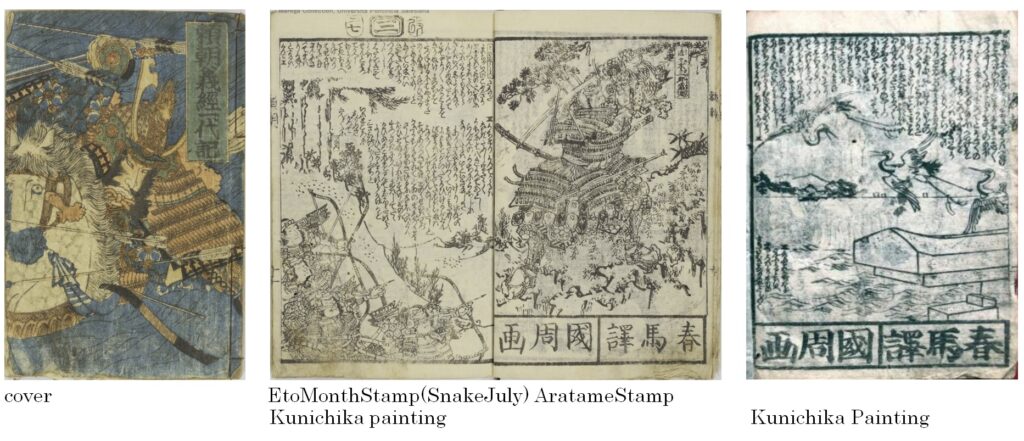
.
Hokusetsu Bidan Jidaikagami 北雪美談 時代加々見 By Tamenaga Shunsui Kunisada Painting Assistant:Kunichika New Japanese Classical Books Comprehensive Database
This story was written over a long period of time, from the first story (1854) to the 32nd story (1863). Ichiousai’s name was mentioned in Chapter 12. The EtoMonthStamp (SnakeApril) and the AratameStamp were stamped on it, so it was judged to be 1857 from the style. The words “Ichiousai Painting” can be read on the picture screen in this edition. A picture of a bamboo grove is drawn, but it is a picture of Kunichika. This book had no color and all pictures were carefully drawn by Kunisada.

https://kotenseki.nijl.ac.jp/biblio/200006188/viewer/1
.
Yorimitsu Ooeyamairi By Gyokujinen Setsuju Kunichika painting, Noda City Library collection
The publisher is Shinshu Tozando. Outside the text, there is an AratameStamp and an EtoMonthStamp (Snake January). This censorship style indicates that it was written in 1857. The database also has information that a book with the same title was published by Moriya Jihei in 1859. However, the book in the Noda City Library collection was published by Shinshu Tozando and was written about two years earlier. I have not compared it with the Moriya Jihei version, but I think the illustrations and censorship stamps are the same. I have not examined all the pages in person, but here there is a strange drawing of a tsuchigumo (large spider) in the lower left corner. Speaking of Yorimitsu and Oeyama, it brings to mind the slaying of Shuten-doji on Mt. Oe. The story of “Yorimitsu Oeyamairi” also recalls the story of Yorimitsu ordering four warlords (Watanabe Tsuna, Sakata Kintoki, Tobe Suetake, and Usui Sadamitsu) to exterminate the tsuchigumo (spider spiders). In the folk history book of the Edo period, “Zen Taiheiki, ” this story is known as “The Extermination of the Tsuchigumo on Mount Katsuragi” (70).
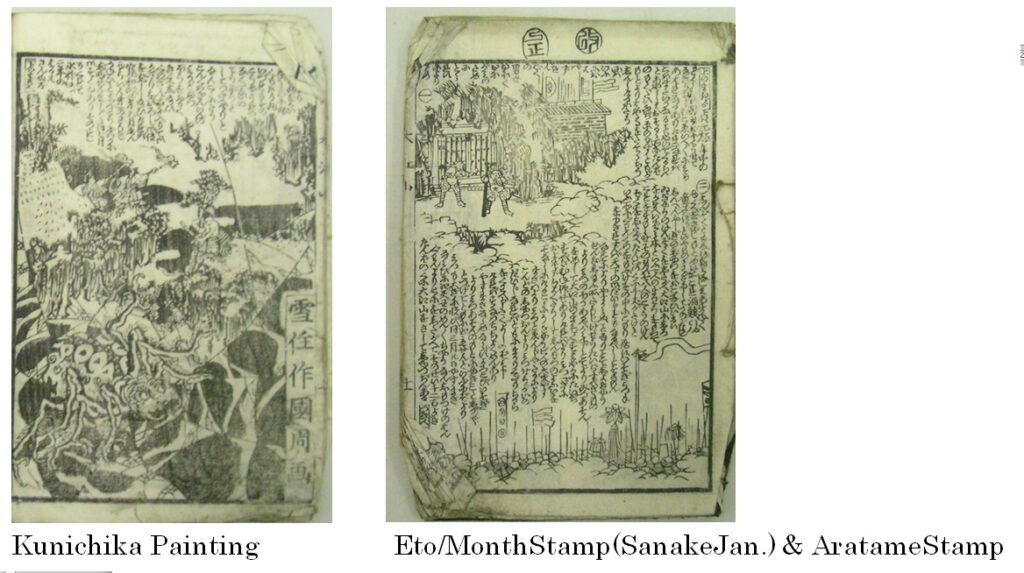
https://www.library-noda.jp/homepage/digilib/wako/124.html
.
Shiraisi Monogatari白石物語 仮名垣魯文作 国周画 一鶯齋国周画 (国文学研究資料館)
The book was published by Moriya Jihei, and EtoMonthStamp (Snake July) and AratameStamp were stamped in the margin of the first volume. The second volume was stamped only by AratameStamp, but it was judged to be the same year as the first volume, so it was made in 1857. On the last page of the second volume, Ichiousai Kunichika’s signature and Tosidama Stamp were drawn under his signature. Vigorous movements and emotional expressions must be prominent due to the need to expand the image of the story. The 26 frames (pages on the database) were also vividly depicted, such as scenes of fierce fighting. Thus, there is a big difference between the 1855 “Sumidagawa Yowatashi no Zu” and this illustration. The illustrations are characterized by being conscious of the development of the story and intense movements.

Kawanakajima Retsusen Kouki , Volume 1, Utagawa Kunichika, from the Catalogue of the 160th Anniversary Exhibition of Toyohara Kunichika
In the catalogue (79, p185), “Snake December” is written in the preface, so the painting was dated December 1857. However, the censor’s stamp in the text has not been confirmed, so the year the painting was made may be slightly off. The owner, Makuuchi Tatsuji, contacted me and said that the artist’s name is listed as “Utagawa Kunichika.” The depiction of the weapons is detailed and meticulous. The horse is also drawn carefully. However, since the painting shows Uesugi Kenshin pointing at the enemy, I think the horse could have braced itself, but its movements still feel stiff.
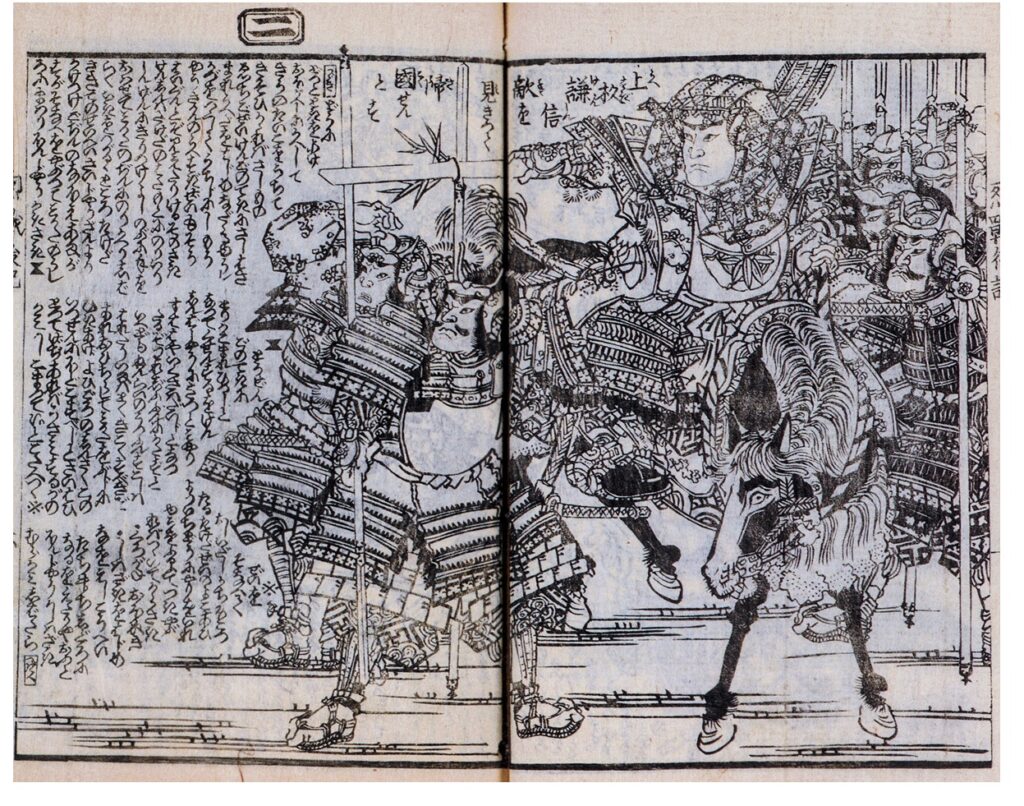
Ukiyo-e field
“浅草山中花くらべ” By Kunisada The scenery was drawn by Kunichika the National Diet Library Digital寄別2-9-1-6
In May 1857, he painted the background of Kunisada II’s “Asakusa Sanchuu Hana Kurabe”. One of the five large papers works of Kunisada II’s “Asakusa Sanchuu Hana Kurabe” has the mark “背景国周Kunichika draws the scenery”, and the word “disciple” is not used. It is said that he was in charge of only the background of the painting of Kunisada II. The way to draw the cherry blossoms is the same for all five pictures, but the townspeople who appear in the background are carefully drawn for the small size of this picture. It is a work of 1857 because it is a style of EtoMonthStamp (SnakeJan.) and AratameStamp. The publication was Tsujiokaya.
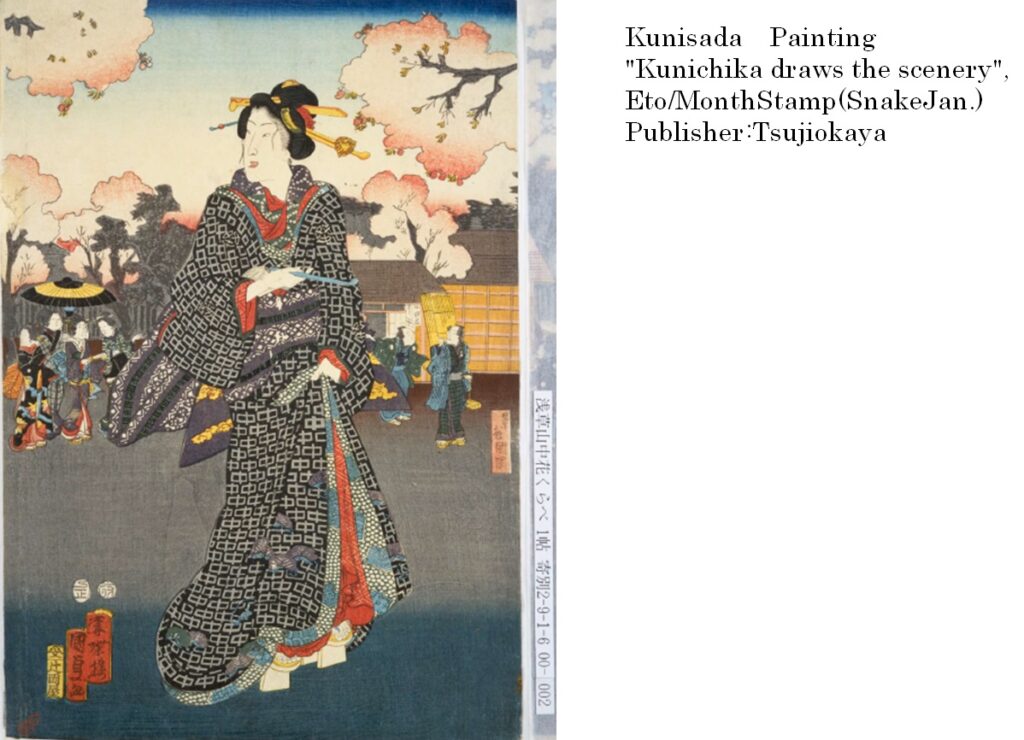
https://dl.ndl.go.jp/info:ndljp/pid/1305498
.
Imayo Genji no Uchi Tsuki (2 pieces) from the Boston Museum of Fine Arts and Cormorant Night Party (triptych) from Waseda Library Ichiousai Kunichika, Kachourou Kunichika and Kunichika Painting
“Imayou Genji no uchi Tsuki” was drawn in 1857 because it is EtoMonthStamp (DragonMarch) & AratameStamp. The publication is Ueju, so Kinjudo Joshuya Juuzo. This “Imayou Genji no uchi Tsuki” is a screen with an aspect ratio of 2: 3 that combines two large-sized papers and carefully depicts the night when the cormorant fishing is fishing in the background, with a moving picture rather than a quiet standing atmosphere. The main character, Genji, is drawn in a fixed pattern called “Ebichasenmage”(20,p41). In other words, the prawn-shaped topknot is painted in brown, and the kimono is painted in bluish purple. He doesn’t look like the elegant Genji. He draws ordinary people and finishes them in ukiyo-e. The footwear drawn by Harunobu et al. is generally Japanese sandals, clogs with thin teeth, or clogs with rounded fronts, but here it seems difficult to walk with square clogs. The design of these geta is the same as the black-lacquered geta worn by the courtesans depicted in Suzuki Harunobu’s painting Yoshiwara no Bijin-go (The Beauty of Yoshiwara)(80) . Moreover, many geta with this design are introduced as garden geta (81). Apart from the details, it expresses a fun night around the waterside with the cormorant fishing in the background. Actually, this ukiyo-e was first found at the Boston Museum of Fine Arts, but it was exhibited as a work composed of two pieces, the center and the right. With these two, I thought the subject was clear and had a wonderful composition. However, upon closer examination, it was actually an ukiyo-e print by triptych, “Cormorant Night Party”. When it comes to Triptych, not only the person in the background but also the pond where the cormorant fishing is located is crushed and narrowed by the building, and the yellow and white of the wall and shoji are out of balance. I think it would be wonderful if it was an ukiyo-e that consisted only of the center and right pictures. In addition, there is a man like Genji in the back on the left, chatting with a woman. Therefore, it is undeniable that the subject is distracted. Even if many characters such as SoumaYoshikado Furutera no zu(1858) are drawn, each of them is useful for the composition of the leading role and the supporting role. In Asakusa Kinryusan Ichinozu(1858), more characters are made to appear and the picture is established without making the person the main character. Compared to these, the night party of Ukahi has a composition like two main characters, and the subject is not narrowed down. There is something very interesting. The picture on the far left is published by “Santetsu”, that is, Mikawaya Tetsugoro. In other words, it is thought that Mikawaya Tetsugoro added the left side.

.
Ukai’s Night Feast
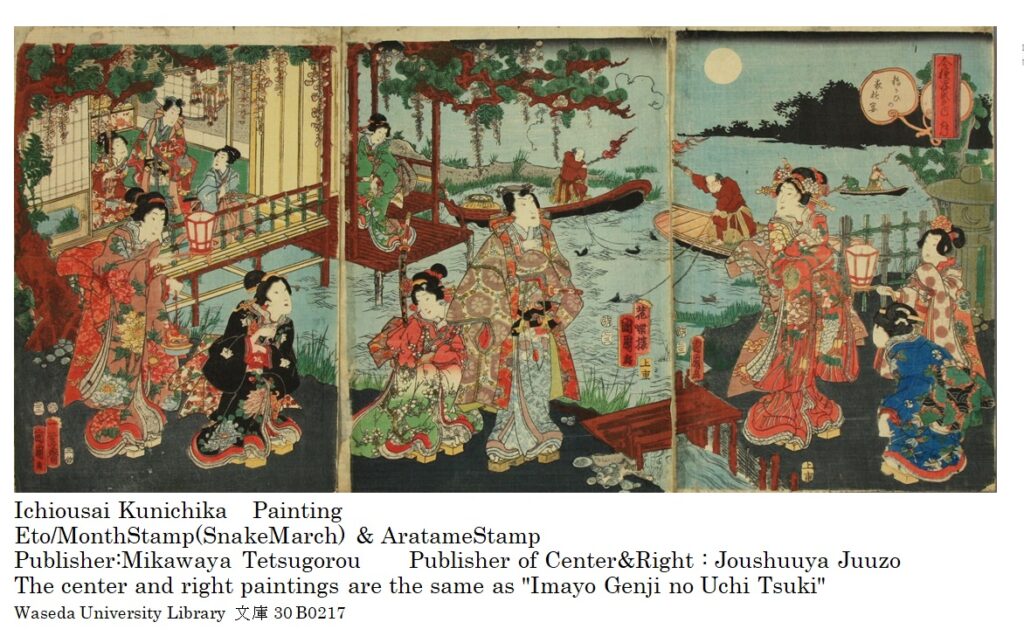
This work is thought to have been drawn with reference to Ashikaga Kinutezome Murasaki, illustrated by Toyokuni, Vol. 6 and 7, Kaei 3 (private information from Makuuchi Tatsuji). The preface to this book states that it was published in Kaei 3, and the censors’ stamps were from two Nanushi (Yonekura and Murata), so the illustrations were drawn between 1842 and 1850.
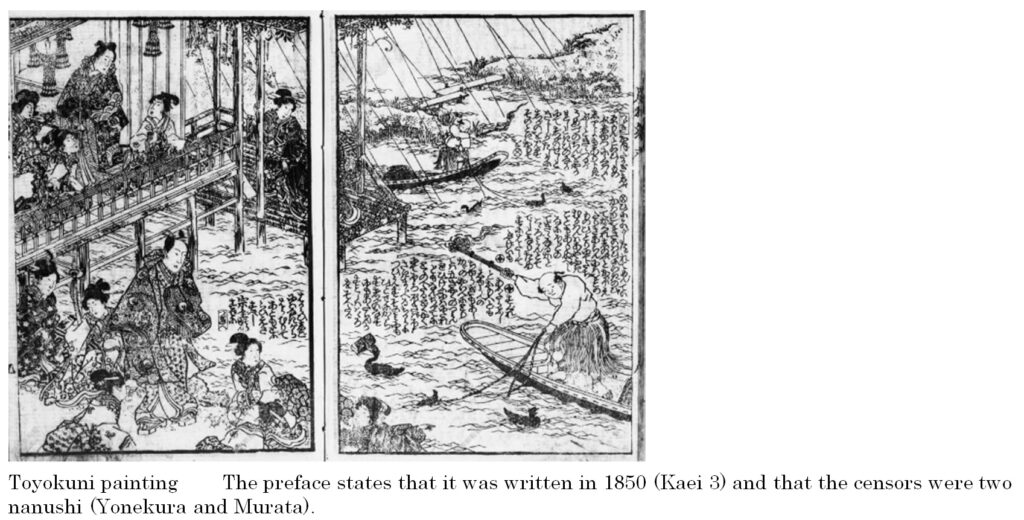
Kunichika seems to have created the ukiyo-e based on the illustrations in Toyokuni’s book from almost seven years earlier. Ashikaga kinutezome Murasaki is drawn using the IjidouzuHou: Heterochronic Homogeneous Law, just like the Tale of Genji picture scrolls, so the main characters are drawn side by side. Kunichika seems to have followed this IjidouzuHou: Heterochronic Homogeneous Law for his triptych ukiyo-e. Therefore, while it would not be strange to have two Genjis in a picture scroll, when drawn as an ukiyo-e, he thinks that having two Genjis distracts from the main subject.
Junikagetsu no uchi Ookawadoori 十二ヶ月の内 正月 大川通りの景 Ichiousai Kunichika Owned by Nakano City Museum of History and Folklore, Tokyo
During New Year’s, a girl with her hair tied up in the Takashimada style(56) is trying to avoid a falling kite, which causes her to miss her hit with a shuttlecock. She is depicted as having lost her balance, with her right foot raised up, giving the painting a sense of movement. The way her body twists is skillfully done. In the background, the boy who let the kite go is chasing after it, nicely illustrating the story. Behind the woman are samurai, townspeople, and children celebrating New Year. The woman is a townswoman, and the painting depicts New Year’s.
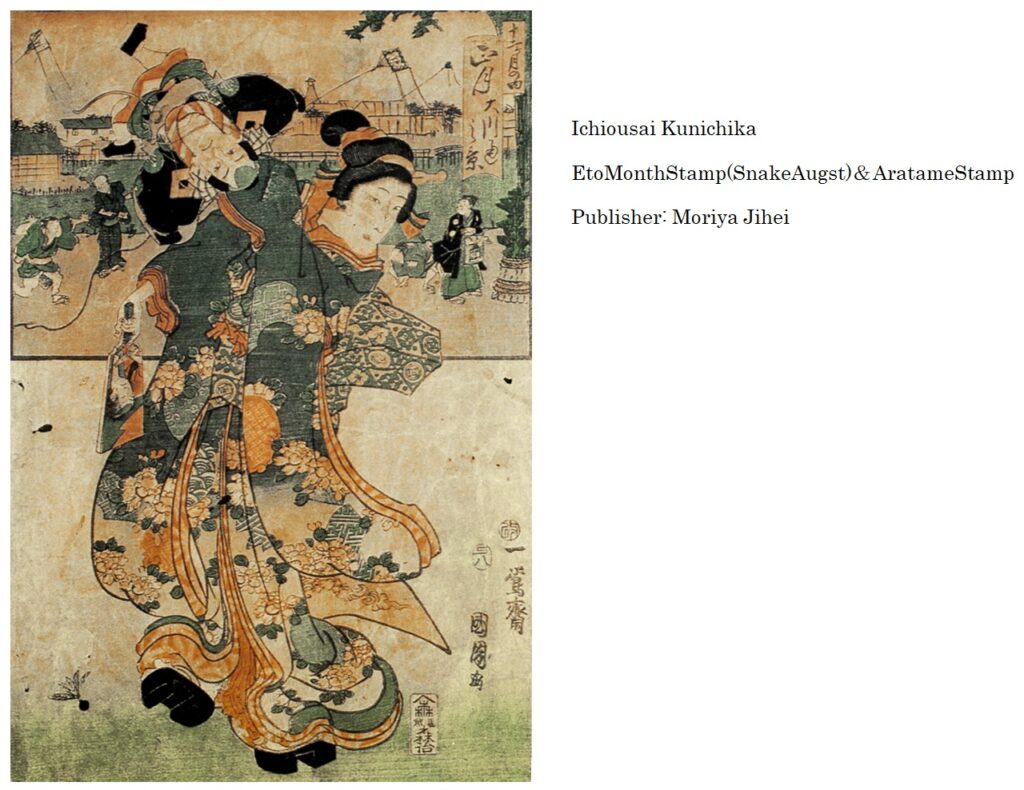
Junikagetsu no uchi Kanbutsue 十二ヶ月の内 灌仏会 Kachourou Kunichika Catalogue of the Toyohara Kunichika Exhibition(60)
Kanbutsue is a festival held on April 8th, which is Buddha’s birthday. The Buddha is enshrined in a flower hall decorated with seasonal flowers such as peonies and wisteria, and his birth is celebrated by pouring sweet tea over it (56). This scene is depicted in the background of this painting. It seems that shops lined the approach to the shrine. The flower hall in the upper right is not decorated, but a large barrel is depicted. The main character, a woman, appears to have written with ink on some kind of strip of paper, but she places her brush on it and points to it. We do not know the culture of the time and cannot understand this at all, but it appears to depict a lot of information.

Ansei 5th Horse 1858 安政5年
This year, 4 illustrations and 11 ukiyo-e were kept. In Ukiyo-e, there are portraits of Sekitori with compositions similar to those of his master Toyokuni III, as well as works depicting ordinary people’s daily lives, Kunichika’s first Ōkubi-e, and his masterpiece Manga-e. The ukiyo-e paintings he painted in this year were extremely wide-ranging and showed that he was capable of painting pictures in a variety of genres. The impression was given that he shifted his focus from his field of illustration to the field of ukiyo-e.
Fielld of Illustration
Kachikachiyama by Dontei Robun Painter:Kunichika, Ichiousai Kunichika Painting Waseda University Library
This book is a compilation of Volumes 1 and 2, each with its own cover. The publisher is Itoya Fukujirou. Illustrations are often drawn on the back and back of the cover, but there is no picture on the back of this book. In the case of books that were rebound and stored in later years, the picture on the cover is often gone, but since the cover remains, it seems that there was no illustration on the back cover from the beginning. On the last page of Kusazoushi (one of the book types) in the first volume, Ichiousai Kunichika painting and Toshidama Stamp were pressed. Since there are EtoMonthStamp (HorseSeptember) and AratameStamp outside the text frame, the picture was drawn in 1858, and since the preface says “Ansei Tsuchinoto Hitsuji early spring”, it was published in 1859. Although the illustrations are anthropomorphic animals, they are not animals with gentle faces, but rather pictures that are a little more realistic and create a unique atmosphere such as “a scary fairy tale” when viewed with modern eyes.
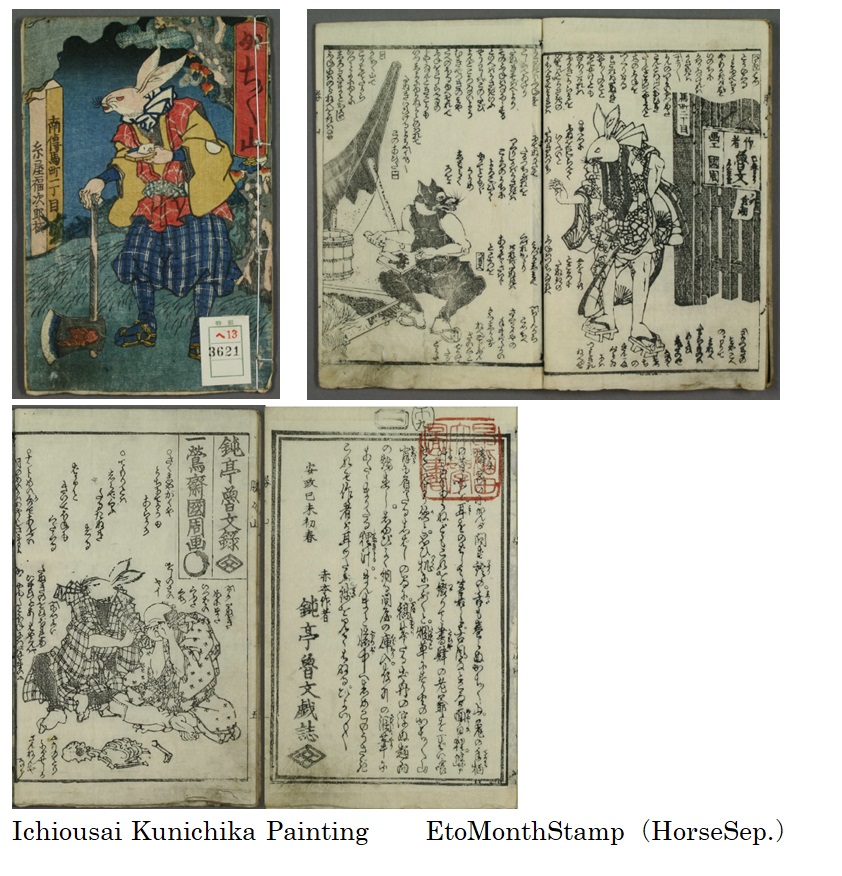
https://archive.wul.waseda.ac.jp/kosho/he13/he13_03621/he13_03621.pdf
.
New Version Saigoku Kidan Vol. 7 , by Tamenaga Shunsui, Kunichika Painting, Kunichika Assistance, Ansei 4th Year, National Diet Library Digital
The cover of the first volume was drawn by Toyokuni III, and the illustrations in the text were drawn by Kunisada II. Kunichika assisted with the last page of the first volume, and drew the illustration of the full moon and pine trees on the inside cover of the second volume. The preface to this book states that the manuscript was started in 1857, and it was published in 1859. Both volumes have Eto Month Stamps (February, Horse) in the text, so the illustrations were drawn in 1858, the Year of the Horse. The publisher was Kagaya Kichibei. In the image below, it says in the bottom right that “Kunichika assisted with half of the right page.” The illustration of the full moon and pine tree on the inside cover of the second volume of the seventh collection was drawn by Kunichika.

.
Igagoe Adauchi (伊賀越仇討) the first volume by Rakutei Saiba, Ichiousai Kunichika Painting ( from internet image)
The cover was drawn by Kunichika, and the illustration was drawn by Ichiousai Kunichika. The cover is a colored woodblock print, but the inside of the book consists of line drawings. It depicts revenge things featuring samurai and townspeople. The preface stated that the manuscript was made in Ansei 5 (1858) and was released in 1859 in the sheep year. However, the stamp that censored the painting is unknown. Therefore, the picture may be written in 1858. The painting depicts people wearing kimonos with carefully drawn patterns developing lively action scenes, but there is little change in individual facial expressions and their movements still give the impression of being awkward. The publisher is Yamaguchiya Toubei.
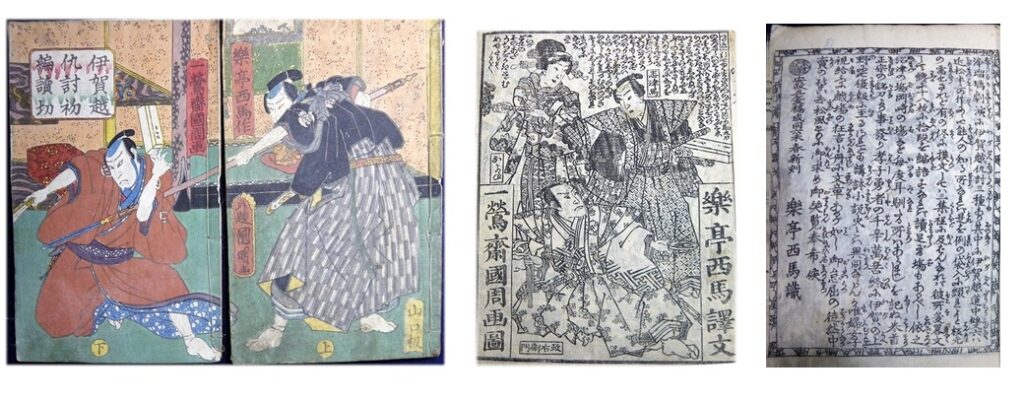
http://kitasan1970.livedoor.blog/archives/243239.html
.
Osiegusa Asagao Monogarari教草朝顔物語八編 By Santou Kyouzan Roujin Kunichika painting Waseda University library
The first volume of this series was published in 1848 because it was censored by two Nanushi stamps and was dated the first year of Kaei. Toyokuni III drew 1 to 3 volumes illustrations. After that, 4 volumes were drawn by Yoshitora, 5 to 7 volumes were drawn by Kunisada II, and the final 8 volumes were drawn by Kunichika in 1858, the 10th year since the series began. The author is Santou Kyouzan and the publisher is Moriya Jihei. The catalog at the end of the book says it was published in 1861, but the picture in the text is only EtoMonthStamp (HorseJune). Therefore, it is considered to be a work of 1858. The movements of the characters in the illustrations are fluid and supple, giving the impression of movement. The eyes are well drawn, so the characters’ conversations are well expressed, but the facial expressions are still lacking. The backgrounds are also carefully drawn. The illustrations alone are enough to understand the development of the story. The illustration on the back of the cover is also drawn by Kunichika. On the last page, it is written that the illustration was drawn by Kunichika, and instead of the commonly used Toshidama Stamp, it uses a square stamp type seal with Kunichika written in a seal carving. This font is also used in the memorial picture of Toyokuni III drawn in 1864.
The next illustration shows a woman wearing clogs. Her clogs are thick-sliced two-tooth clogs. This type of geta was also depicted in the paintings “Tosei Bijin Soroi” and “Imayo Genji no Uchitsuki”. In other paintings, geta that are easy to walk in are depicted, but there is still some doubt as to why they sometimes depict geta that are difficult to walk in. This type of geta shape is suited to walking while making an intentional “karan koron” noise.
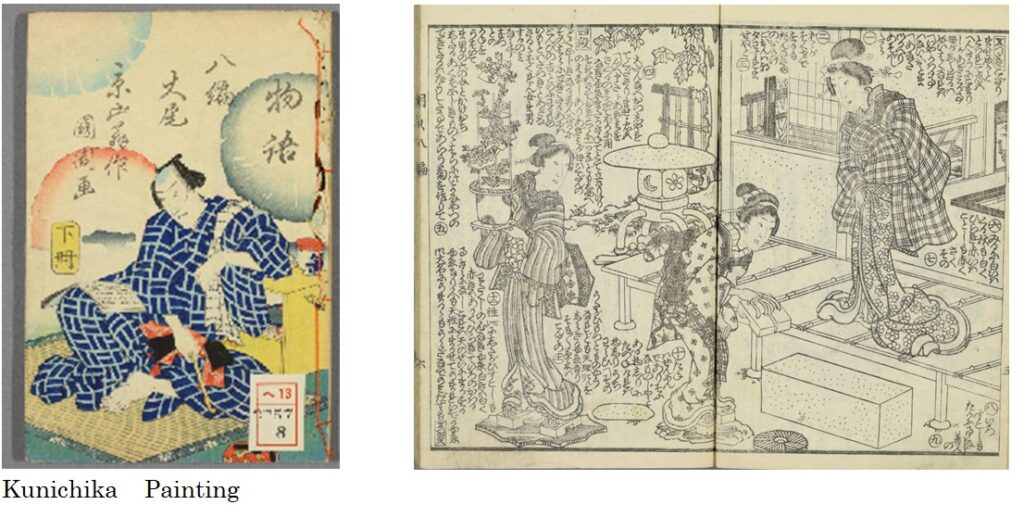
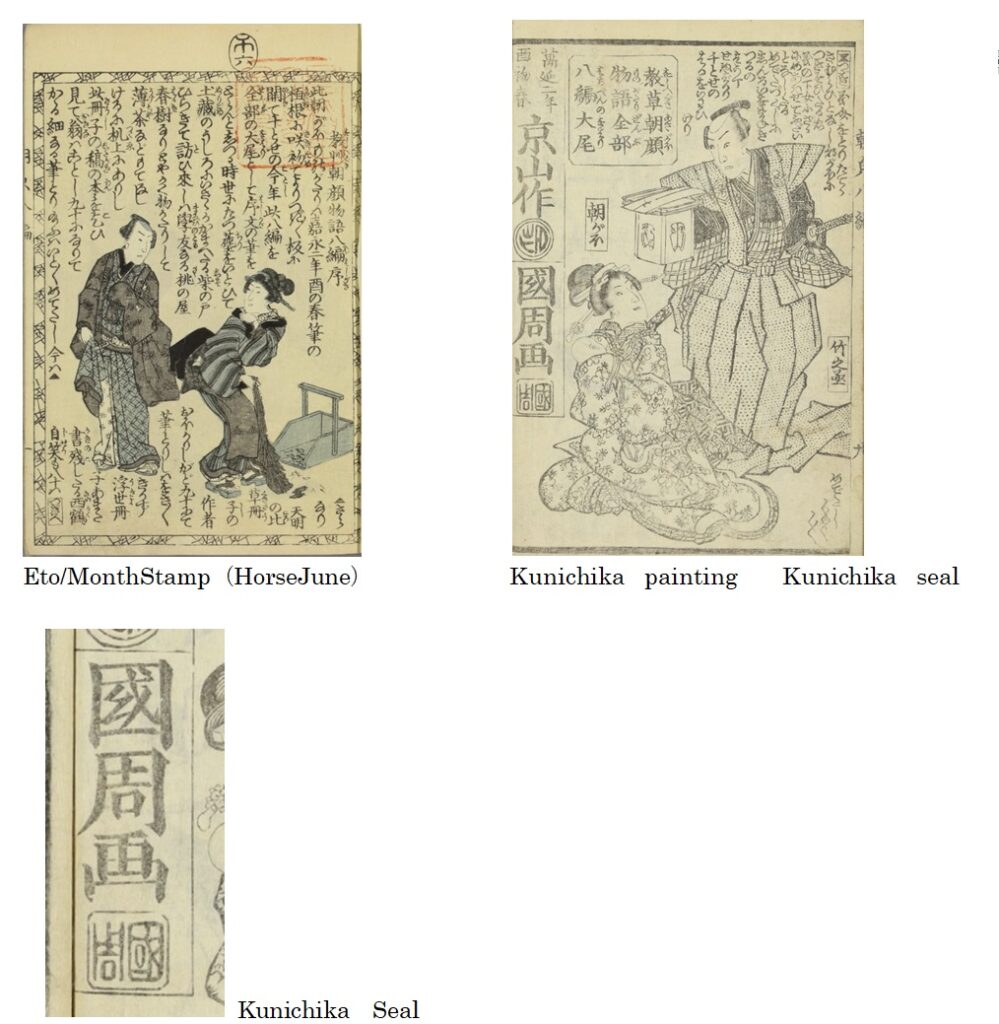
he13_03757_0008.pdf (waseda.ac.jp) https://archive.wul.waseda.ac.jp/kosho/he13/he13_03757/
Ukiyo-e field
Nijigadake Senemon Ichiousai Kunichika National Diet Library 本別7-27 04-009
Kunichika has published a work similar to the painting of Master Utagawa Toyokuni III. Kunichika drew “Nijigatake Somaemon虹ヶ嶽杣右ヱ門”, but in 1857 the year before, Utagawa Toyokuni III released “Kurume Onogawa Saisuke久留米小の川才助”. This painting gives the impression that the overall composition and appearance are similar. Both of them were famous sumo wrestlers at that time. This year, Kunichika also depicts two Sekitori (high-ranking sumo wrestlers), “Matsugaeda Kichisaburou松ヶ枝喜三郎” and “Washigahama Otoemon鷲ヶ浜音右衛門”. The faces were different, but the composition of the standing figure was exactly the same. In 1860, Kuniaki also released “Ohnaruto Nadaemon大鳴門灘右エ門” with almost the same composition design. It is famous that the Ukiyo-e was drawn in the background of the painting “Portrait of Emile Zola” painted by Edouard Manet in 1868. The composition of this standing figure seems to be a standard pattern as a sumo wrestler portrait at that time, and Kuniaki II draws “UmegayaToutarou梅ヶ谷藤太郎” and Sadanobu draws “Hibikiya Kumajuurou響矢熊十郎” with the same composition. Perhaps the disciples started by copying the master, or from another point of view, copying was a culture that was endorsed.
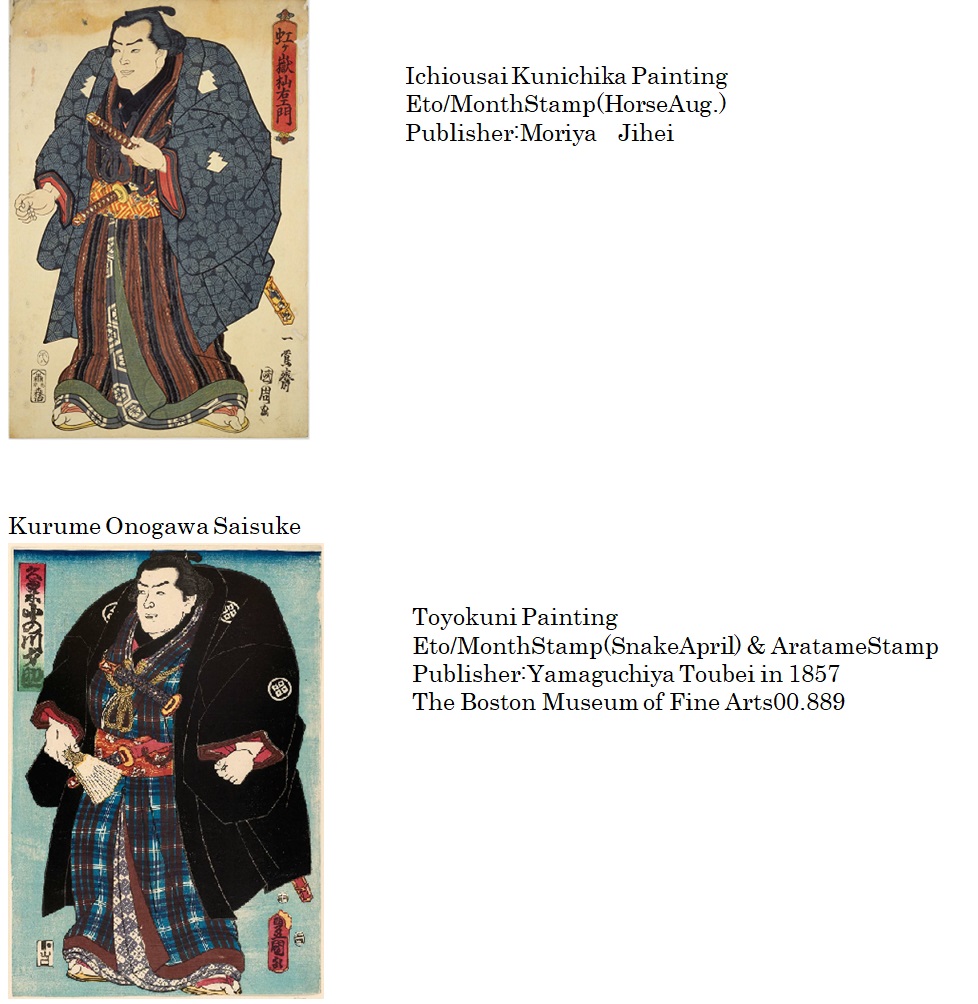
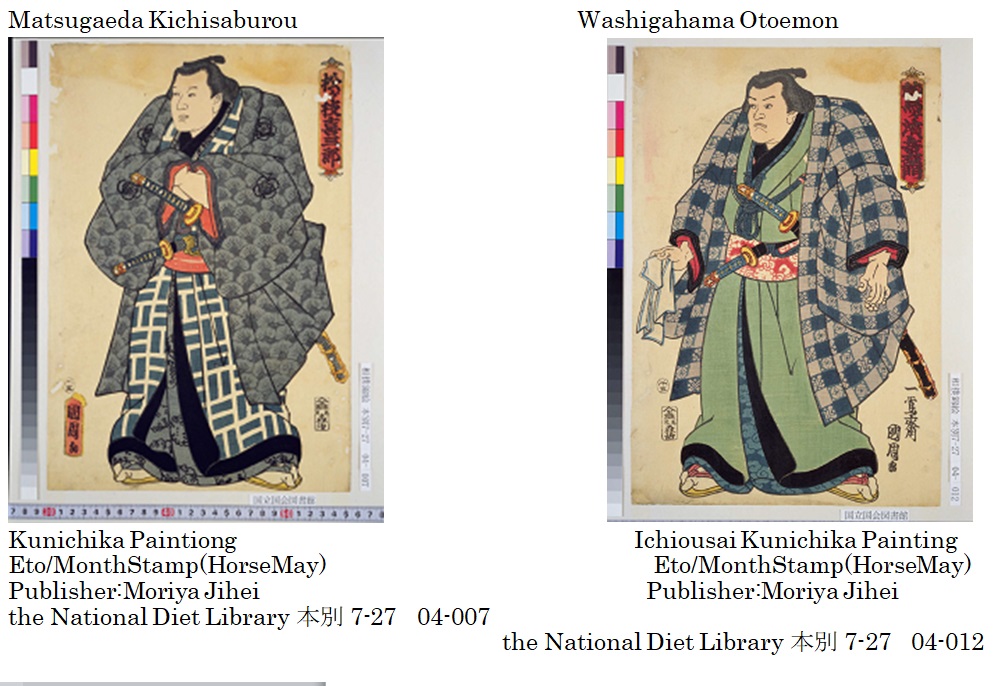
.
Onoe Kanbei, Kachorou Kunichika Painting, Catalogue of the Toyohara Kunichika Exhibition Commemorating the 190th Anniversary of His Birth
All of the sumo wrestlers’ works painted in May and August depicted them calmly and standing still, but this painting, painted in November, shows him with his sleeves rolled up and glaring slightly. There has been a shift from portrait-type paintings of standing figures to paintings of a story.
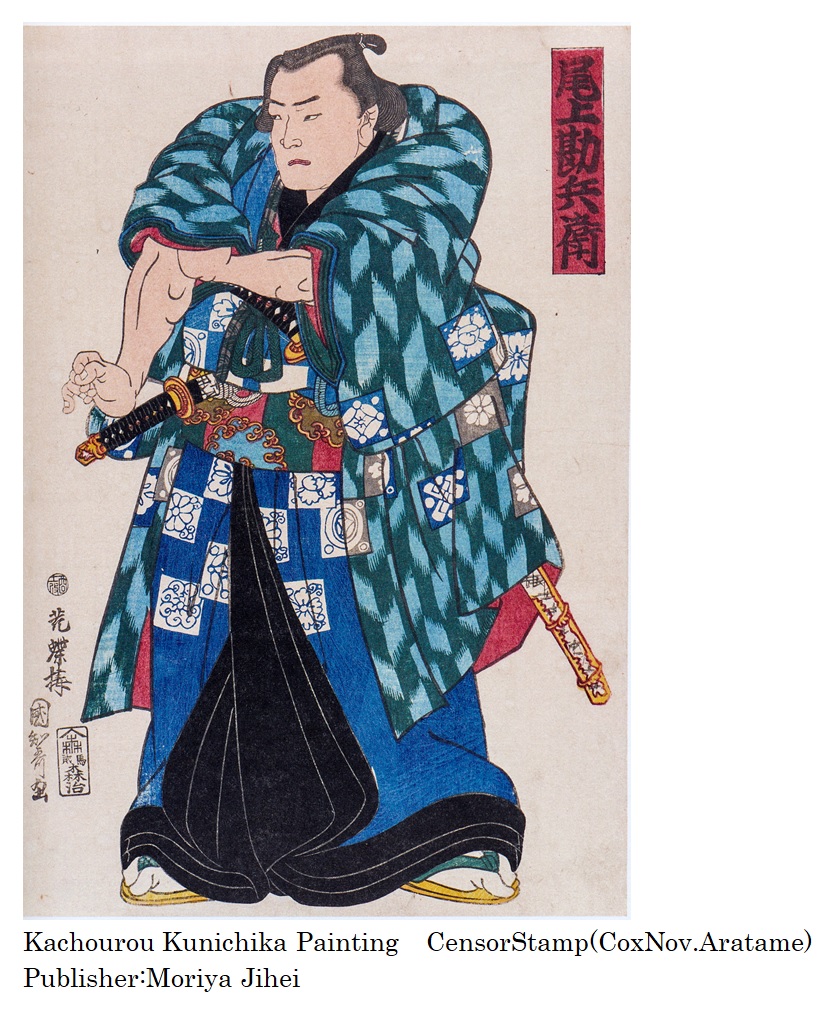
Tousei Bijin soroi Kunichika & Ichiousai Kunichika Painting The Boston Museum of Fine Arts00.1245a-c
In 1858, the movement was incorporated into the beauty ukiyo-e, and the panoramic screen (aspect ratio 1: 2) gave a sense of perspective, creating a picture that captures the moment.This painting shows three groups of women talking, each talking about a different topic. On the left, something good has happened to her, and she is leaning over a woman who is doing handiwork, wanting someone to listen to her. In the center, the woman is about to show a letter to the woman next to her. The woman on the right appears to have already read the letter, as she is gazing at the full moon and seems lost in thought. In the picture on the right, she is enjoying shrimp fishing and perhaps bragging about it. It’s a natural scene where the viewer of the painting passed by to the place where the chatter and noise of such women could be heard from a distance. It’s not an ukiyo-e that a beautiful woman stands in, but an ukiyo-e that looks like a cutout of everyday life. It can be described as a genre painting of women. For that reason, Kunichika’s ukiyo-e may have been evaluated by some viewers as unsophisticated.

.
Tousei Bijinnsoroi Evening light at Kasumigaseki Painting by Ichiousai Kunichika Painting by Kunichika Catalogue of the Toyohara Kunichika Exhibition commemorating the 190th anniversary of his birth The painting on the far right is kept at the Victoria and Albert Museum, London
This painting is a triptych with the name of the place, Kasumigaseki, and the Kuronamako wall on the right side suggest that the mansion in the background is the Kuroda family of the Chikuzen Fukuoka Domain. The woman on the far right is wearing a furisode kimono and a man is serving her behind her with an umbrella and a hand towel, so she is the princess of this mansion town. It seems that it had been raining just a while ago. The woman on the far left seems to have rushed in wearing a kosode kimono and holding a hand towel. The woman in the center is putting her sleeves through and wiping her wet back with the hand towel around her back. The artist is skilled at depicting the atmosphere of a place through casual actions. The people in the background are not just passersby, but each has their own story, and there is a sense of depth. This work can also be considered a genre painting of women.
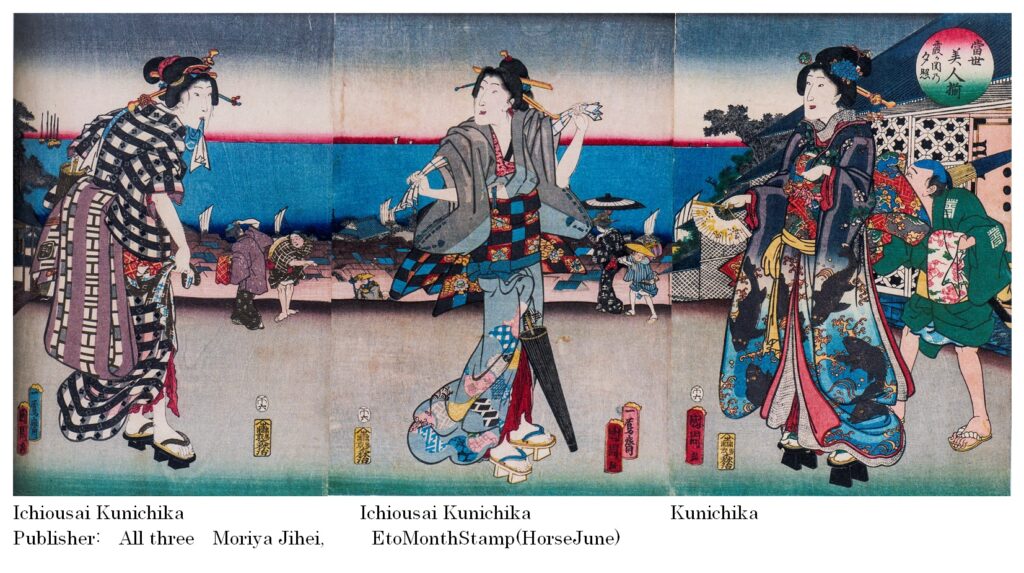
Asakusa Kinryuuzan Ichi no zu Kachourou Kunichika, Ichiousai Kunichika and Kunichika Painting The Boston Museum of Fine Arts 11.41698A-C
“浅草金龍山市之図” In 1858, a classic bird’s-eye view was used to depict the bustle of the city on a panoramic screen, creating a picture that would be fun for the viewer. In the spring when the cherry blossoms are in full bloom, a man who puts vegetables in a tub and puts it on his head, a man who rushes in with a loincloth, a parent and child who are watching the city from a building, a shelf with okame faces lined up , a man carrying a luggage with a balance pole, a man carrying a tub, and stuffing in a tight line, expressing the bustle of the city in a picture story.
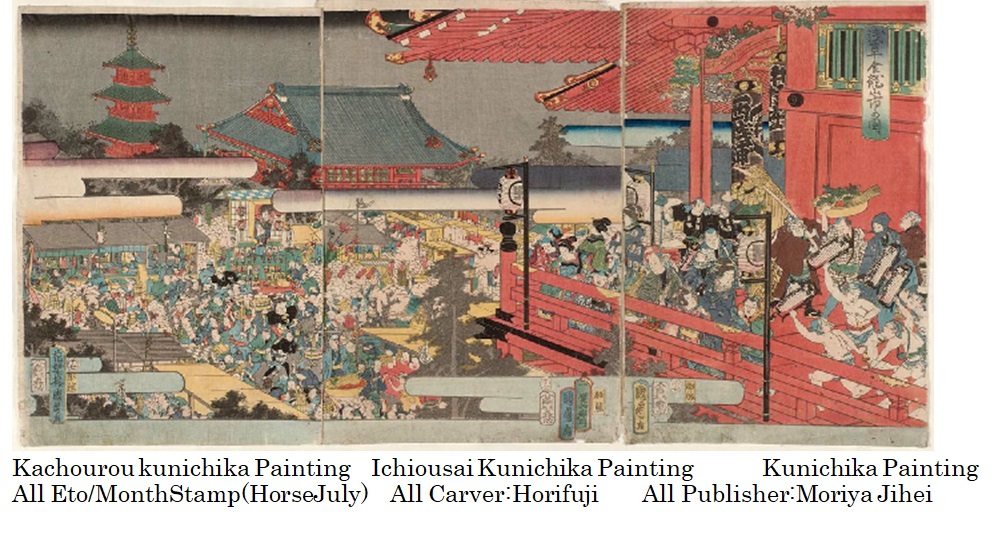
.
Sericulture Ichiousai Kunichika Painting Artelino (lower left)
Kunichika painted “sericulture” in 1858. He depicts a woman, but not a prostitute, but a woman who takes care of silk moths, in a wearing kimono that looks more like cotton than silk. In this painting, he did not depict prostitutes, but ordinary women and their lives. Of course, there are paintings depicting women at work, such as Katsukawa Shunsho and Kitao Shigemasa’s joint work “Sericulture of Silkworms” (1876) and Utamaro’s “Women’s Silkworm Handiwork” (1798-1800). Their paintings were Bijin-ga, which gracefully depicts women, Kunichika’s paintings are based on the theme of sericulture. Unlike traditional ukiyo-e, this painting does not depict a prostitute but an ordinary woman and her life, that is, a genre painting of women.
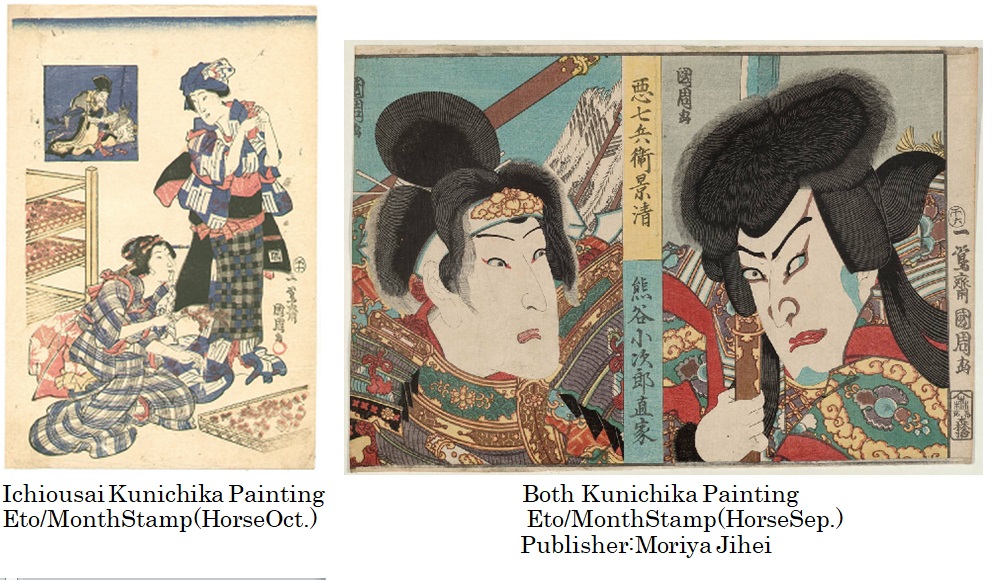
.
Aku Shichibei Kagekiyo, Kumagai Kojiro Naozane Ichiousai Kunichika Painting The Boston Museum of Fine Arts 11.22556 (upper right)
“Akushichibei Kagekiyo and Kumagai Kojiro Naoie” (1858) is a large-scale painting of the face, which Kunichika created in 1858 as the prototype of the style of painting that would later be called “Meiji Ohkubi-e” and “Ohkao-e”. Shunko was the first to paint such close-ups, followed by Sharaku. Many of the Ohkubi-e paintings are close-ups of the face, but the facial expression is a theatrical glare or deadpan style. Such close-ups can be used as a way of expressing the character’s feelings, such as intimidation, defiance, anger, surprise, or threat, through the actor to the viewer. Sharaku and Toyokuni III painted some such emotional expressions, but Kunichika completed them in 1869 with the Gusokuya set. This painting remained in the traditional style.
.
Genji Gosekku no Uchi July Tanabata Kunichika Painting the National Diet Library VF6-F3-15
“Genji Gosekku no uchi July Tanabata” depicts the celebration of the common people’s festival in their daily lives. The composition of the painting allows it to be appreciated even if the toriptych is detached. Following the traditional way of drawing, he draws a picture in which the common people are the main characters, but he draws everyday life, not a story. The composition of this painting was later followed by Kunichika’s disciples.

.
Furyu Mitate Fukutsukusi Kunichika & Ichiousai Kunichika Painting the National Diet Library VF6-F1-18
It seems to be an old style of painting that follows on from previous eras, but this is an Uke-e, of which some works remain from 1861. Uke-e is a painting that was given to those who entered the auspicious Uke-e from Onmyodo, with names that start with “Fu” such as Mt. Fuji, Fukusuke, Fukurokuju, and wisteria(fuji in Japanese). This painting features Mt. Fuji, Fukurokuju, Fujimusume, Fuwa Banzaemon, Fudesuke, and Fukusuke. It was a culture that was popular during the Edo period and disappeared during the Meiji period (66). The happy faces are drawn with simple brush strokes. This painting seems to be a set of two, and there is nothing unnatural on the left or right edges of the painting, so it is unlikely to be a triptych, but it would not be strange if there was another one. It may just be kept in a private collection and not on display.
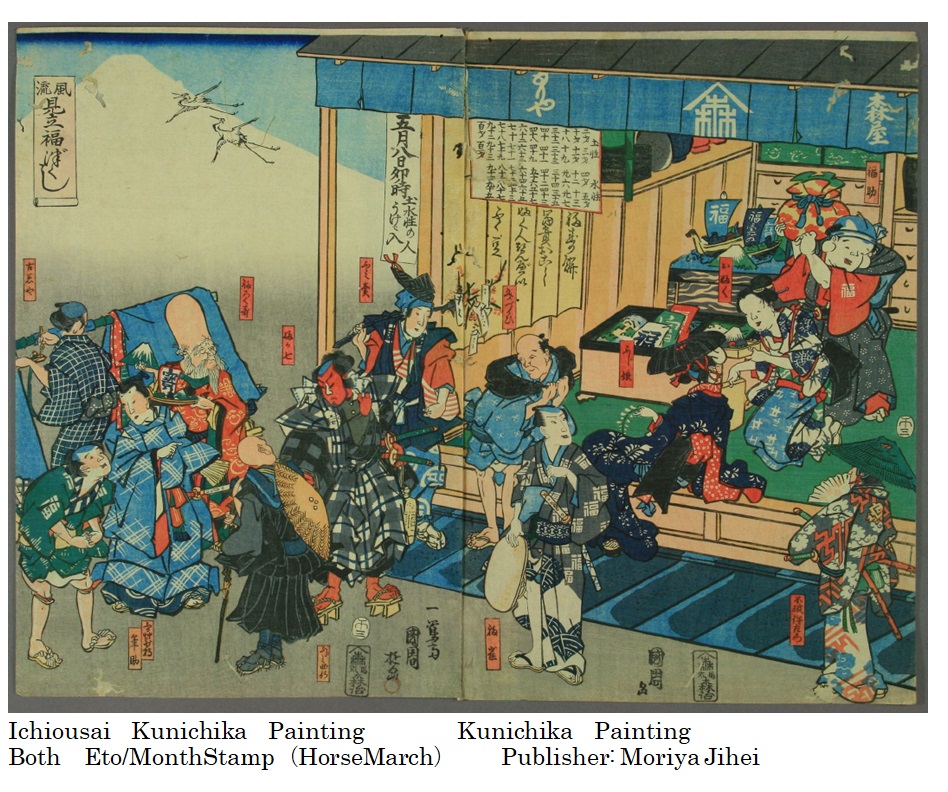
.
Mokuichigahikyoku Heikeichirui Arawarenozu目一秘曲平家一類顕図 Kachourou Kunichika Painting Waseda University Theater Museum 012-1422 etc
The Fujiokaya Diary (21) states that this ukiyo-e caused controversy as it alluded to the issue of succession in the shogunate, leading to arrests. The artist is listed as Kachoro 華蝶楼, but not Kunichika. The name Kachoro Kunichika (花蝶楼国周) was used in “Imayo Genji no uchi Tsuki” (Month of Genji in Modern Times) in 1857, “Junikagetsu no uchi Kanbutsue” in the same year, and “Asakusa kinryuzan ichi no zu” (June 1858). The name Kachoro(華蝶楼)was first used in September 1858 with this painting. In “Hotaru Asobi” (1861), he used the name Kachoro Kunichika(華蝶楼国周). For these reasons, Kachoro(華蝶楼)is thought to be Kunichika. The same judgment is made in “Ukiyo-e Artists by Inoue Kazuo” (2), which states that Kachoro 華蝶楼 is Kunichika. There are few works with this name. This painting vividly depicts the scene in which Zatō Tsukiichi makes a statement, but Emperor Antoku objects, and the other military commanders follow the Emperor’s lead. The awkwardness of Satsuma no Kami Tadayoshi and Seo Taro on Zatōichi’s side is also depicted, creating a tense situation.

Souma Yoshikado Furudera no Zu Kunichika Painting The Boston Museum of Fine Arts11.44458A-C
The story of this painting is part of Utoyasukata Chuugiden, a story about Taira no Masakado’s bereaved son Yoshikado and his younger sister Princess Takiyasha, who follow in their father’s footsteps and aim for revival(62). “Soma Yoshikado Furudera no Zu” In 1858, the story is written in a picture and it is wonderful to imagine the story just by looking at it. As Shogun Taro Yoshikado and his subordinate warriors look on, the sorceress Takiyashahime brings in a box and when she opens it, a monster comes out along with some smoke. The surprised appearance of his subordinates, the glaring appearance of Yoshikado, the young people making noise in the back regardless of anything, and behind Yoshikado, a huge toad that bestowed magic is staring at the room. In the back on the left, there are two women talking about something completely unrelated, and it’s fun to imagine their conversation. He brings expressive, ordinary people into the world of ukiyo-e, symbolized by paintings of beautiful women and landscapes, and gives the impression of bringing a story into which a number of these people are talking about all sorts of things. The story is familiar, so the viewer can understand what is depicted. Kunichika removes reality from his paintings and creates kawaii manga made up of fun pictures.
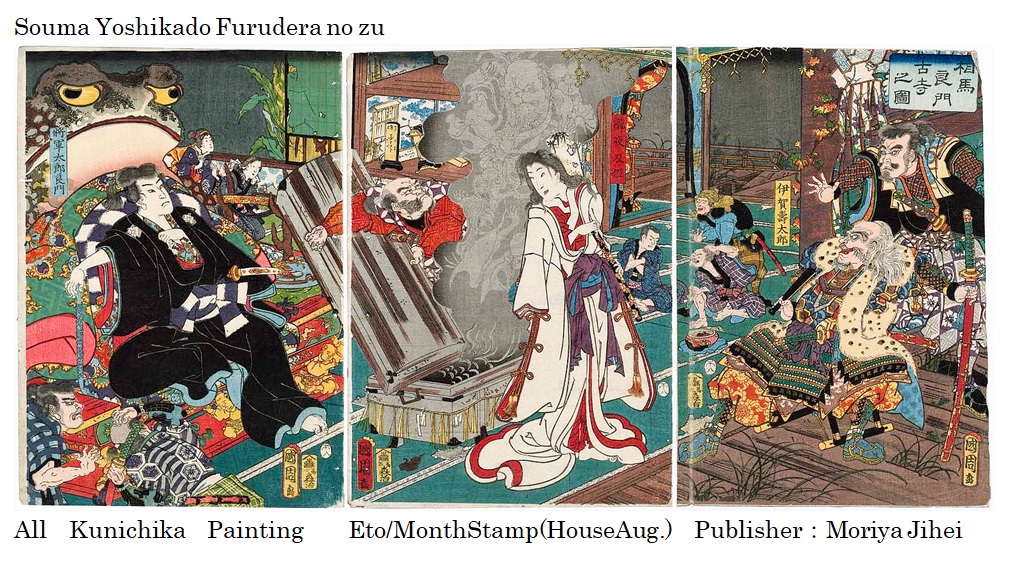
.
Ansei 6th Sheep 1859 安政6年
There are two works related to illustration works this year. Ukiyo-e seems to have begun to be drawn with kabuki-themed actor paintings, but since there is a mistake in the annual judgment of the holding institution in the ukiyo-e search, only the works that have been confirmed by the censor stamp are introduced here. See Chapter 1 for the criteria that were excluded. There are two ukiyo-e works. The British Museum’s “Hanamori Bijin Soroi” is explained as a crepe work (63) that is in storage. This is a picture of a courtesan. Kunichika occasionally painted such gorgeous ukiyo-e, but the number of works is small.
Field of Illustration
Katakiuchi shinodanomori(報讐信太森) Vol.1 &2 By Dontei Robun Ichiousai Kunichika Painting 国書データベース
The first part exists in the Akita Prefectural Library,
but only information. The content of the book has not yet been confirmed. The
second part is open to the public. The second part was published in 1859
because the preface says "Ansei Tsuchinoe Sheep Spring Kisaragi". The
Censor Stamp is combined into one with sheep / May /Aratame, so it's 1859. A
type of picture book that is divided into a page of text and a page of
pictures. A total of 14 scenes are drawn. The facial expressions are rich,
and the picture introduced next is a picture that looks like Kabuki, but the
other pictures are moving, and the story unfolds with a mixture of samurai and
tradesmen. Published by Nishikimorido.
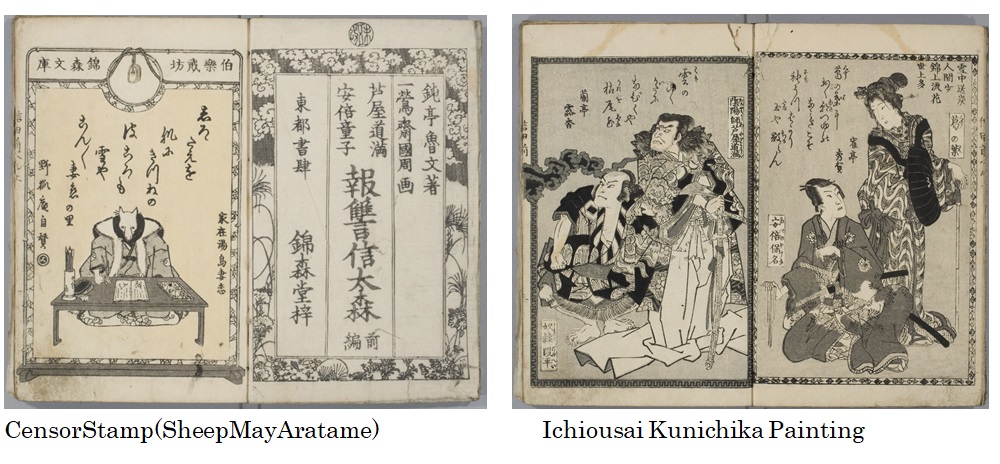
https://school.nijl.ac.jp/kindai/TKGN/TKGN-00067.html#1
.
英雄成生功記 Eiyuseishoukouki by Dontei Robun Ichiousai Kunichika Painting Union Catalogue of Early Japanese Books
The year of publication is 1860 because it is described as Kousin(庚申), but since there is CensorStamp(SheepJanuaryAratame) in the margin of the text, then the picture was drawn in 1859. The picture introduced is a scene in which his father Kiyotada is ill and entrusts Gorosaku with an innocent child, Toramatsu. The picture conveys a serious situation with facial expressions and gestures. The publisher is Itoya Shobei.
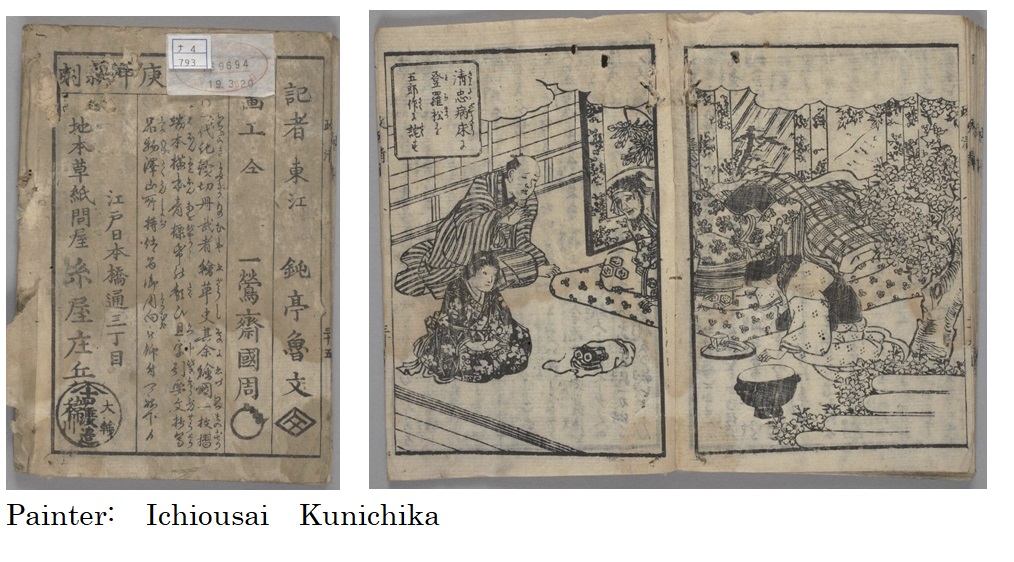
.
.
Ukiyo-e Field
An ukiyo-e search misclassified some of the actor paintings as works from 1859. Only works that are dating certain to be 1859 are introduced here.
Ataka no Seki Kanjinchou Kunichika Draw Waseda University Theater Museum 100-2832,2831,2830
This story is about Minamoto no Yoshitsune, who was suspected of plotting a rebellion against his older brother, Minamoto no Yoritomo, and was on the run. By saying that he fled to the Tohoku region, there is still a legend that Yoshitsune passed through here in various parts of Tohoku. Musashibo Benkei was a retainer who believed in Yoshitsune and followed him. Yoshitsune and his party, who fled toward the north, are interrogated by Togashinosuke Iemori at the checkpoint in Ataka. Benkei explains that he is working to collect donations for the construction of the temple, and he reads out the Kanjincho as evidence. This was all a fabrication, but Benkei escaped by unfolding a blank sheet of paper and reading it out loud as if it were written there. However, Togashi calls out a man among his followers who resembles Yoshitsune’s description. Benkei hits Yoshitsune, who pretends to be his attendant, saying, “I was suspected because you were procrastinating.” Seeing this, Togashi was impressed that his vassal had beaten the lord, so he silently overlooked it and passed it through the checkpoint.
The 1859 work “Ataka no Seki Kanjinchou” is Triptych. There are works by Kunichika and Toyokuni III as works with almost the same design. Comparing these two works, the paintings on the left and center of Triptych have different colors and gradations. The picture on the right has three major differences. The first point is that only the face of Togashinosuke Iemori has been completely replaced. The second point is whether or not the samurai clothes sitting around have a spider web-like pattern. The third point is that the cast name is described in the work of Toyokuni III, but in addition to the cast name, the actor names of Gonjuro, Shijaku, and Tomoemon are listed in the frame. These three points are the big differences. Others are exactly the same, similar enough to seem to be the same woodblock. In more detail, the Censor Stamps of all Toyokuni III works are( SheepJune Aratame), and the carvers are Koizumi Horikane. The publisher is Daikokuya Kinnosuke, and the name of Toyokuni III and the name of the carver are engraved. On the other hand, looking at Kunichika’s work, Kunichika’s name is engraved on the leftmost picture, but the center picture is stamped on the printed matter, and the rightmost picture is Kunichika’s work, but there is no Kunichika mark. The Censor Stamp is sheep / June / AratameStamp, and the issuance is the same as Toyokuni III. However, the carver was unknown and the publisher was Yamamoto Kyubei, but the stamp was stamped on the printed matter. Kunichika’s work did not appear to have undergone formal censorship procedures. It was a time when it was still forbidden to write cast names and actor names. It is probable that Master Toyokuni III produced only the cast name, and his disciple Kunichika made a casually written version in the upper right corner. In 1840, painters were free to draw actors in Kabuki paintings, but the following year, around 1841, the Tempo Reforms began, and reforms to clean up the manners and customs and prohibit sumptuary began. The publication of colored prints of actors and geisha were prohibited (11,p68). The paintings of Toyokuni III around this time were examined. Around 1859, about two of the 850 works were secretly filled with the cast name and actor name. In 1860, such descriptions increased slightly, but in 1861 most ukiyo-e prints began to clearly depict the cast and actor names. It is believed that the regulations were removed in 1861. Kunichika’s Kanjinchō was published in 1859 when it was almost time to overlook the fact that the actor’s name was drawn on the Kabuki painting. Toyokuni III followed the rules and did not write down the names of the actors. Kunichika’s triptych paintings have censorship marks that change as they go from left to right, disappearing into darkness. The painting on the left has Kunichika’s name engraved on it, the one in the center has a seal stamped on top of the print, and the one on the far right does not have the artist’s seal. The name of the actor is gingerly written in the frame on the picture on the far right. In a sense, the picture on the far right seems to be treated the same as Shunga. Also, I have the impression that he used the woodblock of Toyokuni III, but only the picture on the far right changes the face of Togashi Sukeiemori, and it seems that the author claims that he is not Toyokuni III. Of course, the picture on the far right does not have the name of Kunichika, but it is considered to be Kunichika’s work from the flow.
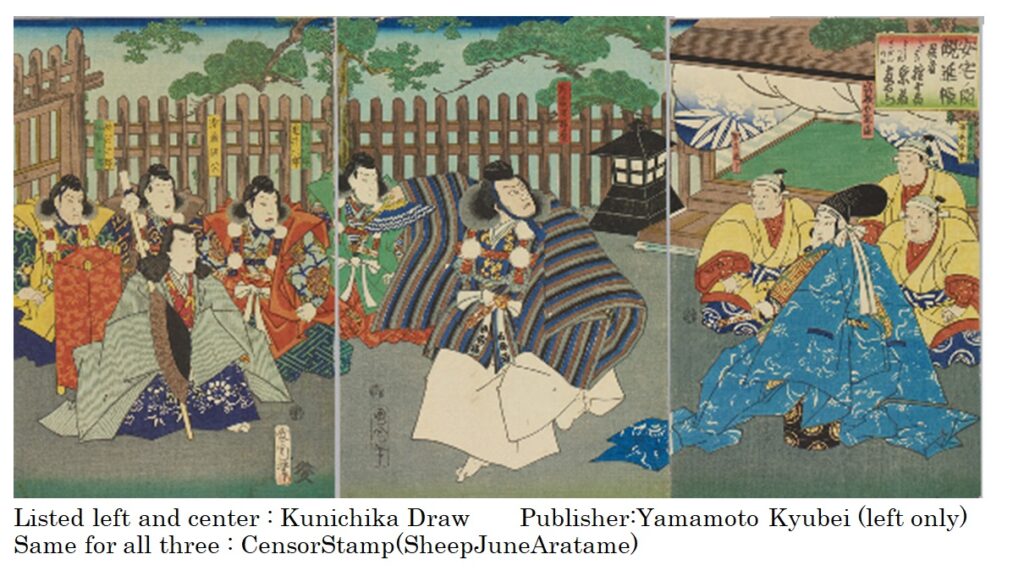
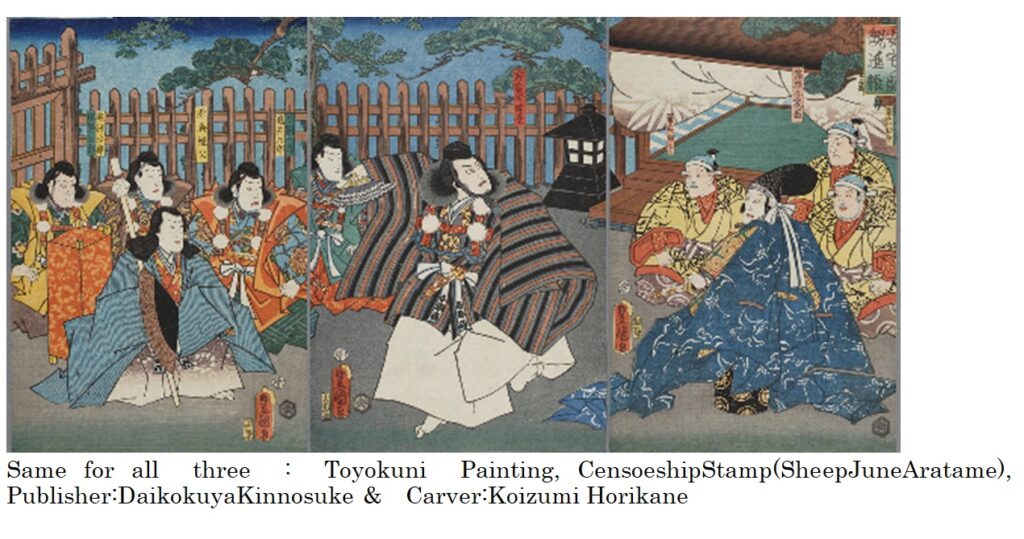
.
Hanamoribijinsoroi Kunichika and Ichiousai kunichika Painting the British Museum 1915,0823,0.169.7-11
It’s a picture of five oirans. At first glance, the contrast seems strong, but it’s because the saturation is increased due to the shrink process(63), and as a result, it looks gorgeous. The British Museum (191508230.169.7-11) says it was a work of the cock year of 1861, but the Censor Stamp was a stamp in the style of (sheepAprilAratame), so it was 1859. However, the possibility of 1871 cannot be denied from the information on this Censor Stamp alone. And Kojima Usui criticized “花盛美人揃 The Hanamoribijinsoroi drawn in April of Ansei 6 is not very good.”(1,p245) Therefore, this painting was drawn in 1859. Because it is a shrunk picture, the continuity of the painting is somewhat lost at the joints. The flashy kimono patterns are typical of Kunichika. However, because of this flashiness, it is not a portrait of a beautiful woman standing, but rather a painting resembling a fashion show where people compete over the best kimono patterns.

.
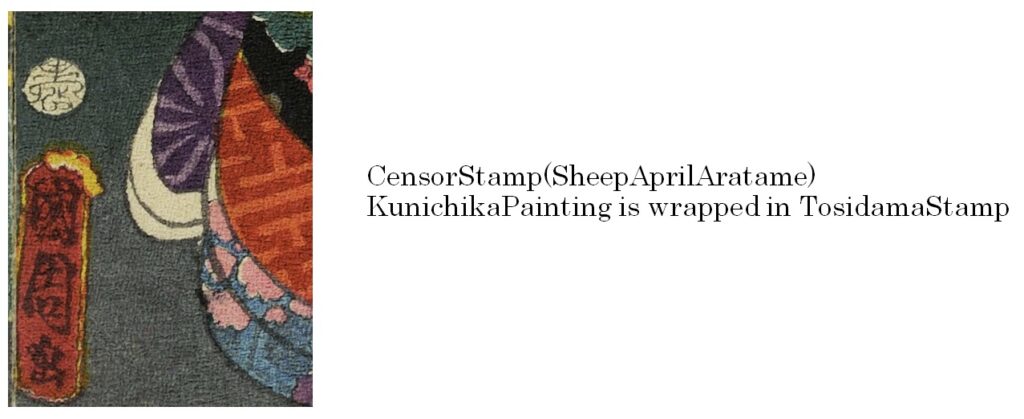
Kasamatsutouge Kijinn wo Uchitoruzu Kunichika Paintings Catalogue of the Toyohara Kunichika Exhibition Commemorating the 190th Anniversary of His Birth
A story about Natsume Sentaro killing his father’s enemy, the demon Omatsu. When the gun goes off after falling over, it hits the bandit in the stomach. A cloud of smoke or blood comes out of his stomach. The scene of a fight with some very violent movements is skillfully depicted.
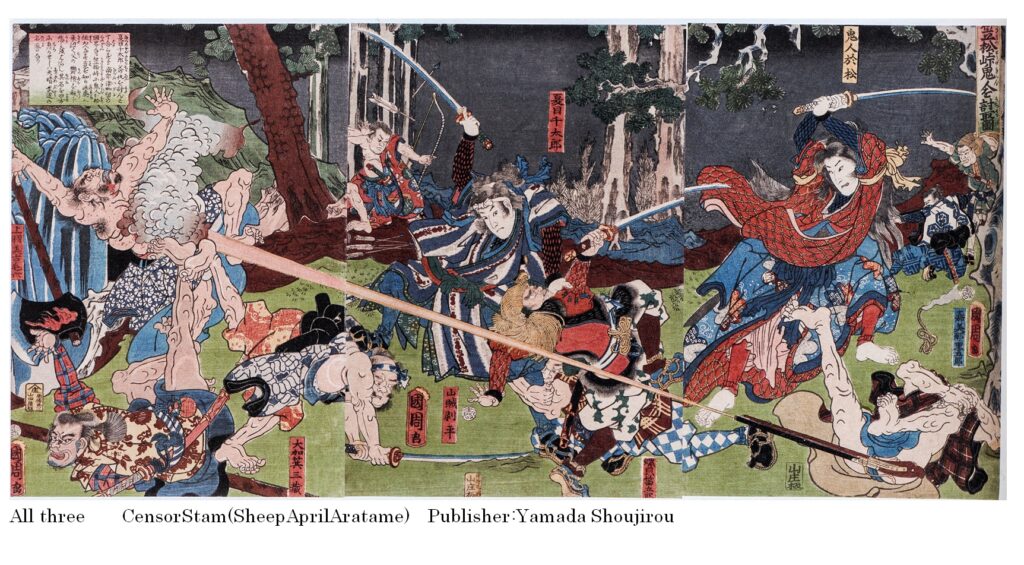
In addition to this, as a work of 1859, it is detected by Ukiyo-e search, but most of them are actor pictures of “Nakamura Shikan”. However, since the name was not used between 1847 and 1860(15), these ukiyo-e prints were judged to be works 12 years later. It was used as a criterion to judge whether the Kabuki actor’s name and the actor’s name were drawn at the same time too.
Manen 1st Monkey 1860 万延元年
There were no illustrated books and uchiwa-e drawn by Kunichika. As for ukiyo-e, ten works were detected in ukiyo-e research, but 5 works were clearly made in 1860. And three works were found in other searches, so there were10 works in total this year.
Field of Ukiyo-e
Bunji4nen Sesshudaimotsuura nanpuu no zu(文治四年摂州大物浦灘風之図) Kunichika, Ichiousai Kunichika and Mushunan Kunichika painting The Boston Museum of Fine Arts 11.41739a-c
Kunichika drew this picture based on the play “Funa Benkei,” in which the ghosts of those who died in the sea of Dannoura attack a ship that was being tossed about by big waves. In this painting, the battle between Benkei and the ghosts is emphasized, and the powerful battle is expressed as the theme. On the other hand, Kuniyoshi draws in a way that explains the whole story of what happened in the past. This way of drawing Kunichika is a technique to express by narrowing down the theme. Even when he draws actor paintings, he is familiar with the method of concentrating on the feelings and movements of the actors during the conflict, rather than depicting the conflict in the story.
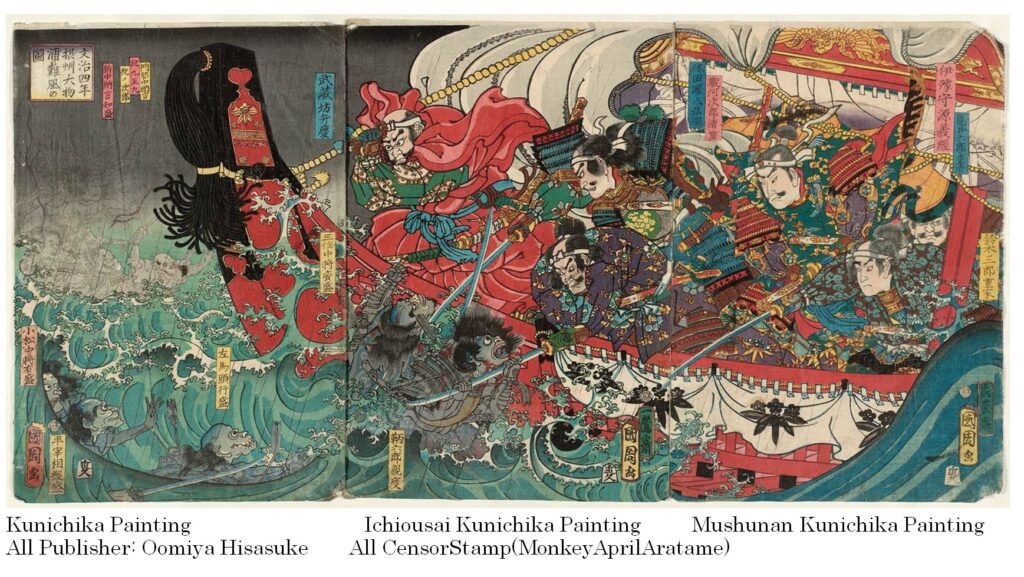
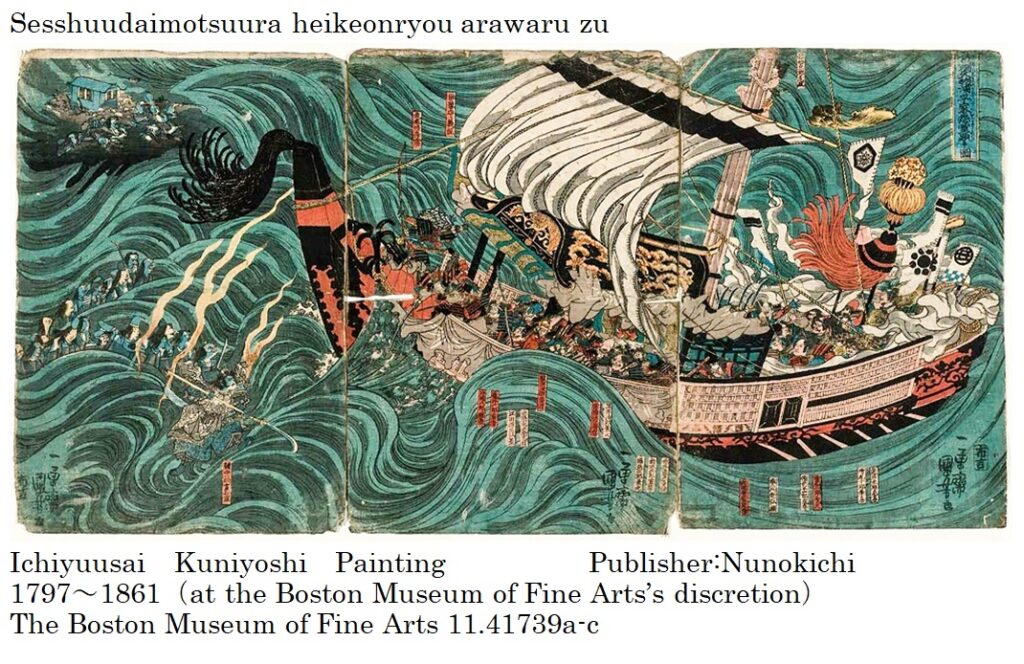
.
Imayou Genji Sankyoku Yuukyouno zu Kunichika Paining the Boston Museum of Fine Arts 11.21398-400
It is a careful drawing with a bird’s-eye view composition. The paintings of the folding screen in the background and the decorations between the alcove are carefully drawn. The drawn face is drawn differently from the faces of other actors’ paintings so far. It is a work that seems to have been drawn with some intention.

.
Hachikanjihisaminotekomae Ichiousai Kunichika Paiting The Boston Museum of Fine Arts 11.41784a-c
It is a picture of a gorgeous courtesan. Kunichika sometimes painted very flashy pictures like this. Kunichika carefully draws eye-catching kimono patterns. This painting, like “Hanamoribijinsoroi in 1859, Ansei 6” which was severely criticized by Kojima Usui (1), depicts a courtesan in a flashy kimono. The flashiness of the kimono is captivating. This method is considered to be a drawback when drawing bijinga. Also, although it seems to be intentional, the way Kamuro and Oiran are layered together and the volume of the kimono is increased gives a lively impression, but when viewed from a modern perspective the painting comes across as cluttered.
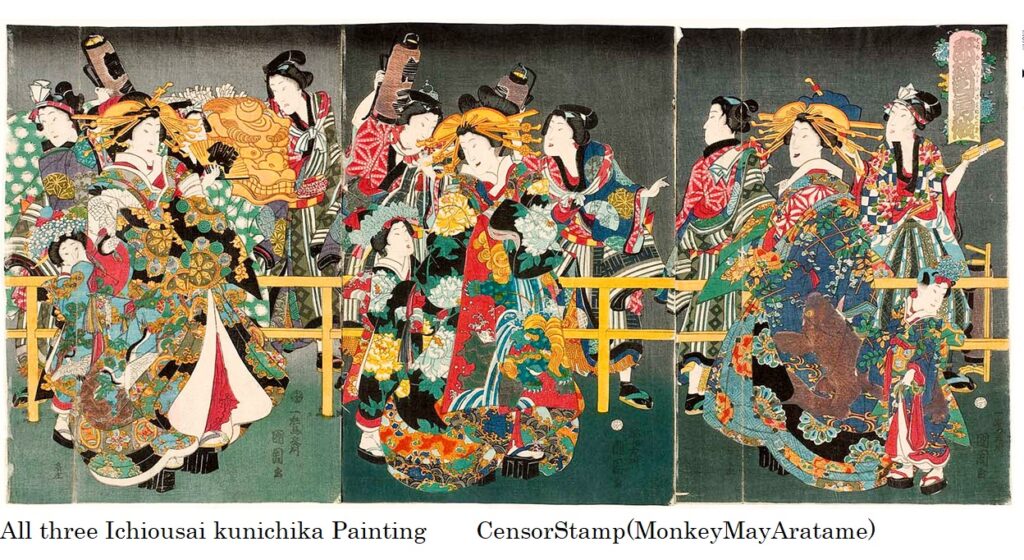
.
Imayou Fukujin Takara Asobi(今様福神宝遊狂) Ichiousai Kunichika & Kunichika Painting Tokyo Metropolitan Library 319-C009,319-C007
It’s a fun picture of the god of good fortune spreading treasure and the children making a fuss. The six lucky gods depicted here are Hotei, Fukurokuju, Ebisu, Benzaiten, Bishamonten, and Jurojin. Currently, Daikokuten is added as one of the Seven Lucky Gods, but there were only six of them here.

.
Sannou Onsairei Banzuke(山王御祭礼番付) Kunichika Painting Tokyo Metropolitan Library331-k4
It is a venerable festival of Hie Shrine, and even nowadays many portable shrines continue to parade through the Imperial Palace, Nihonbashi, and Ginza. This picture is a ranking table that evaluates the portable shrines in each town that competed for gorgeousness.
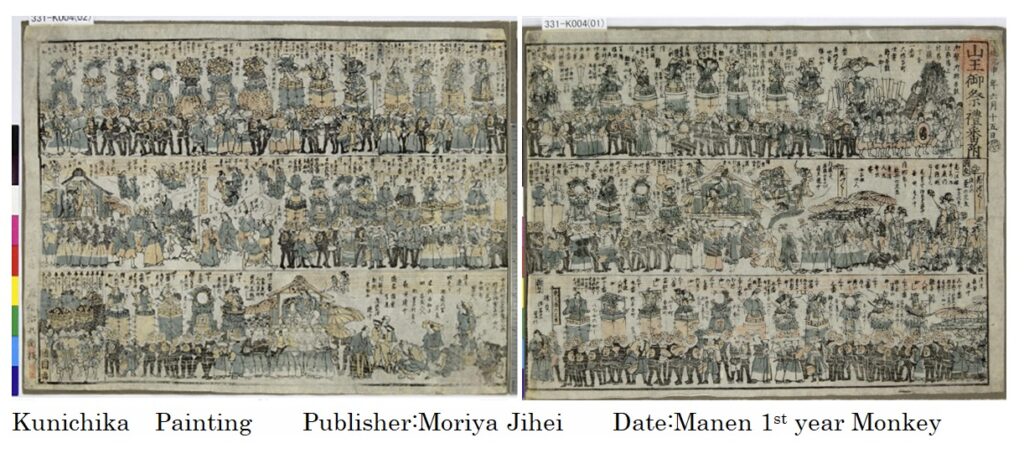
.
Taiheiki Daigassen Ichiousai Kunichika painting Artelino Collection
It is considered to be one of the few works that Kunichika drew in search of reality. Similar to Taiheiki and Chuusingishi Adauchi in 1861, this painting was drawn in search of reality. In general, Kunichika rarely draws with such a touch on his face, so most of his works look like cartoons, but in a few ukiyo-e prints, he sometimes draws with such a touch. However, due to the limited number of paintings, it seems that he decided that it was not the style that Kunichika himself wanted to draw.
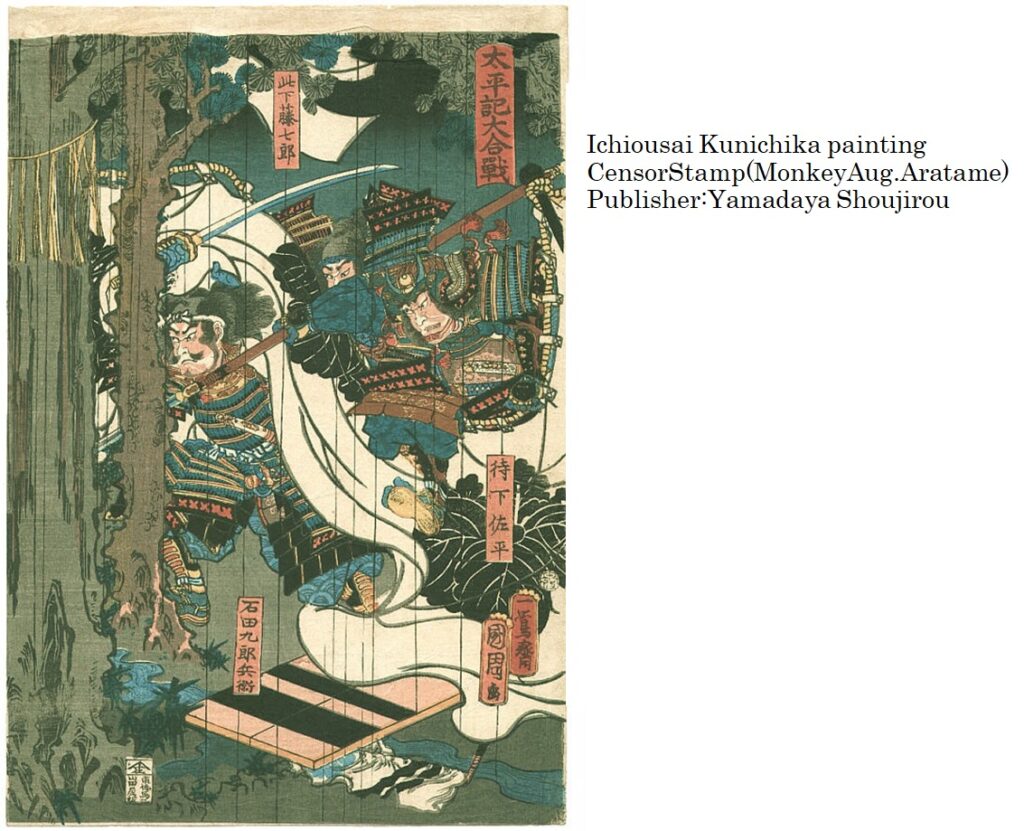
.
Yokohama Rouchu no zu 横浜廊中之図 Kachourou Kunichika Ichiousai Kunichika from Amy Newland(53)
This painting depicts the daily lives of courtesans in Yokohama’s red-light district. It is spring, and the cherry blossoms are in full bloom. The woman on the left has her hair done in a Date Hyogo style and is writing a letter. The woman in the centre with her hair tied up in a Takashimada style is talking to a courtesan while getting changed. The courtesan on the right is frolicking with Kamuro. The background depicts the brothel and the outside world that surrounds them. On the right side of the street outside the gate is what appears to be a courtesan procession, and by the central gate is a foreign-looking person wearing a hat and coat, befitting the town of Yokohama. The bustle within the red-light district is also depicted, and in the distance, ships with sails can be seen passing by on the sea.
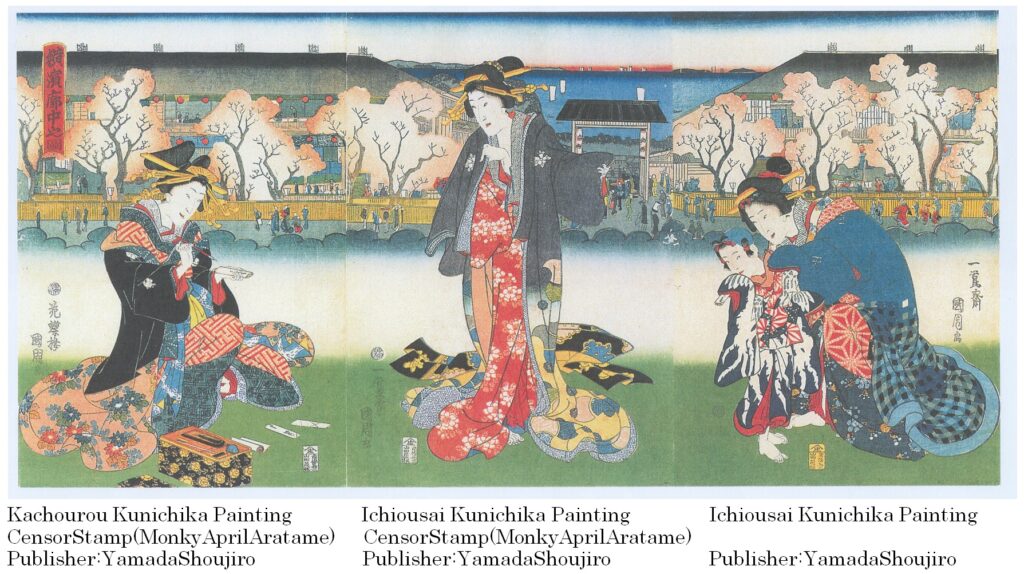
Ooigawa Tokouwataru zu 大井川徒行渡図 Kunichika Painting Kyouto University of the arts, Geijutsu-kan
Because bridges and ferries were prohibited over the Ooi River for military reasons, travelers crossed the river on the shoulders of Kawagoe porters or in a palanquin (69, p. 97). Here, a princess is depicted crossing the wide Ooi River in a palanquin, and a low-ranking Koshimoto (servant) is also depicted crossing the river on the shoulders of porters or in a palanquin. On the right, a woman is depicted forcibly climbing onto a palanquin that already has one woman sitting on it, while the man in the center seems perplexed, saying that two people are not possible, and the man on the bottom right has his eyes wide with surprise.
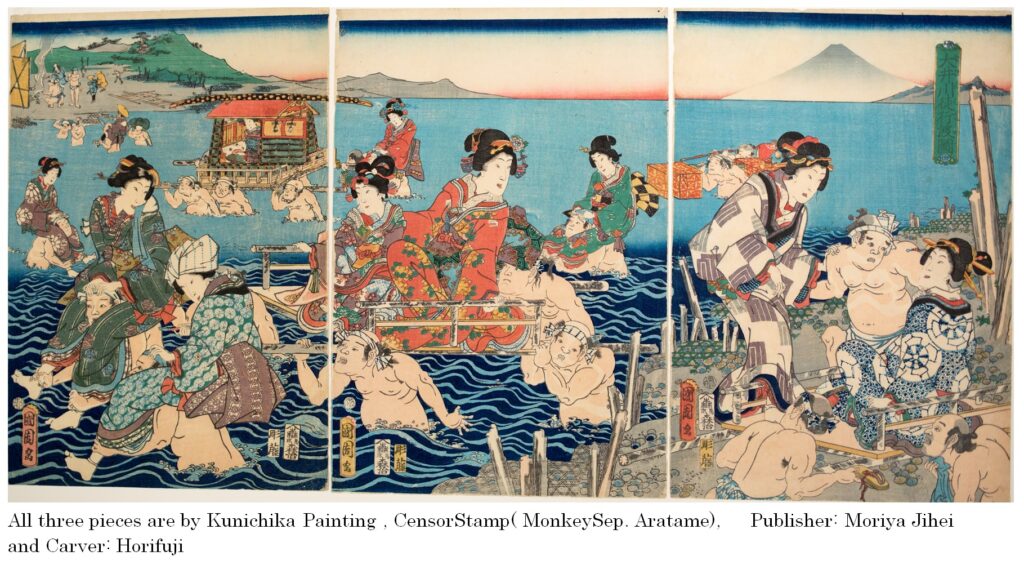
Kyoumachi 1 choume Okamoto Rou nai Shigeoka 重岡 (lower left) Kunichika Painting Kyoto University of the Arts Museum, Geijutsu-kan
The painting on the left, “Shigeoka,” is one of a series of five courtesans, the remaining four of which were painted in 1861. The patterns on the kimonos are gorgeous, and a dragon is reaching for the sky with Mt. Fuji in the background. The painting is done in a way that intentionally layers the figures around the Oiran to bring out the volume of the kimono in similar colors, but kamuro, sodefuri sinzou, and others get in the way and it doesn’t become a portrait of a beautiful woman, and only the gorgeousness of the kimono stands out.
This painting was inspected in December. The other four works were inspected in February and March of the following year. Many sequels are completed in one go, so in this case, the subtle gaps were a concern. A painting of a gorgeous courtesan in a kimono like this one is Hanamori Bijin Soroi from 1859. Since they are similar paintings, they were looked into and the second from the left in the “Hanamori Bijin Soroi” Tsudukimono (right in the figure below) is found to be identical to this painting, in which a dragon is depicted on a kimono. The details of the kimono, as well as the positioning and expressions of the figures, such as the courtesan, tsubaki, and sedeburi shinzo, are all identical. The only differences are the color scheme and the inscription “Hanamori Bijin Soroi” with the inscription “Kyomachi 1-chome Okamotoro Shigeoka.” A final judgment cannot be made without comparing the two actual works, but they seem to be the same work. This led to a comparison of the 1861 painting of Takikawa, Nagao, Nakagawa and Hanamurasaki with the 1859 Hanamori Bijin Soroi, but there were no other works that matched, with the kimono patterns, placement of the figures, hairpins and facial expressions all changing. Although published at different times and by different publishers, it remains intriguing that there exists a work that appears to be exactly the same. The Hanamori Bijin Soroi was so popular that it is thought that the painting was re-published with a different subject.
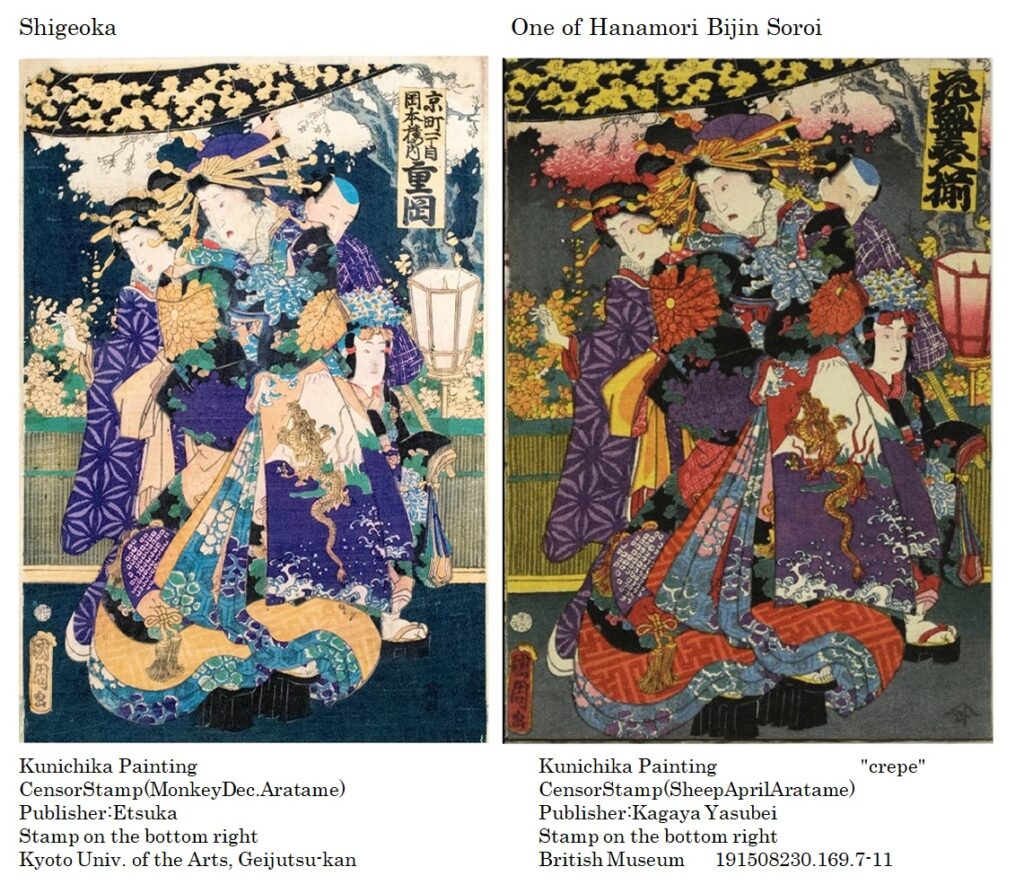
Hanamori Bijin Soroi Kunshu Painting Victoria & Albert Museum London Collection
The exact same work was published the previous year, 1859 (Year of the Sheep), by publisher Kagaya Yasubei. I wonder if Etsuka bought the print and printed it. The pattern on the kimono is flashy, but the Edo common people may have enjoyed its intricate design and flashiness. As I have already mentioned, this painting was not well received by Kojima Usui (1), but the fact that Etsuka released it again the following year (Year of the Monkey) suggests that although the kimono pattern is flashy and it cannot be called a beauty painting, this gorgeous beauty painting in a flashy outfit was well received by the Edo common people. Regardless of how it was evaluated as a work of art by posterity, it was widely popular among the Edo common people at the time, so it is thought to have been reprinted. Like the work introduced previously, Hanamori Bijin Soroi was popular, so it seems that Etsuka bought the print and sold it.

Bunkyu 1st Cock 1861 文久元年
There were 2 illustration works and 11 ukiyo-e works. There were works that depicted ordinary people, works that drew eyebrows and beards to create facial expressions that seemed to pursue reality, and depictions of actors that were refined and simplified to look like cartoons. After this year, paintings that pursued reality with thick beards and eyebrows, such as Taiheiki and Chuusinngura, were not drawn. On the other hand, the actor’s facial expression was established as the image of the actor held by the common people of Edo.
Field of Illustration
Osiegusa Nyoboukatagi(教草女房形気) Vol.22 by Kakutei Shuga, Kunisada painting, Ichiousai draw on cover page Waseda University Theater Museum
Since the Censor Stamp (CockAprilAratame) was stamped outside the text frame, it was set to 1861. The painter’s name is obscured by a sticker in the library, but “Ichiou” can be read. Kunichika sometimes drew an illustration picture on the back cover of the book, but in this book, Kunichika drew the cover of the combined volume of writer Kakutei Shuga and painter Kunisada II. This taste of the silhouette reflected on the shoji is wonderful to imagine in various ways.
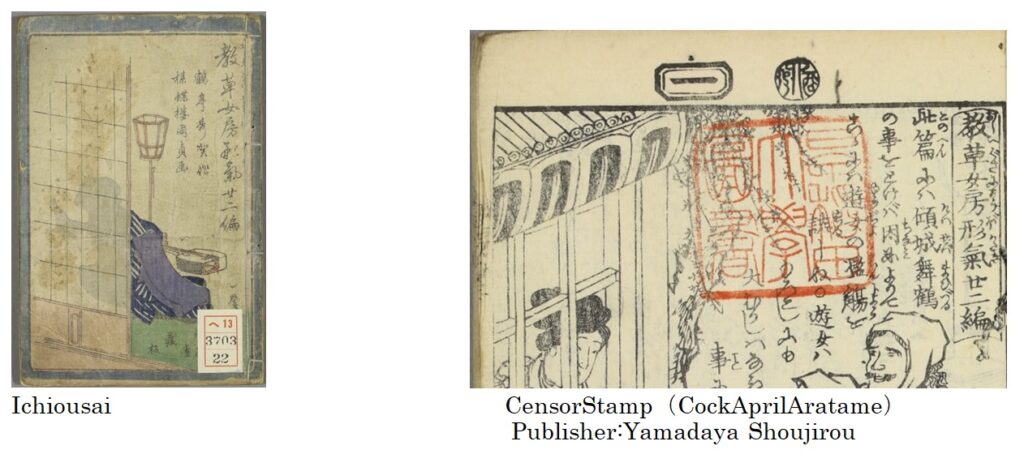
he13_03703_0022.pdf (waseda.ac.jp酉)
.
濡衣女鳴神 NuregoromoOnnanarukami Vol.9 By Kakutei Shuga Utagawa kunichika painting collection of Senshuu University
This book has 10 volumes and 40 parts, and was published by Kinshodo with illustrations by Kunisada II and Kunichika over a long period of time from 1856 to 1862. Volume 9 was published in 1862 (Bunkyu 2) and illustrated by Kunichika. The artist is Utagawa Kunichika, and the preface says “Bunkyu 2” so it was published in 1862, but the censorship stamps were Cock September and Cock October. Therefore, the illustrations were drawn in the previous year, 1861. Furthermore, the name “Ichitamesai Kunichika 一為齋国周” was used. Although it is thought that there is no direct connection to this name, Katsushika Hokusai used the name “Tameichi 為一” as “Hokusai Change Tameichi 北斎改為一” from 1820 to 1833. This “Tameichi為一” and Kunichika’s “Ichitame一為” are completely different, but it is interesting to see if there is some kind of connection between them. In the illustrated illustration, the facial expression is simple, but the kimono patterns are carefully drawn. In the background, a wide range of birds, frogs, flowers, butterflies, silver grass, pine trees, lanterns, the texture of wooden furniture, food, landscapes, and other elements of the story are depicted. Also, the depiction of hair has become more detailed.
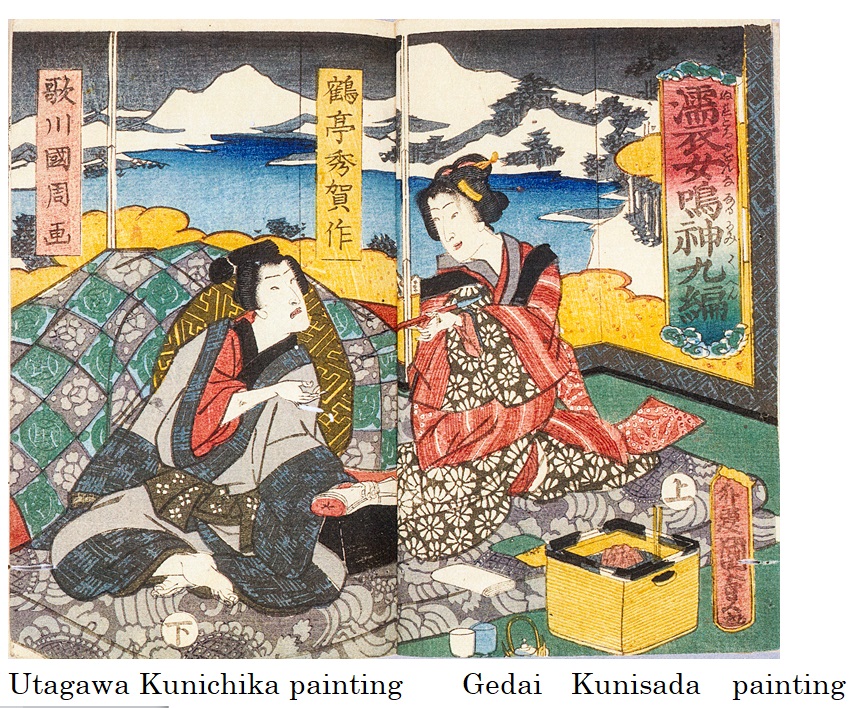

.
Ukiyo-e Field
Mokushounohito(木性の人) Ichiousai Kunichika Painting Tokyo Metropolitan Library389-C021
Uke-e was explained in 1858’s Furyu Mitate Fukuzukushi. This picture is also an Uke-e. As a thing with “Fu”, Fuji(Wisteria), Fukigusa, Fuyo, Fujinadeshiko, Fuuran, Fukusuke, and Fukumusume are depicted.
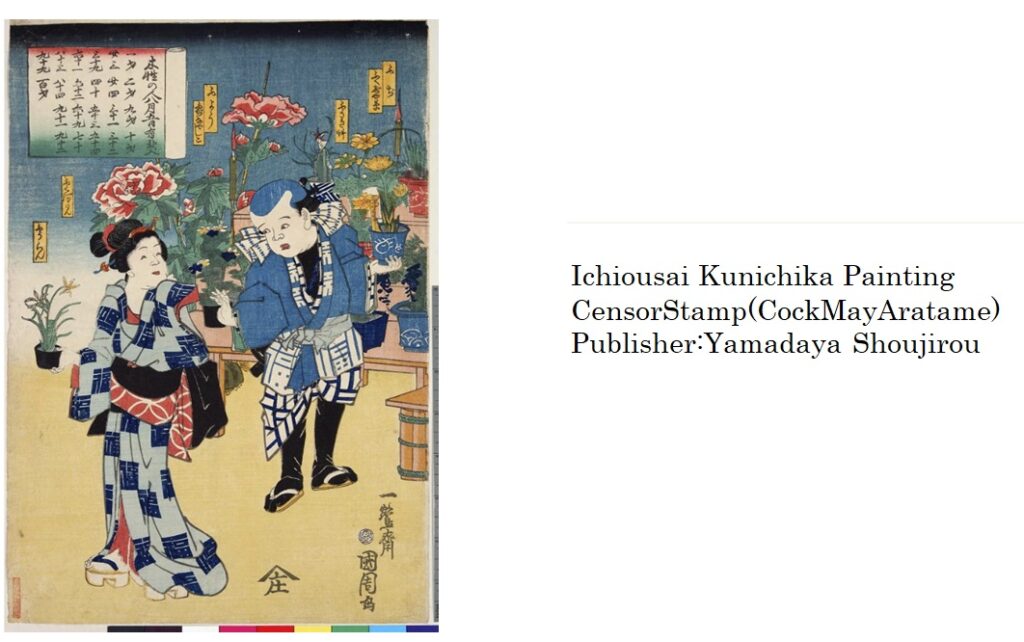
.
Fukunin Kotobuki Uke ni irifune(福人寿有卦入船) Kunichika Painting Tokyo Metropolitan Library389-C013 Lower left
This picture is also an Uke-e picture like the previous example, and many Uke-e pictures from this year have been preserved. In this picture, Fukusuke, Adonis flower, Mt. Fuji, and Fukumusume are depicted as things that start with “fu” in Japanese. Fukusuke is said to have been modeled after Sataro, a real-life dwarf who lived in the mid-Edo period. Because he was short, his head was relatively large, making him cute. It seems that this was made into a doll and became popular.
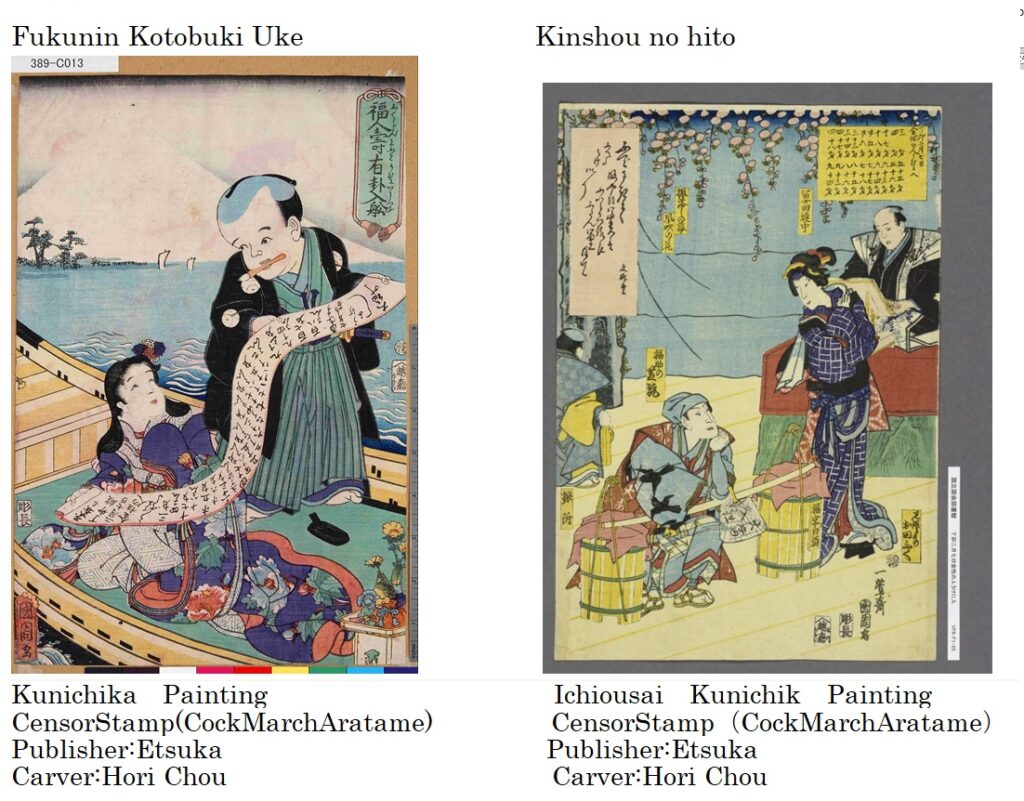
.
Teikano Usagi Kinshou no hito ukeni iru(丁卯 金性の人うけニ入) Ichiousai Kunichika Painting the National Diet LibraryVF6-F1-2 Upper right
The title is “丁卯Teikano Usagi” that means 1867, but the Censor Stamp is (CockMarchAratame), so it is a work of 1861. This is an Uke-e painting, drawn in the style of the Degatari zu established by Kiyonaga. In this picture, from the plays that are attached with “Fu”, there are “Fujita Renchu”, “Furiotosi no Maku”, “Fukusuke’s Shikan”, “Furiotosino maku(a drop curtain)”, “Fukuji Shirozake”, “otaFuku”, etc. can be read.
.
Mokusei no hito 8 gatsu 5 nichi Ukenihairu Ichiousai Kunichika Painting with Gohishi Stamp, from Toyohara Kunichika Exhibition Catalogue (65)
This is Uke-e. Fukusuke and Fukumusume are chatting. The dead tree in the flowerpot is made up of characters that start with “fu”, such as “fukusa”, “fuuran”, and “funori”. Under the words “Ichiousai Kunichika Painting”, “Gohishi Stamp” is stamped instead of “Tosidama Stamp”. Currently, this is the oldest example of the use of the Gohishi Stamp.
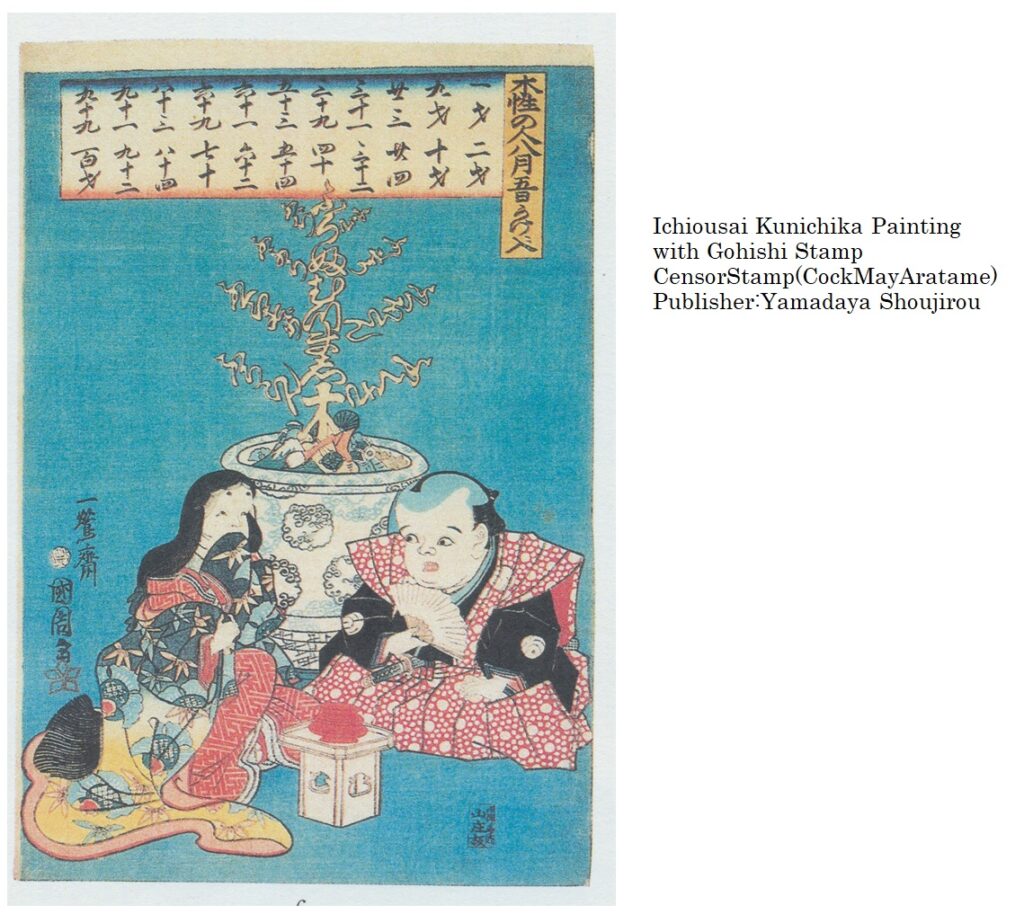
Taiheiki Kunichika Painting The Boston Museum of Fine Arts11.41798a-c
As an illustration of a book, Kunichika draws a lot of this kind, but here it is a color version. The fierceness of the battle is conveyed in the scene where the horses are violently manipulated and the warriors on horseback bend their bodies to fight fiercely. There are few works depicting a face with such a powerful expression.
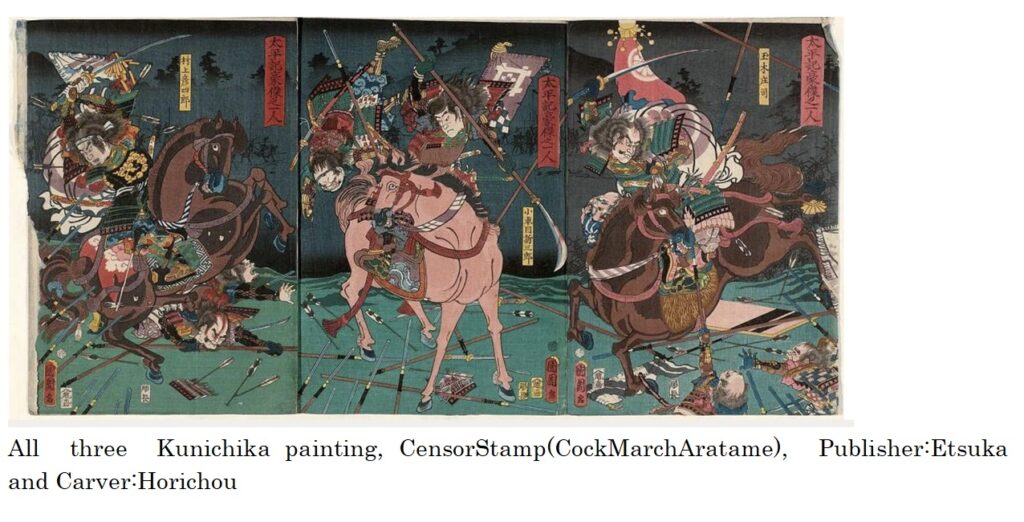
.
Chuushingishi no adauchi(忠臣義士仇討) Kunichika, Ichiousai Kunichika and ichiou kunichika painting Waseda University Library 文庫30_b0368
This painting looks like a painting that pursues reality in Kuniyoshi style. In other words, the way the arms and legs are drawn is fine, and the face is not lined, but the coloring method gives a three-dimensional effect. Kuniyoshi’s paintings in the Suikoden series seem to be powerfully expressed in terms of how to attach the muscles of the arms and legs to pursue reality, but Kunichika’s paintings are emotions, doubts and surprises with eyebrows, eyes, mouth and cheeks. etc. are freely expressed. Of course, a faint reddish color is put on the face to express a strength, but there is little dark coloring to give a three-dimensional effect to the face like this picture. There are very few paintings that seek reality like this one, but this one seems to be one of them. He rarely painted this way. It is drawn in the same way as Taiheiki Daigassen, but this way of drawing a face is suitable for paintings that are glaring at the battlefield, but not for various inner emotional expressions.
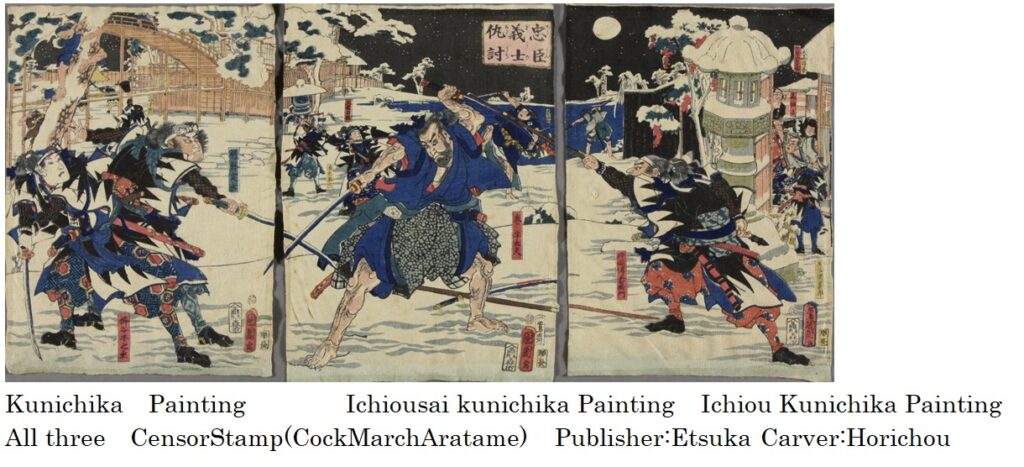
https://archive.wul.waseda.ac.jp/kosho/bunko30/bunko30_b0368/bunko30_b0368.html
.
Firefly Viewing Kachourou Kunichika and Ichiousai Kunichika Painting Japan art Open database
This is a picture of young lord hunting fireflies. The scene of women chasing fireflies in the distance is also depicted, and it is depicted in an everyday atmosphere rather than an elegant play scene.
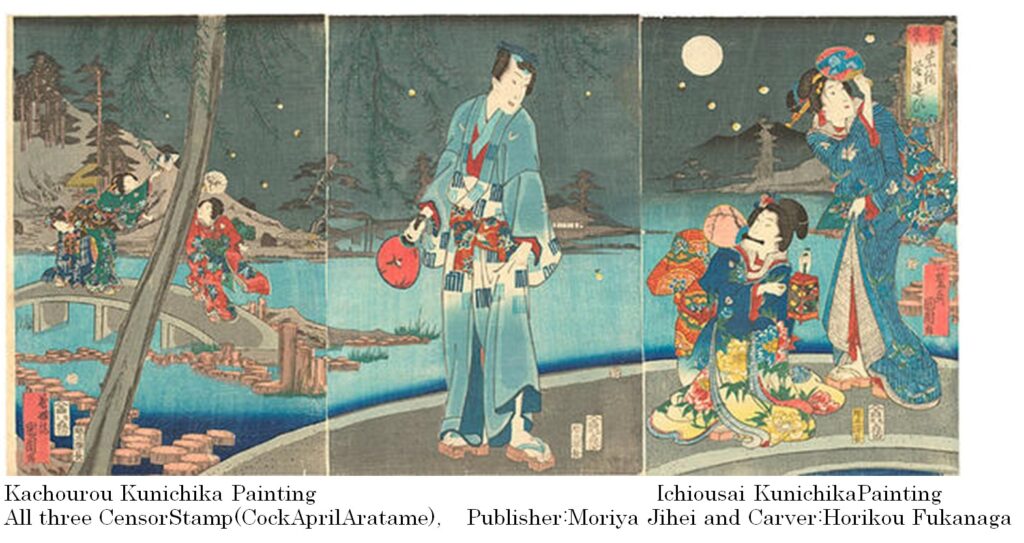
.
Takigawa, Nagao, Nakagawa, Shigeoka, Hanamurasaki, Tagoto, Kunichika, Amy Newland (53), Kyoto University of the Arts Museum and Victoria and Albert Museum, London
Amy Newland exhibited works by Takigawa, Nagao, and Nakagawa, Kyoto University of the Arts owned works by Nagao, Shigeoka, and Hanamurasaki, and the Victoria and Albert Museum, London kept Tagoto’s painting. Thus, six courtesans were kept in the collection. Etsuka released a set of six courtesans. It is unclear whether there are any other courtesan works besides the set introduced here. Kunichika’s triptychs often have backgrounds that are drawn in succession, as if they were one scene. However, even if the arrangement of these six pieces is changed, the backgrounds do not have any continuity. Therefore, each piece was considered to have been drawn as an independent painting. The kimono patterns are flashy, and the viewer’s eyes are drawn to them before they pay attention to the facial expressions or posture of the figures. The faces of all six are similar, and there is not much individuality in each one. The patterns on the kimono are skillfully painted so as not to lose the three-dimensionality of the kimono. The courtesans are surrounded by men carrying umbrellas, giving them a sense of realism, but the painting just seems cluttered and without a clear main character. The facial expressions are also almost the same. From a modern perspective, it seems more like a painting showing off the kimono patterns than a portrait of a beautiful woman or a courtesan. Looking at the 1861 Shin Yoshiwara Saikenki, edited by Oborogetsutei Arihito, all the courtesans were either the first or second most popular at their respective establishments. However, Tagoto was ranked as low as sixth at Okada-ro. In any case, Kunichika painted the popular courtesans of the time.
Of these paintings, Shigeoka’s was censored in December 1860, while the other works were censored in February and March 1861. Also, as mentioned in the section on 1860, Shigeoka’s painting was identical to one of the paintings in the “Beautiful Women in Bloom” series painted in 1859, except for the color scheme.
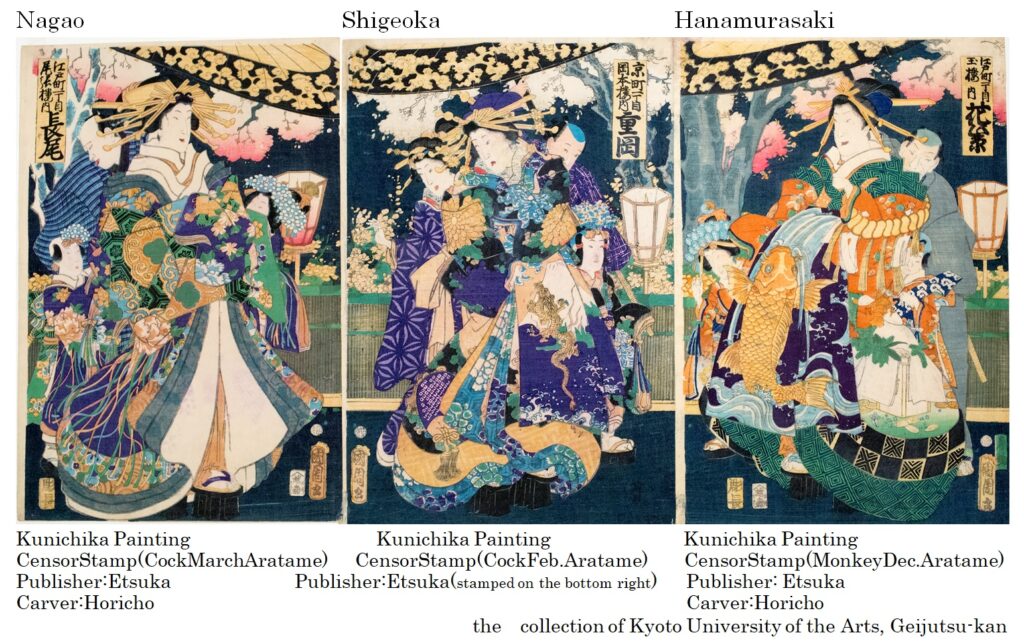

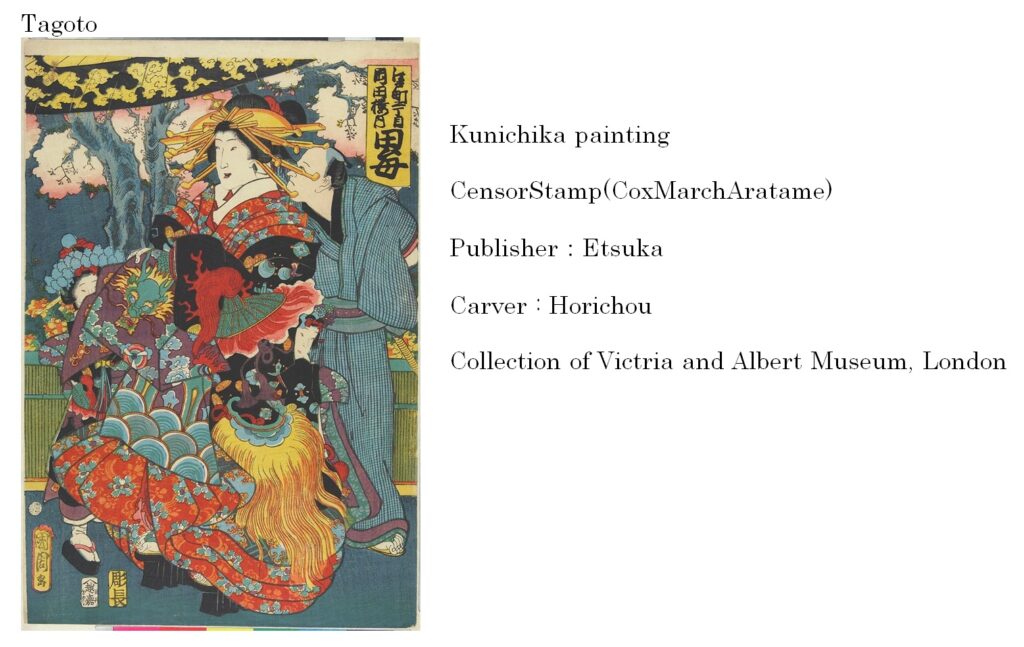
Kawarazaki Gonjurou 河原崎権十郎Kunichika Painting Tokyo Metropolitan Library M244-002
This piece depicts Soga Goro Tokimune, who appears in “The Revenge of the Soga Brothers.” He is the younger of the Soga brothers and is also written as Tokimune. His childhood name was Hakomaru. His elder brother was Soga Juro Sukenari, who was called Ichimanmaru when he was a child. This play is often depicted in ukiyo-e. Kawarazaki Gonjuro, who later became Ichikawa Danjuro IX, was active under this name “Kawarazaki Gonjuro” from 1852 to 1869 (16, p182). The style of the censorship stamp indicates that it was from 1859 to 1871. Also, it was only after 1861 that it became possible to list the names of actors and their roles. Therefore, it is a work from 1861 to 1869, but the problem is that the “Eto” engraved on the censorship stamp cannot be read. The upper left corner of the stamp reads “eleven,” the lower left corner reads “Aratame,” and the right side is completely incomprehensible. The font of “Aratame” is also innovative and gothic-style. The Tokyo Metropolitan Library cites this painting as Soga Goro Tokimune Kawarazaki Gonjuro, dated February 27, 1861 at Ichimuraza, Tsuruharu Tosa-ga Saya-oto. The censorship stamp is presumably written as (Cox January Aratame?). The rest of the text on the censorship stamp is unreadable. However, since the Kabuki Chronology (12) lists this play and Gonjuro, this is probably correct.
Kunichika has drawn many ordinary people and samurai so far, but this Gonjuro has a long face, slightly larger eyes, and a thin and long line depicting the nose. I felt that Kunichika’s way of drawing people’s faces and style suddenly became innovative. Until now, Kunichika has painted many people, but at this time, it is believed that this work began to express the image of Kabuki actors that the common people of Edo had. Tanabe Masako states that Sharaku’s portrait was true and not accepted by the common people (23,p10 ). In short, I think that portraits that did not depict an ideal face but instead expressed individuality, in other words, portraits that were simply drawn as they were, would not have been accepted by the common people of Edo. It seems that Kunichika was able to capture the characteristics of the actors and beautify them to create a face that matches the character. Until this year, there were almost no actor paintings, but in the following year, there were 92 works in 1862, so it is possible that this work was highly evaluated. It is thought that the impetus for completing this painting was the painting by Toyokuni III. The previous year, 1860, Toyokuni III had released a number of actors Ohkubi-e, which may have inspired Kunichika. Among many of Toyokuni III’s works, Bando Hikosaburou’s facial expression gave me a different impression, and I think it resembles Kunichika’s Gonjurou’s facial expression. I don’t know if the two are related or not, but it’s interesting. The censor stamp on both works make a strange mistake. In Kunichika’s work, the meaning of Eto is unclear, and in Toyokuni III’s work, the front and back are reversed and the characters of (MonkeyAprilAratame) are engraved.

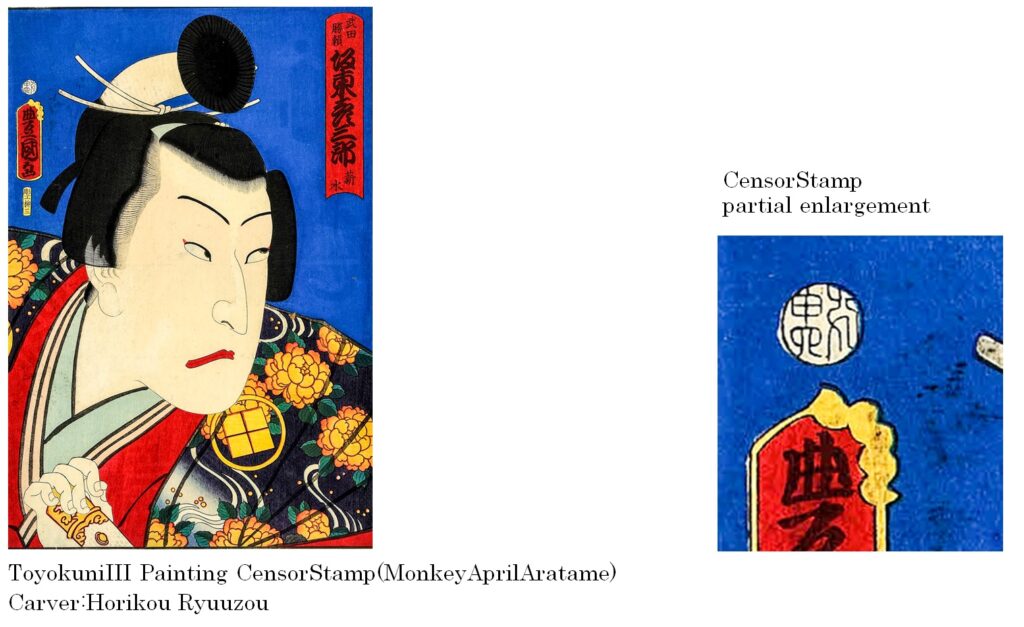
.
Bunkyu 2nd Dog 1862 文久2年
The activity in the illustration field is undiscovered. There were two fan paintings. Ninty two of his ukiyo-e works were on display to the public. His popularity began to rise as the number of actor paintings increased. It is believed that his Kawarazaki Gonjuro painting from the previous year was the trigger. The expression was stable and expressive actor paintings were drawn. There are long-shot drawings of the full body of the actors performing on stage, but there are also many lively medium-shot works that depict the actors from the waist upwards, expressing violent movements. In one of Kunichika’s paintings, there was a painting that was partly painted by another artist as an assistant.
Field of Illustration
Ume no harukasumi no hikizome (梅春霞引始) Vol.1 part2 By Kanagaki Robun Kunichika Painting National Institute of Japanese Literature
The cover is drawn by Toyokuni III, and the name of Kunichika as a painter is written on it. The picture was drawn in 1862 because it was stamped on the first page in the form of a CensorStamp (BoarFeb.Aratame). Published by Tsujiokaya Bunsuke, Kinshoudo. The illustration is a double-page spread, with the kimono patterns and background carefully drawn, the facial features are clear and the conversation between the main characters is vividly depicted. If the illustrations in the text were written in hiragana characters, it would be believed that it was a recent period dram manga.
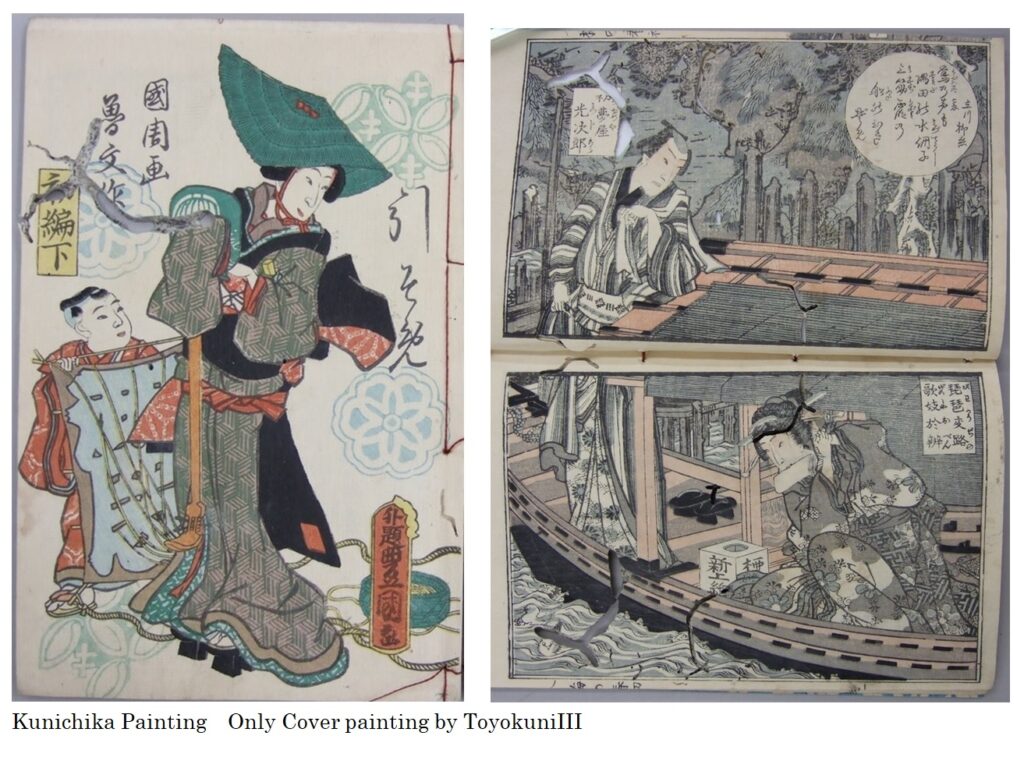
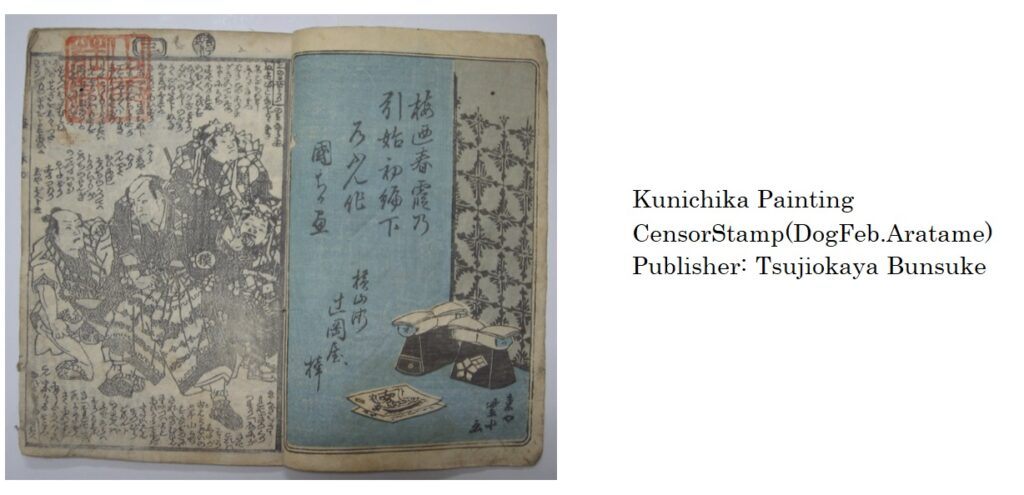
近代書誌・近代画像データベース梅春霞引始 初編 (nijl.ac.jp)
.
Uchiwa-e Field
Fuuryuu mitate rokutamagawa(風流見立て六玉川) Kunichika Painting the National Diet Library
Both paintings are stamped with Suhama Stamp (KiwameDog), indicating that they were painted in 1862. The expression is not stiff, and it is drawn with natural movements. Looking at this picture from a modern point of view, the composition of the two people is stable on an aspect ratio 3:4 horizontal screen. Drawing in this medium shot from the waist up feels more stable than a large-sized ukiyo-e picture in vertical position. The relationship and conversation between the two people depicted can be read from their expressions and gestures. The subject of the painting is the six Tamagawa rivers, which are the six Tamagawa rivers described in Japanese poems as places of scenic beauty. The six places are Ide (Kyoto), Noji (Kusatsu City), Noda (Shiogama), Koya (Koyasan), Chofu (Tokyo), and Mishima (Takatsuki City).
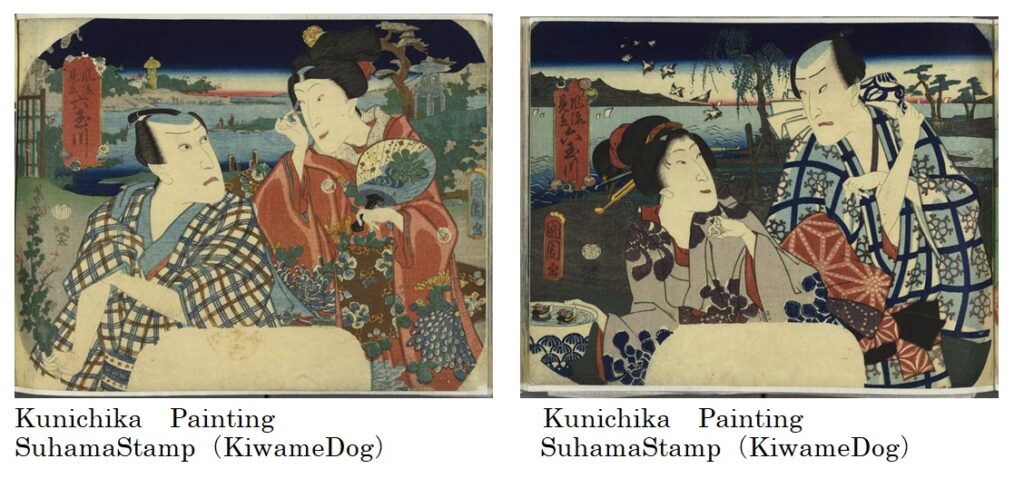
.
Ukiyo-e Field
Regarding Kunichika’s 1862 works, Waseda University Theater Museum has 49 works, Tokyo Metropolitan Library has 7 works, National Diet Library has 2 works, The Boston Museum of Fine Arts has 28 works, Waseda University Library has 3 works, and ARC portalsite has 57 works. The Ukiyo-e Search had 92 works available to the public around the world. Therefore, while up until now all of the works were introduced because the number of works available was small, from 1862 onwards, the introduction will be limited to works with distinctive features such as the way they were painted. From this year, many Kabuki actor paintings appeared, and it became common to list the cast names and actor names in ukiyo-e, and it can be said that the restrictions were weakened by the Tempo Reforms. As for the composition of ukiyo-e, there are many ukiyo-e prints of standing figures on the traditional stage, and many ukiyo-e prints of actors above the waist began to be released this year. Other than Kabuki plays, such as Nanso Satomi Hakkenden, Hauta Gonin Otoko, Hauta Tora no Maki, Rubella Genpuku Zu, Shunshoku Shuchu Hanaasobi as Genji-e( Genji is main character.), etc. were published.
Yaoya Osichi (Sawamura Tanosuke) Kichisan(Sawamura Tosshou) Kunichika painting The Boston Museum of Fine Arts 11.41577a-b
There is a record of Yaoya Oshichi (Sawamura Tanosuke) and page Kichiya (Sawamura Sawamura) in “Shochiku Umeiro Nibanme” which was performed at Nakamura-za from September 15th. It seems that this play was the theme. Oshichi, the daughter of a greengrocer, set fire to see her lover, and she was executed for that crime. The plot of this play is unknown.
This picture is a long-shot type picture that draws the whole body. Many of these long-shot pictures were still drawn. The actors and their stage performances are also depicted, reminiscent of the story of a Kabuki play. The publisher is Shimizuya Naojirou. The painting on the folding screen, which depicts butterflies and wild grasses, is written by抑嶌藤丸筆Yokushima Fujimaru. It was drawn by someone who was not a disciple. Sawamura Tanosuke III gained popularity as a seductive female impersonator (55).
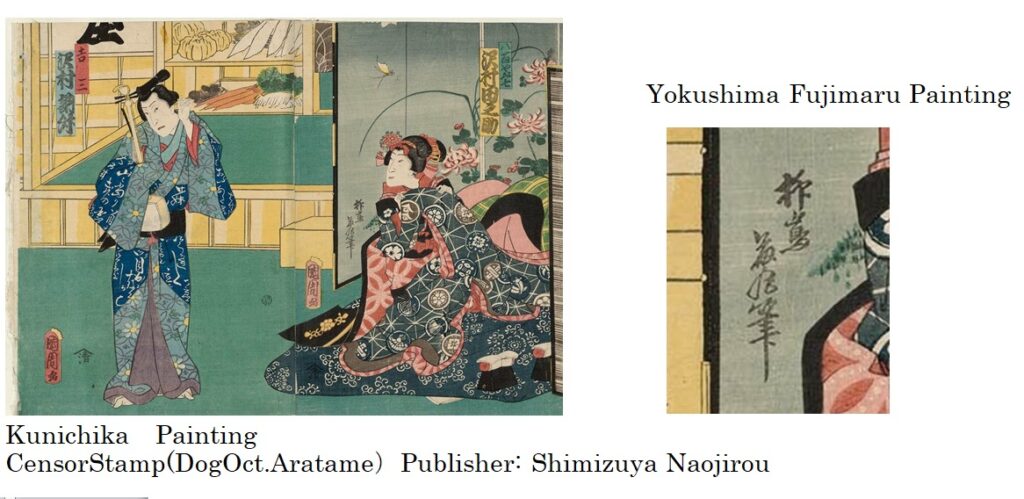
.
Mitate Tsukimi no uchi Kunichika painting the Boston Museum of Fine Arts11.44457a-c
A long-shot depiction of a summer evening for the common people of Edo, with the cool sound of wind chimes. The party has just started. The maid on the far right is hastily transferring sake from a large container with warm sake to a tokkuri. She rests her hand and is amused by the woman’s dance. A man is late. “I’m sorry,” he said, lifting the hem of his haori and barging in. The man on the far right smokes a cigarette and looks at the dance, saying, “U~n, it’s so sensual.” The sound of the shamisen echoes, and the dancing becomes more and more fun. In the center, “Otano” looks at “Tsurumaru Otokichi”. “Omitsu” on the left is courting a regular customer with a glamorous look. The man underneath is groaning as if he is trying to twist a poem with the inkstone by his side. A lively summer evening with shamisen playing.
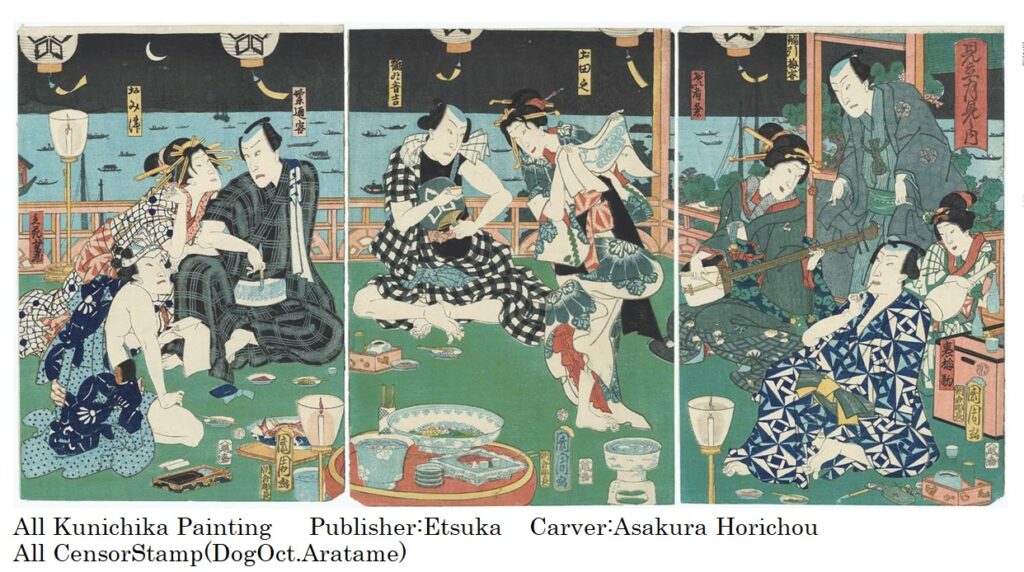
.
Shoubuawase adauchi koudan(菖蒲合仇討講談) Nakamura Shikan Kunichika Painting The Boston Museum of Fine Arts 11.41692
“Shobuawase adauchi koudan” performed at the Ichimura-za theater in May 1862. Shikan played the role of Nakano Tobei. In the picture, Tobei holds up a tag that says ‘Hosokawa Goyo’, but ‘Hosokawa’ does not appear in the performance records of the Kabuki chronology. The story is unknown. This kind of composition from the waist up (medium-shot) will increase from this year. This way of drawing is a way of drawing that concentrates on the audience the emotions and powerful movements of the actors. It was judged to be a work of 1862 from the CensorStamp(DogMayAratame).
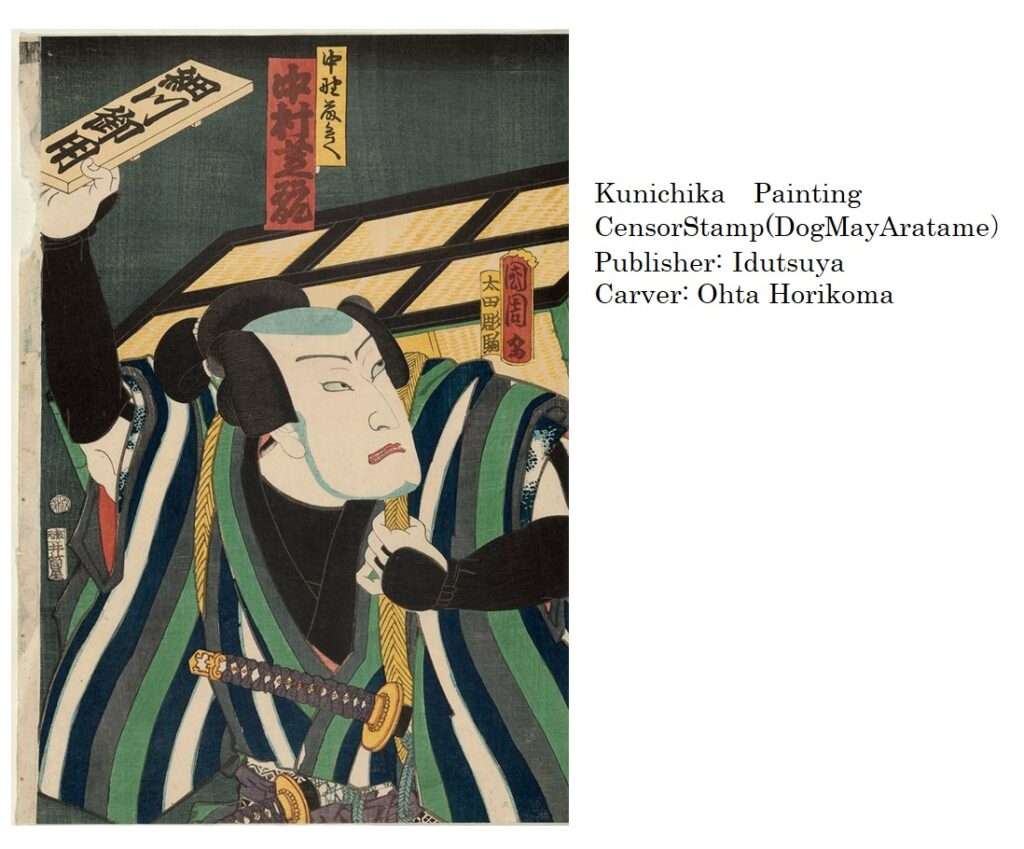
.
Nansou Satomi Hakkenden(南総里見八犬伝) Jushima Kunichika, Kunichika and Ichiousai Kunichika Painting Tokyo Metropolitan LibraryH173-4
“Nanso Satomi Hakkenden” is a story like this. Yoshizane of Awa Province defeats the enemy military commander Kagetsura with the help of his beloved dog Yatsufusa, and hides in the mountains with Princess Fuse. Then, a man approaches to Princess Fuse, and her pet dog is killed by the man after some trouble. When Princess Fuse committed suicide due to grief, eight balls flew out from the prayer beads she was holding, and each ball became eight swordsmen, and they played an active role in the story of rewarding good and punishing evil. This is a picture of the story of Nanso Satomi Hakkenden, which is still well known today.The picture shows Inuzuka kicking his pursuers away, and it seems as if the story will unfold. Many fights are depicted on one screen. His painter’s names are Yanagishima Kunichika(寿嶋国周)、Ichiousai Kunichika and Kunichika.
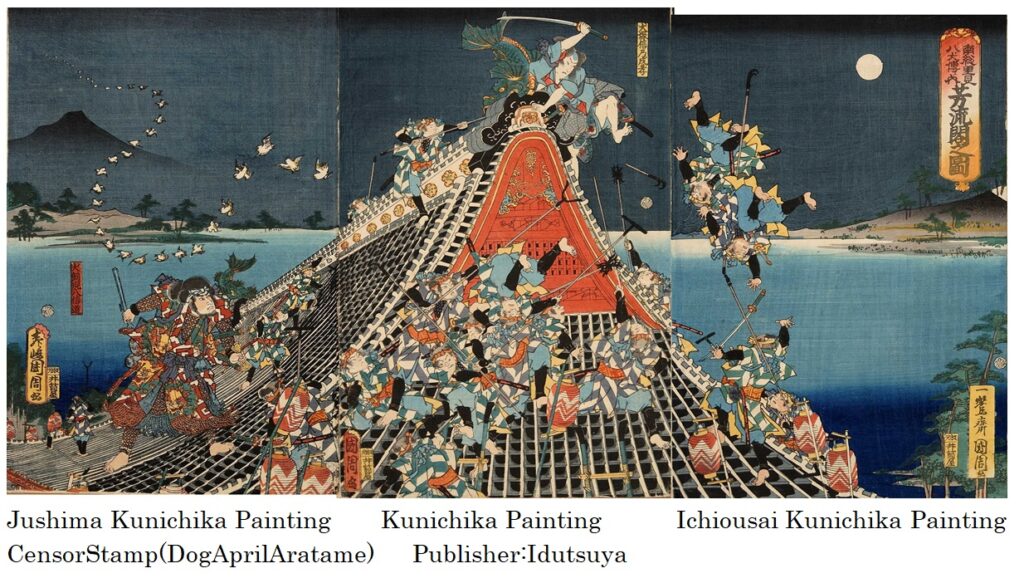
.
HautaToranomaki (葉うた虎の巻) Kunichika Painting The Boston Museum of Fine Arts00.793
Released several times in series. It is a work with secrets written as “Tora no Maki” about love between men and women. And it is like a page of Kusazoshi.
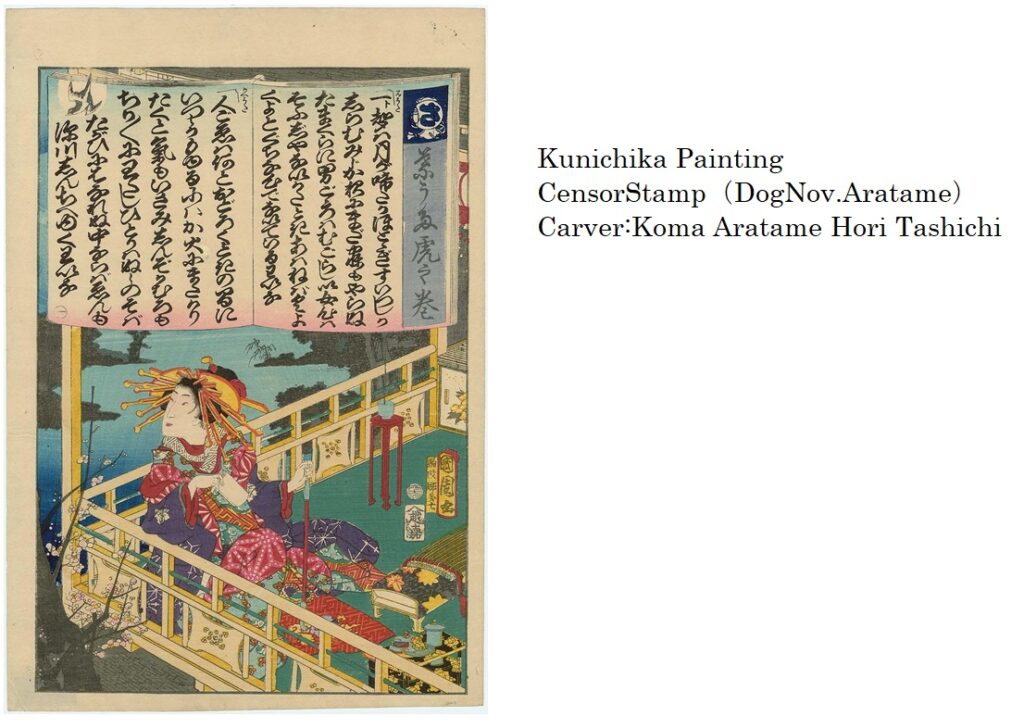
.
Umeharugasumi hikihajime Kunichika painting The Boston Museum of Fine 11.40547
It was published as a set. This work depicts Iwai Kumesaburo, but also features Kawarazaki Gonjuro, Nakamura Shikan, Sawamura Tanosuke, Bando Hikosaburo, Iwai Kumesaburo, and Ichimura Uzaemon. The backgrounds in all of the works are drawn in a single color of light ink, carefully drawn but not fussy, making for an elegant picture. The colors of the kimonos are subdued and elegant.

Shunshoku Shuchu Hanaasobi(春色酒中花あそび) Kunichika Painting The Boston Museum of Fine Arts00.1240-2
A gorgeous Genji-e. This picture is also added in the same way as Yaoya Oshichi introduced earlier. Genji’s kimono is written as “Tanakaan Satodama Fude”. Was it female painter like a fashion designer? Instead of tattoos, it looks like a flashy picture on a kimono. Women’s kimonos are also flashy with large floral patterns. The folding screen is signed with “Sakai Kikujo Fude”, so it seems that this artist painted the illustration on the folding screen. When adding to a picture in this way, there were many examples of drawing as “a disciple ***” or already famous painters writing their names as they were. In that case, it seems that these two are also famous painters, but the details are still unknown.


.
Regarding publishers related to Kunichika’s works
The number of Kunichika’s ukiyo-e prints has increased rapidly. Using three databases: the Boston Museum of Fine Arts, ARC portal site, and the Waseda University Theater Museum, the publishers of Kunichika’s ukiyo-e prints around 1862 were searched. For confirmation of the publisher, reference was made to “Publisher of Ukiyo-e Prints” (10, p134).
Kunichika’s works have been released by many publishers. Idutsuya and Etsuka were the publishers that published most of them. Also Tsujiokaya Bunsuke,Shimizuya Naojirou, Ohtaya Takichi, Kiya Soujirou, Hiranoya (Hiranoya Shinzou), Manzen (Yorozuya Zentarou), Uoya Eikichi, Oomiya Hisasuke, Surugaya Sakujirou, Kagiya Shoubei, Moriya Jihei, Hayashi Shougorou, Kakumotoya Kinjirou, Daikokuya Kichinosuke, Fusimiya Zenroku, Joushuya Kinzou, Shimaya Tetsuya, Iseya Shounosuke and Iseya Rihei were dealing with Kunichika’s works.
Among them, the marks of Shimizuya Naojirou and Yamazakiya Seishichi are not clearly distinguishable. In the three marks below, the left end is said to be Shimizuya Naojirou’s mark, but the center and right marks may be Yamazakiya Seishichi’s. Shimizuya Naojirou uses 月, but there are similar characters, such as the character for 円 instead of 月, and the character for 日instead of 月. Waseda University, ARC portal site, the Boston Museum of Fine Arts, and the Tokyo Metropolitan Library have all come to no clear conclusion. However, Yamazakiya Seishichi has an example of using the mark ”山清板” (see table). However, as can be seen in the table below, there are examples of one publisher using various marks, so future research is desired regarding the identification of the publisher.

.
Around 1863 About the carver related to Kunichika’s work
Regarding the carvers, the following books were also consulted and confirmed: The Color Ukiyo-e Picture Book (9), “Carving and Printing of Nishiki-e” by Ishii Kendou (91), and “Research on Ukiyo-e and Prints” by Higuchi Futaba (92). Kunichika’s works have increased, so not only the publisher’s name but also the carver’s name will appear. It is thought that the carver also used many names, just as Kunichika wrote different names for his three paintings: Kachoro Kunichika, Ichiusai Kunichika, and Kunichika. For example, the works of the Boston Museum of Fine Arts, 1865, 11.44455a-c list the names of Horikou Daijirou and Matsusima Hori Dai, but this is a work carved by Matsusima Daijirou and he uses two names. In the work of the Boston Museum of Fine Arts, 11.41857a-c, three names appear: Horikou Daijirou, Katada Horichou, and Matsusima Horidai. In this case, three people, Matsusima Daijirou, Katada Choujirou, and Matsusima Masakichi, shared the responsibility. The works of the Boston Museum of Fine Arts 11.41647a-c have the names of Uemura Horiyasu and Katada Horichou, so Uemura Horiyasu and Katada Choujirou share the work. Therefore, it is not necessarily the case that a single carver finished the triptych with an awareness of the finished work.
The names of the carvers who appeared in Kunichika’s works, including those from 1862 and before and after, were examined. For the convenience of confirming the name of the carver, the results of researching works by other painters and works of other periods are shown in the table. In summarizing in this table, the grounds for some deviations from the primary color ukiyo-e picture book are described below. In addition, the source of the work is indicated, but the abbreviations are Enpaku: Theater Museum, BMFA:The Boston Museum of Fine Arts, ARC: ARC portal site, Tokyo: Tokyo Metropolitan Library.
1) Asakura Horichou, Asakura Horiman, Horichou Aratame Horiman (朝倉彫長、朝倉彫万、彫長改朝万)
In Primary Color Ukiyo-e Encyclopedia (9), Asakura Horichou and Asakura Horiman are treated as different people as disciples of Asakura Ihachi. However, since the work declares “Horichou Aratame Asaman” (change from Horichou to Asaman), it was judged to be the same person.
Asakura Horicho 1862 BMFA: 11.44457a-c
Asakura Horiman October 1863 ARC: arcUP8071
Horicho Aratame Asaman November 1863
Tokyo: 5643-C001-001 Tokyo: 5714-C021-001
Tokyo: 5714-C021-003 Tokyo: 5714-C021-006
Asakura Horiman 1864 BMFA: 11.41759a-c
Asakura Horiman 1865 Tokyo: M245-005-001(02)
2) Katada Horichou, Horichou, Horikou Chou, Horiku Choujirou, Horikou Katada Choujirou (片田彫長、彫長、彫工長、ホリ工長治郎、彫工片田長治郎)
Like Asakura Horichou’s name, there are many works that call themselves “XX Horichou”, but it is difficult to identify the person in the work that only mentions “Horichou”. However, ‘Horichou’, which appears alongside Katada Horichou in the same work, is probably another name for Katada Horichou. In the original color ukiyo-e encyclopedia (9), Horikou Katada, Horikou Chou, Horichou, HoriKata Chou, and Katada Choujirou are described as the same person. However, although it was limited to around 1862, the name ‘長治郎Chojiro’ was there, but the name ‘長次郎Chojiro’ was not. It is not possible to determine the exact date, as no other years have been investigated other than around 1862, but the document states that it is “長次郎Choujirou” with the letters “次JI” included.
Horicho, Katada Horicho, Katada Horicho 1865 BMFA: 11.34928a-c
Horikou Chou, Horikou Katadachou 1868 BMFA: 11.41554a-c
Horikou Choujirou, Katada Horichou, Horikou Choujirou
1867 FA: 11.16132, 11-16138, 11.16137
Horikou Katada Choujirou 1867 Tokyo: M346-6-3
3)Horikou Komakichi, Hori Ohta Komakichi, Koma Aratame Hori Tasichi, Horikou Komakichi, Hori Ohta Komakichi (彫工駒吉、彫太田駒吉、駒改彫多七、彫工駒吉、彫太田駒吉)
The Encyclopedia of Primary Color Ukiyo-e describes, “Hori Koma, Hori Ohta Tashichi, Horikou Tashichi, Hori Tashichi are listed, and the real name is Ohta Komakichi.” In 1862, it says ‘駒改彫多七 Koma change to Hori Tashichi’, so Komakichi and Tashichi are the same person. He was born in 1834 and passed away in 1882 (64, p154).
Horikou Komakichi, Hori Ohta Komakichi November 1862 Tokyo: 5714-C16-2 (Hauta)
Koma Aratame Hori Tashichi November 1862 Tokyo: 5643-C1-2 (Hauta)
Koma Aratame Hori Tashichi February 1863 BMFA: 11.41846a-c
Hori Ohta Tashichi April 1863 BMFA: 11.21847 (Zeze Castle)
Ohta Horikoma May 1862 Enpaku: 100-6379
4) Fuka Horichou, Horikou Fukachou, Fukagawa Horichou (深彫長、彫工深長、深川彫長)
Horikou Fukachou and Fuka Horichou appear as the same person in the Encyclopedia of Primary Colors Ukiyo-e. Also, in the encyclopedia of primary color ukiyo-e, there is no mention of a carver using the name ‘Fukagawa’. However, if he was a carver who lived in Fukagawa, present-day Koto Ward, Tokyo, then Fuka in Fuka Horichou is thought to mean Fukagawa. If so, it can be considered that Fuka Horichou and Fukagawa Horichou are the same person. This matter requires further investigation.
“Horicho” appears in the triptych, and it is not possible to identify the carver by this alone. However, since there is “Horikou Fukachou” in the triptych, “Horichou” in this case would be his Horikou Fukachou.
Horichou, Horichou,Horikou Fukachou January 1861 BMFA: 11.44344a-c
Horikou Fukachou May 1861 ARC: arcUP3169
Hori Fukachou July 1861 ARC: arcUP0088
Fukagawa Horichou, Fukagawa Horichou, Horichou February 1862 BMFA11.443606
Horichou, Fukagawa Horichou,Fukagawa Horichou February 1862 ARC: arcUP0165-0167
Fuka Horichou October 1862 ARC: arcUP3146
5) Fukahori Hei, Hori Hei, Katada Hori Hei, and Horikou Hei (深彫平、彫平、片田彫平、彫工平)
6) Horiyasulkoutou, Uemurahoriyasu (彫安刻刀、上邑彫安)
The third volume of the Colored Ukiyo-e Encyclopedia states that he was known as Binyasu for his excellent hair carving technique. Bin is the hair around the ears that is drawn with very fine lines, so carving it requires great skill.
See the following table for examples.
7) Horikogin, Horigin, Horigin, Horiko Ginjiro, Asai Ginjiro (彫工銀、彫銀、ホリ銀、彫工銀次郎、浅井銀次郎)
Listed in the third volume of the Genshoku Ukiyo-e Encyclopedia.
See the following table for examples
8) Horiei, Watanabe Horiei, Horikousakae, Horie, Horikou Watanabe Eizo (彫栄、渡辺彫栄、彫工栄、ホリエイ、彫工渡辺栄蔵)
Listed in the third volume of the Genshoku Ukiyo-e Encyclopedia.
See the following table for examples
(9) Horikou Kokin (彫工小金)
Not listed in the third volume of the Colored Ukiyo-e Encyclopedia.
See the following table for examples
10) Horigyu, Tanaka Horigyu (彫牛, 田中彫牛)
Listed in the third volume of the Colored Ukiyo-e Encyclopedia
See the following table for examples
11) Horiuta, Horikouuta, Oota Utakichi (彫卯多、彫工卯多、太田卯多吉)
See the following table for examples
12) Yokokawa Horitake, Horitake, Yokokawa Takejiro (横川彫竹、彫竹、横川竹二郎)
In the third volume of the Colored Ukiyo-e Encyclopedia, it is written that he was said to be a master of head carving. He was active from 1848 to 1864. (64p154)
For examples, see the following table.
13) Horikane Koizumi Horikane, Horikou Koizumi Kane, Horiko Kanegoro, Koizumi Kanegoro (彫兼 小泉彫兼 彫工小泉兼、彫工兼五郎、小泉兼五郎)
In the third volume of the Colored Ukiyo-e Encyclopedia.
For examples, see the following table.
。
14) Hori Tatsu (彫辰)
Not in the third volume of the Colored Ukiyo-e Encyclopedia.
For examples, see the following table.
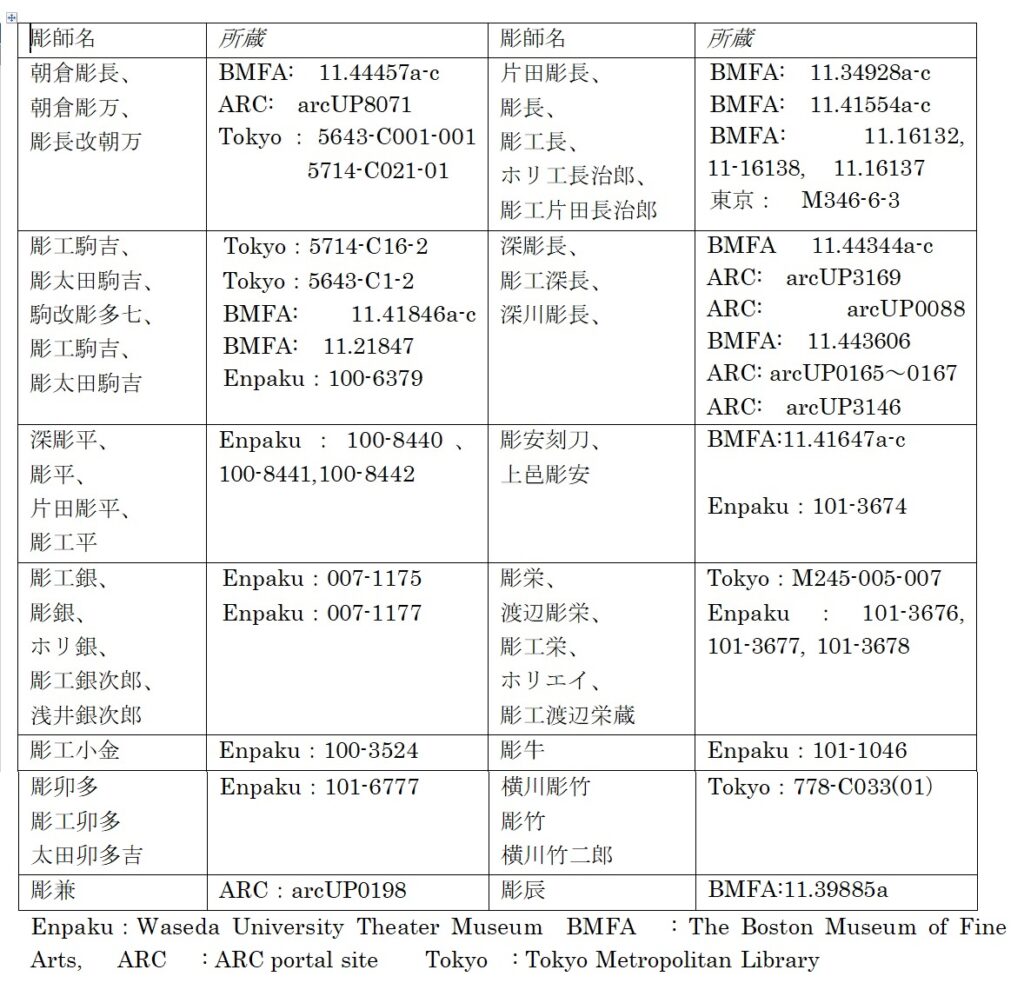
.
Focusing on the head carving, I will introduce the work. In the head carving, it is said that three hairs are drawn in a 1 mm width. Introduce great works. Horiyasukokutou was highly praised for his skill in carving hair, and was also called Binyasu because his carving of the hairline was particularly wonderful. A picture depicting “Iroha” played by Sawamura Tanosuke was carved by Horiyasukokutou. Not inferior to them are the works of Fukahoricho’s ‘Yaoya Oshichi’ and Ohta Komakichi’s ‘Magoshichi tsuma Okome’. The works by Fuka Horichou and Ohta Horikoma beautifully depict even the hair and frayed strands, demonstrating the high level of sculpting skills at the time.
Hibinitatsu Ukinano Hatsusio Sawamura Tanosuke Kunichika Painting (lower left)
Tanosuke performed “Minatoya Iroha” in the “Hibinitatsu Ukina no Hatsusio” performance at Nakamura-za in August. In addition to the expression of Tanosuke’s gestures, the carving of his hair and the expression of frayed hair are wonderful. The engraver is a famous carver Horiyasukokutou. Regarding the following pictures on the left and right, both actors are sawamuratanosuke. Their faces look very similar.

Shouchiku Umeiro nibanme Tanosuke Kunichika Painting (upper right)
In September, Tanosuke played the role of Oshichi at the Nakamura-za Theater. The picture of this program has already been introduced as an ukiyo-e of this year. Here, Tanosuke’s gestures “Yaoya Oshichi” and hair carving were introduced. The carver of this painting is Fukahoricho.
Shoubuawase Adauchi Koudan Iwai Kumesaburo Kunichika painting
There is a record that Iwai Kumesaburou played Magoshichi Tsuma Oyone at the Ichimura-za performance in May. “Oyone” played by Kumesaburou is depicted as surprised. The carver is Ohta Komakichi, and his hair is skillfully carved. The frayed hair on the cheeks is also a polite job. The two previous paintings feature the actor Sawamura Tanosuke, but this painting features the popular actor Iwai Kumesaburo, who resembles Tanosuke but is drawn more like a young girl.

.
Bunkyu 3rd Boar 1863 文久3年
According to the results of the Ukiyo-e search, the number of preserved Ukiyo-e works of Kunichika is rapidly increasing to 279 works in 1863. That’s about three times the number from 1862. His paintings were considered to be beginning to become popular. As the number of prints published increased, there were changes in the genre of the paintings, the composition, and additions by pupils.
1) As for the actor paintings, there are fewer long-shot standing poses, and more medium shots from the waist up. A small number of Genji-e were released continuously.
2) Landscape paintings, Tokaido route to Kyoto 御上洛東海道
Kunichika painted his first landscapes that year. Landscapes are paintings in which humans appear as supporting characters. Kunichika only painted landscapes like this in 1864, and did not paint any before or after that year. These paintings are part of a group of works that were produced on the subject of Tokugawa Iemochi’s march to Kyoto, namely御上洛東海道(57, 58, 59).
3) There was a demand work for the first time this year. It can be understood that his work became popular, highly evaluated and sponsored.
4) Kunichika had his disciple Otojiro participate. Otojiro is his real name, Morikawa Otojiro, a student of Kunichika, and picture’s name was active in the early Meiji era as Morikawa Chikashige.
Field of Illustration
Mizukagami Yamadori Kitan (水鏡山鳥竒譚) Vol.1&2 By Kakutei Shuga Utagawa Kunichika, Ichiousai Kunichika and Kunichika Painting Waseda University Library
In this book, various names such as Utagawa Kunichika, Kunichika, and Ichiousai Kunichika were used, and Gohishi Stamp was used instead of Toshidama Stamp. Published by Tsujiokaya Bunsuke. 水鏡山鳥奇譚(Mizukagami Yamadori Kitan) was painted by Kunichika from 1 to 3 volumes, and 4 volumes were published the following year by Kuniteru. The illustrations drawn on all pages from Volume 1 to Volume 3 are drawn lively, and the movements and facial expressions that make the story understandable just by looking at the pictures are drawn. As it is called an illustration, the background that shows the whole body and the situation is drawn as seen in the material, and there is no medium shots like drawing in ukiyo-e. On the next page of the cover of the second volume shown here, Kakute Shuga wrote in place of the preface, it was published in 1865 because it says the second year of the Genji era. However, the Censor Stamp in the painting was (Boar, September, Aratame), so it was painted in 1863. Among them, the signature as a painter was Kunichika, Ichiousai Kunichika, and Utagawa Kunichika in the third volume. Also, Gohishi Stamp was pushed after Ichiousai Kunichika’s name mentioned at the end of the first volume, but Toshidama Stamp was pushed after Ichiousai Kunichika at the end of the second volume. At the end of the third volume, it was just written as Utagawa Kunichika. This book also uses the name “美津加賀見山鳥奇譚Mitsu Kagami Yamatori Kitan”, and there is a version in which the two volumes are divided into upper and lower parts, but the content and illustrations are the same.
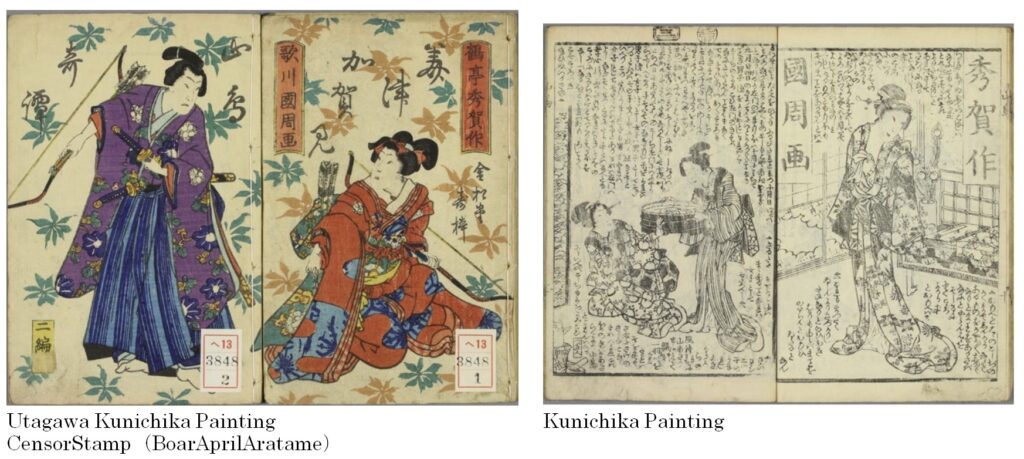
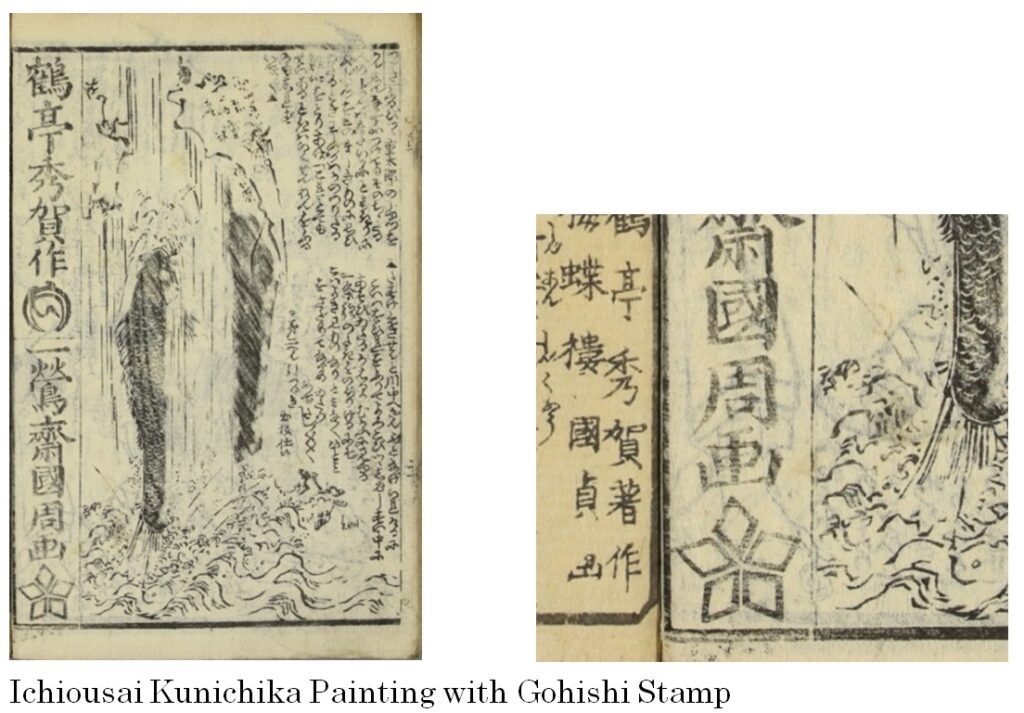
https://archive.wul.waseda.ac.jp/kosho/he13/he13_03848/he13_03848_0001/he13_03848_0001.pdf
.
Karimakura Tatsumi Hakkei vol.1 假枕巽八景 By Kanagaki Robun Utagawa kunichika, Kunichika and Ichiousai Kunichika painting
The Censor Stamp is (Boar,April,Aratame), so it is a work of 1863. The publisher is Tsujiokaya Bunsuke. The illustrations for the fourth episode of the story vividly depict scenes including the journey, the drinking party, relaxing and chatting at home, taking something out of the box, the commotion that results from it, the commotion, and the journey through the rain, all in long shots. The figures and gestures of the people depicted have a natural movement. The illustrations in this book are different from the ukiyo-e prints from the previous year, such as Kabuki plays “Liang Tei Ukin Wang Chao,” “Shochiku Umeiro Ni Baime,” and “Shobu Gavage Kodan,” and in this book human movements are expressed in a natural way. The illustrations in this book are different from the previous year’s ukiyo-e works, such as “Hibinitatsu Ukinano Hatsusio,” “Shouchiki Umeiro nibanme,” and “Shoubuawase Adauchi Koudan,” which were Kabuki plays, and in this book human movements are depicted naturally. There is a description of Utagawa Kunichika in the upper left figure. In addition, the illustration was drawn by “Kunichika’s disciple Otojiro’s painting”. His real name is Morikawa Otojirou and his picture’s name is Morikawa Chikasige. He was active as an ukiyo-e artist. In this year, Kunichika had a disciple. At the end of the first volume, Gohishi Stamp was used under the signature of Ichiousai Kunichika, but at the end of the second volume, the Gohishi Stamp, which is an improved version of Gohishi Stamp, was used in the lower right figure. The feature is that the rhombus is notched.
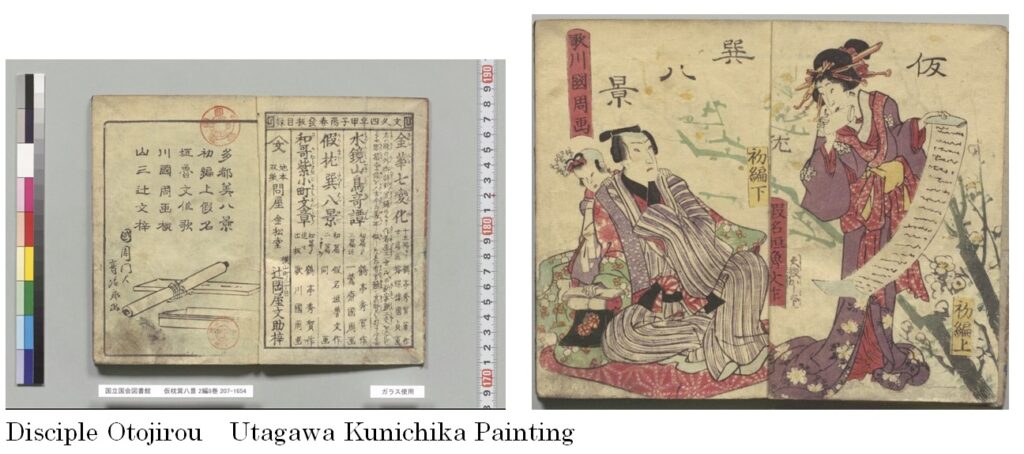
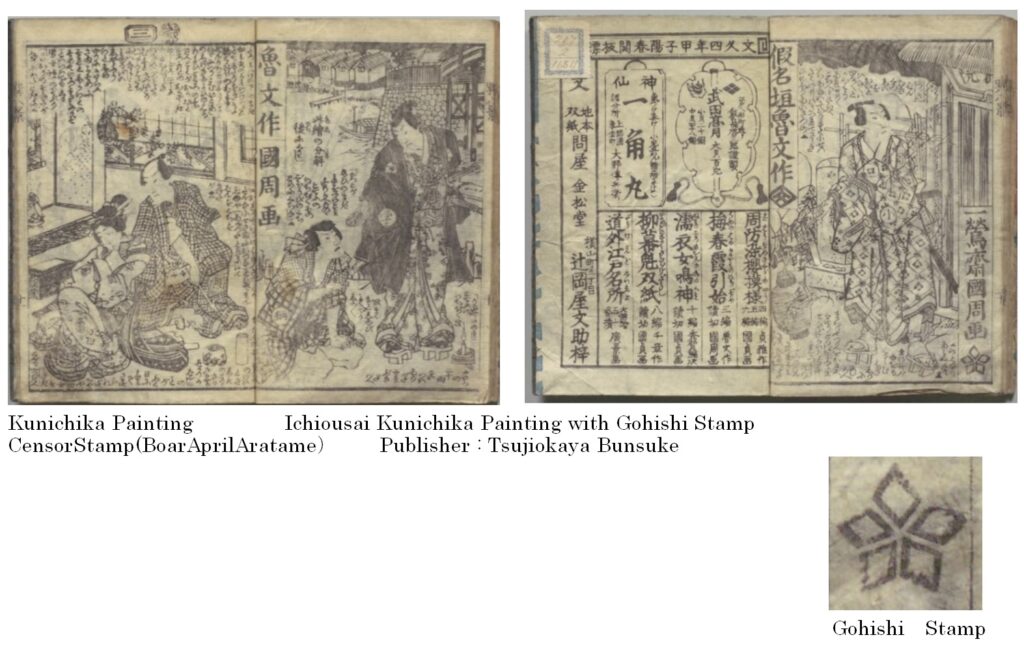
https://dl.ndl.go.jp/info:ndljp/pid/10303467?tocOpened=1
.
Karimakura Tatsumi Hakkei (假枕巽八景) Vol.2 By Kanagaki Robun Utagawa Kunichika painting National Diet Library digital
The censorship stamp is Boar/April/Revised, so it was drawn in 1863. Although not shown here, the illustration is signed Otoji. In the first volume, it was written “monjin,” but here the character “monjin” is omitted. The beginning of the book is signed Utagawa Kunichika, in the middle it is signed Kunichika with a Gohishi stamp, and at the end it is signed Ichiousai Kunichika with a Gohishi stamp.The illustrations tell the story across two page spreads, the characters have expressive faces and are even shown having conversations. The background is also appropriate, and the atmosphere of the place is expressed. The story begins with a man getting drunk, then a woman named Kiku is nearly killed with a large kitchen knife. The people in the town start to worry. In the next scene, the drunk man is slashed to death and his head is flying through the air. A scene of a grand banquet is depicted, perhaps to say that they all lived happily ever after. Next to the picture on that page, the man himself appears, saying, “The man named Kunichika…” However, it seems that the man who was killed was no ordinary man, and the government started to make a fuss.

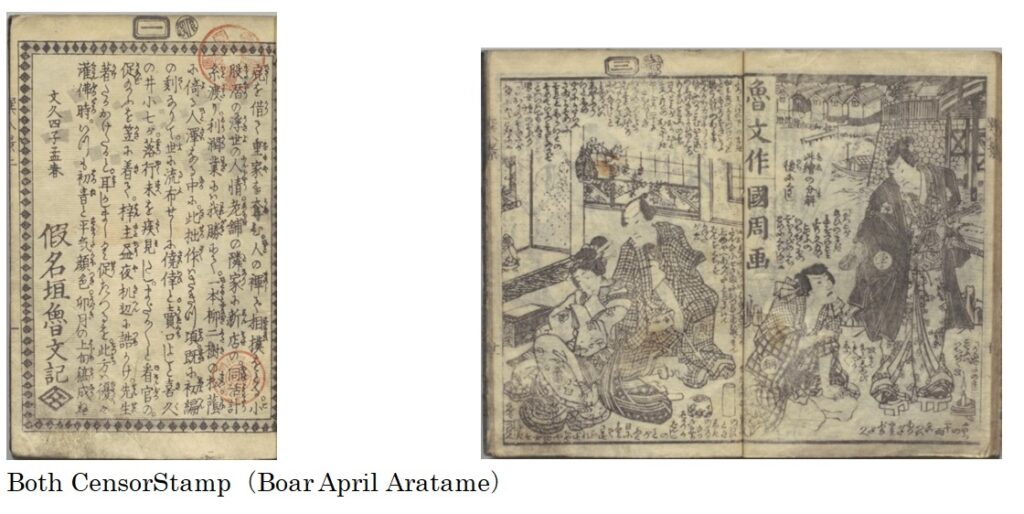
https://kotenseki.nijl.ac.jp/biblio/100358560/viewer
.
Giyu Hakkenden Vol.1 義勇八犬伝 by Gakutei Sadaoka Kunichika painting ARC portal site
This book has the first volume and the second volume. The first volume is drawn by Kunichika, and the second volume is drawn by Shunga. Since the beginning of the first volume says “Rat Year, Early Spring of the Child”, it seems that it was released in the spring of the rat year of 1864, but there was no Censor Stamp. It was judged that the picture was drawn in 1863 because it was censored (Boar,October,Aratame) when examining the second volume. Therefore, it was thought that the first part was also painted in 1863. The depictions of rough warriors and armors are carefully drawn, giving a strong impression. In addition, as in the next painting, the characters are talking to each other, and their actions are drawn so that the viewer can understand what is happening.
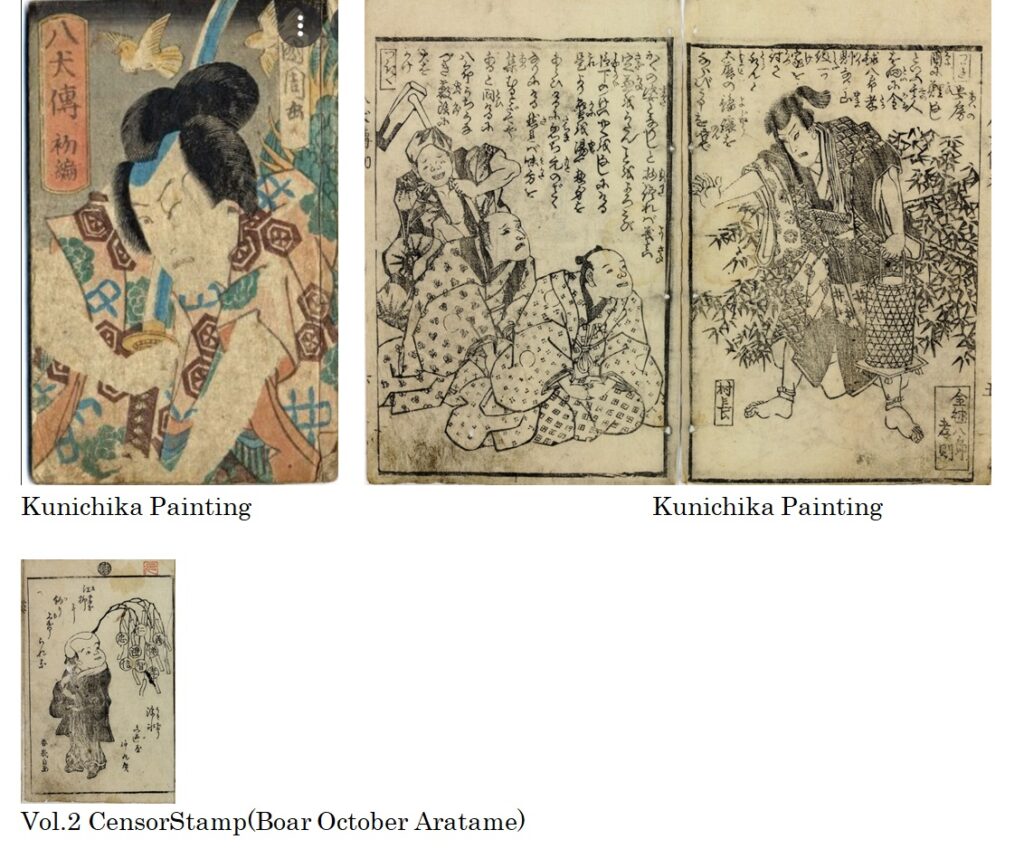
ARC所蔵・寄託品 古典籍データベース 1024画面 (dh-jac.net)
.
Kinkashichihenge Vol.14 By Kakutei Shuga Kunisada Painting & Kunichikaekaku Ichiousai painting Waseda University Library
The following figure on the left is from Vol. 14 Top and is illustrated in 1863 from the Censor Stamp (BoarMayAratame) on the margin of the page. In addition, it says “Kunichika e wo kaku(くにちかえをかく)”, indicating that Kunichika drew this illustration. The figure on the right shows that the picture of 1863 was drawn from the Censor Stamp (BoarMayAratame) in Vol.14 Bottom. On the right side of it, “一をう斎画Ichiousai drew this”, indicating that this illustration was drawn by Ichiousai Kunichika. The whole story was illustrated by Kunisada II, who is the son of his master Toyokuni III and a senior to Kunicika.

https://kotenseki.nijl.ac.jp/biblio/200016326/viewer/1
.
Uchiwa-e Field
This Uchiwa-e has a nice expression, so people in the Edo period would have spent a cool summer while remembering the play. The face of the person is naturally different from the one in the illustration, but the basic face length and nose are drawn in a way that is drawn as a picture of an actor. For this painting, the painter’s name Ittou Kunichika was used. In this year, 1863, the painter’s name Ittou Kunichika was used several times in ukiyo-e, but it has not been used continuously.
The work on the left depicts Sawamura Tosshou and Ichimura Uzaemon. However, the 13th Uzaemon succeeded to the name Kakitsu in 1862, and the 14th Uzaemon succeeded to the name in 1868, so there is no actor who officially calls himself Uzaemon. Since the Kabuki chronology is an accurate record, Ichimura Uzaemon’s name is not listed in 1863. However, since Uzaemon was popular at the time, there are many ukiyo-e prints in which Uzaemon appears until 1866. Based on the above, the performance record of 1863 in the Kabuki chronology was examined under the following two conditions. (1) A play in which Sawamura Tosshou and Kakitsu appear, and (2) performances from spring to summer because the picture is drawn on a fan that is used in summer. As a result, the following performances were found. February Ichimuraza performance “梅八重色香深川”, April Ichimuraza performance “花卯木伊賀両刀”, “恋討文珠知恵輪”. Unfortunately, there is no description of the cast names in any of the plays, so it is currently unknown, but it seems that these plays are the subject matter. In this painting, Uzaemon (actually Tachibana) reluctantly agrees but hesitates to hand over the money. Tosshou reaches out her hand to take it away, as if to say, “Give it to me.” The facial expressions and movements suggest that the viewer was present at the scene. Moreover, the crest painted on the lantern is the Gohishi stamp, which Kunichika began using in 1861.
The work on the right, the story of Fukuoka Mitsugu and Aburaya Okon, is also depicted in ukiyo-e, so it will be explained there. The program is “伊勢音頭恋寝刀”.
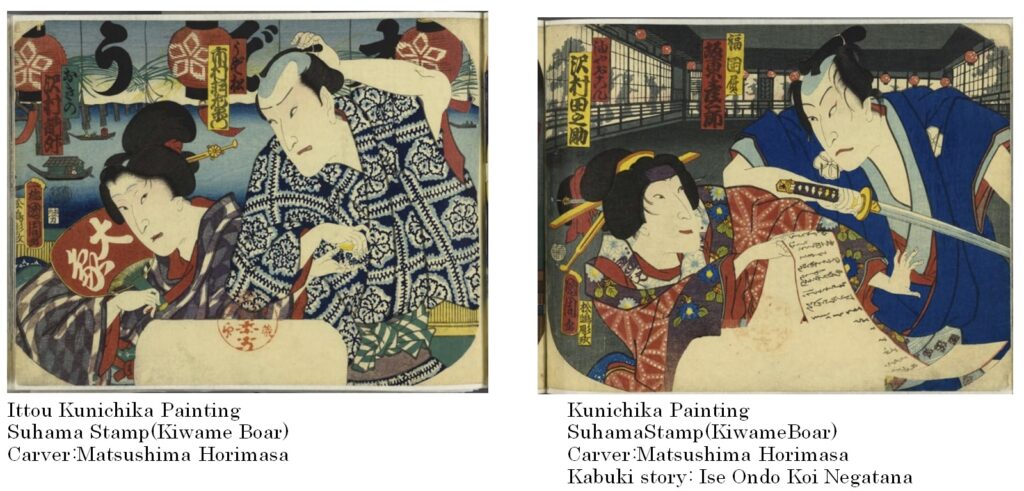
https://dl.ndl.go.jp/info:ndljp/pid/9369201
.
Ukiyo-e Field
Ukiyo-e search finds 279 works in this year. The main collections are 164 pieces at the Waseda University Theatre Museum, 26 at the Tokyo Metropolitan Library, 84 at the Boston Museum of Fine Arts, and 10 pieces at the National Diet Library that are not included in the Ukiyo-e search. As the number of works available to the public has increased, only interesting works and works with distinctive drawing styles will be introduced.
TakukaiShuennozu by OUJU Kunichika painting the Boston Museum of Fine Arts, 11.41571a-b
This work is considered to be the first demand work “OUJU”. It seems to be a memorial to some kind of celebration, not an actor’s picture. Large, auspicious sea bream is piled up, and sake celebrations are lively decorated. The movement of the person is expressed, but the facial expression is drawn in a way that is conscious of the actor’s picture.
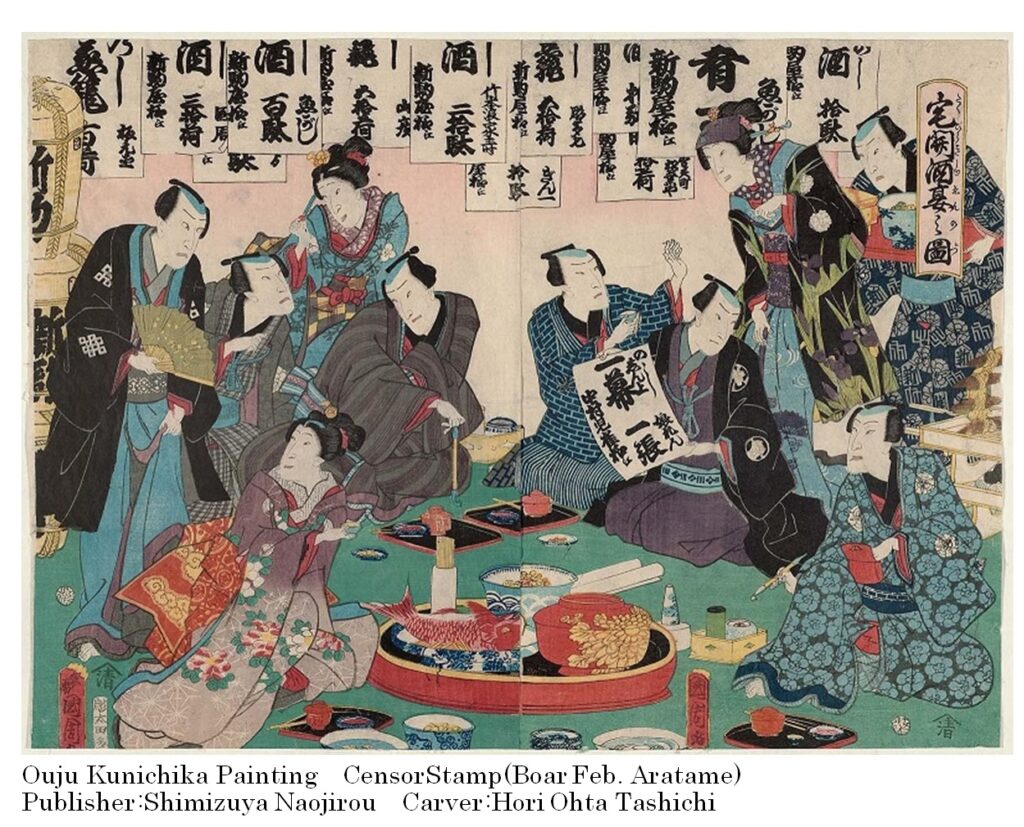
Mouko Dekisen no zo 蒙古溺船之図 Ouju Kunichika Painting from Amy Newland(53)
This is a sponsored work by Kunichika from July 1863. Early in his career, he had two sponsored works this year. In 1860, Sesshu daimotsuura nanpuu no zu, he painted a battle with a vengeful spirit, and unlike Kuniyoshi, the theme was narrow. This work was made to order, and in response to a customer’s request, it is a general picture of the Mongols being at the mercy of a typhoon and being defeated.
According to Higuchi Hiroshi (82, p77), in that year, the Choshu clan bombarded a foreign warship at Akamagaseki, and a British ship bombarded Kagoshima. He states that cartoons circulated that compared these incidents to a Mongol invasion. This picture seems to be one of them.
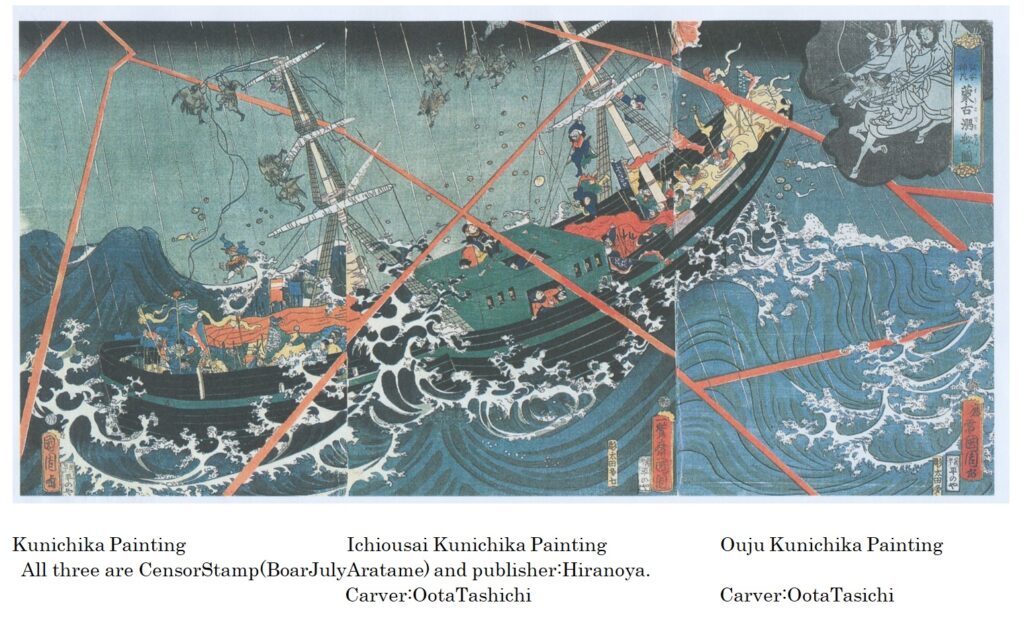
.
Iseondo koinonetaba 伊勢音頭恋寝刀 by Ittou Kunichika The Boston Museum of Fine Arts11.41641a-c
The next picture is a stage picture of the full body of the actor, that is, a long shot picture. It depicts a scene in which Aidamaya Koroku (Nakamura Kantaro) tries to stop the fight between Aburaya Okon(Sawamura Tanosuke) and Fukuoka Mitsugu(Bando Hikosaburo) even though he is tied up. “Okon” played by Tanosuke seems to have been attacked when she came out of the restaurant. Kunichika is good at drawing facial expressions, and the feelings of each person are conveyed to the viewer. However, this picture is a picture in which Mitsugu noticed something and stopped moving.
This picture is a scene from “Ise Ondo Koi Negatana” performed at Nakamuraza Theater in May. Fukuoka Mitsugu was asked to find the famous sword “Aoe Shimosaka” and the appraisal certificate, so he found it. He returns home with the sword and the certificate he found. On the way, Fukuoka stops by the red-light district of Ise-Furuichi. There is a familiar courtesan Okon from the Aburaya store. Villains such as Aidama Kitoroku try to steal the famous sword and appraisal. With Okon’s help when she comes to her senses, she swaps the scabbard on the sword and tricks the villains. On the way home from Fukuoka Mitsugu drunk, he notices that the scabbard is different and returns. However, since it was a cheap scabbard, it broke, revealing the real famous sword, “Aoe Sakashita.” Mitsugu, who holds it, cuts people easily because it is a mysterious sword, and he kills villains one after another. At that point, Okon brought the certificate of authenticity that she had recovered and told him that the sword was the real Aoe Shimosaka. The picture of Tanosuke and Hikosaburo in the uchiwa picture introduced earlier is the same program, and the silhouette of the geisha dancing to the Ise Ondo is drawn on the uchiwa picture.
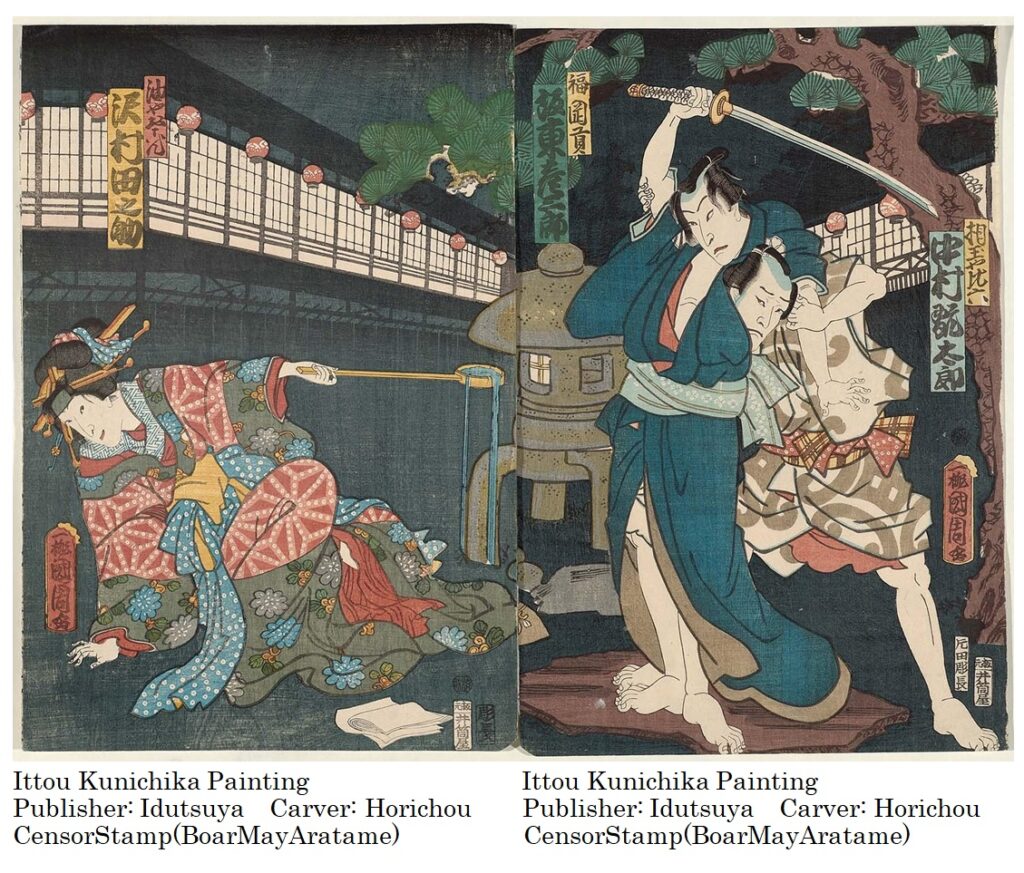
.
Nihonnbashi Bijin no Yuukei Ittou Kunichika the National Diet Library the National Diet Library
Portrait of a beautiful woman standing. The background is monochrome and the person is expressed in color. The bustling town at the foot of Nihonbashi blends into the twilight, and the women in the foreground stand out. Masters of Bijinga Harunobu and Kiyonaga used plain backgrounds, but Kunichika carefully drew the surroundings, and he was quite skillful in his monochromatic treatment. In addition, the pattern of the kimono is modest, so the woman stands out. Since there is no mention of the actor’s name, Kunichika seems to have drawn women’s faces freely. Since around this time he has been drawing faces that give the impression of being gentle and cute. In particular, the woman in the center is wearing her “Pokkuri” with an innocent expression, and her cute gesture is drawn.
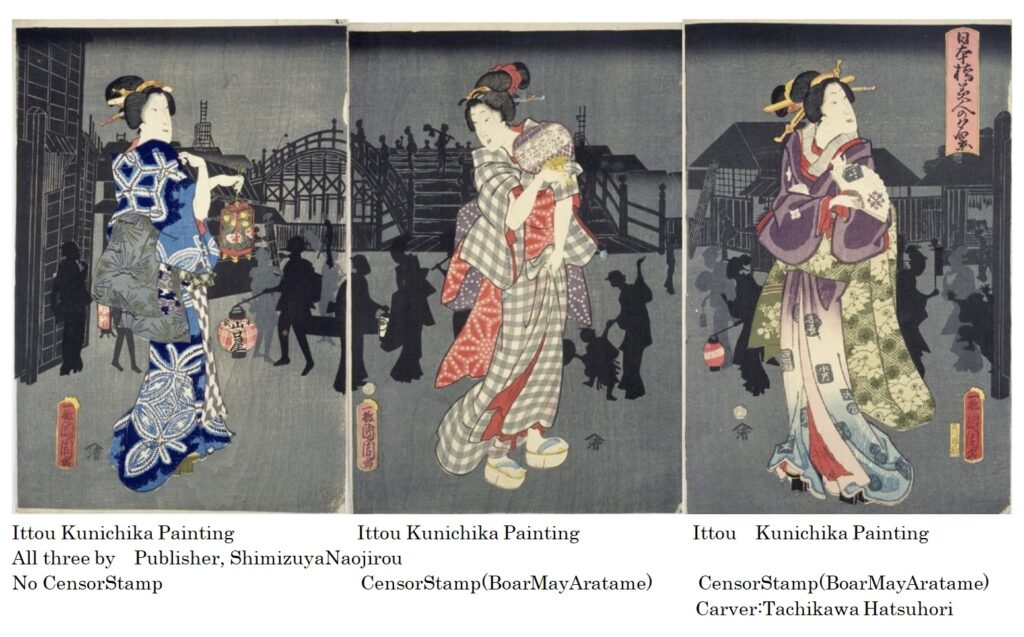
.
Shirokurenai sakurano goshozome 源平盛桜柳営染 Kawarazaki Gonjurou, Sawamura Tanosuke by Kunichika Painting The Boston Museum of Fine Arts 11.41653a-b
This painting depicts Kawarazaki Gonjuro and Sawamura Tanosuke as a medium shot painting. Matsuwakamaru was played by Gonjuro and Seigenama was played by Tanosuke in the play “源平盛桜柳鶯染”performed at the Nakamura Theater in March 1863. The surrounding situation is not depicted, and the two are staring at each other in silence. For those who know the play, it is a picture that brings to mind a specific scene and empathizes with it. The fact that such a medium shot paintings have increased means that the popularity of Kabuki is so high that more people are able to understand the contents of the drawings without having to explain the play in long shots. Around 1863, Sawamura Tanosuke and Nakamura Shikan were popular actors competing for the top spot. Tanosuke was popular for his fragile female roles. Such a gentle image is drawn. The style of this painting gives the impression that something is about to begin, and it does not depict the stereotyped scenes of the actors in the moving scenes of Kabuki plays. The development of the story is left to the viewer.
In the Kabuki chronology, there is a record of a performance at Nakamura-za in March 1863. According to the records, Kawarazaki Gonjuro was played by Yorikuni, who was the military commander of the Taira clan, and Tanosuke was played by Seigen. In this picture, Gonjuro plays Matsuwakamaru, the Minamoto side who wins at the end, so he may have played two roles. The background is a blizzard of cherry blossoms, and the scenery is faintly expressed in black and white to make the two actors stand out.
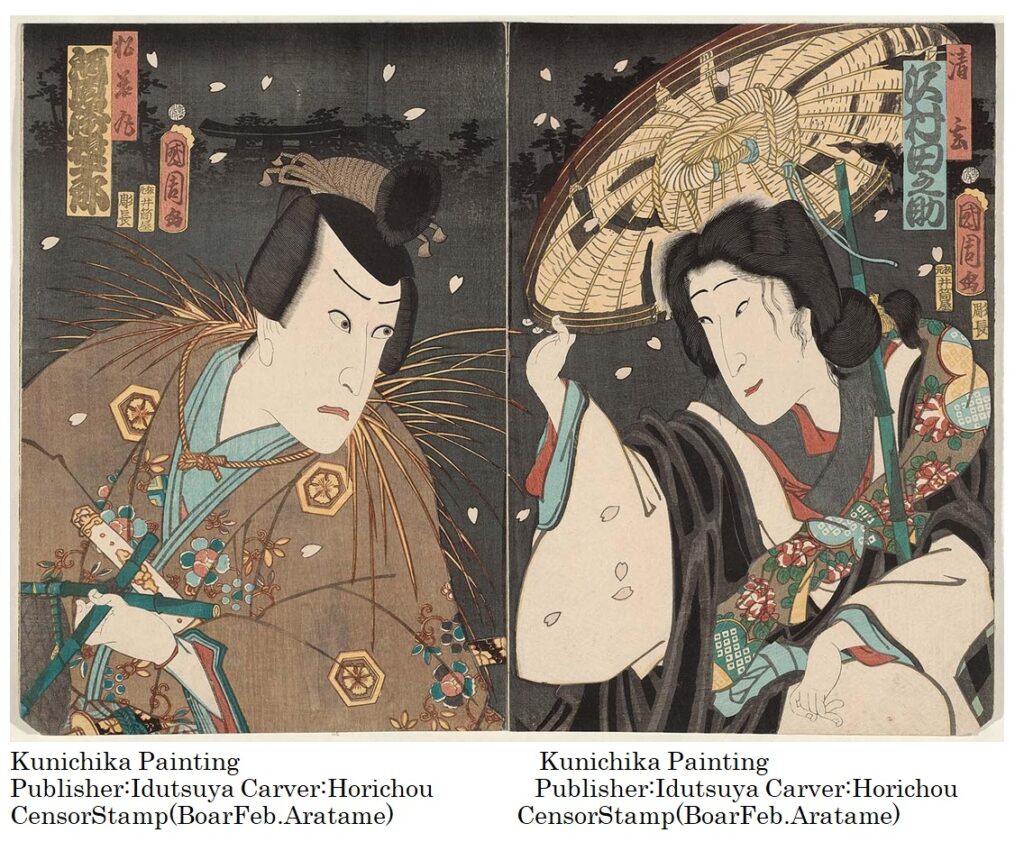
.
Shinshu Kawanakajima Battle、 Terutora Serving Scene Ichiousai Kunichika painting Kunichika Painting Waseda University Theater Museum 007-2825, 2826, 2827
Kansuke (center), who hides his face from Kanetsugu (right) with a banner, asks his sister Otane (left) who is holding a child. Her carefree face conveys her feelings. On the other hand, Kanetsugu, who cannot read the expression on Kansuke’s face because of the banner, looks at him with suspicion. Kanetsugu, the governor of Naoeyama Castle on the right, is a vassal of Uesugi, and on the left is his wife Otane. Yamamoto Kansuke is in the center, but he’s an excellent strategist for Uesugi’s rival Takeda Shingen. The story is that the Uesugi side plans to take in the excellent tactician Yamamoto Kansuke. Each facial expression depicts a feeling.
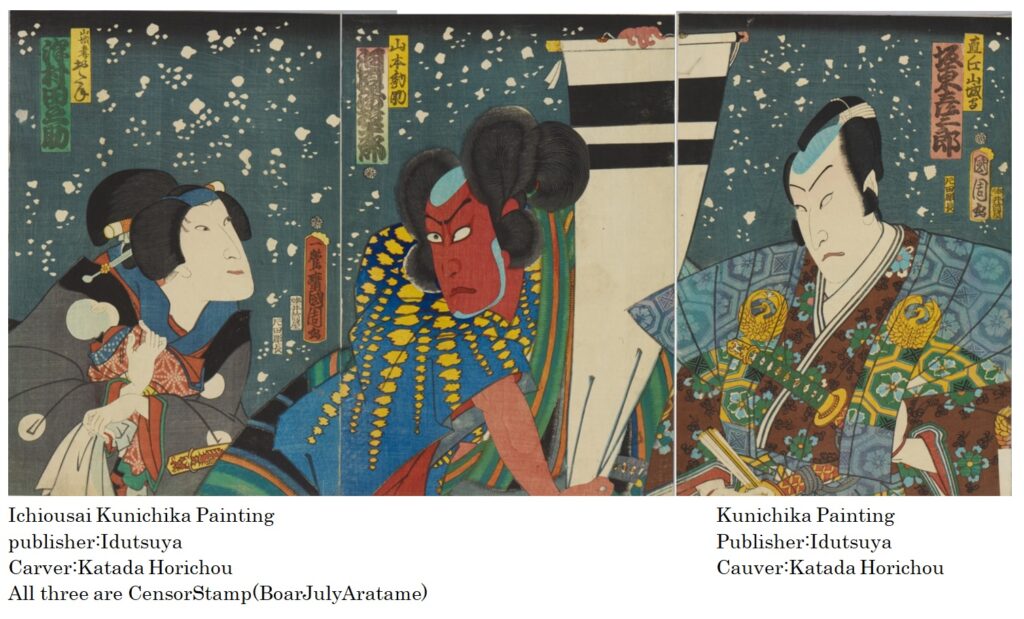
.
Nakamura Shikan by Kunichika Painting Waseda University Theater Museum 100.3945、100-3946
The following two paintings are from the same story, with Censor Stamps in August of the same year, but released by different publishers. This is a scene from “四海大和望月駒” or “優平家曲拙” performed at Morita Theater in August. The first Surugaya’s picture is a long shot where Nakamura Shikann as Kagekiyo is rampaging and the boat on which Bando Mitsugorou as Hitomaru and Kamezou as Saji Tayuu are riding is drawn in the distance to explain the situation. The second Etsuka’s picture is a long shot in which the characters are drawn side by side and everyone represents one scene. Comparing this, the first piece draws a close-up of the person to emphasize the movement, and also expresses the passage of time of the story. Etsuka’s version is a standard, and it is a way of drawing a stage where the actors are lined up in a row. The Surugaya version emphasizes how Nakamura Shikan is rampaging. We can understand how the story unfolds by looking at these two pictures.


.
Edohakkei Suzaki 江戸八景 Kunichika Painting Waseda University Theater Museum500-1204
This painting has a landscape in the background. Kunichika has painted the background carefully in the past, but this work also carefully depicts the distant view. At this time, the wind is strong and the paper is being blown away. A boat can be seen on the sea beyond. Although the composition is from the waist up (medium shot), it is a picture with a composition that includes an explanation of the situation. The background is carefully drawn with people in front and back, and the overall composition is well-balanced. All of the backgrounds in this Eight Views of Edo series are carefully drawn and wonderful. In addition to the Eight Views of Edo introduced here, Nihonbashi Yusho 日本橋夕照(Theater Museum 500-1201), Kinryuzan Taisetsu 金龍山苔雪(Theater Museum 500-1203), Eitai Kihan 永代帰帆(Theater Museum 500-1202), Tainyusan Banshou 待乳山晩鐘(Theater Museum 500-1206). Kunichika released six landscape paintings in 1963, but he did not paint any landscape paintings after that. However, as introduced here, he carefully painted landscapes in the background of actor paintings.
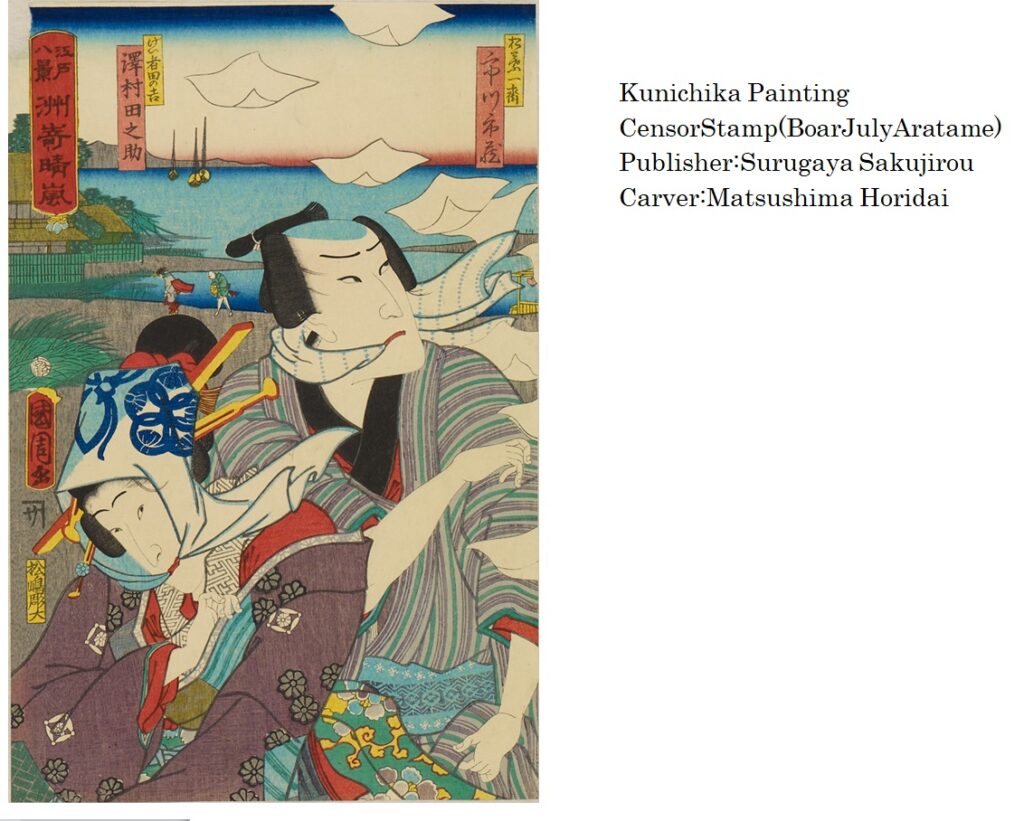
.
Genji no waka Ohmihakkei 源氏の若 近江八景 by Ittou Kunichika and Kunichika The Boston Museum of Fine Arts 11.41641a-c
There are few Genji paintings like this one. In this painting, distant bridges, boats, and pine trees are painted in black and white in the background to emphasize the main character. The pattern of the princess’s kimono is a gorgeous flower pattern, and it is beautiful enough to be admired by itself. The maid’s pattern is dark in color and complements the princess’s kimono. Kunichika’s paintings of beautiful women aren’t very well-received, but he draws gorgeous but common-minded paintings like this one. In so-called bijinga paintings, kimonos are drawn in subdued tones so that the viewer can concentrate on the woman’s facial features and gestures. However, when Kunichika draws oirans and young girls, he draws flashy and gorgeous patterns such as kimono patterns. The spectators are captivated by the flashiness of the kimono and get an impression of excitement. It is not a bijin-ga that appreciates a beautiful woman. Regarding the painter’s name, the Boston Museum of Fine Arts lists it as “Itto Kunichika一投国周”, but it can be read as “Itto Kunichika一桃国周”. There is also ‘源氏廻君富士見亭遊覧之図’, which is owned by the Waseda University Theater Museum, as a Genji-e from in this year.
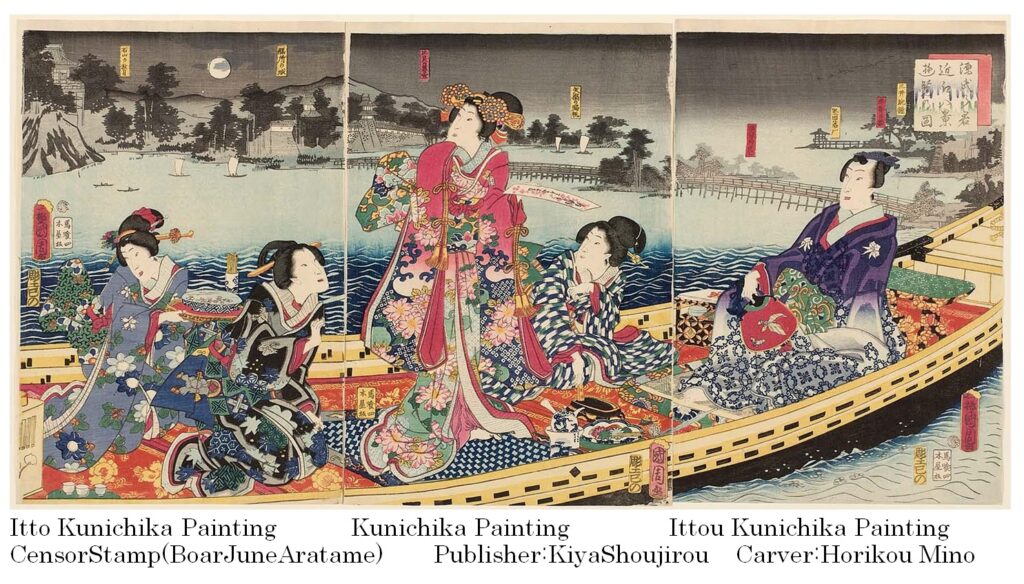
.
Sonoyukari Kuruwa no akebono 其田練廊里暁 Kunichika & Ichibai Kunichika The Boston Museum of Fine Arts 11.41861a-c
Genji picture drawn in long shot. It expresses a scene where Kamuro does not let customers go home in the morning at a red-light district. The two people in the center are the main characters, and the surrounding women’s gazes are scattered, creating the atmosphere of the moment. A distant view is drawn on the right side of the page to give a sense of depth.

.
Landscape painting 6 works by Ichiou Kunichika, Ichiousai Kunichika&Kunichika Mainly The Boston Museum of Fine Arts
Only this year, there are 6 landscape paintings by Kunichika. Only six landscape paintings by Kunichika can be found, but they are all characterized by their vertical composition. These paintings by Kunichika cannot be ignored the presence of humans and may not be established as landscape paintings. Published by Isesho (Iseya Shonosuke), Etsuka (Echizenya Kaju), and Kagisho (Kagiya Shobei), all of which are based on the 53 Stations of the Tokaido. The person is drawn, but it is a part of the landscape, not the subject of the person. In his later years, he painted other than the actors on the stage, but all of them are based on people, and there are no landscape paintings like the ones introduced here. Many of his works have been left behind, but these are the only six landscape paintings.
These paintings were part of a set called ”Gojouraku Tokaido”. According to Suzuki Toshio(57), many artists and publishers published sets of Tokaido, commonly called Gojouraku Tokaido, in anticipation of Shogun Iemochi’s journey to Kyoto. This is based on the large number of remaining works. Yamamoto Noriko (58, 59) writes that the Gojouraku Tokaido series, which has a total of 162 illustrations, was produced by Toyokuni III of the Utagawa school, who was responsible for overall management above that of a publisher, as the president of the Utagawa school, and directed the production as a collaborative work by 16 Utagawa school artists, including Kunichika. The warrior processions depicted in the famous landscapes avoid any depiction that would clearly identify Iemochi. The Sasarindou crest is recognized as the crest of Minamoto no Yoritomo, but in particular, the nishiki-e prints depicting Iemochi’s journey to Kyoto all state that it was used as a metaphor for Yoritomo’s journey to Kyoto.
The first place of the journey was the Tenryu River, where Kunichika painted the strong flow of the Tenryu River. The various travelers on the ferry boat are depicted, and the atmosphere of fun is conveyed. In Futagawa, he painted foot soldiers walking through a mountain pass. Of the six landscape paintings, this work is a masterpiece that evokes various thoughts in the viewer. The next place we visited was Toyokawa, where we could see a large shrine, perhaps Toyokawa Inari, in the mountains away from where the daimyo procession was passing. This painting style is like a type of ink painting drawn on a hanging scroll, with the foreground and background drawn in. Next was Chiryu Pond (now Chiryu City), where a woman was probably beating cotton cloth to make it soft, and the daimyo procession was moving in the distance. The title says “Arimatsu no kei,” so it must be Chiryu, known as the production area for Arimatsu shibori, a dyed cotton with indigo. The next stop is Mizuguchi-juku, where a foot soldier is chatting with a woman who seems to be the innkeeper on a street with lively ornamental flags fluttering about, and a samurai is resting on the veranda, having been offered tea by the innkeeper. There is a sense of relief that the day has ended safely. The last stop is Zeze Castle, a castle that juts out into Lake Biwa and is surrounded by the lake from behind. This painting of Zeze Castle has a large stone wall in the background, and the distant scenery is blurred in a color that is close to monochrome. Meanwhile, only a small boat is depicted, and there are many passengers, making the painting messy. The passengers stand out, but there is no clear main role, with monkey trainers, horse pullers, people smoking, and others. Kunichika is trying to express the travel scene in prose. For this reason, it may not be appropriate to select only the painting of Zeze Castle as a landscape painting.
As mentioned above, although it is a landscape painting, the scene of the journey to Kyoto (the warrior procession) is depicted in a way that blends into the landscape. All of the works are painted in a vertical composition, but this was most likely at the instruction of Toyokuni III, who intended to create a book later, and it does not seem to have been Kunichika’s personal decision as an artist.
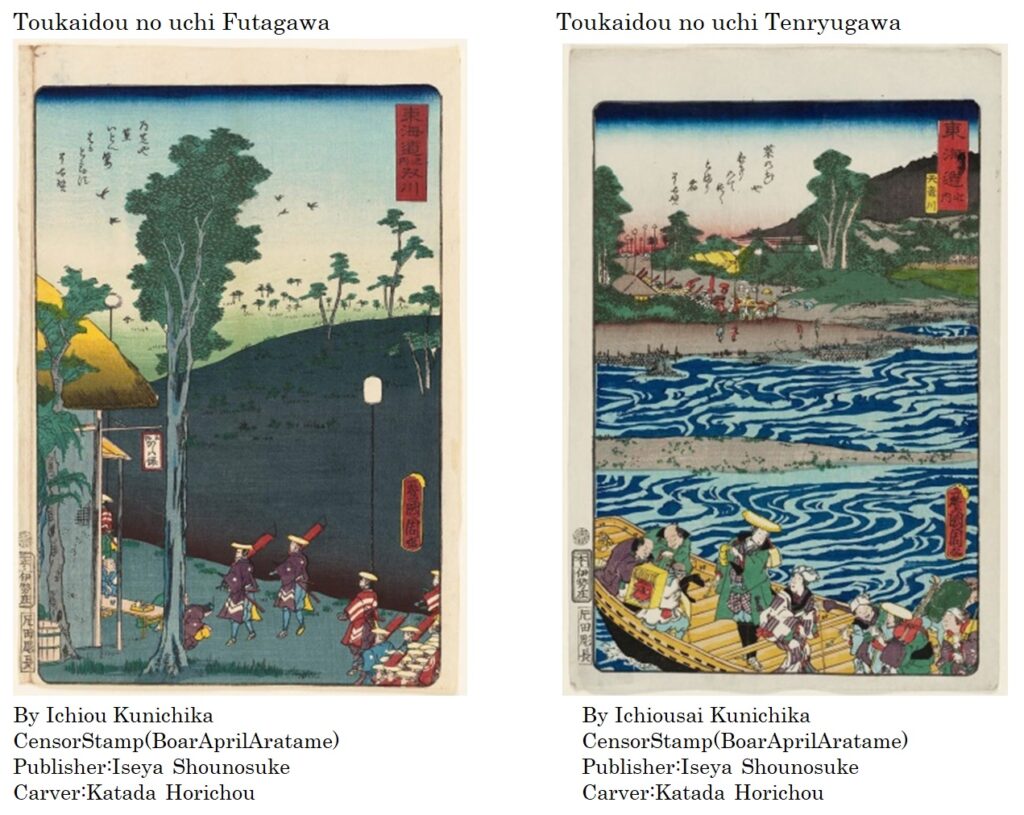
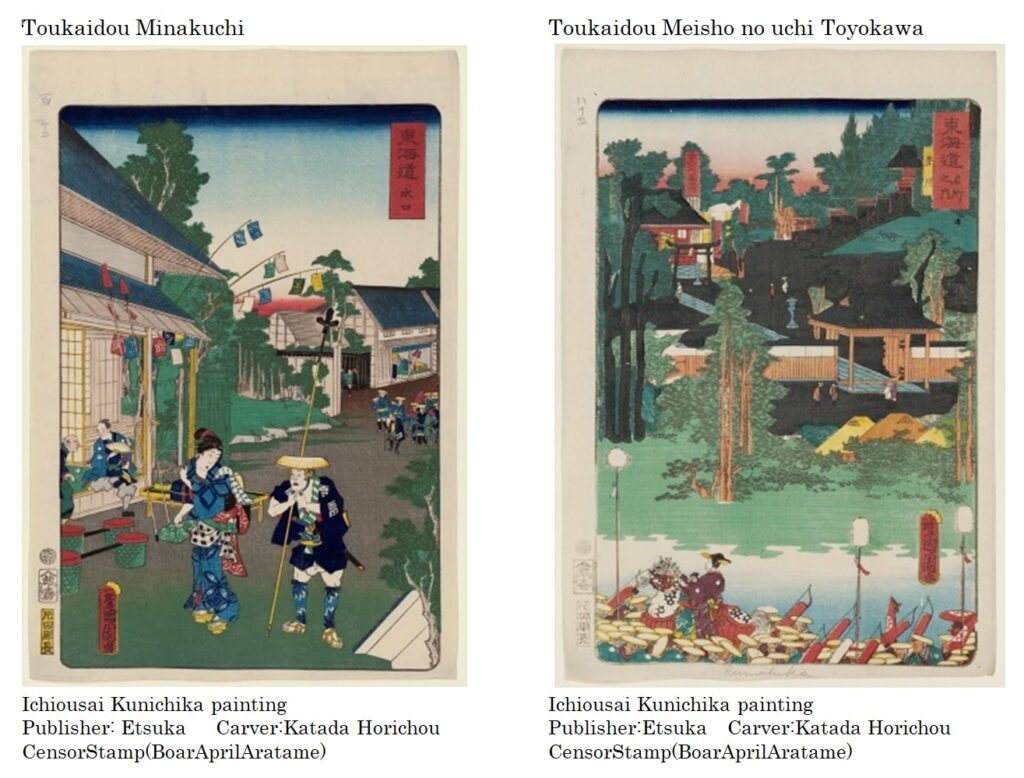
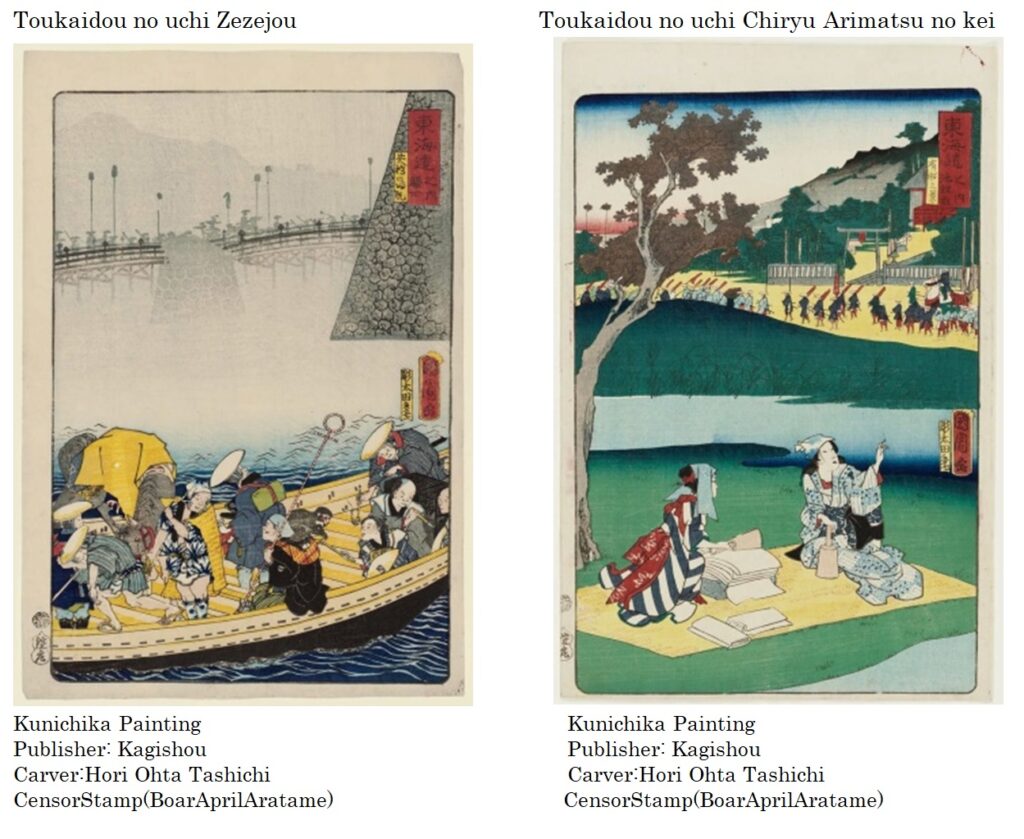
.
The following two works are not landscape paintings, but rather have a daimyo procession as their subject. They depict the daimyo procession moving solemnly forward in a long shot. In the painting of the Suzugamori Procession, a large monument is painted on the right side, which seems to be the subject of the painting, and it reads “Nami abudabutsu.” In other words, the painting shows a daimyo procession passing by the Suzugamori execution grounds, and the family crest of Sasarindou can be seen on the lord’s basket. In the painting of the Spring Capital in 1863, a daimyo procession is depicted moving solemnly forward across a temporary bridge lined with boats. These two works were also created in honor of the major event of the Imperial Journey to Kyoto.

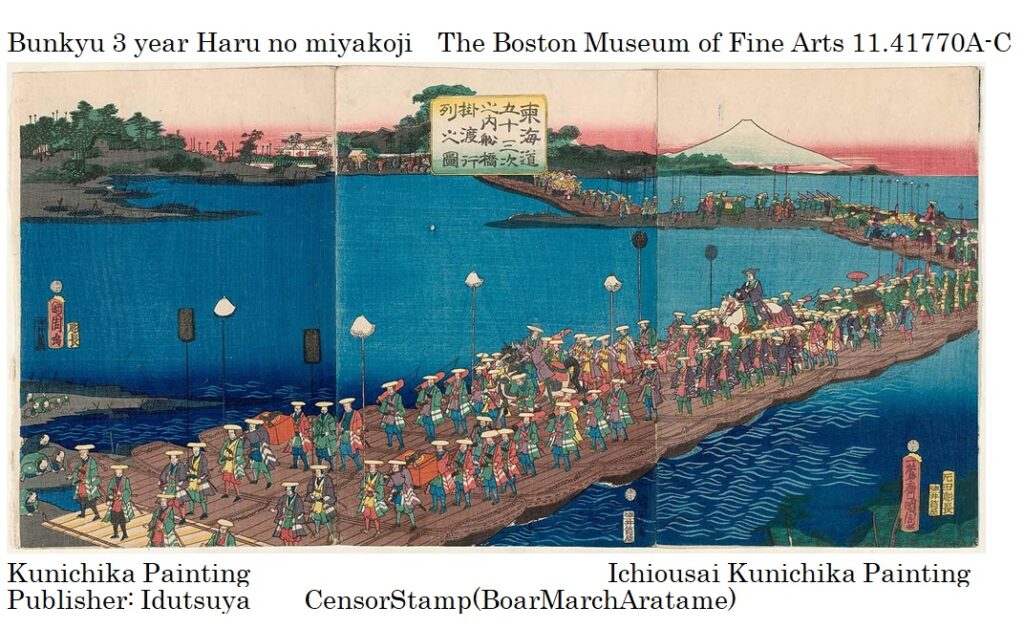
.
Sonoyukari Genji Sugoroku そのゆかり源氏寿古六 by Ouju Ichiousai Kunichika Painting Waseda University Library 文庫30B0226
This is a sugoroku (children’s game), but it has been censored. The CensorStamp is (Boar /October /改), so it is a work of 1863, published by Kameyudo Oomiya Hisasuke. A work that combines 6 large papers. The original is as large as 78 cm x 78 cm, and is combined with a large papers (26 cm x 39 cm). From this example as well, it is probable that all the paintings by the painter had been censored. Furthermore, this work is a demanded work under the name of Ichiousai Kunichika.

.
Bunkyu 4 Rat 1864 文久4年
In the field of illustration, there was one work, and there were seven fan paintings. His ukiyo-e increased to 410 works. Most of them are medium shots from the waist up. Although there were few standing portraits of actors depicting the whole body. There is only one painting like Genji no Kimi.
Field of Illustration
Mizukagami Yamadori Kitan 水鏡山鳥奇譚 Vol.2&3 By Kakutei Shuga, Ichiousai & Kunichika painting
This material was first published in 1863, and the story continued and was published the following year. The censor stamp is (RatAprilAratame), and another page is stamped with (RatJuneAratame), so the pictures in volumes 2 and 3 were drawn in 1864. There is no picture of violent movement like a warrior picture, but it was drawn expressively. In this painting, the two men on the right are whispering to each other, and their grim expressions allude to the story.
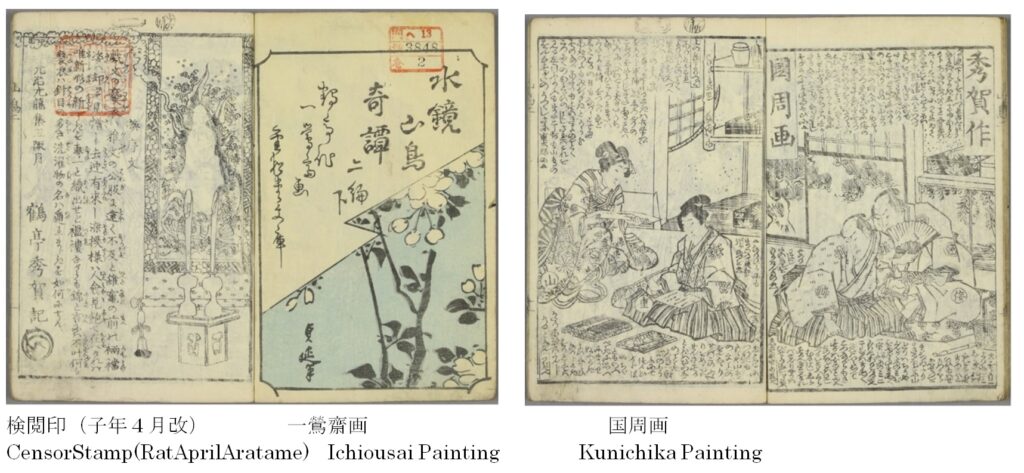
.
Uchiwa-e Field
This year, seven uchiwa paintings have been preserved. The paintings used the psinter’s name “Kunichika Painting” surrounded by Toshidama Stamp, but there was another example where Gohishi Stamp was used. The person drawn has a gentle face and a smiling expression typical of Kunichika. The botanical drawings of tree peony, chrysanthemum, morning glory, iris, lady’s slipper, etc. in the background are carefully and realistically expressed.

Ukiyo-e field
The ukiyo-e search reveals that 410 works are stored around the world. Waseda University Theater Museum has 256 works, ARC has 79 works, Tokyo Metropolitan Library has 84 works, and the Boston Museum of Fine Arts has 84 works.
Memorial painting by Ichiousai Kunichika the University of Wisconsin-Madison
This memorial picture was drawn in December of the first year of the Genji era. Here, it is necessary to explain the relationship between the Japanese calendar and the Western calendar. The Japanese calendar is the lunar calendar, and the Western calendar is related to the solar calendar, so there is a slight deviation. It was corrected using leap months in the Edo period. This memorial picture is dated December 15 Genji Gannen (December 15, 1864), but when converted to a Western calendar, it is January 12, 1865. Therefore, it is correct to say that “Toyokuni III died in 1865.” However, Ukiyo-e is described as the first year of the Genji era, there is no work left by Toyokuni in 1865, and because it is considered in chronological order, Toyokuni’s death is treated as 1864.
This memorial painting was done by Kunichika, who used the name “Ichiusai Kunichika” given to him by Toyokuni III, and as a sign of respect to Toyokuni, called himself “Disciple Ichiusai Kunichika.” He is now known as Toyohara Kunichika, but as of 1864 he was not using the surname “Toyohara.” He also used a Rakkan stamp with Kunichika’s name written on it, not a Tosidama stamp or Gohisi stamp. Memorial paintings for actors that Kunichika did, such as Ichikawa Ichizo in 1865 and Sawamura Tanosuke in 1878, used the Tosidama stamp. The same typeface for this Rakkan was also used in Osiegusa Asagao Monogatari 8 in 1858. In the memorial painting for Kawarazaki Tamataro, he used the name Utagawa Kunichika in 1867 (April of the Year of the Rabbit) and used the same typeface for the Rakkan. The use of this stamp was limited.
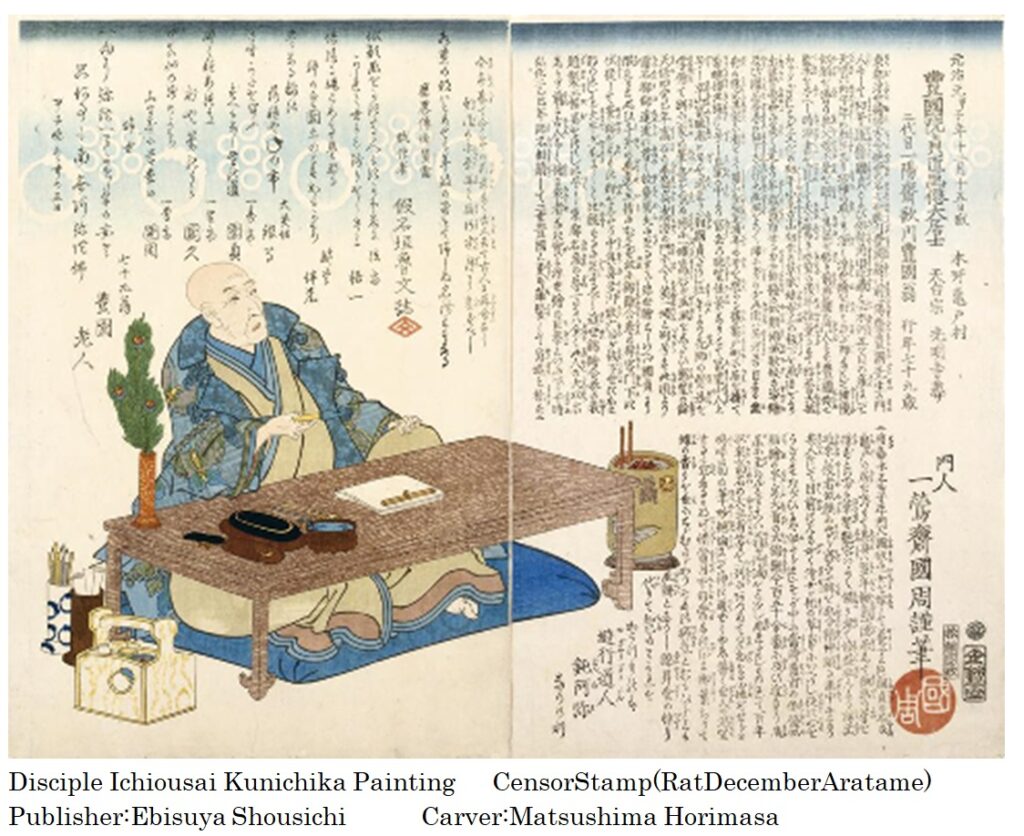
.
Fukagaw Hachiman Kunichika painting The Boston Museum of Fine Arts11.40528
It is a picture of a standing figure, and it is a picture that imaged Fukagawa Hachiman rather than a painting of a beautiful woman. He simplified the background and placed a sparrow at her feet. It is interesting that women wear kimono and high clogs when we think about it in modern times.
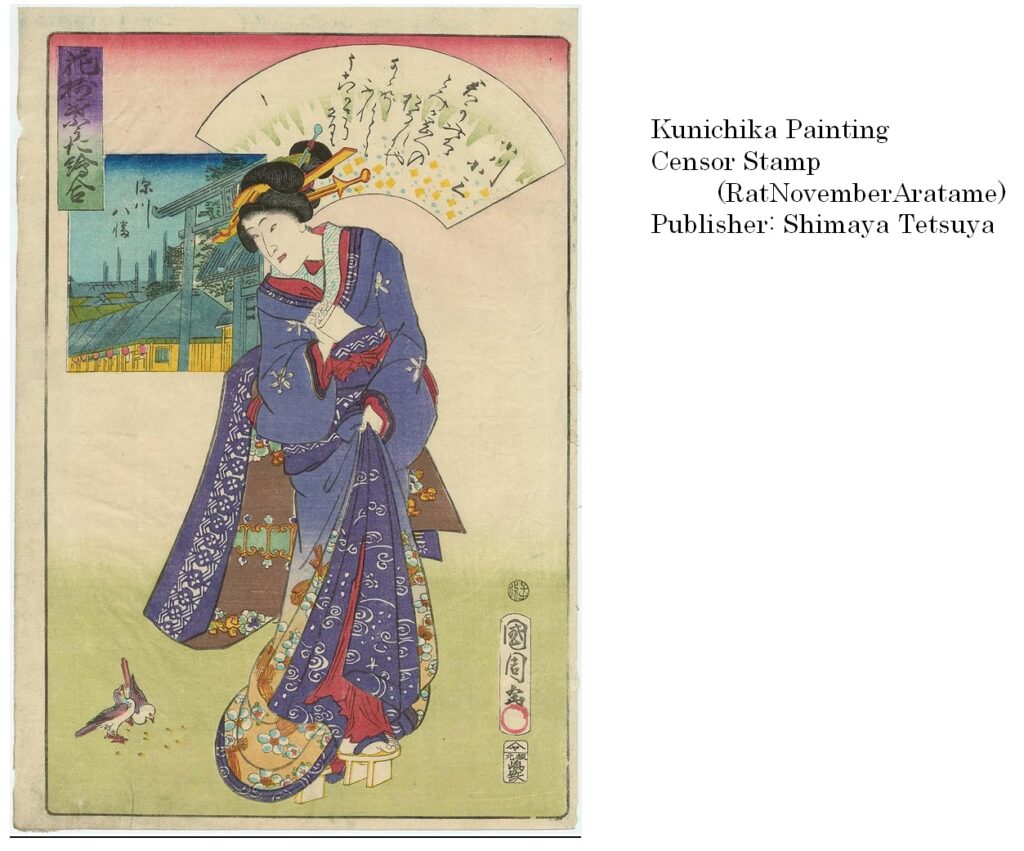
.
Soga Moyo Tatesino Goshozome曽我もよう侠御所染 Kunichika painting The Boston Museum of Fine Arts
This is the program for the February performance at the Ichimuraza. The actor is listed as Ichimura Uzaemon, but no actor using the name Uzaemon exists in the official records. Ichimura Uzaemon 13th took on the stage name Ichimura Kakitsu 4th at the end of 1862. Therefore, the Kabuki chronology records him as the official Ichimura Kakitsu, and Kunichika used the popular stage name Ichimura Uzaemon. Officially, the stage name Ichimura Uzaemon was vacant from 1863 to 1867.
This performance seems to have been a big hit, and was published by numerous publishers on different occasions, and has been archived. Since they all have the same censorship stamp (Rat February or March Aratame), explanations for each picture will be omitted. Since many more carvers and publishers were involved, they will be listed for each painting. The Boston Museum of Fine Arts access number is listed for each painting. The plot of the show is unknown, but the story can be figured out to some extent from the characters’ names.
Yuri no Kata scene
It seems that there was some kind of trouble, but Yurinokata, the wife of a samurai family, attacks his concubine, Hototogisu. She grabs Hototogisu by her obi and pulls her towards her, slashing her with her knife. There are three types of works in which the scene is medium shot and depicts murderous intent with violent movements. In the next scene, Yurinokata is judged by Koorinosuke as being suspicious. It is unclear why Princess Nadeshiko, the daughter of Yuri no Kata, is surrounded by a fence.
Scene of Mr. and Mrs. Gorozo and Mr. and Mrs. Kirihira:
It seems like Gosho Gorozou and his wife Satsuki are in some kind of serious situation. The fact that a cloth was wrapped around the blade of Gorozo’s sword was placed in front of him, suggesting that he was preparing to commit seppuku. He and his wife were playing their last shakuhachi and shamisen. Then, the comedian Kirihei and his wife, who were fascinated by the music, came to ask about it. Gorozo gets angry when his last moments are disturbed with a serious look on his face. In the next scene, Gorozo is about to commit seppuku, blood is already seeping out, and his wife is also prepared to watch. It’s a serious scene, with incense already burning in the room. What I’m curious about is the small coin placed in front of Gorozo, which seems to have some meaning.What kind of money is this? In the same room, Kirihira’s wife holds a letter in her hand and says something to calm him down, but Kirihira is still angry.
Scene in front of the temple:
Kirihira bursts out of the temple with a sword and attacks the townspeople, Mr. and Mrs. Nagohei, but he is not trying to kill them, but instead tries to beat them away with the stick on the signboard.
The scene is the same, but this time Nagohei, fully dressed in a kimono, kicks down the door from the temple with a long sword and rushes out, and Nagohei’s wife rushes out of a room featuring a sizable tree, also holding a long sword. The person who was attacked here was Koorinosuke, who first appeared.
Looking at this series of works, it seems that Kunichika was trying to convey the story to the common people by capturing the scenes of the play using long and medium shots. The main character changes one after another. At first, the story seems to be connected with Hototogisu and Yurinokata, Yurinokata and Koorinosuke, Gosho Gorozo and the Kirihei couple, Kirihira and Nagohei, the Nagohei couple and the first Koorinosuke. Long shots were used to express the development of the story, and middle shots gave the scene where Yuri no Kata attacks Tokitori very powerful.
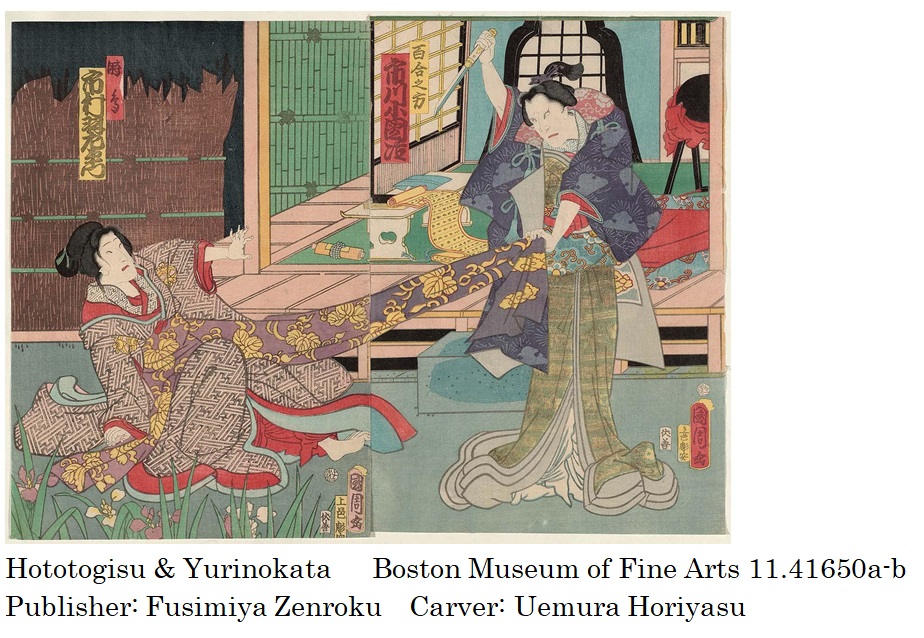
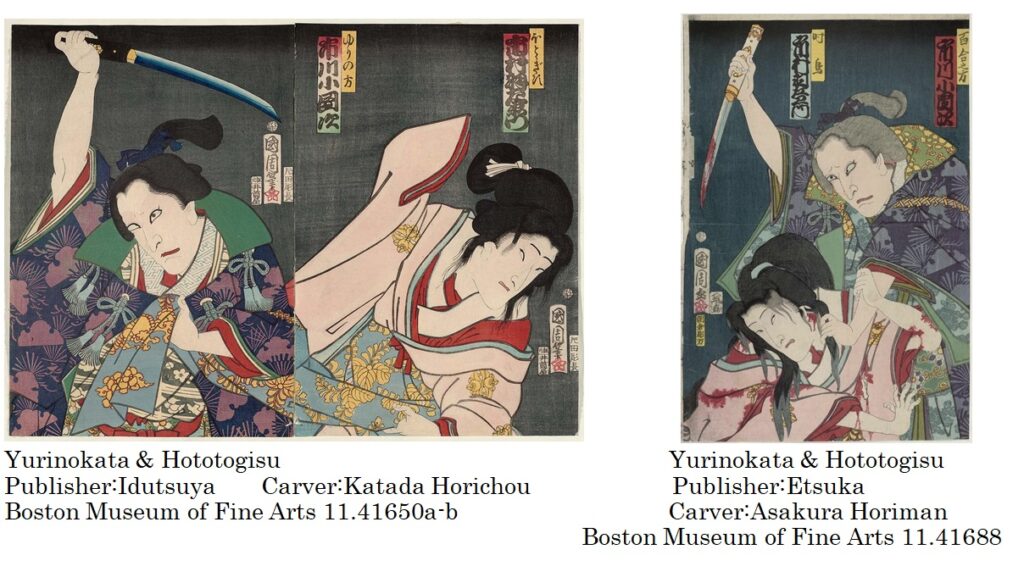
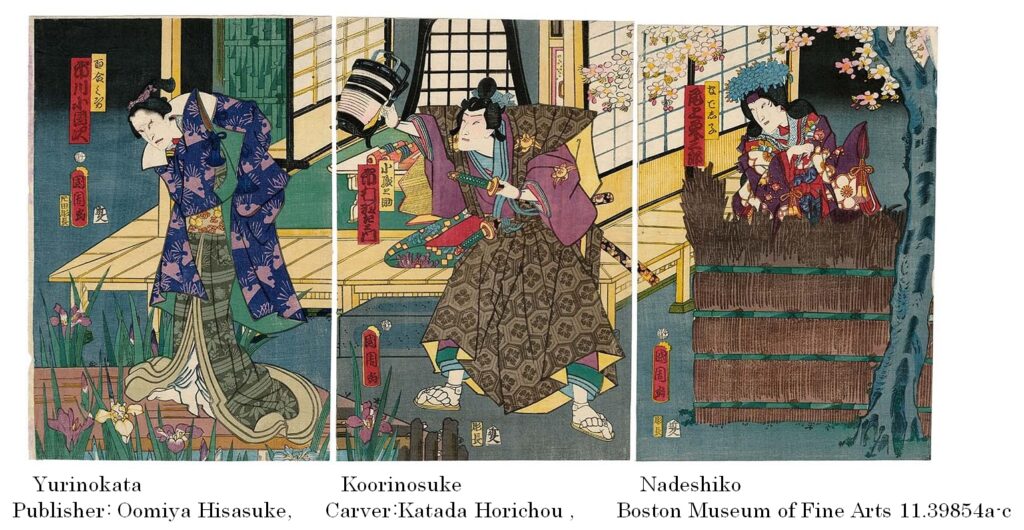
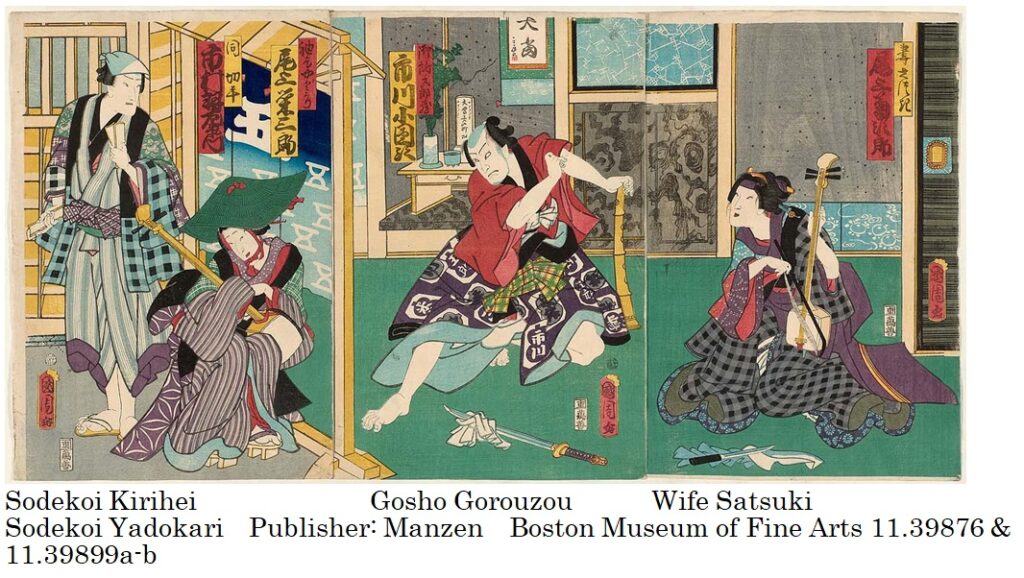

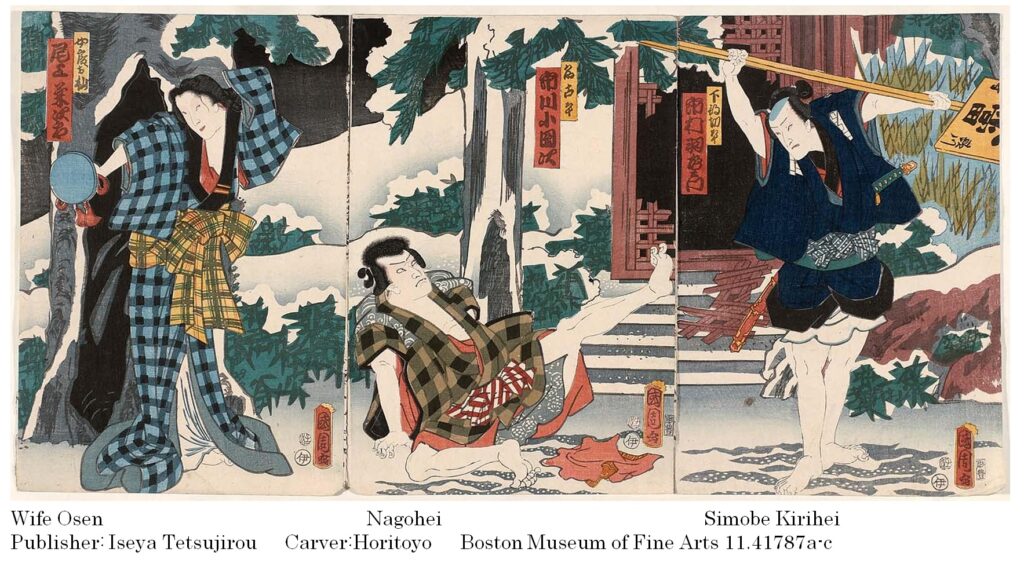
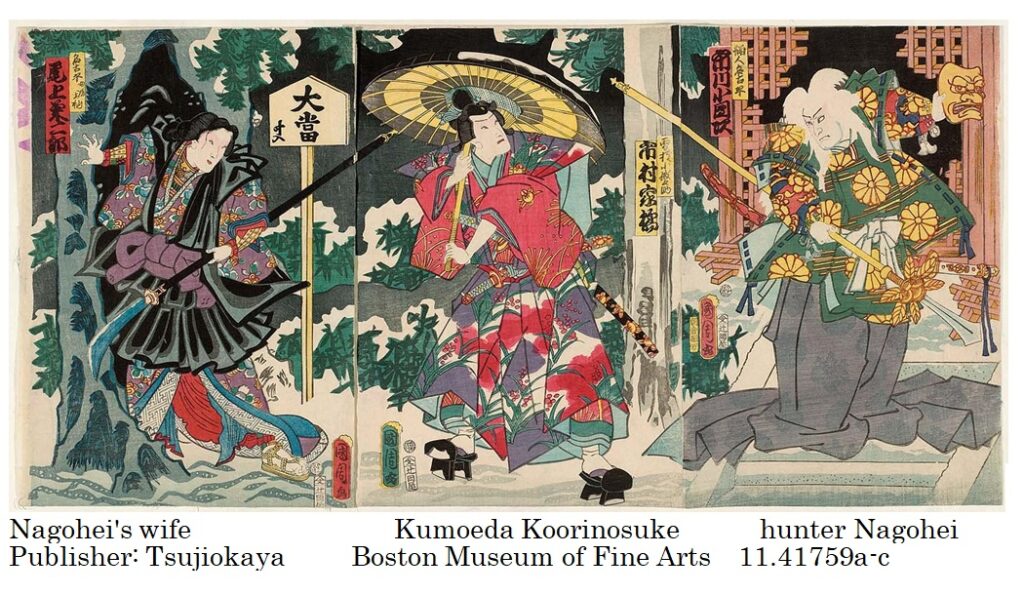
.
Futatsuchou Ironodekiaki 双蝶色成曙 Kunichika Painting The Boston Museum of Fine Arts00.1246a-c
Most of the compositions are middle shots (from the waist up) of the actors, and are drawn in a way that gives a sense of liveliness and movement. It is drawn in such a way that the viewer can easily understand the story. Of course, his number of works is small, but he also drew long shots. In the next painting by Nakamura Shikan, Sawamura Tanosuke, and Ichikawa Kuzou, Tanosuke is about to take revenge, but with a gentle figure, he skillfully depicts the gestures of a frail woman. This is a picture that makes the viewer worry and sympathize with her, who cannot avenge her enemies. This cannot be drawn with a middle shot composition.
This is a program that was performed at the Morita Theater in October, and in the chronological table it is Nakamura Shikan as Minami Yohei, Sawamura Tanosuke as Dainichi Otake, and Ichikawa Kuzo as Genchiku Uemon. The story is about Otake, an incarnation of Dainichi Nyorai, avenging his enemies.

.
Kinoene Sogano Daikokubashira 甲子曽我の大黒柱 Kunichika Painting The Boston Museum of Fine Arts 11.41841a-c
This play featuring Shimobe Isohei as Ichikawa KuzouIII, Toriyama Shuusaku as Nakamura ShikanIV, and Princess Shiranui as Sawamura Tanosuke III were performed at the Morita Theater in February. The composition of the medium shot (from the waist up) depicts Shikan Nakamura swearing. Kunichika richly depicts his facial expressions. Shiranui-hime is a sorcerer who manipulates spiders to play an active role.
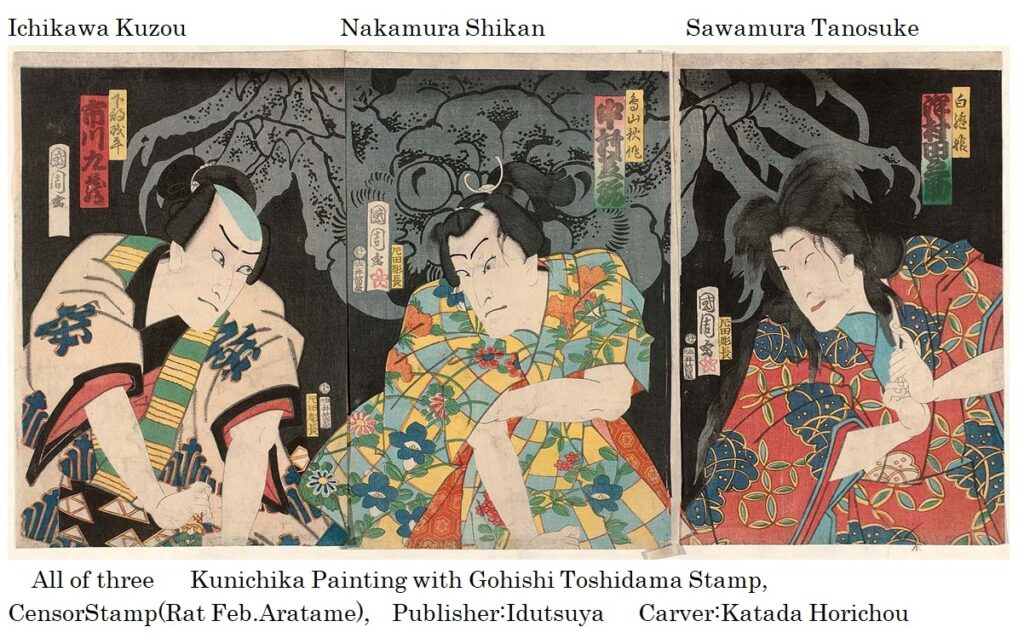
.
Sawamura Tanosuke、Sawamura Tosshou, Nakamura Shikan 沢村田之助、沢村訥升、中蔵芝翫 Kunichika Painting The Boston Museum of Fine Arts 11.4173a-c
This picture is drawn as a long-shot stage picture, and the story can be read by the gestures of the characters. The man played by Tosshou finally gets up from his bed, puts a serious expression on his face, stops smoking, and has a serious conversation with his wife, Shiraume, played by Tanosuke, who is about to leave. Date Gorou, played by Shikan, eavesdrops on this behind the fusuma and stands there with a smirk on his face. Viewers are interested in what kind of information was leaked. Unfortunately, when I checked the chronological table of Kabuki performances around January, which seems to have been drawn, there was no performance that matched the actors and cast.
Someone added to the paintings on the folding screen in this work. The signature says “Onshinfude音信筆” and it has the Gohisi Stamp used by Kunichika. It is strange why someone other than Kunichika would stamp this Gohishi Stamp on Kunichika’s painting. Although the Gohishi Stamp has been stamped, “Onshin” could be Morikawa Otojiro, a disciple of Kunichika.
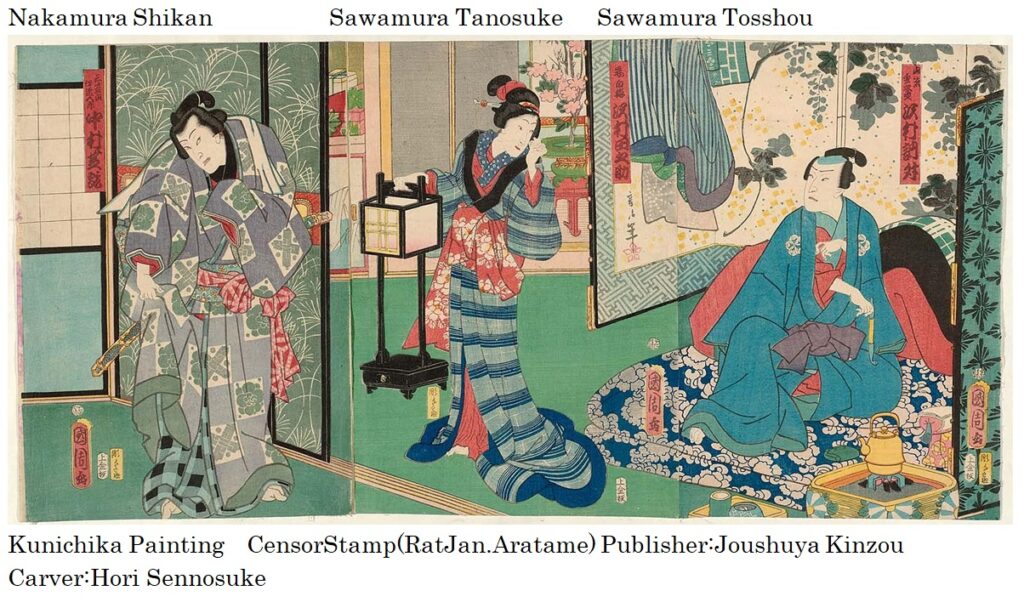
.
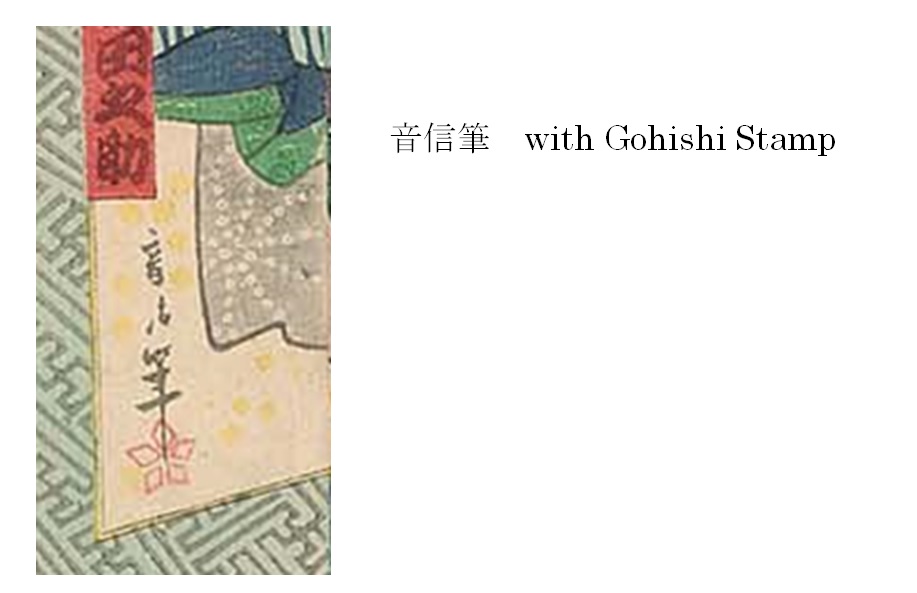
Nakamura Shikan (Ishikawa Goemon) 中村芝翫(石川五右衛門)Kunichika painting Waseda University Theater Museum101-0697
Kunichika has drawn several powerful works of one actor on a set of two large papers, and this picture seems to be the oldest of his set of two large papers. It is a composition like modern graphic art. The sword he holds in his left hand has movement, and his right hand appears to come out of his bosom. An example of such a composition is the painting of Ootani Tomoemon in 1866. This picture was painted in March. From March 4, 1863, ‘Keisei Omokagezakura’ was performed at the Morita Theater. There is a record that Nakamura Shikan played the thief Matsuwaka, but he was not Ishikawa Goemon. Kunichika must have replaced Goemon Ishikawa, the villainous man, in his paintings.
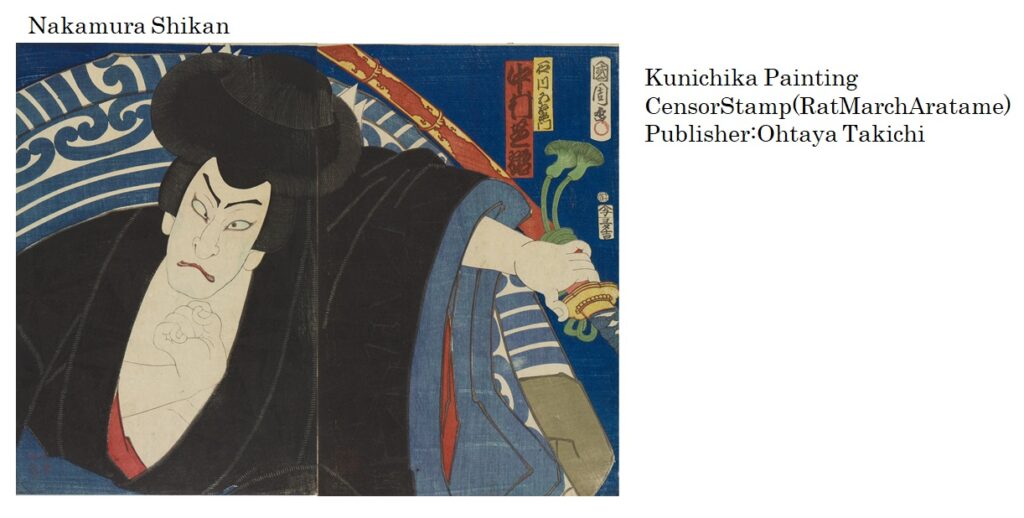
.
Touto Sanjuurokei no uchi 東都三十六景之内 Kunichika Painting Waseda University Theater Museum500-2503
I paid attention to the background drawn there, not as Ichimura Uzaemon’s actor painting. Similar to the 1863 work “Edo Hakkei”, Nihonbashi in the background and the samurai, merchants, and travelers who come and go are carefully drawn to create a sense of realism. This alone would be a fine street view painting.
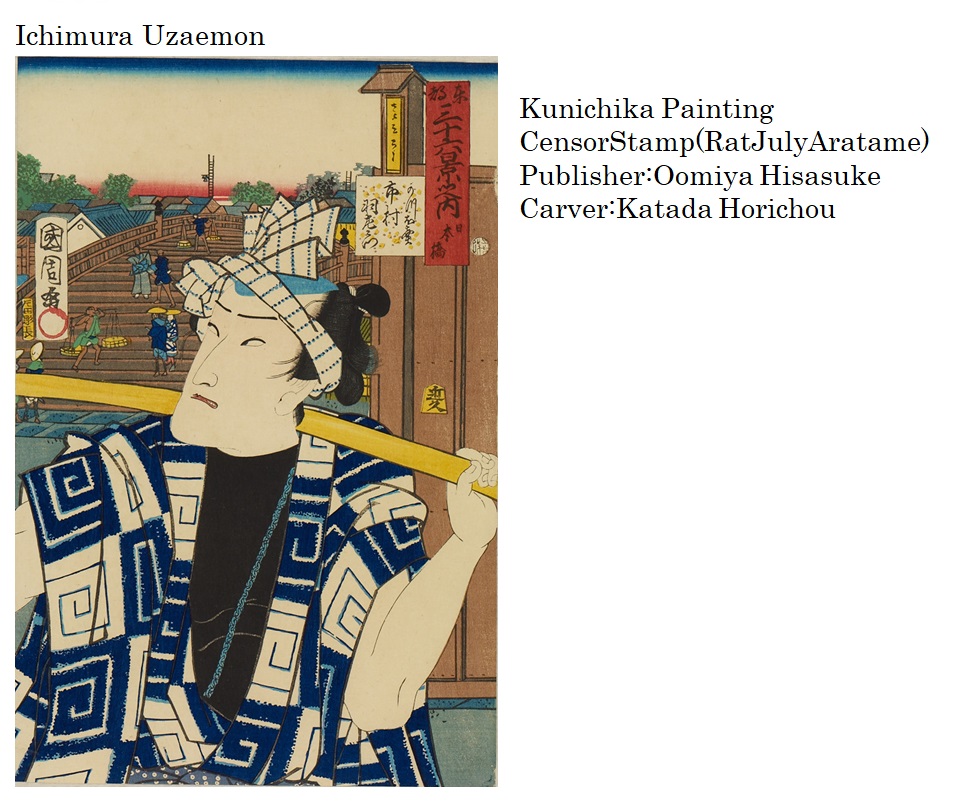
.
Hanafubuki naradeno otokogi 花吹雪強勢乃俳優 Kunichika Painting The Boston Museum of Fine Arts 11.40604
In this way, several paintings with snowflakes in the background are drawn this year. All of them are portrait-type pictures of actors, and the facial expressions and gestures are the usual pattern for actor pictures. However, Kunichika had a fixed way of drawing actors’ faces. In this picture, Shikan’s chin has been made solid to match the character of the play.
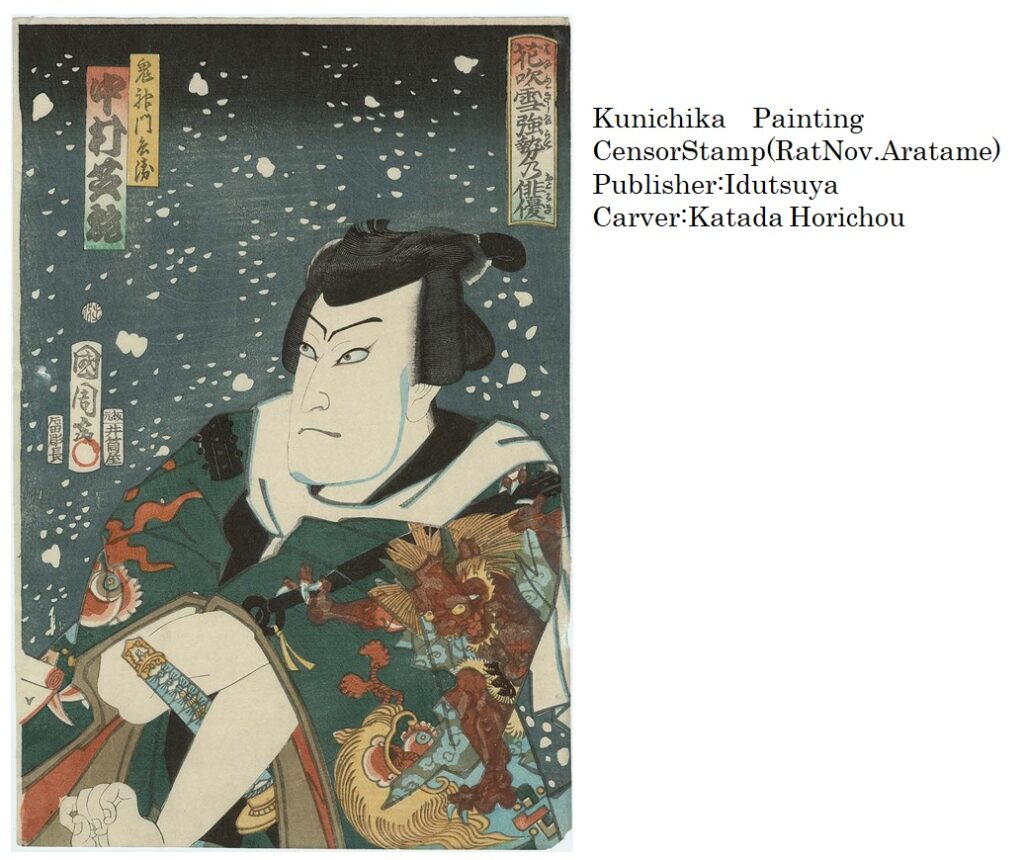
.
Osaidan 御祭壇 Kunichika Painting the National Diet Library 本別9-28 07-089
This painting is one of several that depict a spirited young man. What attracted attention to this painting was the fact that an artist other than Kunichika added a background painting to Kunichika’s painting. This painting is decorated with a frame-like object with a chrysanthemum flower drawn on it. The artist wrote “Kunioto Fude国音筆” on the work and attached a Toshidama Stamp. That is, the author can be read as “Utagawa Kunioto歌川国音”. The picture is a chrysanthemum flower that looks like it is supported by a bamboo fence. However, an artist of the Utagawa school named Kunioto国音 is not known. On the other hand, there was Otojiro Morikawa as a disciple of Kunichika. He had illustrated Kunichika’s 1863 Tatsumi Hakkei as “Kunichika’s disciple Otojirō”. In May 1864, the same person may have taken the name Kunioto国音 as a painter of the Utagawa school. It is known that Morikawa Otojiro was active from around 1869 as Morikawa Chikashige or Utagawa Chikashige. Therefore, if “Kunioto”is Chikasige, it may fill the gap between Kunichika’s disciples and Chikasige. However, according to Okamoto Hiromi (24,p347). Kunichika seems to have given the name of an artist to anyone who could draw a picture, so this may be a completely unknown person.

https://dl.ndl.go.jp/view/jpegOutput?itemId=info%3Andljp%2Fpid%2F1313325&contentNo=1&outputScale=2
.
Genji no kimi Ukai goyuuran 源氏君鵜飼御遊覧図 Kunichika draw Ichiousai kunichika painting Waseda University Library bunko30.b0222.pdf
It tells the story of a young lord and his princess. The lively patterns on the kimonos create a fun atmosphere. In the shallows on the left, women are using cormorants to catch fish. The caught fish are brought in a basket. The princess and the young lord are chatting about something, and the young lord is reaching out his left hand to have the woman pour him a drink. It is not a painting that allows you to enjoy the atmosphere in a relaxed manner, but rather conveys an event. He began to paint a large number of pictures of actors performing plays, but he also painted pictures like this one where the people blend into the scenery against a natural background. The background is spacious and has a sense of perspective. This style of painting was carried over to “The Fifty-Four Feelings of the Present現時五十四情 ,” published in 1884 (Meiji 17).
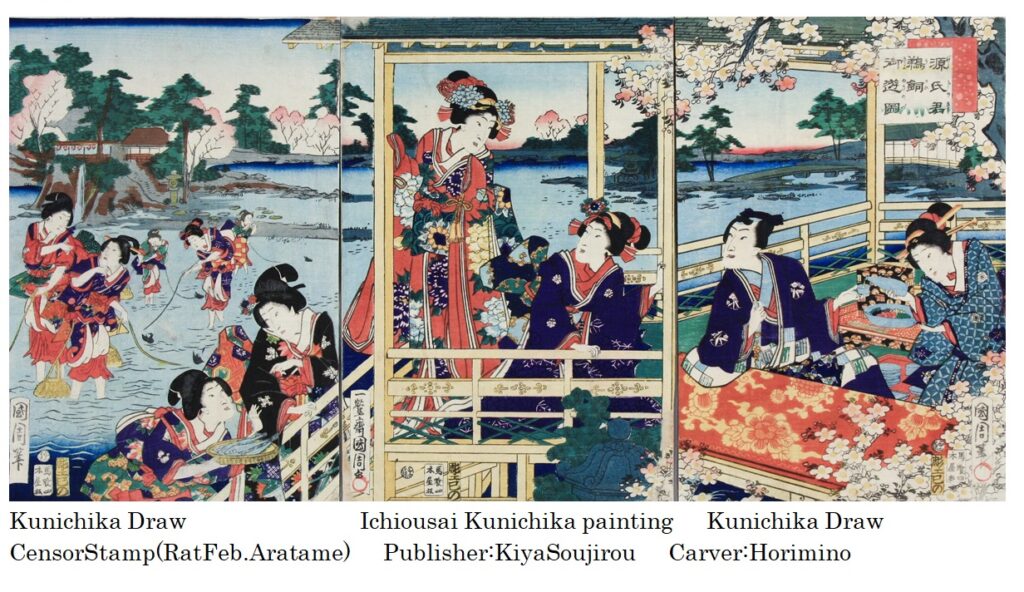
.
Keiou 1st Ox 1865 慶應元年
There were no books illustrated by Kunichika, and there were 13 uchiwa-es. Among the uchiwa-e paintings, there is a work that seems to have used the design of his master Toyokuni III. The number of ukiyo-e prints has increased rapidly to 633. Most of them were medium shots of actors, and Kunichika became a popular actor painter in Edo.
Illustration Related Works
Undiscovered
Uchiwa-e Field
This year, he produced 14 uchiwa-e.
Ushiwakamaru and Princess Joruri 牛若丸と浄瑠璃姫 Kunichika Painting the National Diet Library
This Uchiwa-e is based on the story of the fairy tales of “Jorurihime” and “Ushiwakamaru”. Jorurihime marries Ushiwakamaru, and even if Ushiwakamaru dies after that, Jorurihime is the main character of the story that Ushiwakamaru will be revived. This is thought to be the second work to use one of the master’s old woodblocks, following Ataka’s Kanjincho of 1859. The painting of Toyokuni III was released in 1860. The publication year of Kunichika is dark on the left side and difficult to read, but it is published in 1865 because there is a description of Kiwame and the ox year. However, there are subtle differences between the two paintings. The differences are (1) the lips and black eyes of men and women are different and the facial expressions are slightly different, (2) the position of the moon is different, (3) Kunichika’s work looks like a pond instead of a river because the color of the river is different, and (4) Toyokuni III’s painting is the cast name and Kunichika’s painting is the actor name. In 1859, Kunichika redraws a part of the face in Ataka’s Seki Kanjincho, which was drawn by Toyokuni III. Even compared to that work, he came to draw a face surprisingly close to the actor’s image drawn by his teacher.
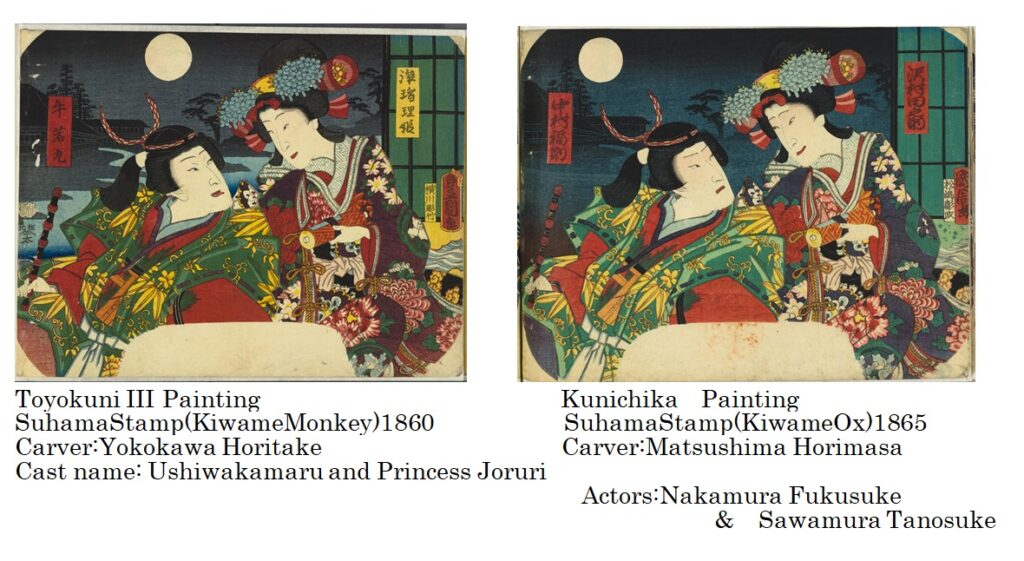
.
Sawamura Otokomae 沢村男前 Kunichika Psainting the National Diet Library
Sawamura Tanosuke is receiving a gift from a patron in the dressing room. He’s happy to see what’s inside, and that expression is good. Kunichika is skilled at expressing subtle facial expressions like this.

.
Ukiyo-e Field
The number of ukiyo-e searches was 633 works, and the signature of Ichiousai Kunichika was very small number, and many of the ukiyo-e were signed by Kunichika. Most of them were Kabuki-themed and medium shot paintings. In the ukiyo-e search, two ukiyo-e works signed by Toyohara Kunichika came out this year, but the year of publication was incorrect. Other than Kabuki, there were works such as “Tosei Beauties”(JAODB), “Kyoto Arashiyama”(the Boston Museum of Fine Arts 00.1063-5) and “Takanawa”(JAODB).
Senritobi no koma 千里飛ノ駒 Kunichika Draw The Boston Museum of Fine Arts 11.41664
In order to make the main character stand out, the background is often dark and plain. However, in this picture, the background is carefully drawn and shaded with dots, so the actor’s expression comes to the fore. In this way, there are many medium-shot work drawings that carefully draw the background and take care to bring out the main character.
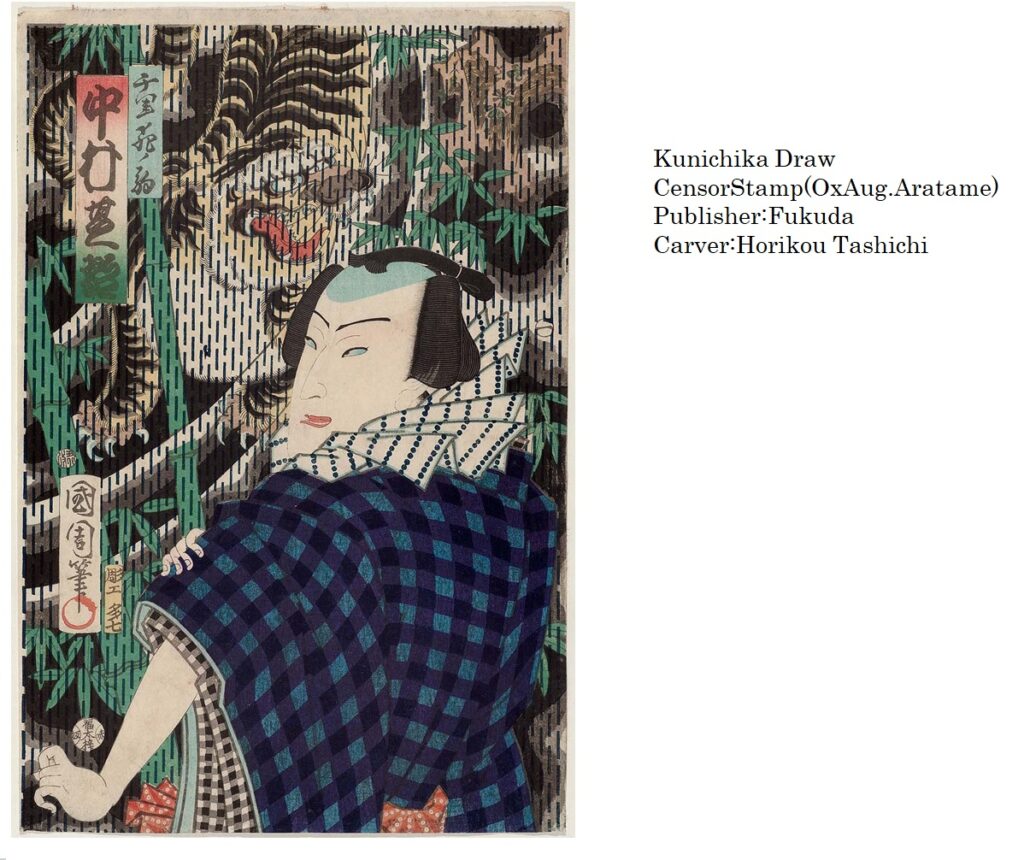
.
Kawarazaki Gonjurou 河原崎権十郎 Kunichika Painting The Boston Museum of Fine Arts 11.40599
One of a series of actor paintings released by Idutsuya. Ten actors were drawn against the background of irises. All received the Censor Stamp in April, and were all carved by Horisakae. Number 1 is Bando Hikosaburou, Number 2 is Sawamura Tanosuke, Number 3 is Sawamura Tosshou, Number 4 is Kawarazaki Gonjurou (picture shown here), Number 5 is Nakamura Fukusuke, Number 6 is Ichimura Uzaemon, Number 7 is Bandou Mitsugorou, Number 8 is Ichikawa Kuzou, Number 9 is Nakamura Shikan, Number 10 was Iwai Shijaku. The irises drawn in this series are realistic, and are drawn in a way that is different from the botanical drawings that have been designed so far.
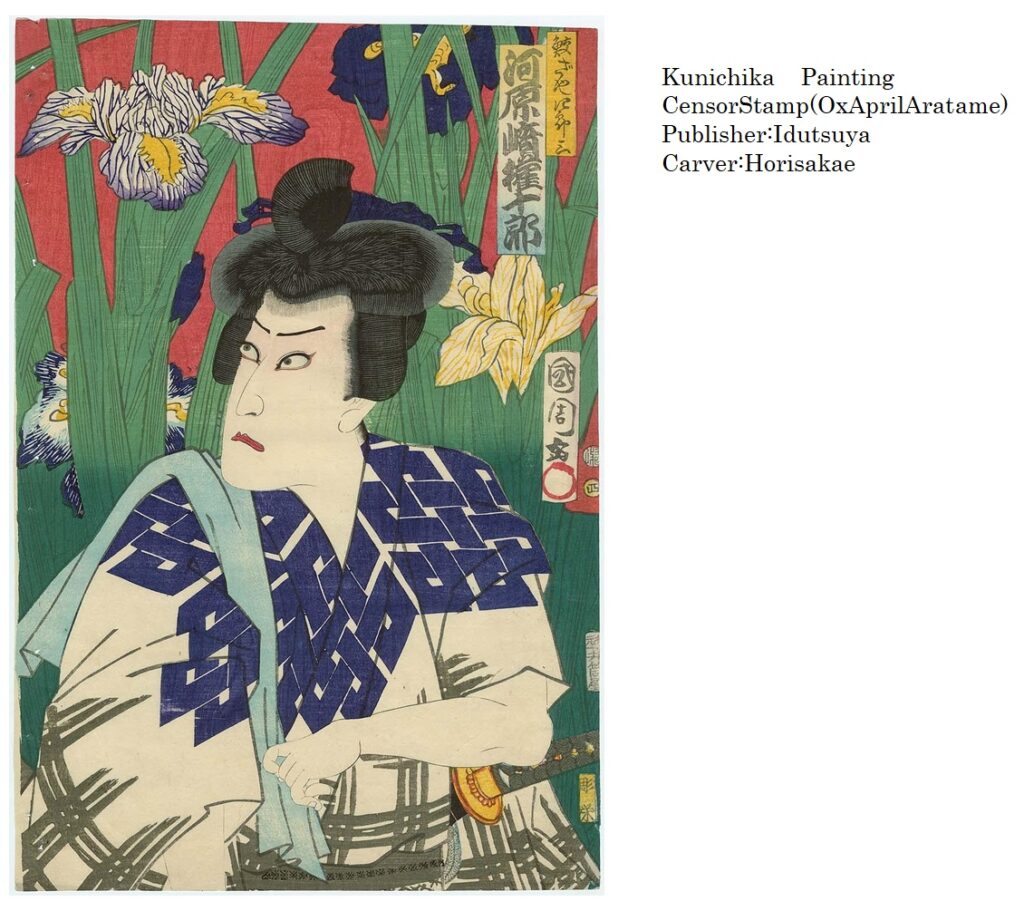
.
Sanjurokukasou no uchi Ichimura Kakitsu 三十六花草乃内 市村家橘 Kunichika Painting The Boston Museum of Fine Arts 11.44419
A series of actor paintings released by Manzen. It is unknown how many actors were drawn because there is no description of the serial number. The preserved paintings are by Bando Hikosaburo with mizuaoi, Bando Mitsugoro with morning glory, Ichikawa Kuzou with pampas grass, and Ichimura Uzaemon with iris. In addition, Kawarazaki Sanshou with peony, Ichimura Kakitsu with lily, and Ootani Tomoemon with reed, who were missing from the Idutsuya series, were drawn. The engraver is Horisakae on some pieces, but most of them are unknown. With a few exceptions, most of them are design expressions. In this picture, the lily flowers are carefully drawn. “Sanshou” was the haiku name of Danjuro for generations. In 1873, he changed his stage name to Kawarazaki Sanshou, according to Hattori Yukio (16,p183). Therefore, in 1865, it is recorded that “Kawarazaki Sanshou” does not exist as a stage name, and there is no stage name in the database of Ritsumeikan University in 1865 also. Sanshou was used as a haiku name.
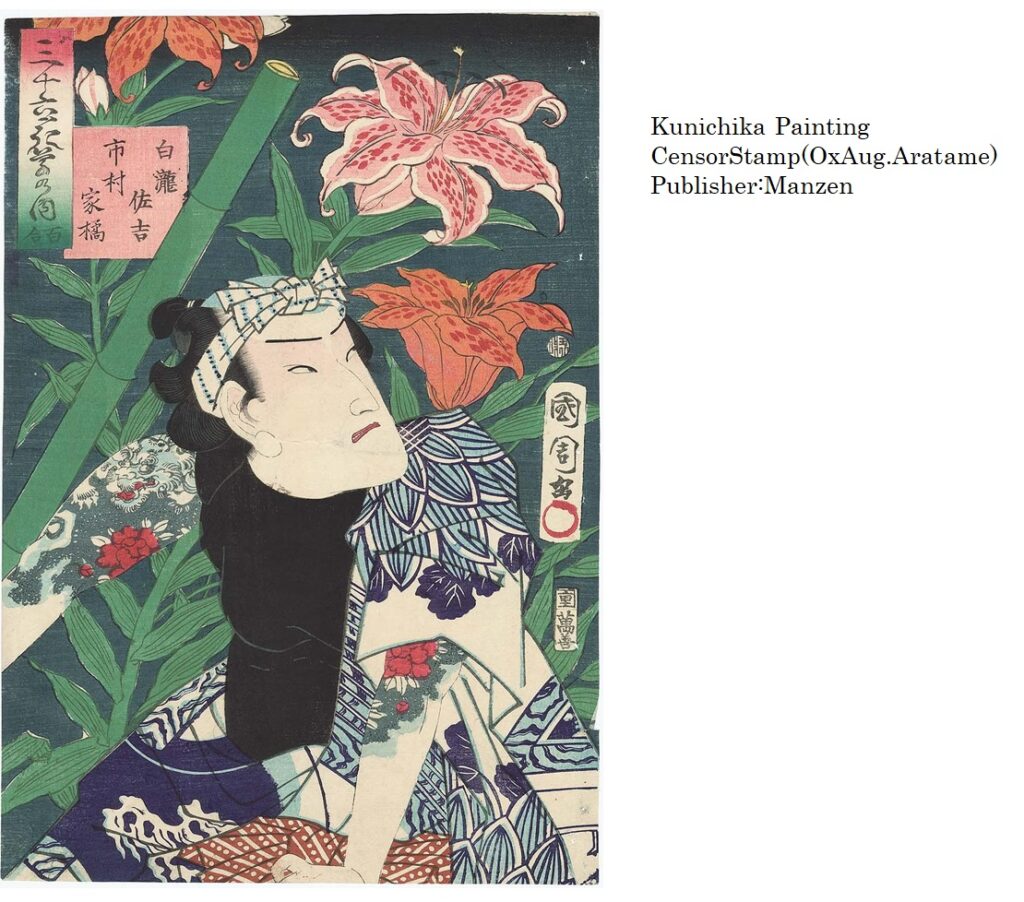
.
Meutogenji Nijuyochou めうとげんじ二十余帖 Kunichika Painting & Oukou Baichourou Kunisada Draw The Boston Museum of Fine Arts 11.39090
This painting was a collaboration with Kunisada (Kunisada II). Kunisada wrote Oukou (meaning willing to respond). Another painting with a similar composition is kept at the Boston Museum of Fine Arts, and is inscribed Ouju Baichourou Kunisada painting. It seems that Kunisada II was already popular, but Kunichika’s popularity is on the rise. It is interesting to wonder who commissioned this painting.
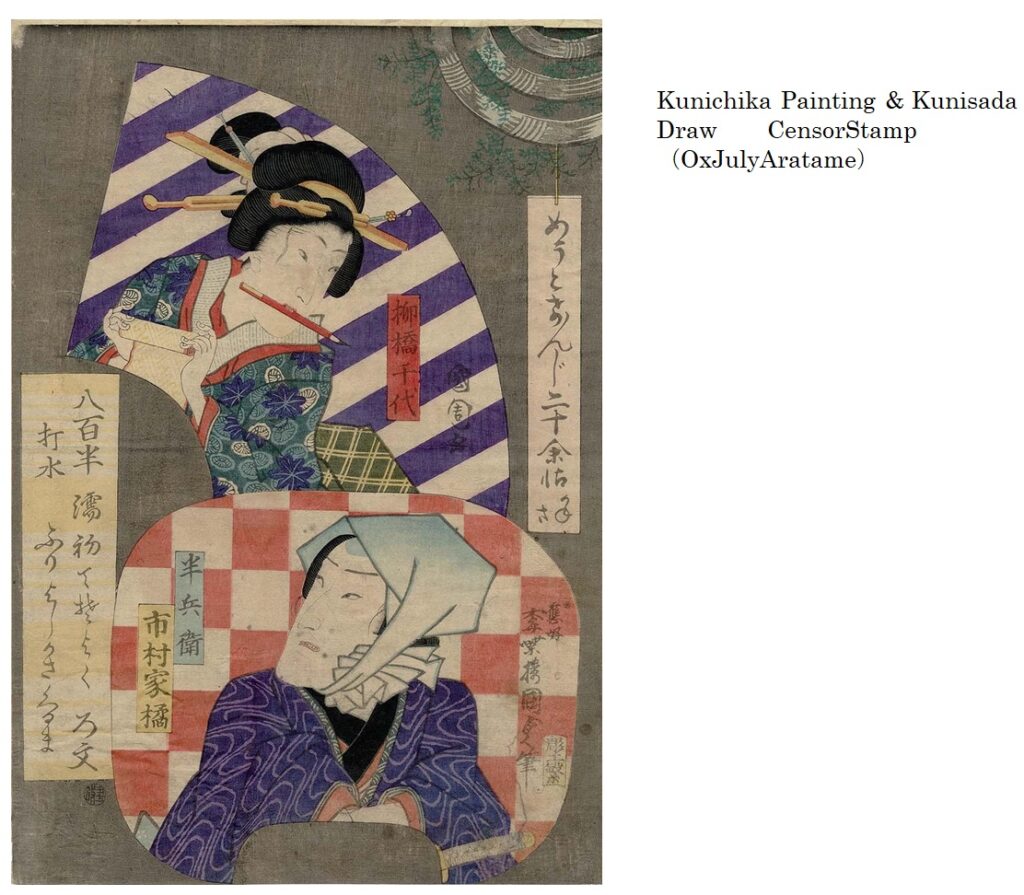
.
Kyoto Arashiyama Yuran 京都嵐山遊覧 Kunichika Painting The Boston Museum of Fine Arts 00.1063-5
Genji-e works like this are found about once or twice a year. The characters’ facial expressions are rich and they are depicted vividly as they converse about various things. Also, in the 1855 Sumida River Night Crossing and the earlier Genji-e by Toyokuni III, a young man was manipulating a pole, but here a woman is playing with a raft by manipulating a pole.
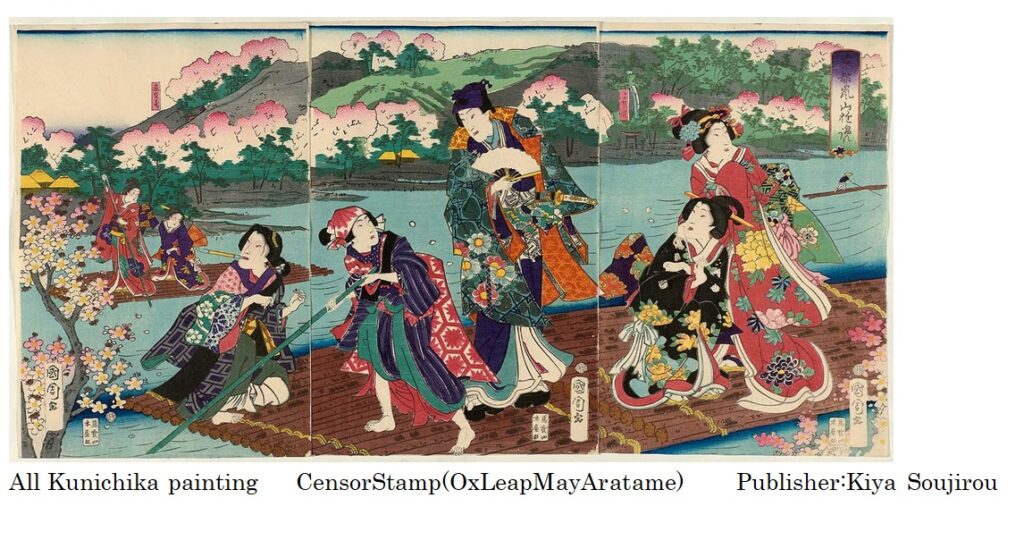
.
Keiou 2nd Tiger 1866 慶應2年
Kunichika only illustrated one book in this year. The number of his ukiyo-e prints was 542, slightly less than the previous year. However, the work is carefully drawn. Also, most of his works are named Kunichika, but some of his works are named Ichiousai Kunichika.
Illustration Related Field
Hanakoyomi fuujibumi 花暦封じ文 Vol.2 By Rougetsutei Arindo Ichiousai Kunichika Painting the University of Tokyo
This book consists of 4 volumes, and each volume consists of 3 parts, top, middle and bottom. The authors are Rogetsutei Arindo, but also Yamayamatei Arindo, Suikyoren Arindo and Okuaya Arindo are also used. There are few illustrations, and Yoshitora draws the illustrations in the first volume. On the bottom of second volume, signed “Artist: Ichiousai Kunichika”. Other than that, the artist’s name does not appear. Another point is the year in which the illustrations were drawn, but there is no censor stamp on the entire book. Until now, Kusazoshi always had a censored stamp on the drawn picture, so the year it was drawn was clear, but it is strange that this book alone does not have an aratame stamp. The censor stamp system changed in the Meiji era, but even in that case, the addresses of the publishers, etc., are listed, but this book does not include them. The work dated 1866 was determined based on the materials in the Union Catalogue Database of Japanese Texts(https://kokusho.nijl.ac.jp/).
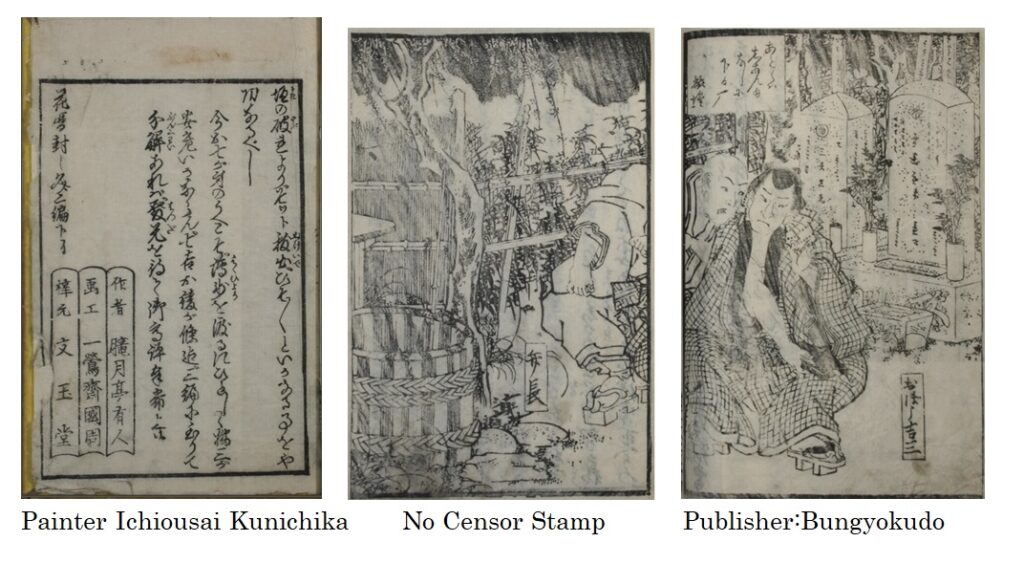
http://kokugo.l.u-tokyo.ac.jp/data/bunken.php?title=fujibumi
Ukiyoe-Field
An ukiyo-e search turned up 542 works, but only a few of them were signed by ”Ichiousai Kunichika”, and all the others used “Kunichika”. The composition was drawn with the medium shot. The expression on his face was drawn with a fixed expression such as glaring and Mie.
Japan also participated in the Paris World Exposition and introduced ukiyo-e prints. According to the records of Tokugawa Akitake’s stay in Europe, in an introduction from the town magistrate to the finance magistrate in April 1866 regarding ukiyo-e artists (83, p420), Yositsuya, Yosikura, Kunichika, Yoshitora, Yoshitoshi, Risshou, Yoshikazu, Sadahide, Kunisada, and Kuniteru were listed as candidates. The Ukiyo-e Reference Memorandum (83,p422) lists three albums of ukiyo-e paintings. The first part is a collection of 50 paintings depicting the manners and customs of women, such as court ladies, wives of feudal lords, concubines, samurai concubines, women of Ohara, tea-picking women, dancing teachers, female music teachers, prostitutes of Kyoto, prostitutes of Edo, bird-chasers, Kamuro, weavers, etc. The second part is a collection of 50 paintings depicting New Year’s celebrations, the Hinamatsuri in March, fireworks at Ryogoku, the Asakusa New Year’s Market, cherry blossoms in the flower gallery, Saruwaka-gai, festivals such as the Tenno Festival, and festivals and events. The last part is a collection of 50 landscape paintings of famous places such as Ueno, Shinobazu Pond, Kameido, Eitaibashi Bridge, a distant view of Kudanzaka, Shinagawa, Yushima, Meguro, and a distant view of Mt. Dokan. However, things did not go as planned by the deadline at the end of May, and the final number of paintings was 100 (18). It is said that Kunichika was responsible for eight of these illustrations (79, p. 11), but it is unclear what kind of pictures he specifically drew.
Kanatehon Chuusingura 仮名手本忠臣蔵 Kunichika Draw The Boston Museum of Fine Arts 11.34911a-c
The number of long-shot stage pictures decreases year by year, but this way of drawing can tell a lot of stories with one picture. In this painting, Kanpei thinks that the man he killed was wrong and was actually a relative, and is about to commit seppuku to atone for his sins. It turns out later that this was a mistake. Okaru sells herself for money, and the scene depicts her being placed in a basket and about to be taken away. Two stories are depicted.
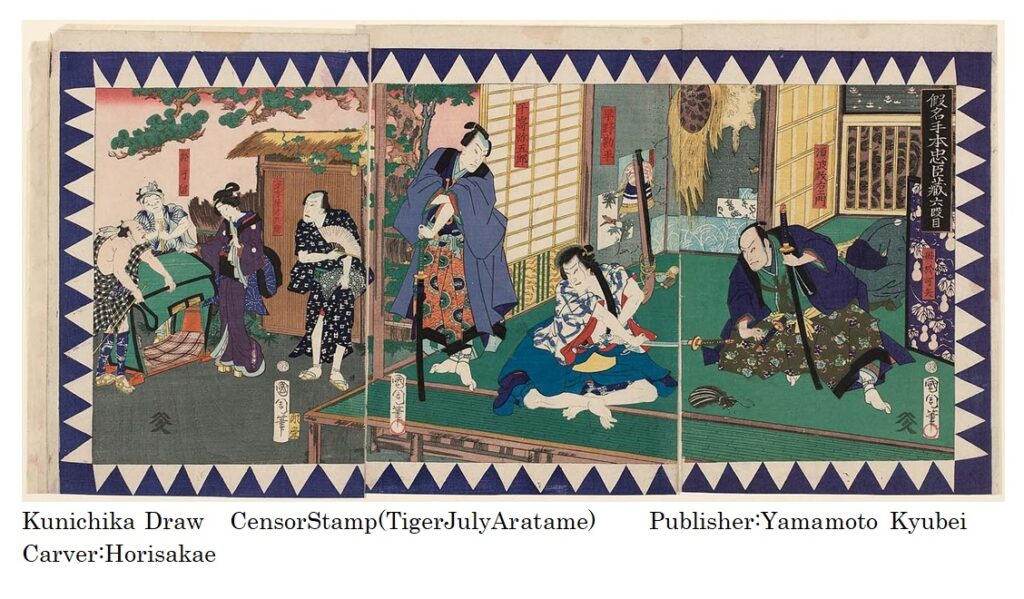
.
Sawamura Tanosuke & Inumura Daikaku & Takarai Kikaku 沢村田之助、犬村大角、宝来其角 Kunichika Draw The Boston Museum of Fine Arts 11.4169, 11.40589, Waseda University Theater Museum 007-0417
Three works will be introduced as medium shot paintings drawn this year. The background is drawn differently. The picture depicting Sawamura Tanosuke has no background, so the viewer is left wondering what he is thinking. Judging from his facial expressions and hand movements, he seems to be remembering something fun.In the painting of Inumura Daikaku, the moon and geese are depicted in the background, suggesting that Inumura is pondering various things and making a decision after dark. The picture of Horai Kikaku on the far right is a method of explaining situations that are not related to the protagonist’s time or physical distance, such as the fact that the main character is Horai, but the background is memories. In this way, Kunichika expresses the feelings of the protagonist.
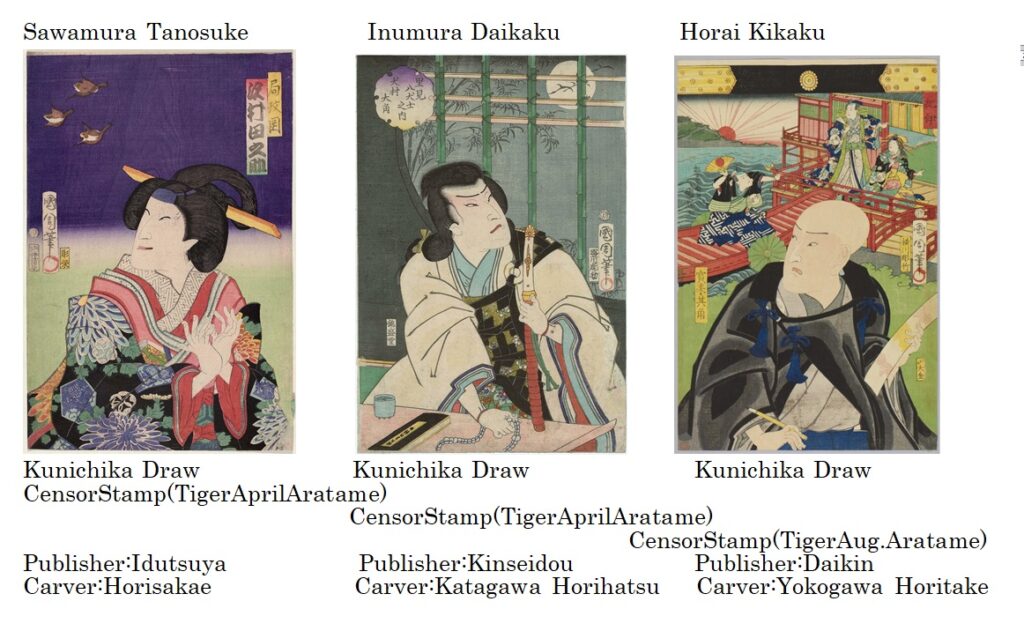
.
Hikuteamata uwasano Tachibana 引く手あまた噂の立花 Kunichika Draw The Boston Museum of Fine Arts11.41744a-c
Introduced as one of the few Genji-e. Tachibana is popular with many women. The expression on the face that the woman approaches expresses her feelings. An older woman is also drawn on the left hand side, indicating the degree of popularity. Such a situation is depicted in a long shot. Also, the picture of the folding screen in this picture was drawn by Chikahide. A disciple of Kunichika, he was active under the psinter’s name of Ryusai Chikahide.
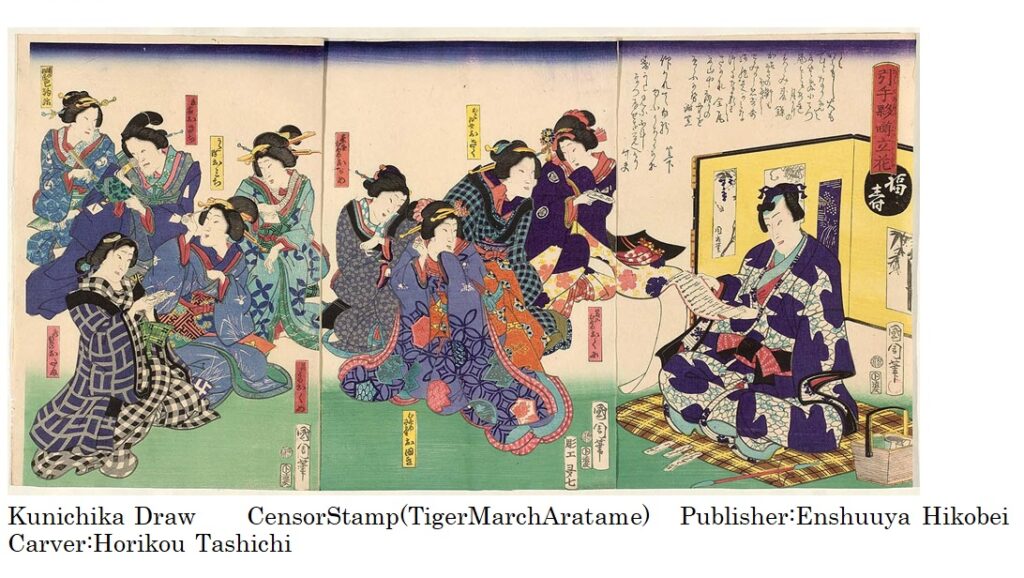
.
Sawamura Tanosuke & Nakamura Shikan 沢村田之助と中村芝翫 Kunichika Draw The Boston Museum of Fine Arts 11.41636a-c
Since it is drawn with a medium shot, the feelings are drawn in the expressions of the two people. The man is furious, but the woman seems calm and comfortable with her feelings. In this painting, the woman’s hair is an important point, and it is drawn carefully.
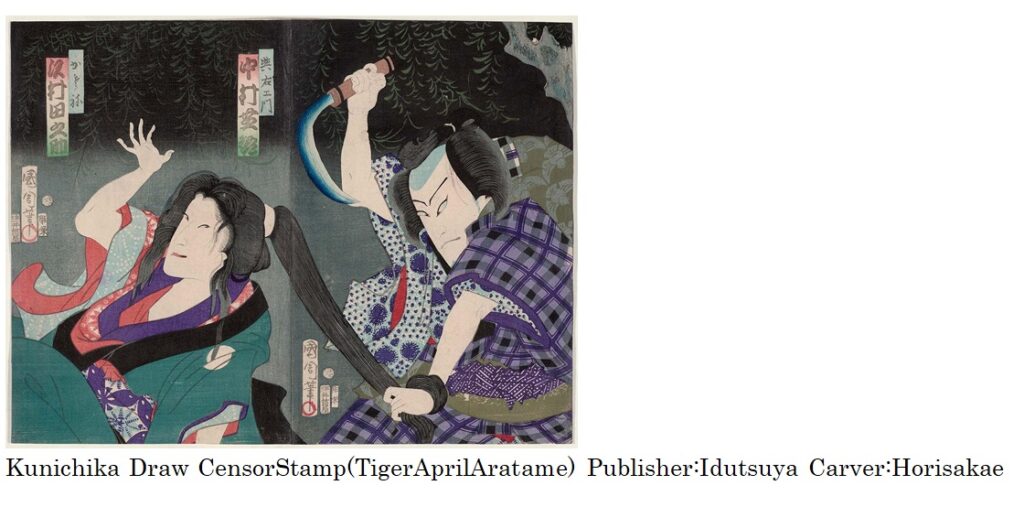
.
Ootani Tomoemon 大谷友右衛門 Kunichika Draw The Boston Museum of Fine Arts 11.44462A-B
This is a medium shot, so their emotions are shown in their expressions. The man is furious, but the woman appears calm and collected. The woman’s hair is an important point in this painting, and is drawn with great care.
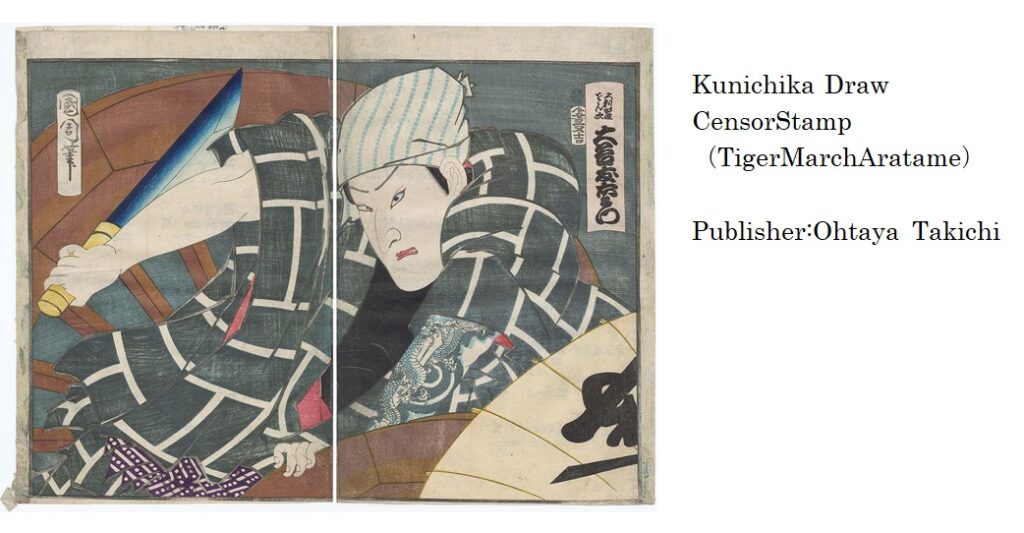
.
Keiou 3rd Rabbit 1867 慶應3年
In the field of illustration, there was one work, and there was no work of Uchiwa-e. In the ukiyo-e search, there were 1072 ukiyo-e prints by Kunichika. This was the year in which the greatest number of works of his life were preserved. Many sets of books were published, including Tokaido Hitomesennryou, Imayo Rokkasen, Good and Evil Thirty-two Mirrors, Edo Meisho Go, and Haiyū Iroha Tatoe. This year, ”Ichiousai Kunichika” was used for 12 works, “Utagawa Kunichika” was used for one work, and “Kunichika” was used for all others.
Field of Illustration
Wakamurasaki Komachi bunshou 和歌紫小町文章 by Kakutei Shuga Ichiousai Kunichika Draw
In 1863, on the last page of Karimakura Tatsumi Hakkei, there was an entry “Wakamurasaki Komachi bunnshou(和可紫小町文章), Ichiousai Kunichika draw, Coming Soon”, but the publication date was unknown. It was advertised as Wakamurasaki Komachi bunshou, but according to the Japanese Rare Books Comprehensive Catalog Database, it was published as Waka Murasaki Komachi bunshou(和歌紫小町文章) in the 3rd year of Keio. content unconfirmed.content unconfirmed.
.
Ukiyo-e Field
Kawarazaki Tamatarou 河原崎玉太郎 Waseda University Theater Museum 014-0334
Kawarazaki Tamatarou’s memorial painting introduced here is signed Utagawa Kunichika and stamped with Kunichika’s Rakkan. There are very few ukiyo-e works that use the name Utagawa Kunichika. Rakkan is a signature stamp that is stamped on calligraphy and painting, with the name of the artist engraved in old Chinese characters. It is unusual that it is not Tosidama Stamp or Gohishi Stamp, but since it is drawn as a hanging scroll design, Rakkan may have been stamped. Some remembrance paintings bear the signature of “Kunichika” and the Toshidama Stamp. Kunichika’s Rakkan is stamped on very few works.
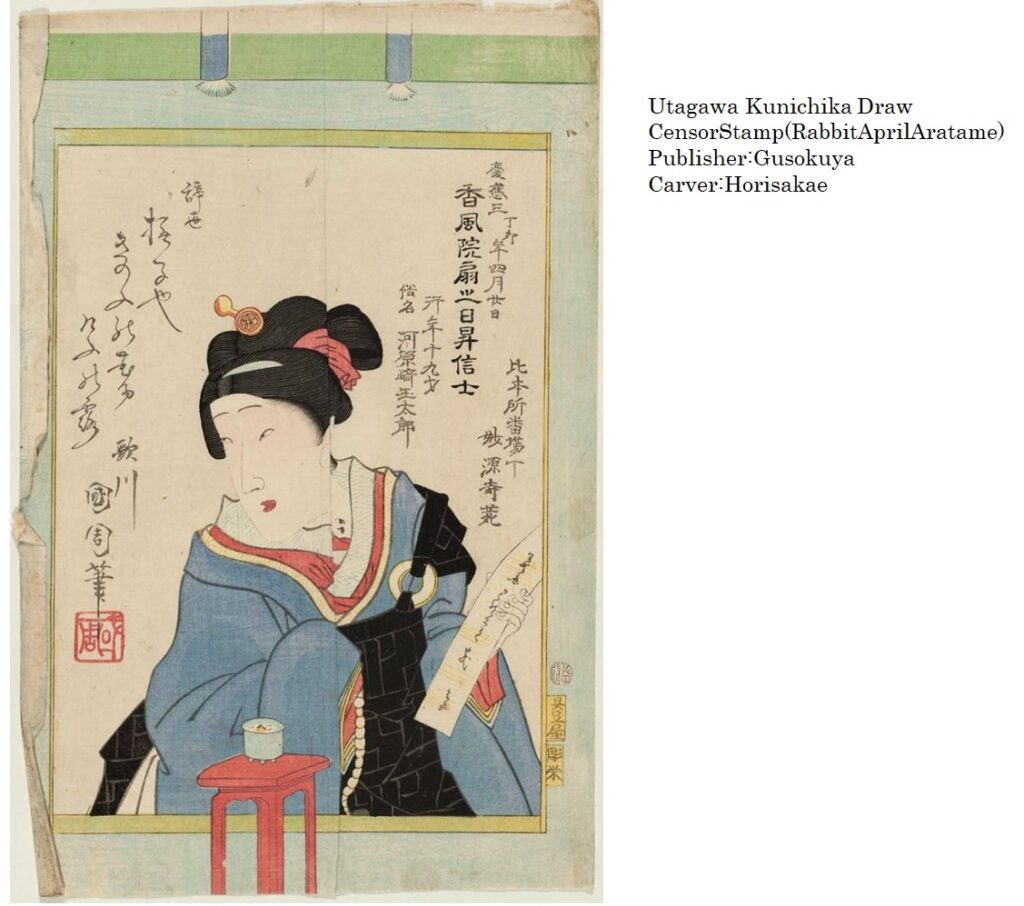
.
Tokaido Hitome Senryou 東海道一眼千両 Kunichika Draw The Boston Museum of Fine Arts 11.40552
Kou no Moronao (the villain of Kanatehon Chushingura) is depicted holding a letter in one hand and thinking about the hot spring resort. The composition of this painting is reminiscent of a landscape painting painted in 1863, consisting of foreground, middle, and background. In the same way that Kabuki actors are depicted in the foreground in a medium shot, the main characters are depicted here as well, with the travelers walking along the riverbank in the middle background and the guests of the spa in silhouette in the background. However, HiroshigeII drew the middle and distant views, as indicated by the title “Tojiba no zu, Hiroshige”. Looking at Kunichika’s landscape paintings in 1863 and “Edo Hakkei”, Kunichika had already painted this kind of background, so this collaboration was a business run by the publisher taking advantage of Kunichika’s popularity. It can also be considered a strategy.
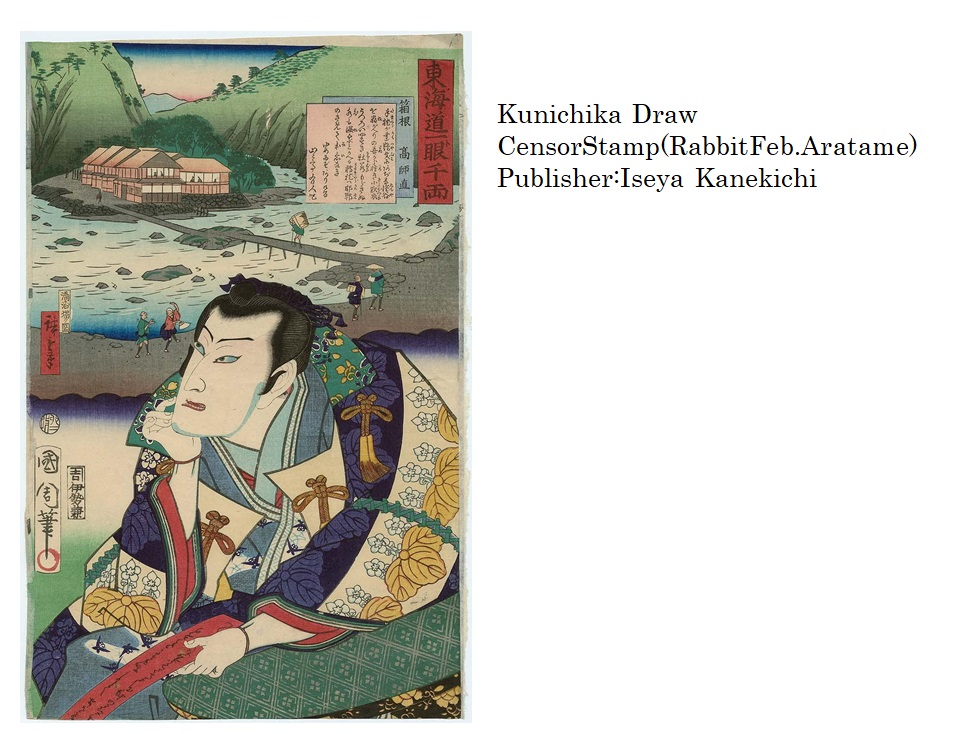
.
Tsuki Yuki Hana Hitome Senkin 月雪花一眼千両 Kunichika Draw Waseda University Theater Museum 007-1425
Perhaps because the previous “Hitome Senkin” series was popular, Wakasaya Jingoro released this “Tsukiyukihana Hitome Senkin” series in autumn. The backgrounds are carefully drawn in this series as well. This work was entirely drawn by Kunichika.

.
Zenaku Sanjuni Kagami 善悪三十二鏡 Kunichika Draw Waseda University Theater Museum 007-2211
The reason why this picture was chosen is that Kunichika’s disciple Chikashige drew a picture on an uchiwa fan, and the Toshidama Stamp of the Utagawa School also affixed his signature to it. In 1863, Utagawa Kunichika drew illustrations for the book “Karimakura Tatsumi Hakkei”, and he is the artist who drew illustrations under the name of “Otojirō” for part of the book. Chikasige is one of Kunichika’s most successful disciples. In 1867, he began to be active as a painter of the Utagawa School as “Morikawa Chikasige”. It depicts a pretty woman.
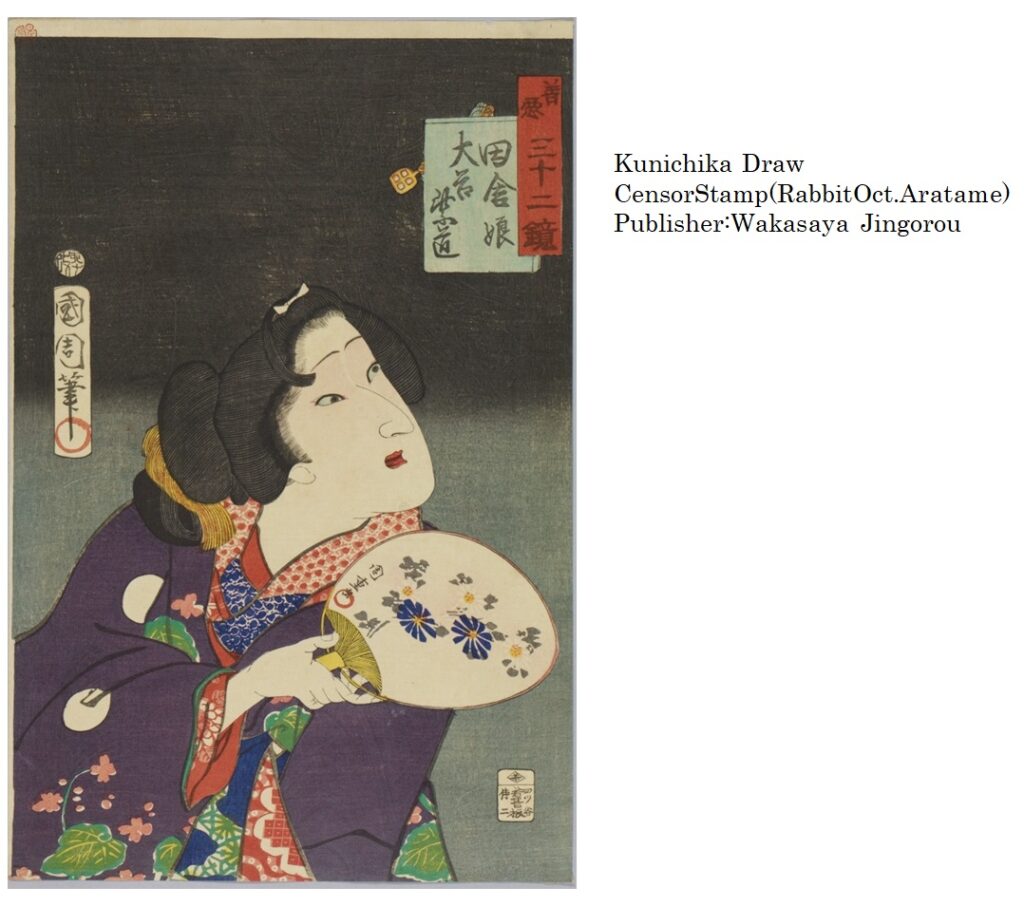
.
Kawarazaki Kunitarou, Ichikawa Kakitsu, Sawamura Tanosuke and others かわらさき国太郎、市村家橘、沢村田之助 他 Kunichika draw Waseda University Theater Museum 100-7696
Kunichika’s actor portraits have high cheeks, thin chins, and long, narrow eyes to suit each actor. Kawarazaki Kunitarou (left), Ichimura Kakitsu (middle center), and Sawamura Tanosuke (right) have almost the same face. However, in the previously introduced “Zenaku Sanjuni Kagami” and the following this paintings, each person is depicted individually, and the variations in facial expressions are even wider. The face of the girl from “Zenaku sanjuni Kagami” and the center of this set of 3 paintings, the face of the girl who lost in the battledore and had her face painted with ink (upper center), the plump face of the girl (lower center), It’s clearly different from Ichimura Kakitsu’s face (middle center), and each one is drawn with a rich individuality. In other words, Kunichika was skilled at drawing portraits, but since the people of Edo had a fixed aesthetic image of actors’faces, it seems that they had no choice but to draw actors’ faces within that range. Kunichika was severely criticized for drawing similar actor paintings for a long time without getting tired of it, but because he was a popular painter, he may have been in a position where he was not allowed to go beyond that framework.
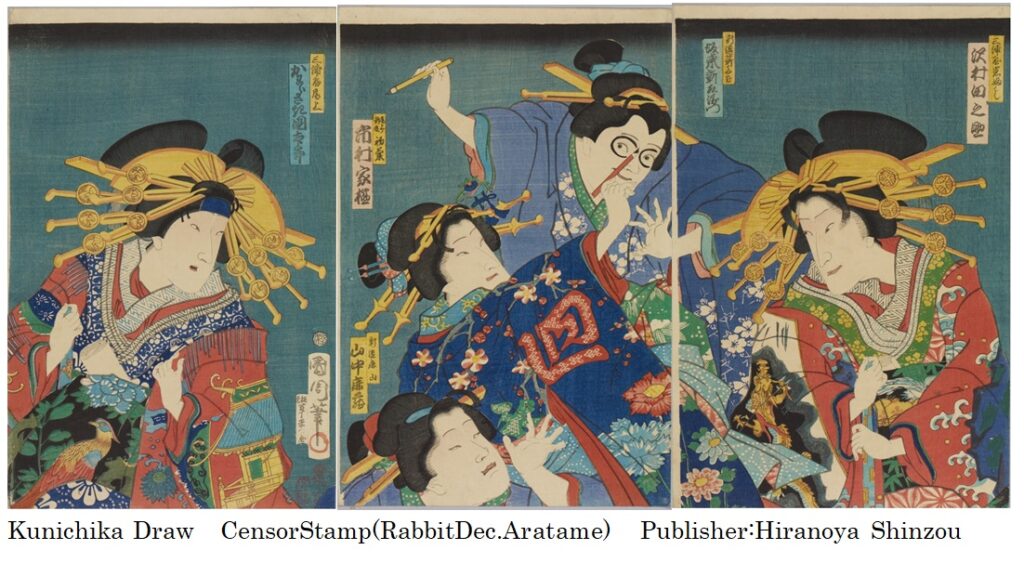
.
Jinriki Tanigorou Gouketsu Saigono zu 神力谷五郎豪傑最後図 Kunichika Draw Waseda University Theater Museum 007-1348
Kunichika has received high acclaim by arranging three large papers and depicting an actor on them (3, p83) . Sugawara claims to have drawn a single actor on a set of three large papers after 1877, but “Jinriki Tanigorou Gouketsu Saigo no Zu” was drawn in 1867, even before that. The Censored Stamp is “RabbitAprilAratame”, so it dates from 1867. It depicts a scene in which Jinriki Tanigorou is cornered and commits suicide. In comparison to a painting with a similar story, “Okige no kumo harau asagochi” ( owned by the Tokyo Metropolitan Library, No. M348-1-8, 1878), this painting depicts the pursuers in the background and explains the situation. Therefore, it is not an expression of Jinriki’s feelings, but a powerful story of a man who was forced to commit suicide. This painting is within the category of a narrative painting drawn in a medium shot of the protagonist, and is not intended to express only the protagonist’s feelings. “Okige no kumo harau asagochi” , published in 1878″ takes the same composition one step further and completes the expression of the protagonist’s feelings.

.
Ichinomori kujirano ooyose 一守九字成大漁 Kunichika draw Waseda University Theater Museum 100-4371、100-43 & Sanjuurokkasen no uchi Kitsune Tadanobu 三十六句撰之内 きつねただのぶ Kunichika Draw Waseda University Theater Museum 201-3036
Two large papers are connected vertically to draw a person on the entire screen. The aspect ratio in this case is 1:3. Such vertical screens were drawn with pillar paintings (aspect ratio 1:6.5, 1:7.2). Shiba Kokan, Isoda Koryusai and others drew a picture of a tall beautiful woman looking through a gap. In the case of Kunichika, the aspect ratio is 1:3, so it is wider than the pillar painting, so it is possible to add movement similar to the painting of “Kitsune Tadanobu”. Kunichika used the facial expressions of the actors as the theme, added body movements that could not be expressed in the medium shot, boldly cut out parts with little movement or expression, and drew pictures that expressed the facial expressions and main movements of the actors. Regarding carvers, the painting on the left is by Uemura Horiyasu, and the one on the right is by Horisakae, who often handles Kunichika’s paintings. As expected, Kamimura Horiyasu’s hair carving techniques are clearly skilled. Horisakae is certainly fine, but Uemura’s hair is not only fine, but also shaded to make it look more realistic.
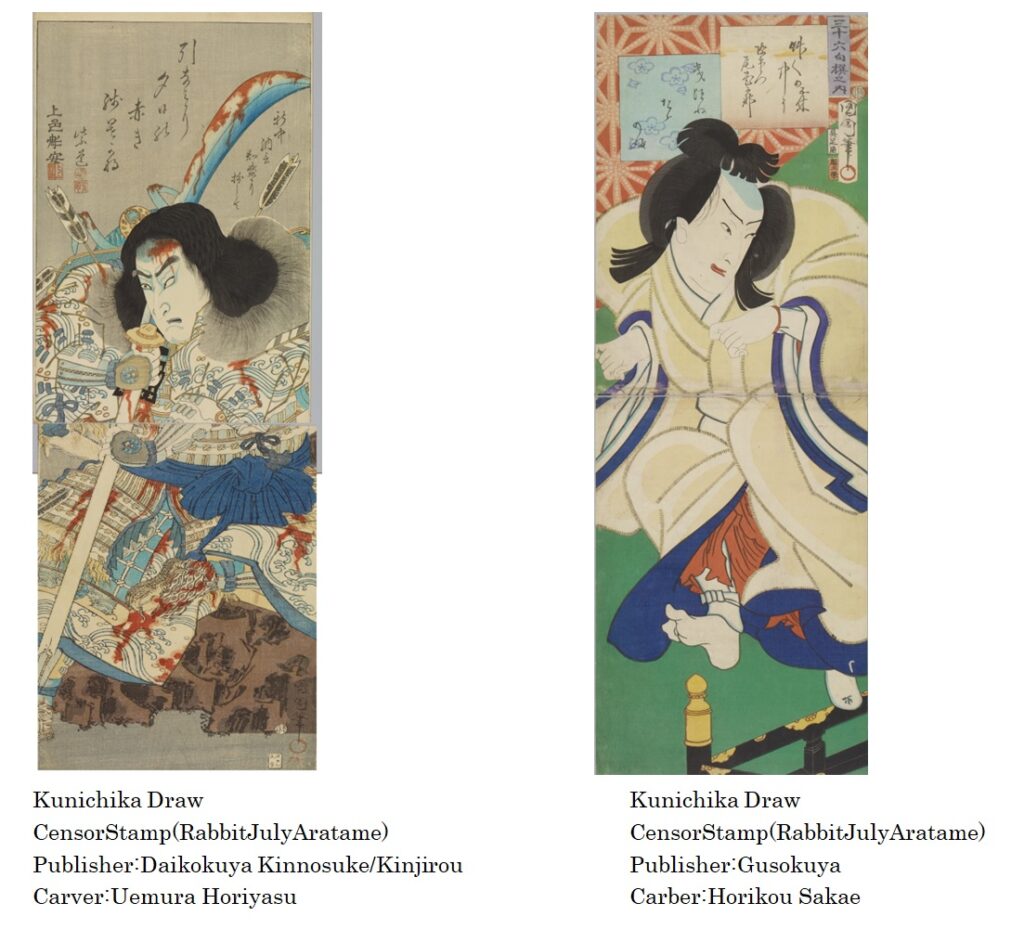
.
Keikofude Nanatsuiroha 稽古筆七いろは Kunichika Draw Waseda University Theater Museum 100-0900、100-0899、100-1293
Akagaki Genzo (center) came triumphantly in the snow while Wakato Hansuke (right) was bewildered. Shioyama Yozaemon (left) is listening behind Akagaki Genzo. This is one of Chushingura’s side stories(25), Shioyama is the older brother and Akagaki is the younger brother. Younger brother Akagaki will carry out the raid tomorrow, so if it ends, he will be sentenced to death. He visited his brother with the intention of drinking with Shioyama at the end of his life. However Akagaki pretended to be drunk and playful so that his raid plans would not be known, so he was thought to be just a drunkard and hated. In this painting, Akagaki comes to visit and informs his manservant of his visit. His older brother, Shioyama, pretends not to be home, but is curious and listens to what Akagaki is saying. Kunichika is so skilled at expressing facial expressions that the story can be understood just from the facial expressions.
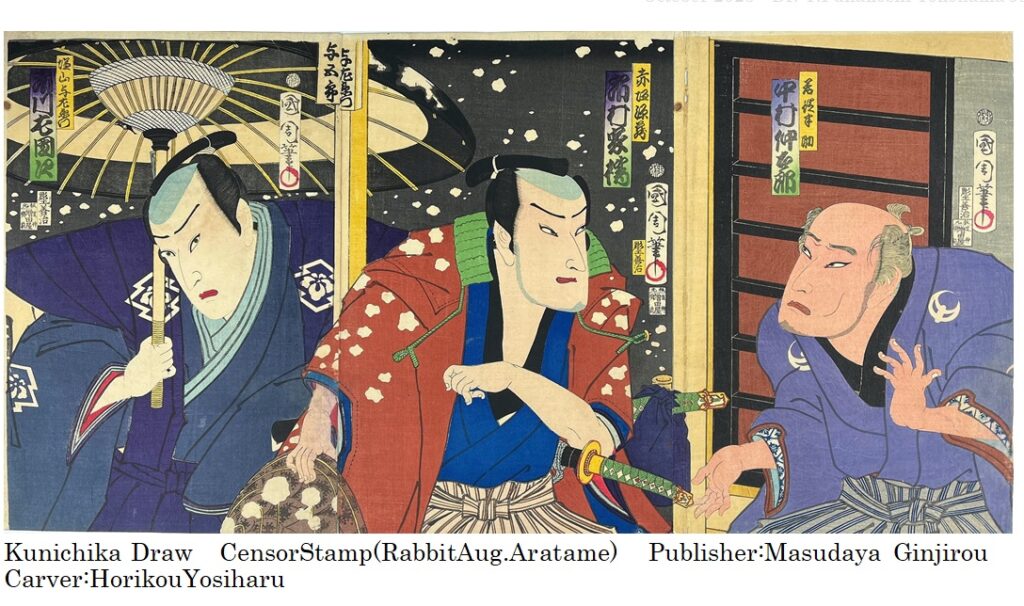
.
Katakiuchi Tenkachayamura 敵討天下茶屋聚 Kunichika draw private collection
Performed in April 1867. Hayase Iori’s father is killed by Touma Saburouuemon in a house turmoil. In search of the revenge and the heirloom “Shikishi written by Ki no Tsurayuki”, he(right) goes on a journey with his servants Adachi Yasuke(left) and Adachi Motoemon(center). Motoemon had a bad habit of drinking and drowned in alcohol immediately, so he went out with him by saying that he would stop drinking, but he got drunk at the crucial time. This is the scene where an angry Hayase Iori scolds Adachi Motoemon and disowns him. Former Uemon, who was sandwiched between Adachi Yasuke, blushed and grabbed the cracked sake bottle and said, “I failed again.” Each facial expression is well drawn and the story can be seen.
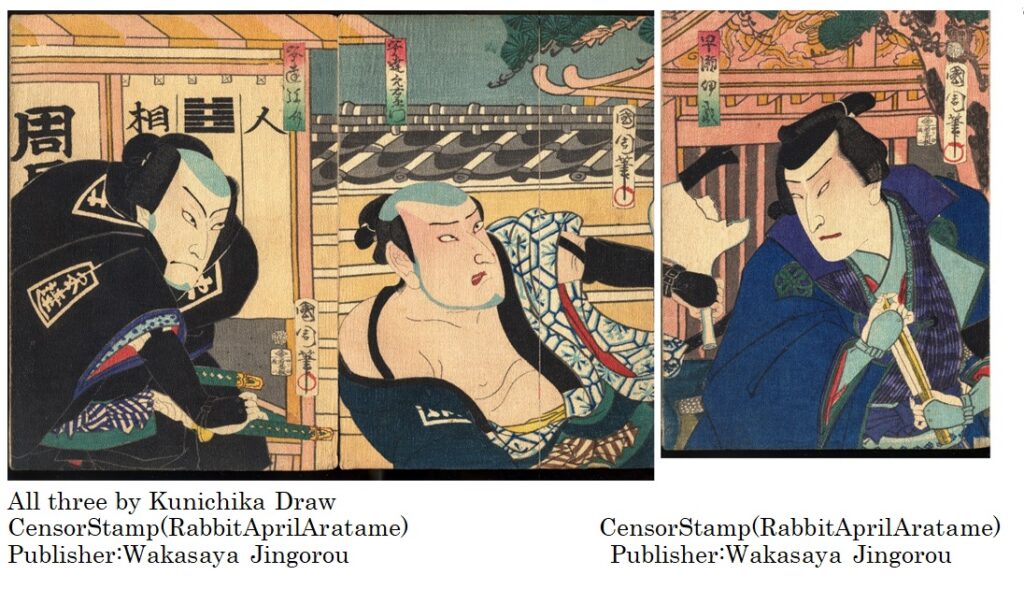
.
Yorimitsuyakata Tsuchigumo Kaiinasu zu 頼光館土蜘蛛怪異做図 Kunichika Draw Waseda University Theater Museum 201-0888
This painting depicts the same story scene that Kuniyoshi painted in 1847. However, Kunichika’s paintings do not have the disquieting appearance of yokai that run rampant like those drawn by Kuniyoshi. Although it is a serious game of Go, the surrounding townspeople and children are treated as nuisances, and in the ceiling, unlike Kuniyoshi’s youkai, humans are depicted fighting. Since this picture was drawn in 1867 (Keio 3rd year), it is thought that it depicts the social conditions of the samurai class and the common people in the midst of the Meiji Restoration.
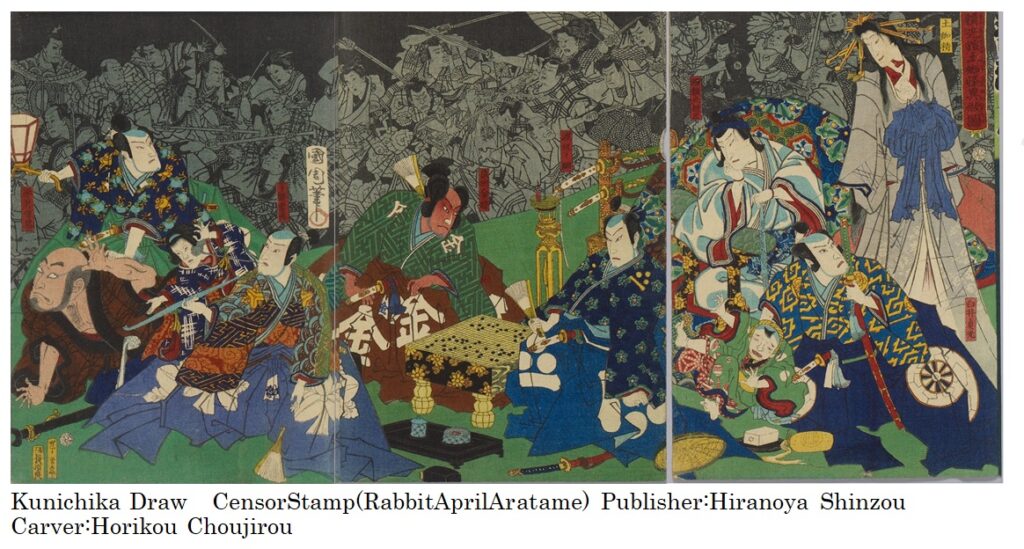
.

.
Kabe no mudagaki かべのむだがき Kunichika Painting Waseda University Theater Museum 007-1765、007-1766
This work is similar to “Nitakaragura Kabeno Mudagaki” released by Kuniyoshi in 1848. It is interesting that the face of this actor is different from the face of normal actors drawn by Kunichika. It seems to capture the real face of each actor. Censor stamp (Rabbit January Aratame) is stamped. The carver can be read as “hari” in the lower left, but there is a dot on the side, so it can be read as “hori”. Since there are four □ in □, it means ” rice fields田” in paddy fields and indicates the pronunciation “ta”. In addition, by saying “seven” in kanji, it is a scribble written here as “hori ta seven”. Therefore, this is understood as “Hori Tashichi”. In 1863, Ohta Tashichi carved the scenery of Zezejou and Chiryu on the Tokaido. Also, there is a publisher-like stamp with something like red ink, but since red ink is not stamped except for a daimyo, it seems to be the stamp of the owner in later years.
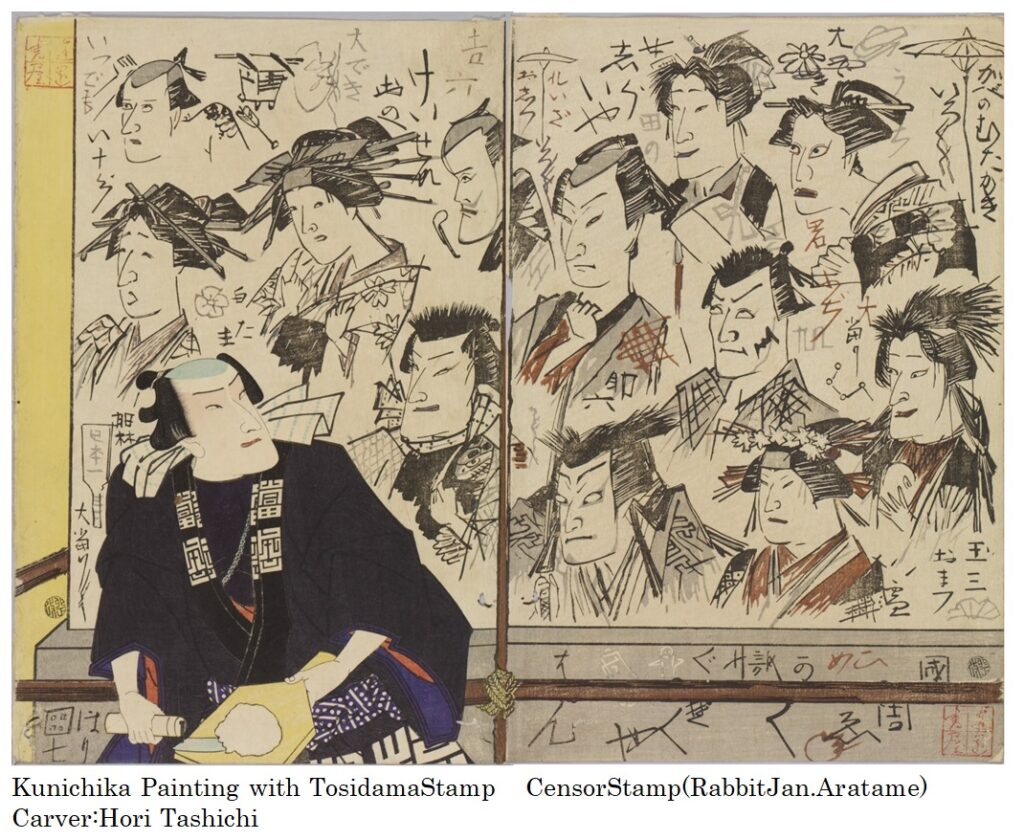
.
Fuwa Banzaemon 不破伴左衛門 Kunichika Draw Waseda University Theater Museum100-9740
This is the moment when two samurai clash with their precious swords as they pass each other, raising their hats and glaring at each other saying, “Who’s the rude guy?” It is a long shot that depicts the whole body in a standing position, but by drawing it on the full screen, the movement behavior and facial expressions of the actor are shown, and by drawing down to the feet, the situation is explained a little. The straight lines in the kimono pattern give a sense of movement. It’s wonderful to have a sense of tension in the composition without waste.
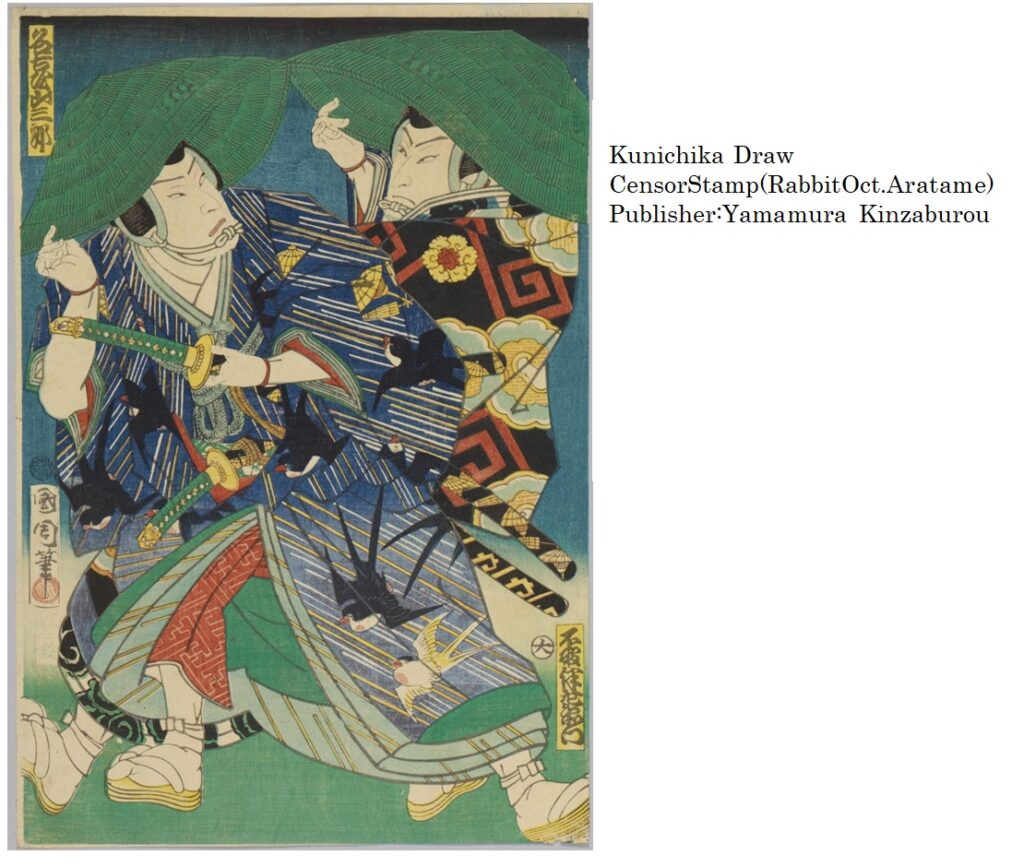
.
Imayou shiranami tsukusi 今様白波盡 Kunichika Draw The Boston Museum of Fine Arts11.41696
Kunichika generally uses his eyes, mouth, and eyebrows to express his facial expressions, and rarely draws lines on a face. This painting is one of the few that expresses facial expressions by adding lines to a man’s face. It’s also wonderful to see the dubious shadows of the wood in the hazy background.

.
Meiji 1st Dragon 1868 明治元年
This year’s work comes up with 349 works in an ukiyo-e search. In 1867, the number exceeded 1,000, so it seems that the number has decreased considerably, but 349 is still a large number. The facial expressions of the actors are rich and there are many pictures that have been carefully drawn.
Ukiyo-e field
Nakamura Shikan 中村芝翫 Kunichika Draw The Boston Museum of Fine Arts11.41693
In 1869, he released Ohkao-e (Big Close-up) from Gusokuya, and skillfully depicted the facial expressions of actors. But already the year before, in 1868, he had painted this screaming, astonishing expression well. Kunichika’s facial expressions are skillful, and this work is one of them.
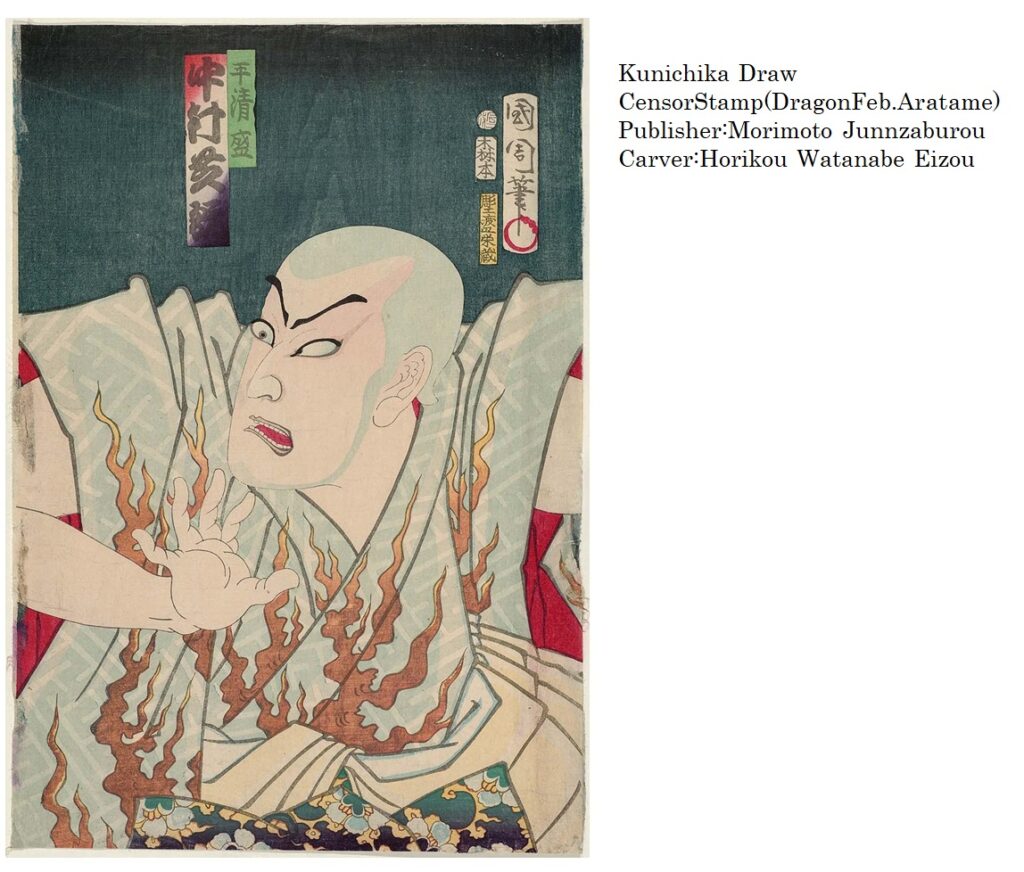
.
Chouchidori Juubangiri 蝶千鳥十番切 Kunichika Draw The Boston Museum of Fine Arts11.40559
The actor’s face is expressed by shading. Such expressions by Kunichika can be seen in a limited number of paintings such as Taiheiki Daigassen (1860) and Chuushingishi Adauchi (1861), but the number of works is small. In other words, Kunichika rarely draws violent and powerful heroes. The background of this painting uses black and light ink to express a sense of perspective, and is a technique that makes the main character stand out. A painting using the same technique is the 1863 “Nihonbashi Bijin no Yukei”.
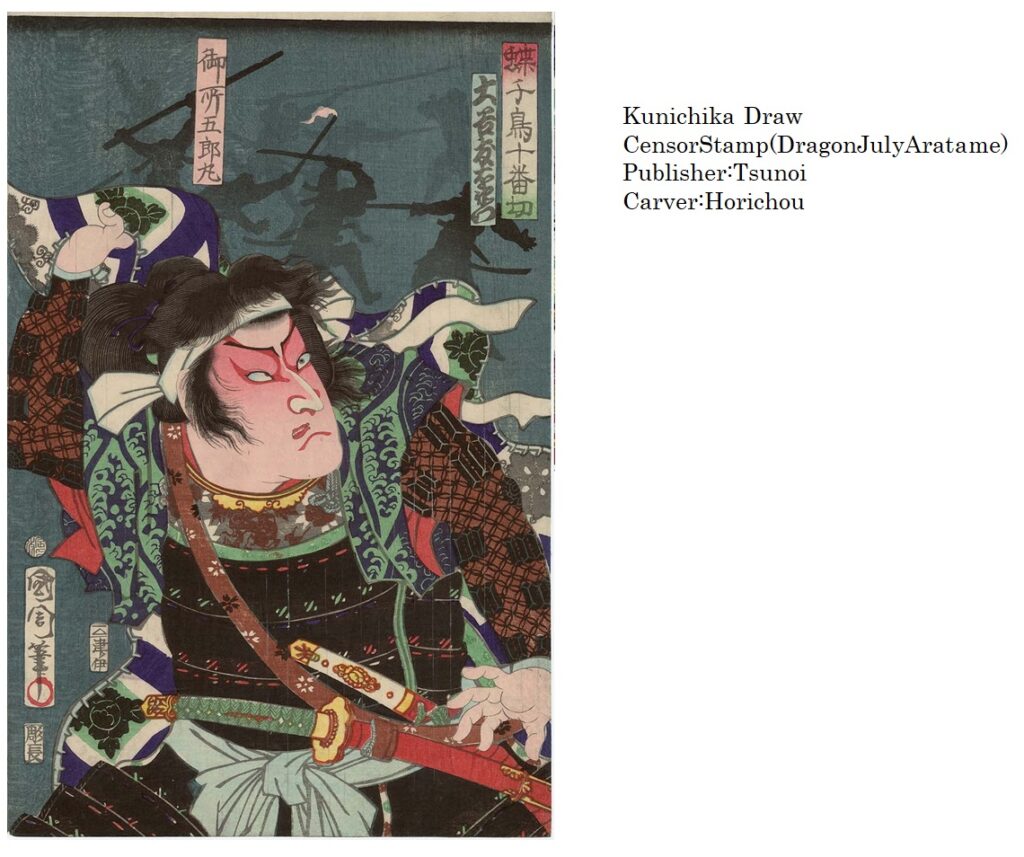
.
Sawamura Tosshou Bandou Siuka 沢村訥升 坂東しうか Kunichika Draw Kunitachi College of Music Kuni80-0803
This composition depicts the battle between the three in the foreground, and the people watching in the background, but it seems that too much has been drawn on two large papers. A long shot of this scene would make it easier to understand, but it doesn’t convey the sense of chaos and confusion. A closer look reveals a man playing with a butterfly, a man apologizing profusely, a strong-willed woman arguing in the foreground, and a man standing in the background with a troubled look on his face. It’s a delightful painting.

.
Imayou shouchikubai no uchi Sono no kodakegari 今様松竹梅の内 園の子竹狩Kunichika draw Kunitachi College of Music11.41773a-c
Genji and his female servant go bamboo shoot hunting in the spring. In the foreground, she is happy to find a bamboo shoot, and in the background, a female servant pulls out a bamboo shoot and falls over on the bank across the river. Kunichika is good at compositing the leading role of the theme and supporting characters in the background.
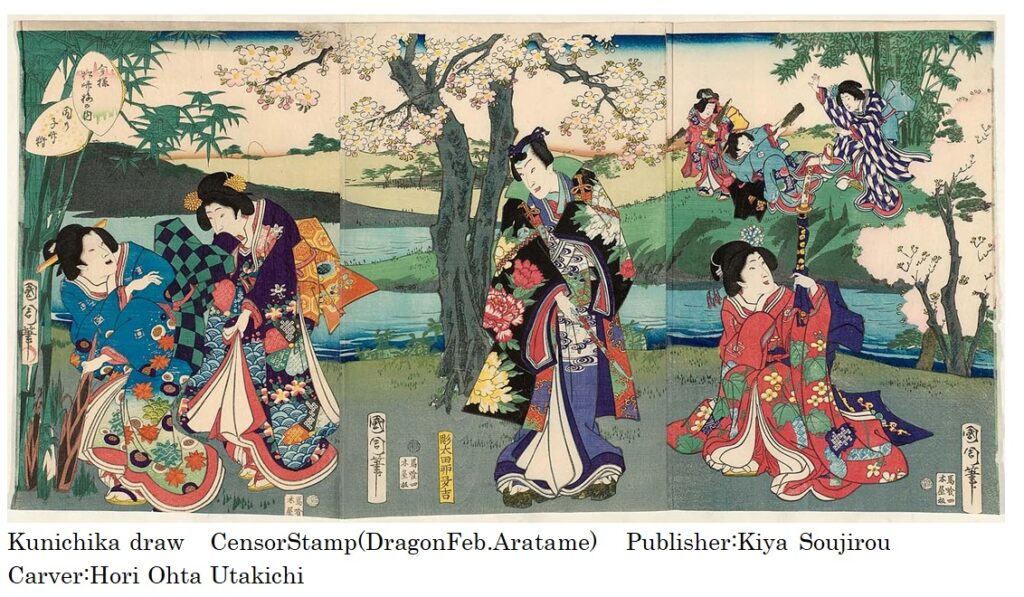
.
Kawarazaki Gonjurou & Ohtomo Tomoemon 河原崎権十郎と大谷友衛門 Kunichika Draw Kunitachi College of Music Kuni80-0235 & Bandou Shinsui & Sawamura Tosshou 坂東薪水と沢村訥升 Kunichika Draw Kunitachi College of Music80-0237
These two paintings have the same composition, carver, publisher, and censor stamp. However, the actors are different, and the armor and kimono patterns are different. The male actor’s face is shaded and powerful, but different. Similarly, the faces of female actors are also different. It’s fun to compare these two works and find out what’s different.
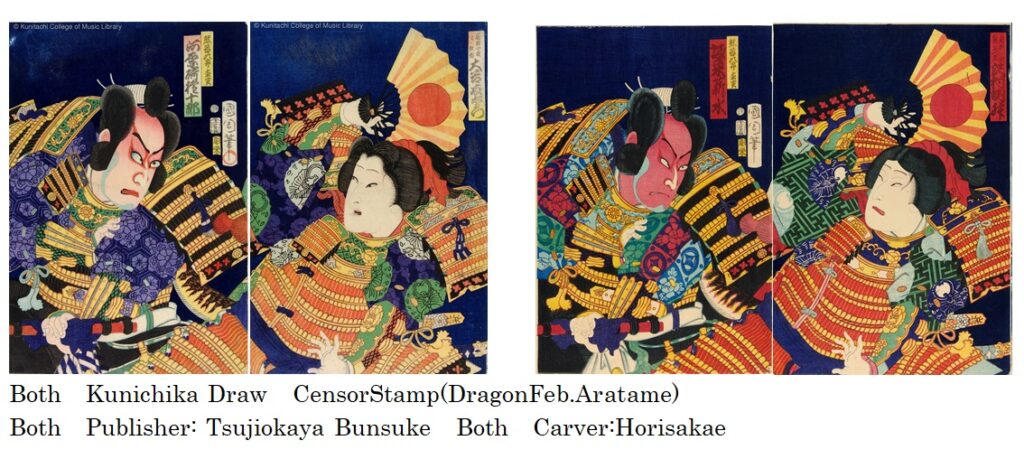
.
Sawamura Tanosuke, Bandou Mitsugorou, Ichimura Kakitsu 沢村田之助、坂東三津五郎、市村家橘 Kunichika Draw Waseda University Theater Museum 101-3049 others
The woman in the center is smoking a pipe as she crosses the river in a boat. She is probably trying to calm herself down. When she reaches the shore, the woman on the left comes to greet her, and the smoking woman suddenly comes back to reality and looks confused, as if she is about to drop her pipe. The man seems to be boasting about something. Each expression is depicted so richly that many stories could be told with this one painting. In the background, lights can be seen across the river; this must be a red-light district.
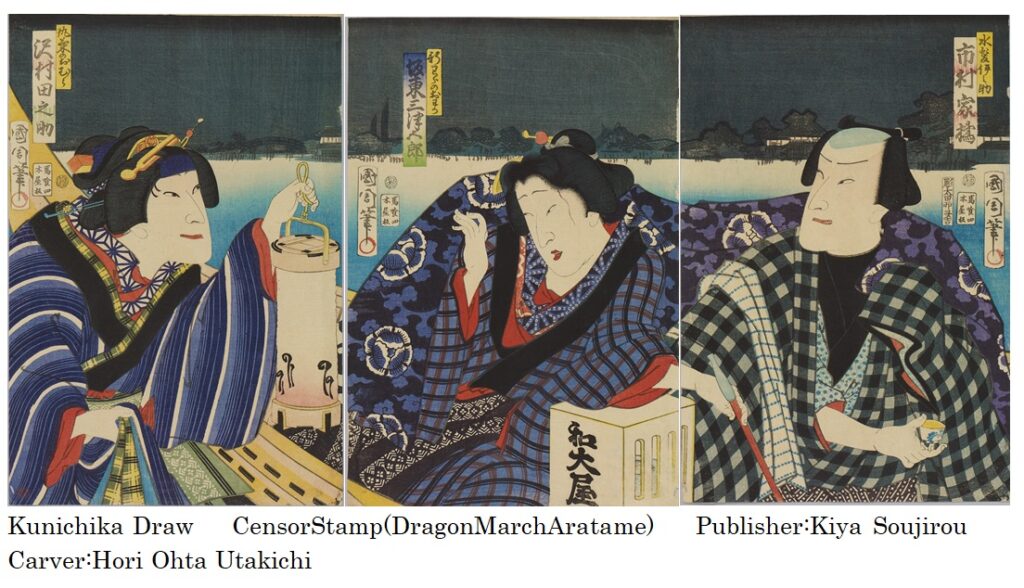
Meiji 2nd Snake 1869 明治2年
The number of works this year was 190 works, which was even less than the previous year. He draws a picture of a moving actor, and this year he released a big close-up picture from Gusokuya. This big close-up is richly expressive and captures the expressions of surprise, suspicion, and anger in the Kabuki story played by the actors. This big close-up picture (Ohkao-e) is highly rated.
Ukiyo-e field
Ichikawa Kodanji Sawamura Tanosuke Ichikawa Sadanji 市川小団次、沢村田之助、市川左団次 Kunichika draw Waseda University Theater Museum007-2652
It is a picture that captures the entire stage in a long shot. Kuroko is behind each actor, and the program is like Ningyo Joruri. Kuroko is attached to Sawamura Tanosuke in the center, and it is a “puppet swing” performed with awkward movements. It will be a highlight that plays out the situation when a fragile woman is nervous. In addition, the musical accompaniment such as shamisen and singing is drawn behind the stage on the upper left. This style picture is said to be a Degatari Zu.
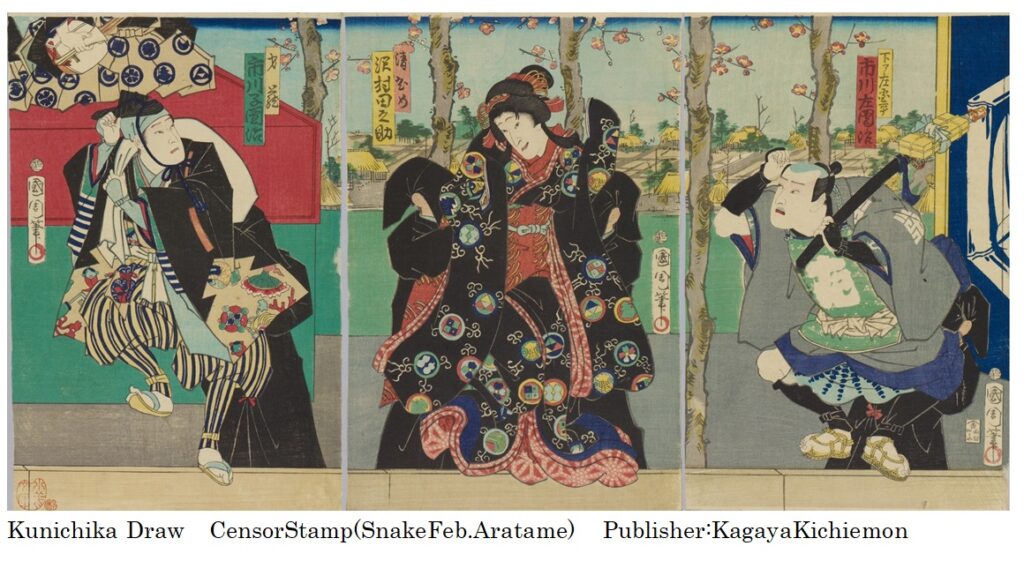
.
Tousei sanjuuni 当勢三十二 Kunichika Draw the National Diet Library本別9-28 07-054
The pattern of the kimono is drawn carefully and finely. Regarding the bird pattern drawn on the kimono, the gradation from red to yellow and from dark blue to light blue is wonderful. The kimono is flashy, but since it is drawn with a medium shot, the woman’s features stand out and are well-balanced.
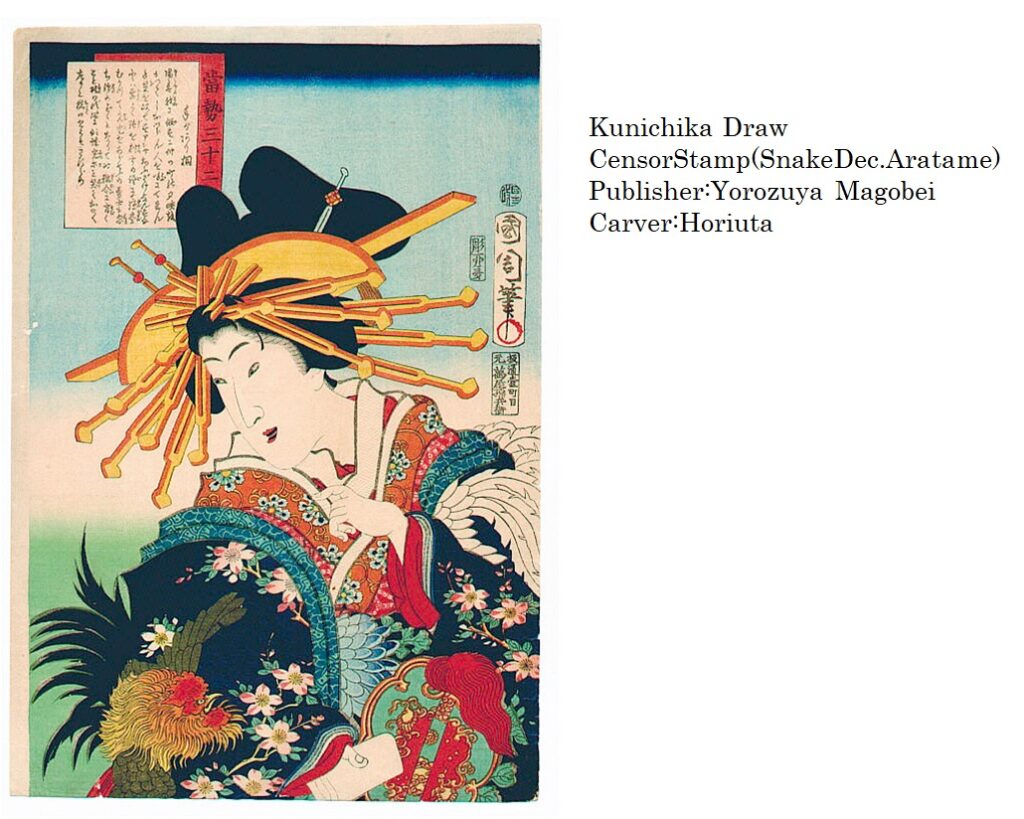
.
Sawamura Tanosuke 沢村田之助 Kunichika Draw The Boston Museum of Fine Arts 11.16146 & Nakamura Sagisuke 中村鷺助 Kunichika Draw The Boston Museum of Fine Arts 11.16157
In 1869, Gusokuya Kahei released the masterpiece “Ohkao-e”, a series of 22 paintings by Kunichika. Only two representative images are introduced here, but Ohkao-e (Big Close-up) will be introduced and discussed in Chapet 3. All of the pictures are drawn almost entirely from the shoulders up, and the inner emotions that the actors were trying to express are depicted with subtle facial expressions such as the eyes, eyebrows, mouth, cheek lines, and the direction of the face. Before Kunichika, the Ohkubi-e paintings were still drawn with the appearance of the hands, which played a supplementary role in explaining, but Kunichika made great efforts to express the inner state only with facial expressions. Therefore, Sugawara Mayumi states that it can be called “Ohkao-e.” Sawamura Tanosuke and Nakamura Washisuke’s “suspicious” appearance is wonderful.
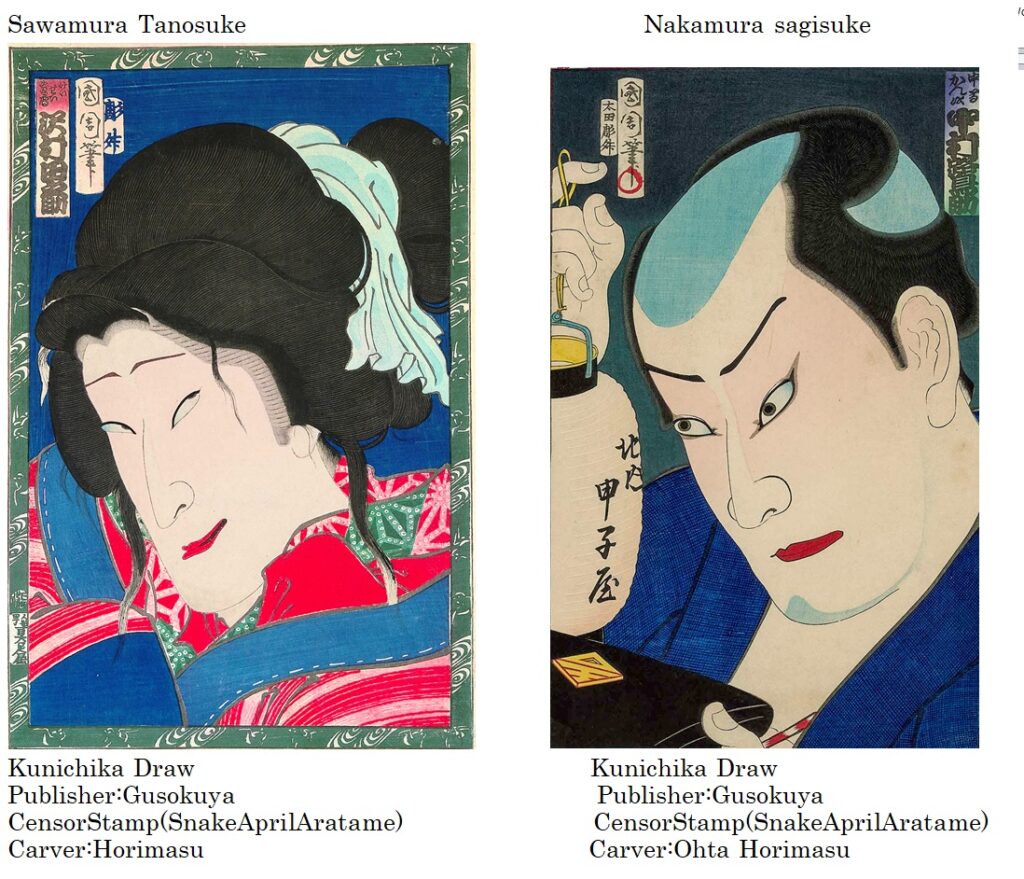
.
Meiji 3rd Horse 1870 明治3年
A total of 327 works were released to the public that year. It should be noted that the name “Toyohara Kunichika” was used for the first time in this year. Toyohara is said to have originated from Kunichika’s master Ichiyusai Chikanobu or Toyohara Chikanobu (6)(14,p81). In 1870, the name of Toyohara Kunichika was used for several works, and in 1871, about half of the works were named by Toyohara Kunichika. By 1872, Toyohara Kunichika was written in almost all his works. Today, it is known as Toyohara Kunichika, but from 1855, Ichiousai, Kunichika, or Ichiousai Kunichika were used, and Utagawa Kunichika was used in the field of illustration. The name Toyohara Kunichika was not used in the field of ukiyo-e until 1870.
Ukiyo-e field
Yujoya Nyoubou Sawamura Tanosuke 遊女屋女房 沢村田之助 Kunichika Draw The Boston Museum of Fine Arts11.41615
Many of Kunichika’s works that are currently on public display as works released in 1870 are medium shots of actors, with fewer long shots. Medium shots, like this work, evoke a variety of images from the facial expressions and gestures. The woman in this work has a good facial expression, and the head is beautifully carved.

.
Sawamura Tosshou 沢村訥升 Toyohara Kunichika Draw The Boston Museum of Fine Arts 11.41791a-c
In January 1870, he released his first work with “Toyohara Kunichika”. Many of the works that he was thought to have called himself “Toyohara Kunichika” before this work are misreading of the censor stamp. Kunichika first called himself “Ichiousai Kunichika”, later became active as “Kunichika”, and this year he took the name “Toyohara Kunichika” for the first time.
Red color is used boldly in this work. Modern people think that the color saturation is too high, but the red color of this chemical dye was different from the red of the past, and was accepted by the common people of Edo as a fresh and vivid color. In the early Meiji period, chemical dyes were imported, making many colors brighter. However, in modern times, paintings that use the red color of chemical dyes are called ‘red paintings’ and are not appreciated as ukiyo-e(20).
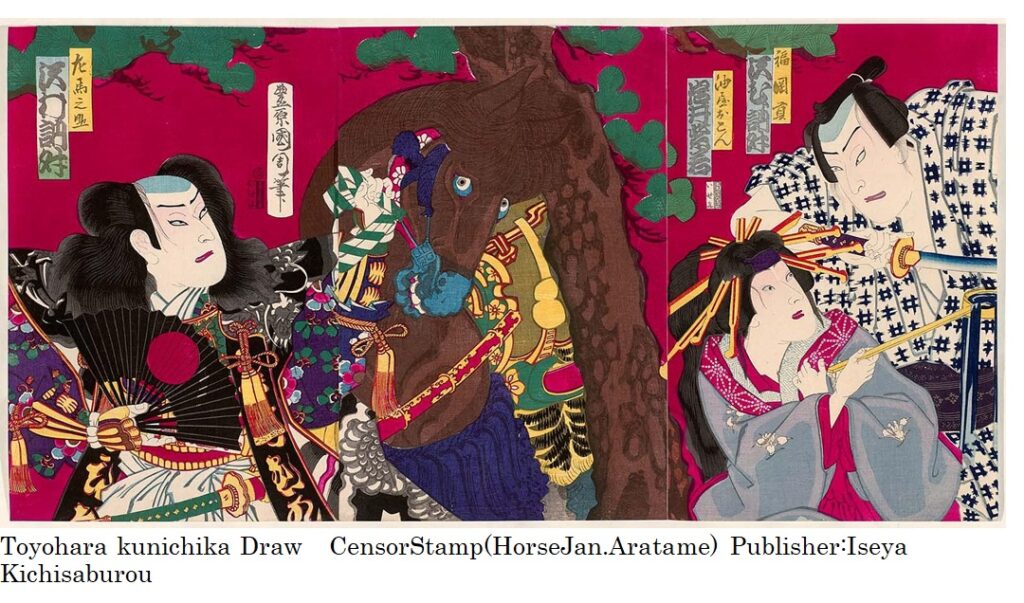
.
Yakusha junikagetsu dodoitsu 役者十二ヶ月都々一合 Toyohara Kunichika Kunitachi College of Music Library Kuni80-0145、Kuni80-0146
This is the second work using Toyohara Kunichika’s name, and was published in January. The words “Toyohara Kunichika” written on the picture on the right and center are partially hidden. The design is difficult to read because some parts are hidden, but it is easy to judge. The name Kunichika Toyohara was written on the work on the left. The subject matter is not Kabuki, but Dodoitsu (formal poetry in colloquial language) from popular culture.
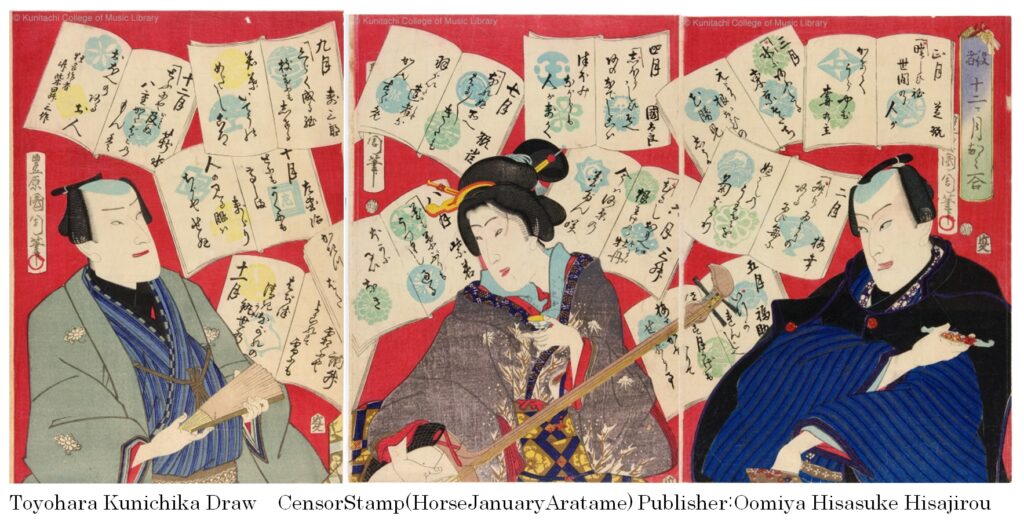
.
Kawarazaki Gonjurou 河原崎権十郎 Toyohara kunichika Draw Waseda University Theater Museum403-0138
This is the third work in this survey to use the name Toyohara Kunichika, and was published in September. Many works were published in October under the name “Toyohara Kunichika,” but the number of works that used the name “Toyohara” was small among the total number of works for the year, and many were still published under the name Kunichika.
The actor who went by the name Kawarazaki Gonjuro was from 1852 to 1869, Kawarazaki Gonnosuke from 1869, Kawarazaki Sanjou from 1873 to 1874, Ichikawa Danjuro IX from 1874 to 1903. Therefore, this painting published in September 1870 has Kawarazaki Gonjuro listed, but he is not present. However, due to his popularity, the name Kawarazaki Gonjuro was used as is. The story is from the Dannoura Kabuto Gunki’s “Akoya Koto Torture” chapter, in which Yuukun Akoya is tortured by Hanzawa Rokuro Narikiyo.
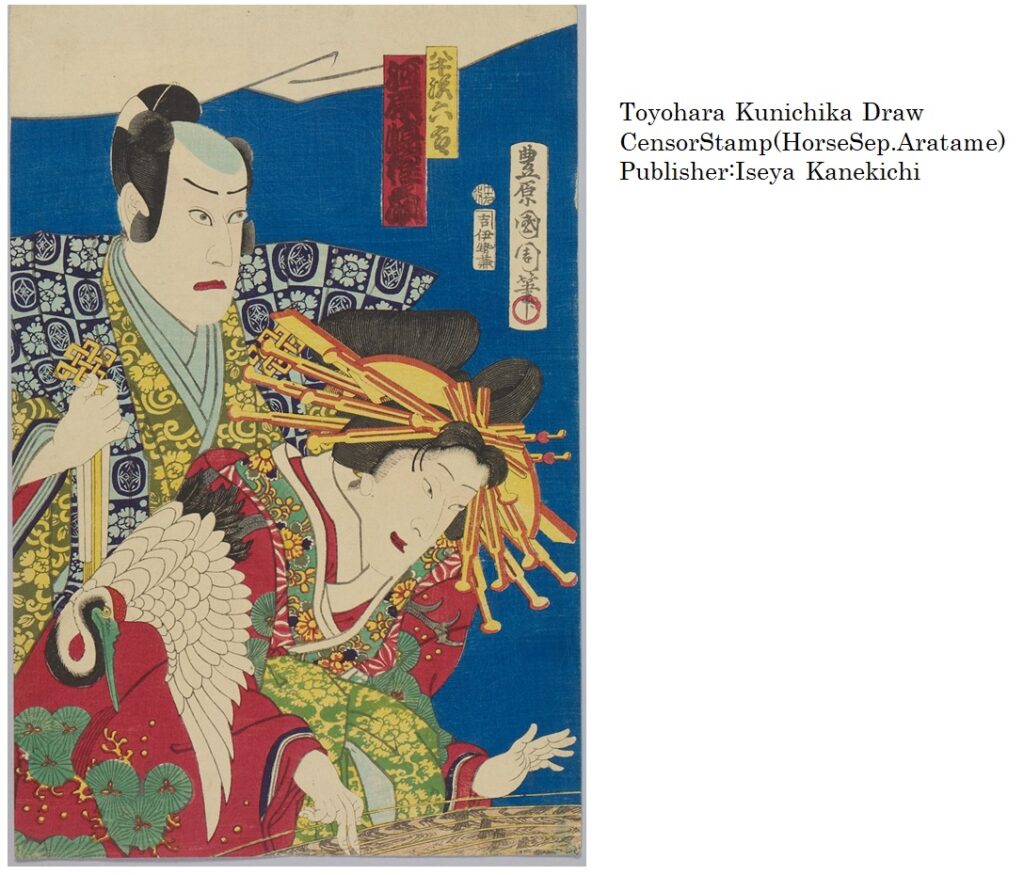
.
Sawamura Tosshou 沢村訥升 Kunichika Draw The Boston Museum of Fine Arts 11.44410a-c
This is a medium shot drawing of a single actor on two large papers. Compared to drawing one large paper horizontally, using two large papers reduces the aspect ratio and makes the top and bottom of the screen slightly wider. When drawing a close-up of a person, there is no space on the left and right, so it becomes more powerful. This style of drawing is similar to Kunichika’s painting of Nakamura Shikan in 1864 and Ootani tomoemon’s painting in 1866, which emphasizes the movements and facial expressions of the actors and creates a powerful picture.
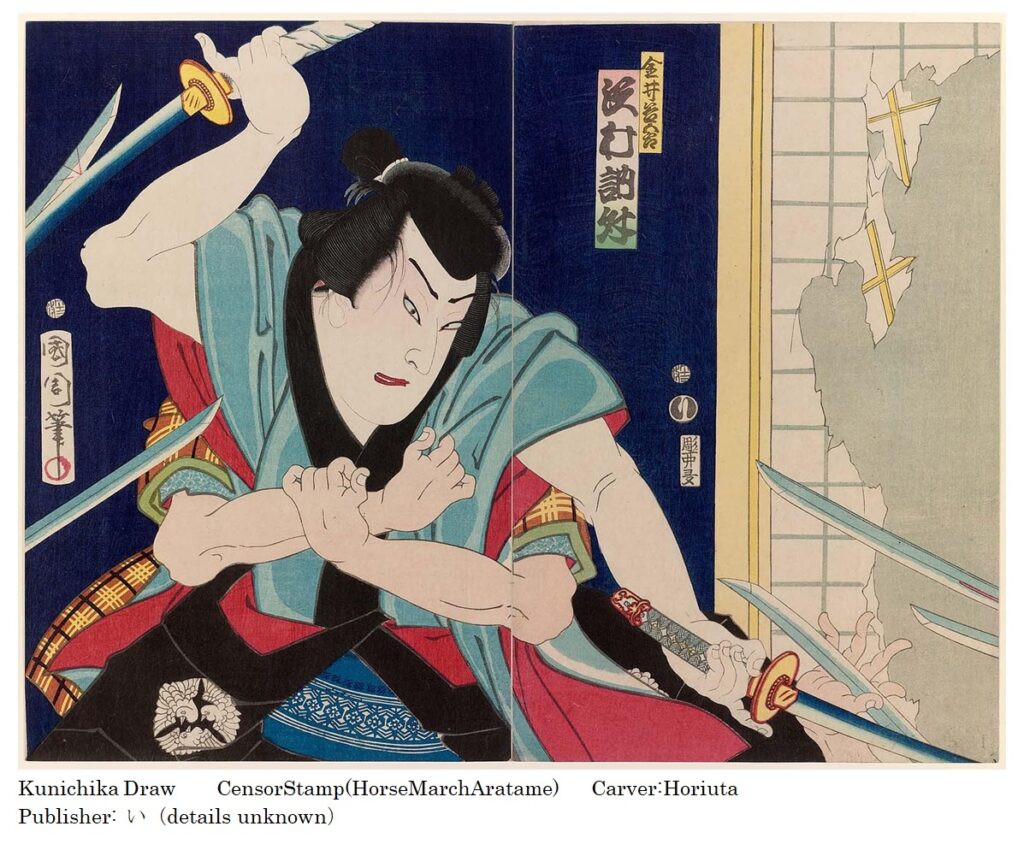
.
Toukei sanjuroku kaiseki Sarugakuchou Kogiku 東けい三十六会席 猿楽町小菊 Kunichika Draw The Boston Museum of Fine Arts11.40522
In addition to Kabuki, Kunichika’s paintings are beginning to include paintings that reflect the culture of the new era, such as restaurants and geisha. It feels like a new era has arrived and culture is changing.
